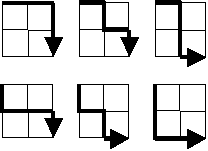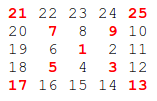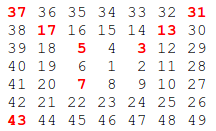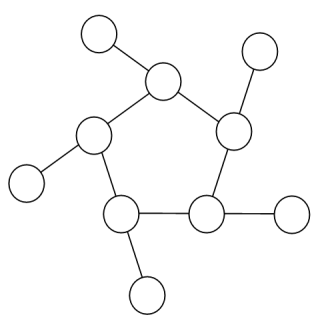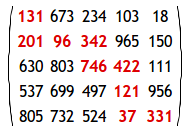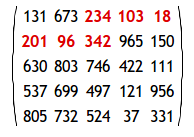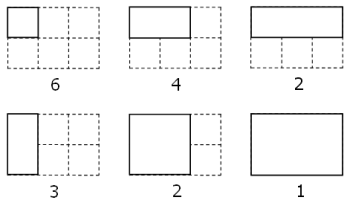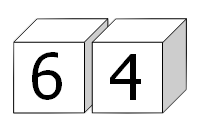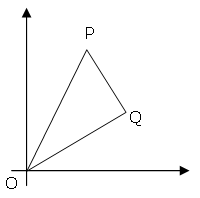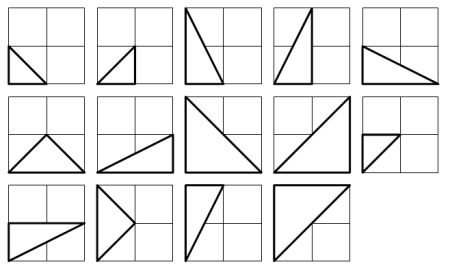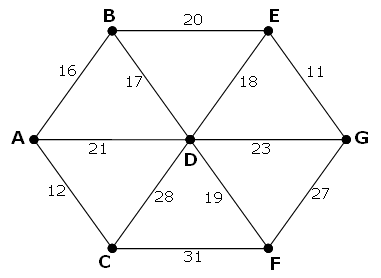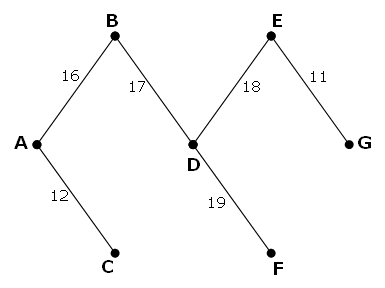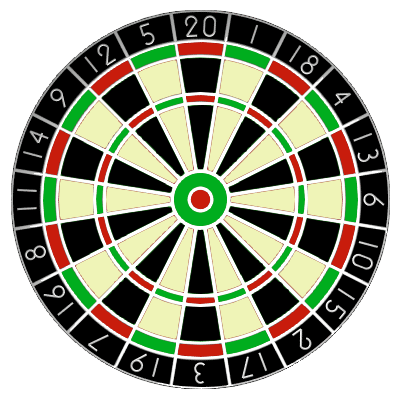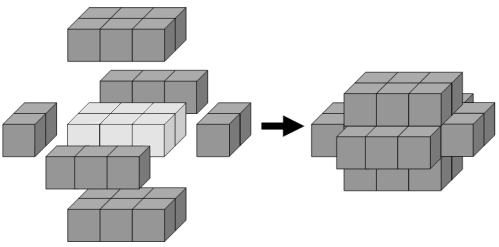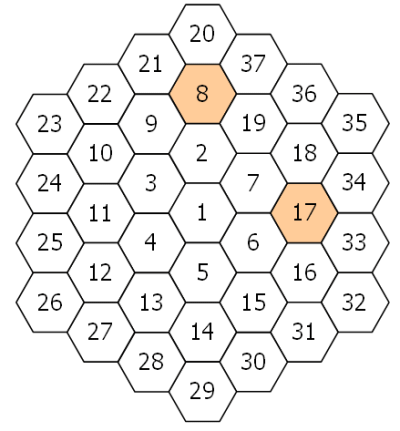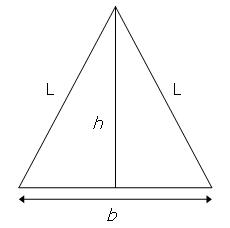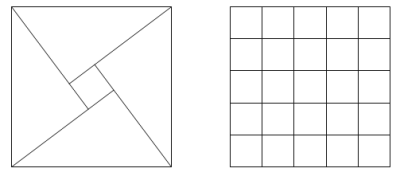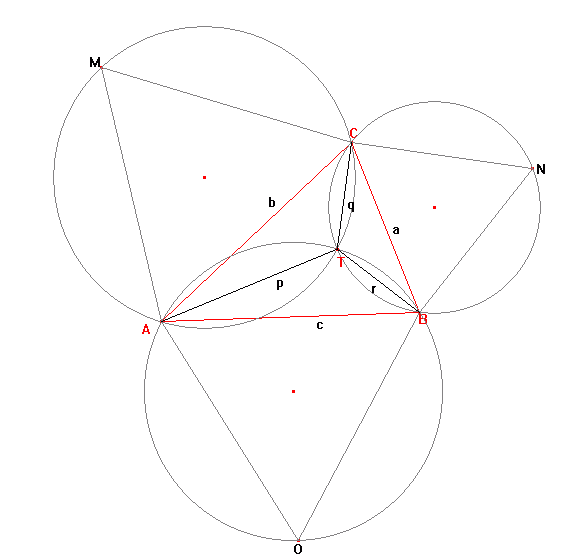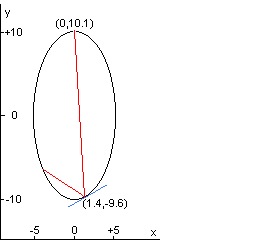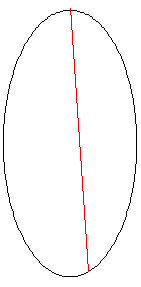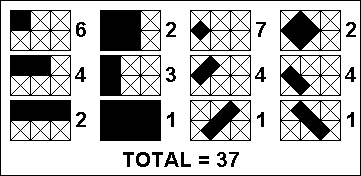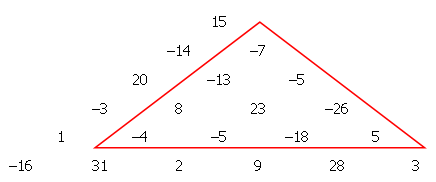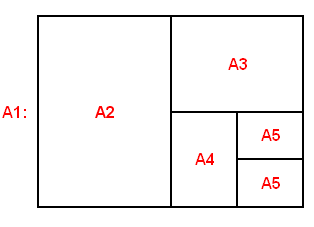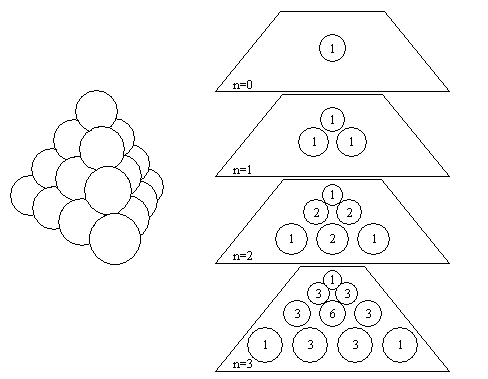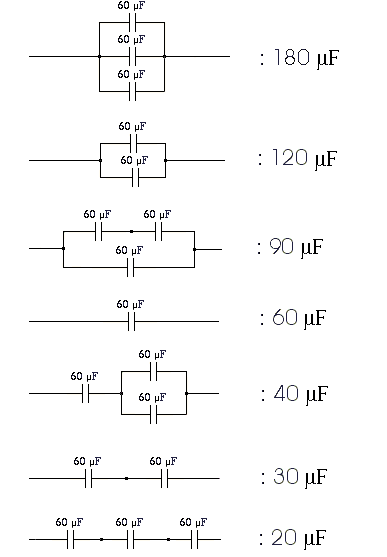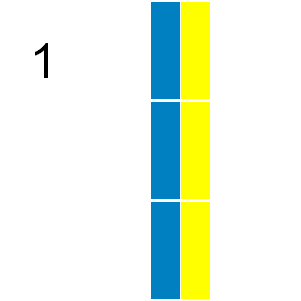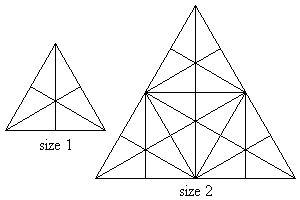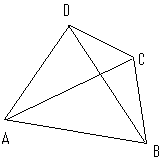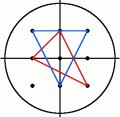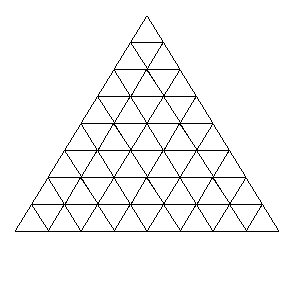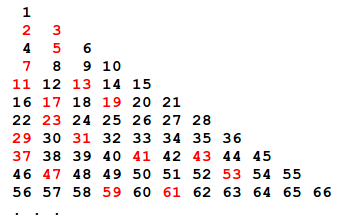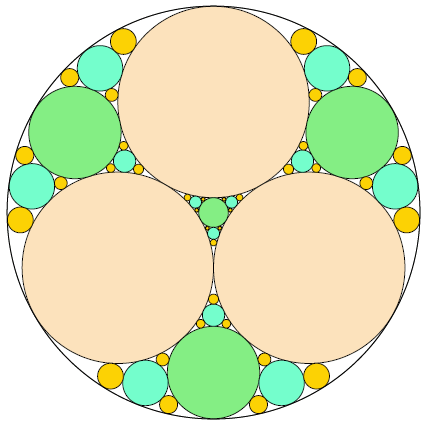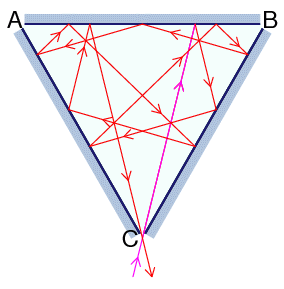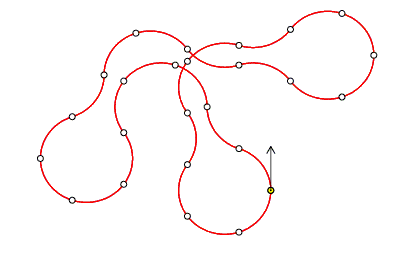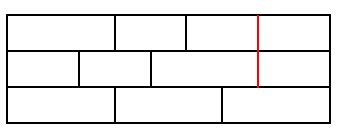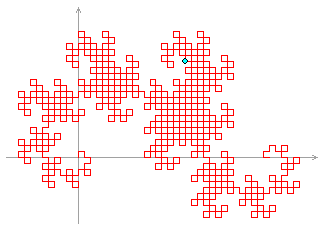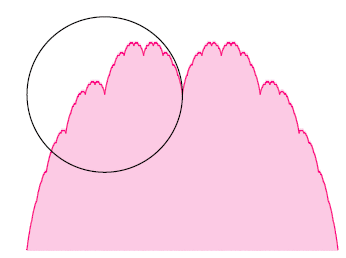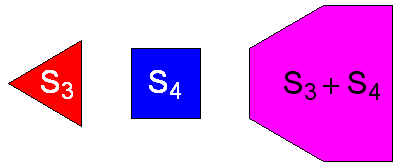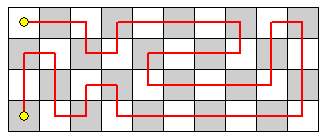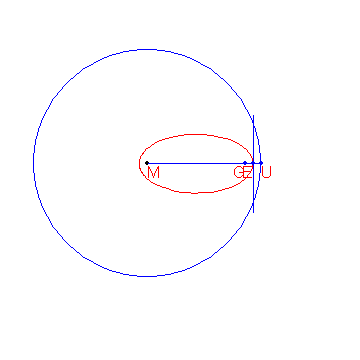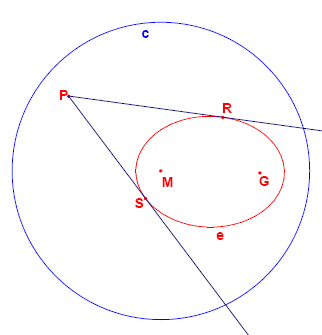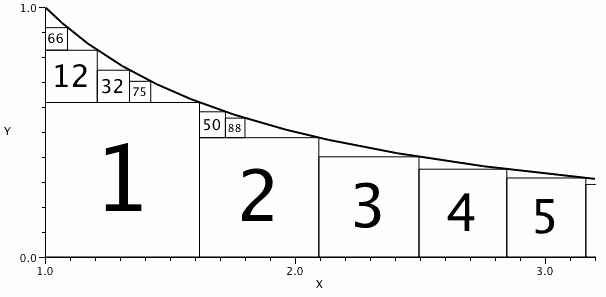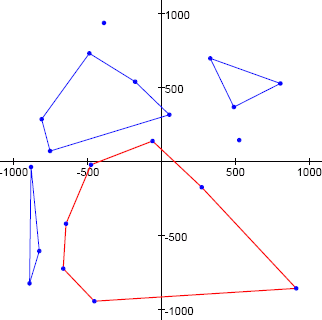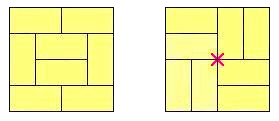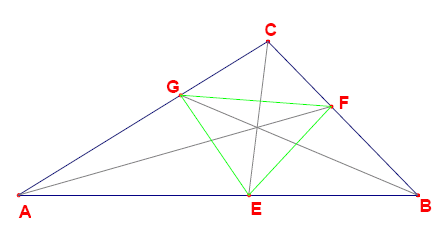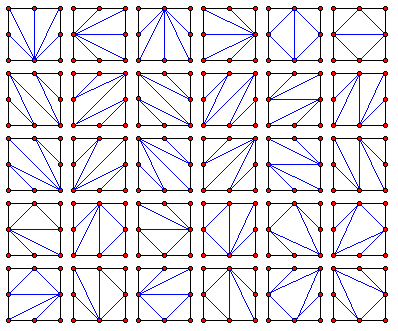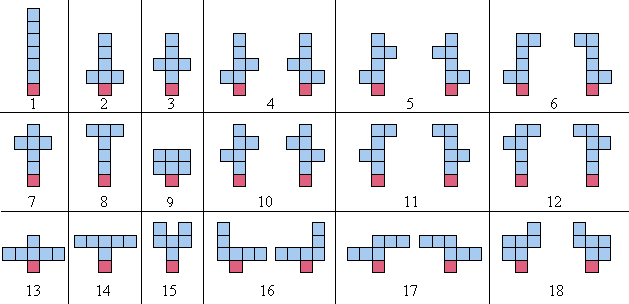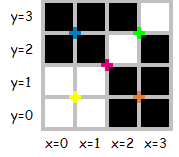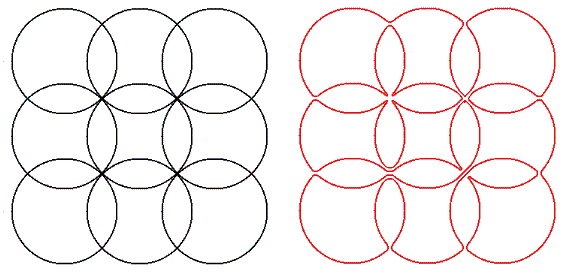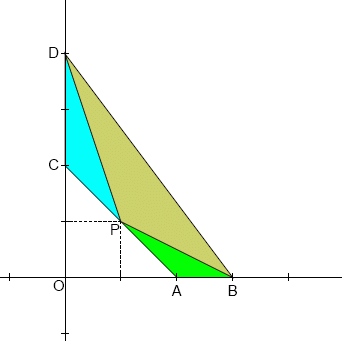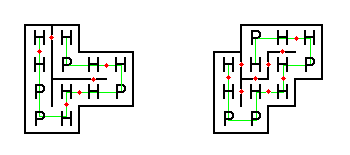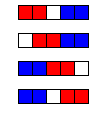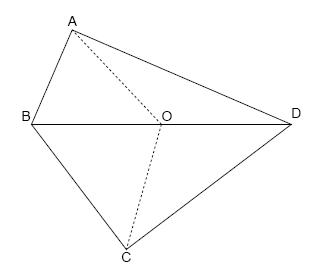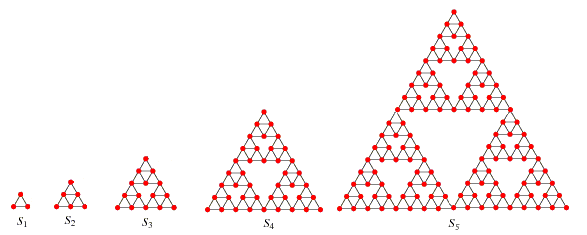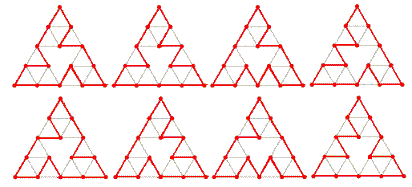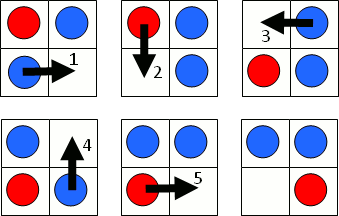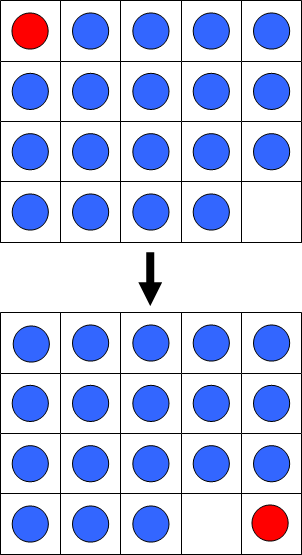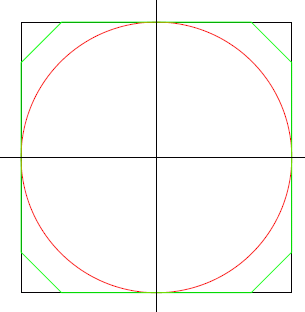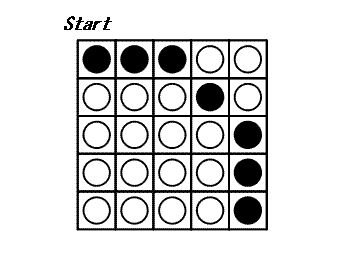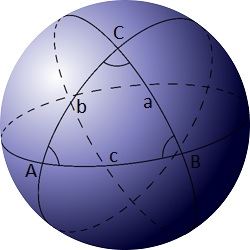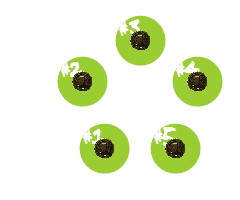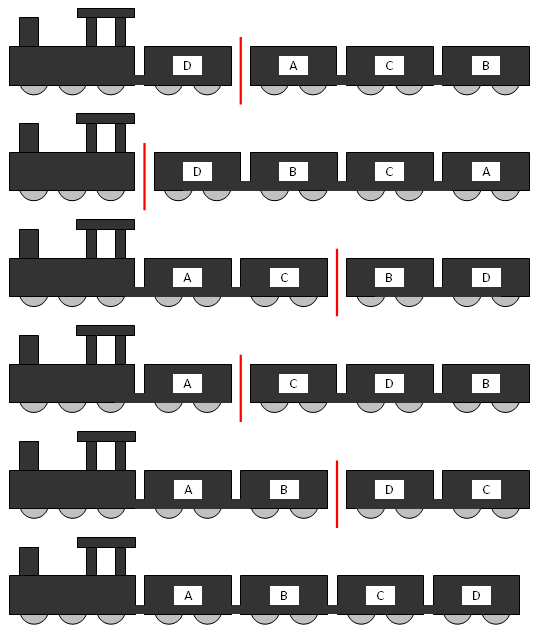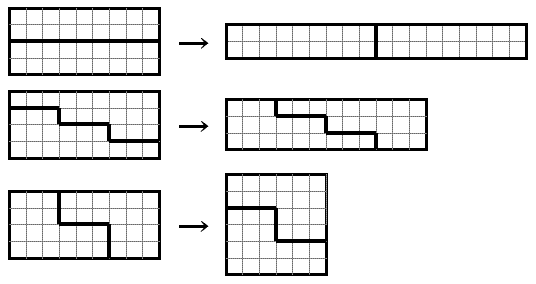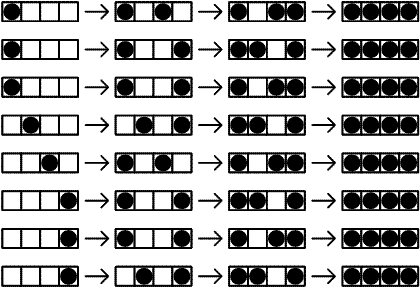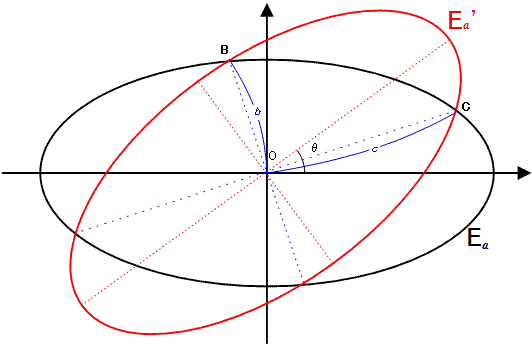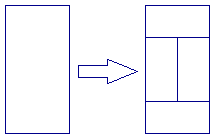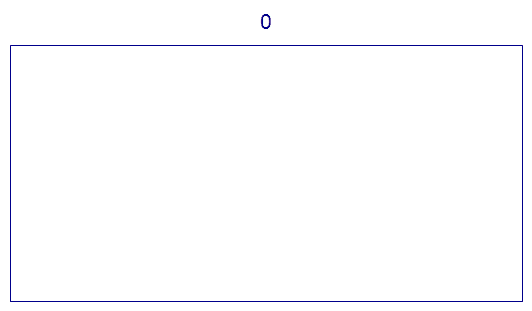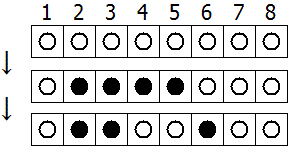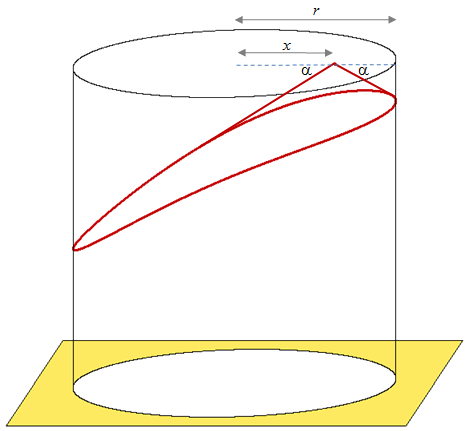imsky / Pocketeuler
Programming Languages
Pocket Euler
This is the offline version of Project Euler.
History
- Compiled by Kyle Keen.
- Converted to Github Markdown by Ivan Malopinsky.
- Missing answers provided by George Netu.
License
Project Euler is protected under CC Attribution-Non-Commercial-Share Alike 2.0 UK: England & Wales
Usage
^sup and [sub] are frequently use for subscripts/superscripts. Many symbols are utf8, my apologies if you are on a 7-bit TTY.
Answers are hashed with the MD5 algorithm. You can verify your answers online using JavaScript MD5.
If you're using Linux or OS X, you can use md5sum to verify your answers as well:
echo -n 'myanswer' | md5sum
Problem 1
Multiples of 3 and 5
If we list all the natural numbers below 10 that are multiples of 3 or 5, we get 3, 5, 6 and 9. The sum of these multiples is 23.
Find the sum of all the multiples of 3 or 5 below 1000.
Answer: e1edf9d1967ca96767dcc2b2d6df69f4
Problem 2
Even Fibonacci numbers
Each new term in the Fibonacci sequence is generated by adding the previous two terms. By starting with 1 and 2, the first 10 terms will be:
1, 2, 3, 5, 8, 13, 21, 34, 55, 89, ...
By considering the terms in the Fibonacci sequence whose values do not exceed four million, find the sum of the even-valued terms.
Answer: 4194eb91842c8e7e6df099ca73c38f28
Problem 3
Largest prime factor
The prime factors of 13195 are 5, 7, 13 and 29.
What is the largest prime factor of the number 600851475143?
Answer: 94c4dd41f9dddce696557d3717d98d82
Problem 4
Largest palindrome product
A palindromic number reads the same both ways. The largest palindrome made from the product of two 2-digit numbers is 9009 = 91 × 99.
Find the largest palindrome made from the product of two 3-digit numbers.
Answer: d4cfc27d16ea72a96b83d9bdef6ce2ec
Problem 5
Smallest multiple
2520 is the smallest number that can be divided by each of the numbers from 1 to 10 without any remainder.
What is the smallest positive number that is evenly divisible by all of the numbers from 1 to 20?
Answer: bc0d0a22a7a46212135ed0ba77d22f3a
Problem 6
Sum square difference
The sum of the squares of the first ten natural numbers is:
1^2 + 2^2 + ... + 10^2 = 385
The square of the sum of the first ten natural numbers is:
(1 + 2 + ... + 10)^2 = 55^2 = 3025
Hence the difference between the sum of the squares of the first ten natural numbers and the square of the sum is 3025 − 385 = 2640.
Find the difference between the sum of the squares of the first one hundred natural numbers and the square of the sum.
Answer: 867380888952c39a131fe1d832246ecc
Problem 7
10001st prime
By listing the first six prime numbers: 2, 3, 5, 7, 11, and 13, we can see that the 6th prime is 13.
What is the 10,001st prime number?
Answer: 8c32ab09ec0210af60d392e9b2009560
Problem 8
Largest product in a series
The four adjacent digits in the 1000-digit number that have the greatest product are 9 × 9 × 8 × 9 = 5832.
73167176531330624919225119674426574742355349194934
96983520312774506326239578318016984801869478851843
85861560789112949495459501737958331952853208805511
12540698747158523863050715693290963295227443043557
66896648950445244523161731856403098711121722383113
62229893423380308135336276614282806444486645238749
30358907296290491560440772390713810515859307960866
70172427121883998797908792274921901699720888093776
65727333001053367881220235421809751254540594752243
52584907711670556013604839586446706324415722155397
53697817977846174064955149290862569321978468622482
83972241375657056057490261407972968652414535100474
82166370484403199890008895243450658541227588666881
16427171479924442928230863465674813919123162824586
17866458359124566529476545682848912883142607690042
24219022671055626321111109370544217506941658960408
07198403850962455444362981230987879927244284909188
84580156166097919133875499200524063689912560717606
05886116467109405077541002256983155200055935729725
71636269561882670428252483600823257530420752963450
Find the thirteen adjacent digits in the 1000-digit number that have the greatest product. What is the value of this product?
Answer: 0f53ea7949d32ef24f9186207600403c
Problem 9
Special Pythagorean triplet
A Pythagorean triplet is a set of three natural numbers, a < b < c, for which,
a^2 + b^2 = c^2
For example, 3^2 + 4^2 = 9 + 16 = 25 = 5^2.
There exists exactly one Pythagorean triplet for which a + b + c = 1000. Find the product abc.
Answer: 24eaa9820350012ff678de47cb85b639
Problem 10
Summation of primes
The sum of the primes below 10 is 2 + 3 + 5 + 7 = 17.
Find the sum of all the primes below two million.
Answer: d915b2a9ac8749a6b837404815f1ae25
Problem 11
Largest product in a grid
In the 20×20 grid below, four numbers along a diagonal line have been marked in red.
The product of these numbers is 26 × 63 × 78 × 14 = 1788696.
What is the greatest product of four adjacent numbers in the same direction (up, down, left, right, or diagonally) in the 20×20 grid?
Answer: 678f5d2e1eaa42f04fa53411b4f441ac
Problem 12
Highly divisible triangular number
The sequence of triangle numbers is generated by adding the natural numbers. So the 7th triangle number would be 1 + 2 + 3 + 4 + 5 + 6 + 7 = 28.
The first ten terms would be:
1, 3, 6, 10, 15, 21, 28, 36, 45, 55, ...
Let us list the factors of the first seven triangle numbers:
1: 1
3: 1,3
6: 1,2,3,6
10: 1,2,5,10
15: 1,3,5,15
21: 1,3,7,21
28: 1,2,4,7,14,28
We can see that 28 is the first triangle number to have over five divisors.
What is the value of the first triangle number to have over five hundred divisors?
Answer: 8091de7d285989bbfa9a2f9f3bdcc7c0
Problem 13
Large sum
Work out the first ten digits of the sum of the following one-hundred 50-digit numbers.
37107287533902102798797998220837590246510135740250
46376937677490009712648124896970078050417018260538
74324986199524741059474233309513058123726617309629
91942213363574161572522430563301811072406154908250
23067588207539346171171980310421047513778063246676
89261670696623633820136378418383684178734361726757
28112879812849979408065481931592621691275889832738
44274228917432520321923589422876796487670272189318
47451445736001306439091167216856844588711603153276
70386486105843025439939619828917593665686757934951
62176457141856560629502157223196586755079324193331
64906352462741904929101432445813822663347944758178
92575867718337217661963751590579239728245598838407
58203565325359399008402633568948830189458628227828
80181199384826282014278194139940567587151170094390
35398664372827112653829987240784473053190104293586
86515506006295864861532075273371959191420517255829
71693888707715466499115593487603532921714970056938
54370070576826684624621495650076471787294438377604
53282654108756828443191190634694037855217779295145
36123272525000296071075082563815656710885258350721
45876576172410976447339110607218265236877223636045
17423706905851860660448207621209813287860733969412
81142660418086830619328460811191061556940512689692
51934325451728388641918047049293215058642563049483
62467221648435076201727918039944693004732956340691
15732444386908125794514089057706229429197107928209
55037687525678773091862540744969844508330393682126
18336384825330154686196124348767681297534375946515
80386287592878490201521685554828717201219257766954
78182833757993103614740356856449095527097864797581
16726320100436897842553539920931837441497806860984
48403098129077791799088218795327364475675590848030
87086987551392711854517078544161852424320693150332
59959406895756536782107074926966537676326235447210
69793950679652694742597709739166693763042633987085
41052684708299085211399427365734116182760315001271
65378607361501080857009149939512557028198746004375
35829035317434717326932123578154982629742552737307
94953759765105305946966067683156574377167401875275
88902802571733229619176668713819931811048770190271
25267680276078003013678680992525463401061632866526
36270218540497705585629946580636237993140746255962
24074486908231174977792365466257246923322810917141
91430288197103288597806669760892938638285025333403
34413065578016127815921815005561868836468420090470
23053081172816430487623791969842487255036638784583
11487696932154902810424020138335124462181441773470
63783299490636259666498587618221225225512486764533
67720186971698544312419572409913959008952310058822
95548255300263520781532296796249481641953868218774
76085327132285723110424803456124867697064507995236
37774242535411291684276865538926205024910326572967
23701913275725675285653248258265463092207058596522
29798860272258331913126375147341994889534765745501
18495701454879288984856827726077713721403798879715
38298203783031473527721580348144513491373226651381
34829543829199918180278916522431027392251122869539
40957953066405232632538044100059654939159879593635
29746152185502371307642255121183693803580388584903
41698116222072977186158236678424689157993532961922
62467957194401269043877107275048102390895523597457
23189706772547915061505504953922979530901129967519
86188088225875314529584099251203829009407770775672
11306739708304724483816533873502340845647058077308
82959174767140363198008187129011875491310547126581
97623331044818386269515456334926366572897563400500
42846280183517070527831839425882145521227251250327
55121603546981200581762165212827652751691296897789
32238195734329339946437501907836945765883352399886
75506164965184775180738168837861091527357929701337
62177842752192623401942399639168044983993173312731
32924185707147349566916674687634660915035914677504
99518671430235219628894890102423325116913619626622
73267460800591547471830798392868535206946944540724
76841822524674417161514036427982273348055556214818
97142617910342598647204516893989422179826088076852
87783646182799346313767754307809363333018982642090
10848802521674670883215120185883543223812876952786
71329612474782464538636993009049310363619763878039
62184073572399794223406235393808339651327408011116
66627891981488087797941876876144230030984490851411
60661826293682836764744779239180335110989069790714
85786944089552990653640447425576083659976645795096
66024396409905389607120198219976047599490197230297
64913982680032973156037120041377903785566085089252
16730939319872750275468906903707539413042652315011
94809377245048795150954100921645863754710598436791
78639167021187492431995700641917969777599028300699
15368713711936614952811305876380278410754449733078
40789923115535562561142322423255033685442488917353
44889911501440648020369068063960672322193204149535
41503128880339536053299340368006977710650566631954
81234880673210146739058568557934581403627822703280
82616570773948327592232845941706525094512325230608
22918802058777319719839450180888072429661980811197
77158542502016545090413245809786882778948721859617
72107838435069186155435662884062257473692284509516
20849603980134001723930671666823555245252804609722
53503534226472524250874054075591789781264330331690
Answer: 361113f19fd302adc31268f8283a4f2d
Problem 14
Longest Collatz sequence
The following iterative sequence is defined for the set of positive integers:
n → n/2 (n is even)
n → 3n + 1 (n is odd)
Using the rule above and starting with 13, we generate the following sequence:
13 → 40 → 20 → 10 → 5 → 16 → 8 → 4 → 2 → 1
It can be seen that this sequence (starting at 13 and finishing at 1) contains 10 terms. Although it has not been proved yet (Collatz Problem), it is thought that all starting numbers finish at 1.
Which starting number, under one million, produces the longest chain?
NOTE: Once the chain starts the terms are allowed to go above one million.
Answer: 5052c3765262bb2c6be537abd60b305e
Problem 15
Lattice paths
Starting in the top left corner of a 2×2 grid, and only being able to move to the right and down, there are exactly 6 routes to the bottom right corner.
How many such routes are there through a 20×20 grid?
Answer: 928f3957168ac592c4215dcd04e0b678
Problem 16
Power digit sum
2^15 = 32768 and the sum of its digits is 3 + 2 + 7 + 6 + 8 = 26.
What is the sum of the digits of the number 2^1000?
Answer: 6a5889bb0190d0211a991f47bb19a777
Problem 17
Number letter counts
If the numbers 1 to 5 are written out in words: one, two, three, four, five, then there are 3 + 3 + 5 + 4 + 4 = 19 letters used in total.
If all the numbers from 1 to 1000 (one thousand) inclusive were written out in words, how many letters would be used?
NOTE: Do not count spaces or hyphens. For example, 342 (three hundred and forty-two) contains 23 letters and 115 (one hundred and fifteen) contains 20 letters. The use of "and" when writing out numbers is in compliance with British usage.
Answer: 6a979d4a9cf85135408529edc8a133d0
Problem 18
Maximum path sum I
By starting at the top of the triangle below and moving to adjacent numbers on the row below, the maximum total from top to bottom is 23.
3
7 4
2 4 6
8 5 9 3
That is, 3 + 7 + 4 + 9 = 23.
Find the maximum total from top to bottom of the triangle below:
75
95 64
17 47 82
18 35 87 10
20 04 82 47 65
19 01 23 75 03 34
88 02 77 73 07 63 67
99 65 04 28 06 16 70 92
41 41 26 56 83 40 80 70 33
41 48 72 33 47 32 37 16 94 29
53 71 44 65 25 43 91 52 97 51 14
70 11 33 28 77 73 17 78 39 68 17 57
91 71 52 38 17 14 91 43 58 50 27 29 48
63 66 04 68 89 53 67 30 73 16 69 87 40 31
04 62 98 27 23 09 70 98 73 93 38 53 60 04 23
NOTE: As there are only 16384 routes, it is possible to solve this problem by trying every route. However, Problem 67, is the same challenge with a triangle containing one-hundred rows; it cannot be solved by brute force, and requires a clever method! ;o)
Answer: 708f3cf8100d5e71834b1db77dfa15d6
Problem 19
Counting Sundays
You are given the following information, but you may prefer to do some research for yourself.
-
1 Jan 1900 was a Monday.
-
Thirty days has September,
April, June and November.
All the rest have thirty-one,
Saving February alone,
Which has twenty-eight, rain or shine.
And on leap years, twenty-nine. -
A leap year occurs on any year evenly divisible by 4, but not on a century unless it is divisible by 400.
How many Sundays fell on the first of the month during the twentieth century (1 Jan 1901 to 31 Dec 2000)?
Answer: a4a042cf4fd6bfb47701cbc8a1653ada
Problem 20
Factorial digit sum
n! means n × (n − 1) × ... × 3 × 2 × 1
For example, 10! = 10 × 9 × ... × 3 × 2 × 1 = 3628800, and the sum of the digits in the number 10! is 3 + 6 + 2 + 8 + 8 + 0 + 0 = 27.
Find the sum of the digits in the number 100!
Answer: 443cb001c138b2561a0d90720d6ce111
Problem 21
Amicable numbers
Let d(n) be defined as the sum of proper divisors of n (numbers less than n which divide evenly into n). If d(a) = b and d(b) = a, where a ≠ b, then a and b are an amicable pair and each of a and b are called amicable numbers.
For example, the proper divisors of 220 are 1, 2, 4, 5, 10, 11, 20, 22, 44, 55 and 110; therefore d(220) = 284. The proper divisors of 284 are 1, 2, 4, 71 and 142; so d(284) = 220.
Evaluate the sum of all the amicable numbers under 10000.
Answer: 51e04cd4e55e7e415bf24de9e1b0f3ff
Problem 22
Names scores
Using names.txt, a 46K text file containing over five-thousand first names, begin by sorting it into alphabetical order. Then working out the alphabetical value for each name, multiply this value by its alphabetical position in the list to obtain a name score.
For example, when the list is sorted into alphabetical order, COLIN, which is worth 3 + 15 + 12 + 9 + 14 = 53, is the 938th name in the list. So, COLIN would obtain a score of 938 × 53 = 49714.
What is the total of all the name scores in the file?
Answer: f2c9c91cb025746f781fa4db8be3983f
Problem 23
Non-abundant sums
A perfect number is a number for which the sum of its proper divisors is exactly equal to the number. For example, the sum of the proper divisors of 28 would be 1 + 2 + 4 + 7 + 14 = 28, which means that 28 is a perfect number.
A number n is called deficient if the sum of its proper divisors is less than n and it is called abundant if this sum exceeds n.
As 12 is the smallest abundant number, 1 + 2 + 3 + 4 + 6 = 16, the smallest number that can be written as the sum of two abundant numbers is 24. By mathematical analysis, it can be shown that all integers greater than 28123 can be written as the sum of two abundant numbers. However, this upper limit cannot be reduced any further by analysis even though it is known that the greatest number that cannot be expressed as the sum of two abundant numbers is less than this limit.
Find the sum of all the positive integers which cannot be written as the sum of two abundant numbers.
Answer: 2c8258c0604152962f7787571511cf28
Problem 24
Lexicographic permutations
A permutation is an ordered arrangement of objects. For example, 3124 is one possible permutation of the digits 1, 2, 3 and 4. If all of the permutations are listed numerically or alphabetically, we call it lexicographic order. The lexicographic permutations of 0, 1 and 2 are:
012 021 102 120 201 210
What is the millionth lexicographic permutation of the digits 0, 1, 2, 3, 4, 5, 6, 7, 8 and 9?
Answer: 7f155b45cb3f0a6e518d59ec348bff84
Problem 25
1000-digit Fibonacci number
The Fibonacci sequence is defined by the recurrence relation:
F[n] = F[n−1] + F[n−2], where F[1] = 1 and F[2] = 1.
Hence the first 12 terms will be:
F[1] = 1
F[2] = 1
F[3] = 2
F[4] = 3
F[5] = 5
F[6] = 8
F[7] = 13
F[8] = 21
F[9] = 34
F[10] = 55
F[11] = 89
F[12] = 144
The 12th term, F[12], is the first term to contain three digits.
What is the first term in the Fibonacci sequence to contain 1000 digits?
Answer: a376802c0811f1b9088828288eb0d3f0
Problem 26
Reciprocal cycles
A unit fraction contains 1 in the numerator. The decimal representation of the unit fractions with denominators 2 to 10 are given:
1/2 = 0.5
1/3 = 0.(3)
1/4 = 0.25
1/5 = 0.2
1/6 = 0.1(6)
1/7 = 0.(142857)
1/8 = 0.125
1/9 = 0.(1)
1/10 = 0.1
Where 0.1(6) means 0.166666..., and has a 1-digit recurring cycle. It can be seen that 1/7 has a 6-digit recurring cycle.
Find the value of d < 1000 for which 1/d contains the longest recurring cycle in its decimal fraction part.
Answer: 6aab1270668d8cac7cef2566a1c5f569
Problem 27
Quadratic primes
Euler discovered the remarkable quadratic formula:
n² + n + 41
It turns out that the formula will produce 40 primes for the consecutive values n = 0 to 39. However, when n = 40, 40² + 40 + 41 = 40(40 + 1) + 41 is divisible by 41, and certainly when n = 41, 41² + 41 + 41 is clearly divisible by 41.
The incredible formula n² − 79n + 1601 was discovered, which produces 80 primes for the consecutive values n = 0 to 79. The product of the coefficients, −79 and 1601, is −126479.
Considering quadratics of the form:
n² + an + b, where |a| < 1000 and |b| < 1000
where |n| is the modulus/absolute value of n, e.g. |11| = 11 and |−4| = 4
Find the product of the coefficients, a and b, for the quadratic expression that produces the maximum number of primes for consecutive values of n, starting with n = 0.
Answer: 69d9e3218fd7abb6ff453ea96505183d
Problem 28
Number spiral diagonals
Starting with the number 1 and moving to the right in a clockwise direction a 5 by 5 spiral is formed as follows:
It can be verified that the sum of the numbers on the diagonals is 101.
What is the sum of the numbers on the diagonals in a 1001 by 1001 spiral formed in the same way?
Answer: 0d53425bd7c5bf9919df3718c8e49fa6
Problem 29
Distinct powers
Consider all integer combinations of a^b for 2 ≤ a ≤ 5 and 2 ≤ b ≤ 5:
2^2=4, 2^3=8, 2^4=16, 2^5=32
3^2=9, 3^3=27, 3^4=81, 3^5=243
4^2=16, 4^3=64, 4^4=256, 4^5=1024
5^2=25, 5^3=125, 5^4=625, 5^5=3125
If they are then placed in numerical order, with any repeats removed, we get the following sequence of 15 distinct terms:
4, 8, 9, 16, 25, 27, 32, 64, 81, 125, 243, 256, 625, 1024, 3125
How many distinct terms are in the sequence generated by a^b for 2 ≤ a ≤ 100 and 2 ≤ b ≤ 100?
Answer: 6f0ca67289d79eb35d19decbc0a08453
Problem 30
Digit fifth powers
Surprisingly there are only three numbers that can be written as the sum of fourth powers of their digits:
1634 = 1^4 + 6^4 + 3^4 + 4^4
8208 = 8^4 + 2^4 + 0^4 + 8^4
9474 = 9^4 + 4^4 + 7^4 + 4^4
As 1 = 1^4 is not a sum it is not included.
The sum of these numbers is 1634 + 8208 + 9474 = 19316.
Find the sum of all the numbers that can be written as the sum of fifth powers of their digits.
Answer: 27a1779a8a8c323a307ac8a70bc4489d
Problem 31
Coin sums
In England the currency is made up of pound, £, and pence, p, and there are eight coins in general circulation:
1p, 2p, 5p, 10p, 20p, 50p, £1 (100p) and £2 (200p).
It is possible to make £2 in the following way:
1×£1 + 1×50p + 2×20p + 1×5p + 1×2p + 3×1p
How many different ways can £2 be made using any number of coins?
Answer: 142dfe4a33d624d2b830a9257e96726d
Problem 32
Pandigital products
We shall say that an n-digit number is pandigital if it makes use of all the digits 1 to n exactly once; for example, the 5-digit number, 15234, is 1 through 5 pandigital.
The product 7254 is unusual, as the identity, 39 × 186 = 7254, containing multiplicand, multiplier, and product is 1 through 9 pandigital.
Find the sum of all products whose multiplicand/multiplier/product identity can be written as a 1 through 9 pandigital.
HINT: Some products can be obtained in more than one way so be sure to only include it once in your sum.
Answer: 100f6e37d0b0564490a2ee27eff0660d
Problem 33
Digit cancelling fractions
The fraction 49/98 is a curious fraction, as an inexperienced mathematician in attempting to simplify it may incorrectly believe that 49/98 = 4/8, which is correct, is obtained by cancelling the 9s.
We shall consider fractions like, 30/50 = 3/5, to be trivial examples.
There are exactly four non-trivial examples of this type of fraction, less than one in value, and containing two digits in the numerator and denominator.
If the product of these four fractions is given in its lowest common terms, find the value of the denominator.
Answer: f899139df5e1059396431415e770c6dd
Problem 34
Digit factorials
145 is a curious number, as 1! + 4! + 5! = 1 + 24 + 120 = 145.
Find the sum of all numbers which are equal to the sum of the factorial of their digits.
Note: as 1! = 1 and 2! = 2 are not sums they are not included.
Answer: 60803ea798a0c0dfb7f36397d8d4d772
Problem 35
Circular primes
The number, 197, is called a circular prime because all rotations of the digits: 197, 971, and 719, are themselves prime.
There are thirteen such primes below 100: 2, 3, 5, 7, 11, 13, 17, 31, 37, 71, 73, 79, and 97.
How many circular primes are there below one million?
Answer: b53b3a3d6ab90ce0268229151c9bde11
Problem 36
Double-base palindromes
The decimal number, 585 = 1001001001₂ (binary), is palindromic in both bases.
Find the sum of all numbers, less than one million, which are palindromic in base 10 and base 2.
(Please note that the palindromic number, in either base, may not include leading zeros.)
Answer: 0e175dc2f28833885f62e7345addff03
Problem 37
Truncatable primes
The number 3797 has an interesting property. Being prime itself, it is possible to continuously remove digits from left to right, and remain prime at each stage: 3797, 797, 97, and 7. Similarly we can work from right to left: 3797, 379, 37, and 3.
Find the sum of the only eleven primes that are both truncatable from left to right and right to left.
NOTE: 2, 3, 5, and 7 are not considered to be truncatable primes.
Answer: cace46c61b00de1b60874936a093981d
Problem 38
Pandigital multiples
Take the number 192 and multiply it by each of 1, 2, and 3:
192 × 1 = 192
192 × 2 = 384
192 × 3 = 576
By concatenating each product we get the 1 to 9 pandigital, 192384576. We will call 192384576 the concatenated product of 192 and (1,2,3)
The same can be achieved by starting with 9 and multiplying by 1, 2, 3, 4, and 5, giving the pandigital, 918273645, which is the concatenated product of 9 and (1,2,3,4,5).
What is the largest 1 to 9 pandigital 9-digit number that can be formed as the concatenated product of an integer with (1,2, ... , n) where n > 1?
Answer: f2a29ede8dc9fae7926dc7a4357ac25e
Problem 39
Integer right triangles
If p is the perimeter of a right angle triangle with integral length sides, {a,b,c}, there are exactly three solutions for p = 120.
{20,48,52}, {24,45,51}, {30,40,50}
For which value of p ≤ 1000, is the number of solutions maximised?
Answer: fa83a11a198d5a7f0bf77a1987bcd006
Problem 40
Champernowne's constant
An irrational decimal fraction is created by concatenating the positive integers: 0.123456789101112131415161718192021...
It can be seen that the 12th digit of the fractional part is 1.
If d[n] represents the nth digit of the fractional part, find the value of the following expression.
d[1] × d[10] × d[100] × d[1000] × d[10000] × d[100000] × d[1000000]
Answer: 6f3ef77ac0e3619e98159e9b6febf557
Problem 41
Pandigital prime
We shall say that an n-digit number is pandigital if it makes use of all the digits 1 to n exactly once. For example, 2143 is a 4-digit pandigital and is also prime.
What is the largest n-digit pandigital prime that exists?
Answer: d0a1bd6ab4229b2d0754be8923431404
Problem 42
Coded triangle numbers
The nth term of the sequence of triangle numbers is given by, t[n] = ½n(n+1); so the first ten triangle numbers are:
1, 3, 6, 10, 15, 21, 28, 36, 45, 55, ...
By converting each letter in a word to a number corresponding to its alphabetical position and adding these values we form a word value. For example, the word value for SKY is 19 + 11 + 25 = 55 = t[10]. If the word value is a triangle number then we shall call the word a triangle word.
Using words.txt, a 16K text file containing nearly two-thousand common English words, how many are triangle words?
Answer: 82aa4b0af34c2313a562076992e50aa3
Problem 43
Sub-string divisibility
The number, 1406357289, is a 0 to 9 pandigital number because it is made up of each of the digits 0 to 9 in some order, but it also has a rather interesting sub-string divisibility property.
Let d[1] be the 1st digit, d[2] be the 2nd digit, and so on. In this way, we note the following:
- $d_2d_3d_4=406$ is divisible by 2
- $d_3d_4d_5=063$ is divisible by 3
- $d_4d_5d_6=635$ is divisible by 5
- $d_5d_6d_7=357$ is divisible by 7
- $d_6d_7d_8=572$ is divisible by 11
- $d_7d_8d_9=728$ is divisible by 13
- $d_8d_9d_10=289$ is divisible by 17
Find the sum of all 0 to 9 pandigital numbers with this property.
Answer: 115253b7721af0fdff25cd391dfc70cf
Problem 44
Pentagon numbers
Pentagonal numbers are generated by the formula, P[n]=n(3n−1)/2. The first ten pentagonal numbers are:
1, 5, 12, 22, 35, 51, 70, 92, 117, 145, ...
It can be seen that P[4] + P[7] = 22 + 70 = 92 = P[8]. However, their difference, 70 − 22 = 48, is not pentagonal.
Find the pair of pentagonal numbers, P[j] and P[k], for which their sum and difference are pentagonal and D = |P[k] − P[j]| is minimised; what is the value of D?
Answer: 2c2556cb85621309ca647465ffa62370
Problem 45
Triangular, pentagonal, and hexagonal
Triangle, pentagonal, and hexagonal numbers are generated by the following formulae:
Triangle T[n]=n(n+1)/2 1, 3, 6, 10, 15, ...
Pentagonal P[n]=n(3n−1)/2 1, 5, 12, 22, 35, ...
Hexagonal H[n]=n(2n−1) 1, 6, 15, 28, 45, ...
It can be verified that T[285] = P[165] = H[143] = 40755.
Find the next triangle number that is also pentagonal and hexagonal.
Answer: 30dfe3e3b286add9d12e493ca7be63fc
Problem 46
Goldbach's other conjecture
It was proposed by Christian Goldbach that every odd composite number can be written as the sum of a prime and twice a square.
9 = 7 + 2×1²
15 = 7 + 2×2²
21 = 3 + 2×3²
25 = 7 + 2×3²
27 = 19 + 2×2²
33 = 31 + 2×1²
It turns out that the conjecture was false.
What is the smallest odd composite that cannot be written as the sum of a prime and twice a square?
Answer: 89abe98de6071178edb1b28901a8f459
Problem 47
Distinct primes factors
The first two consecutive numbers to have two distinct prime factors are:
14 = 2 × 7
15 = 3 × 5
The first three consecutive numbers to have three distinct prime factors are:
644 = 2² × 7 × 23
645 = 3 × 5 × 43
646 = 2 × 17 × 19.
Find the first four consecutive integers to have four distinct prime factors. What is the first of these numbers?
Answer: 748f517ecdc29106e2738f88aa7530f4
Problem 48
Self powers
The series, 1¹ + 2² + 3³ + ... + 10¹⁰ = 10405071317.
Find the last ten digits of the series, 1¹ + 2² + 3³ + ... + 1000¹⁰⁰⁰.
Answer: 0829124724747ae1c65da8cae5263346
Problem 49
Prime permutations
The arithmetic sequence, 1487, 4817, 8147, in which each of the terms increases by 3330, is unusual in two ways: (i) each of the three terms are prime, and, (ii) each of the 4-digit numbers are permutations of one another.
There are no arithmetic sequences made up of three 1-, 2-, or 3-digit primes, exhibiting this property, but there is one other 4-digit increasing sequence.
What 12-digit number do you form by concatenating the three terms in this sequence?
Answer: 0b99933d3e2a9addccbb663d46cbb592
Problem 50
Consecutive prime sum
The prime 41, can be written as the sum of six consecutive primes:
41 = 2 + 3 + 5 + 7 + 11 + 13
This is the longest sum of consecutive primes that adds to a prime below one-hundred.
The longest sum of consecutive primes below one-thousand that adds to a prime, contains 21 terms, and is equal to 953.
Which prime, below one-million, can be written as the sum of the most consecutive primes?
Answer: 73229bab6c5dc1c7cf7a4fa123caf6bc
Problem 51
Prime digit replacements
By replacing the 1st digit of the 2-digit number *3, it turns out that six of the nine possible values: 13, 23, 43, 53, 73, and 83, are all prime.
By replacing the 3rd and 4th digits of 56**3 with the same digit, this 5-digit number is the first example having seven primes among the ten generated numbers, yielding the family: 56003, 56113, 56333, 56443, 56663, 56773, and 56993. Consequently 56003, being the first member of this family, is the smallest prime with this property.
Find the smallest prime which, by replacing part of the number (not necessarily adjacent digits) with the same digit, is part of an eight prime value family.
Answer: e2a8daa5eb919905dadd795593084c22
Problem 52
Permuted multiples
It can be seen that the number, 125874, and its double, 251748, contain exactly the same digits, but in a different order.
Find the smallest positive integer, x, such that 2x, 3x, 4x, 5x, and 6x, contain the same digits.
Answer: a420384997c8a1a93d5a84046117c2aa
Problem 53
Combinatoric selections
There are exactly ten ways of selecting three from five, 12345:
123, 124, 125, 134, 135, 145, 234, 235, 245, and 345
In combinatorics, we use the notation, 5C[3] = 10.
In general,
nC[r] = ___n!___ ,where r ≤ n, n! = n×(n−1)×...×3×2×1, and 0! = 1.
r!(n−r)!
It is not until n = 23, that a value exceeds one-million: 23C[10] = 1144066.
How many, not necessarily distinct, values of nC[r], for 1 ≤ n ≤ 100, are greater than one-million?
Answer: e3b21256183cf7c2c7a66be163579d37
Problem 54
Poker hands
In the card game poker, a hand consists of five cards and are ranked, from lowest to highest, in the following way:
- High Card: Highest value card.
- One Pair: Two cards of the same value.
- Two Pairs: Two different pairs.
- Three of a Kind: Three cards of the same value.
- Straight: All cards are consecutive values.
- Flush: All cards of the same suit.
- Full House: Three of a kind and a pair.
- Four of a Kind: Four cards of the same value.
- Straight Flush: All cards are consecutive values of same suit.
- Royal Flush: Ten, Jack, Queen, King, Ace, in same suit.
The cards are valued in the order: 2, 3, 4, 5, 6, 7, 8, 9, 10, Jack, Queen, King, Ace.
If two players have the same ranked hands then the rank made up of the highest value wins; for example, a pair of eights beats a pair of fives (see example 1 below). But if two ranks tie, for example, both players have a pair of queens, then highest cards in each hand are compared (see example 4 below); if the highest cards tie then the next highest cards are compared, and so on.
Consider the following five hands dealt to two players:
Hand Player 1 Player 2 Winner
1 5H 5C 6S 7S KD 2C 3S 8S 8D TD Player 2
Pair of Fives Pair of Eights
2 5D 8C 9S JS AC 2C 5C 7D 8S QH Player 1
Highest card Ace Highest card Queen
3 2D 9C AS AH AC 3D 6D 7D TD QD Player 2
Three Aces Flush with Diamonds
4D 6S 9H QH QC 3D 6D 7H QD QS
4 Pair of Queens Pair of Queens Player 1
Highest card Nine Highest card Seven
5 2H 2D 4C 4D 4S 3C 3D 3S 9S 9D
Full House Full House Player 1
With Three Fours with Three Threes
The file, poker.txt, contains one-thousand random hands dealt to two players. Each line of the file contains ten cards (separated by a single space): the first five are Player 1's cards and the last five are Player 2's cards. You can assume that all hands are valid (no invalid characters or repeated cards), each player's hand is in no specific order, and in each hand there is a clear winner.
How many hands does Player 1 win?
Answer: 142949df56ea8ae0be8b5306971900a4
Problem 55
Lychrel numbers
If we take 47, reverse and add, 47 + 74 = 121, which is palindromic.
Not all numbers produce palindromes so quickly. For example,
349 + 943 = 1292,
1292 + 2921 = 4213
4213 + 3124 = 7337
That is, 349 took three iterations to arrive at a palindrome.
Although no one has proved it yet, it is thought that some numbers, like 196, never produce a palindrome. A number that never forms a palindrome through the reverse and add process is called a Lychrel number. Due to the theoretical nature of these numbers, and for the purpose of this problem, we shall assume that a number is Lychrel until proven otherwise. In addition you are given that for every number below ten-thousand, it will either (i) become a palindrome in less than fifty iterations, or, (ii) no one, with all the computing power that exists, has managed so far to map it to a palindrome. In fact, 10677 is the first number to be shown to require over fifty iterations before producing a palindrome: 4668731596684224866951378664 (53 iterations, 28-digits).
Surprisingly, there are palindromic numbers that are themselves Lychrel numbers; the first example is 4994.
How many Lychrel numbers are there below ten-thousand?
NOTE: Wording was modified slightly on 24 April 2007 to emphasise the theoretical nature of Lychrel numbers.
Answer: 077e29b11be80ab57e1a2ecabb7da330
Problem 56
Powerful digit sum
A googol (10^100) is a massive number: one followed by one-hundred zeros; 100^100 is almost unimaginably large: one followed by two-hundred zeros. Despite their size, the sum of the digits in each number is only 1.
Considering natural numbers of the form, a^b, where a, b < 100, what is the maximum digital sum?
Answer: c22abfa379f38b5b0411bc11fa9bf92f
Problem 57
Square root convergents
It is possible to show that the square root of two can be expressed as an infinite continued fraction.
√ 2 = 1 + 1/(2 + 1/(2 + 1/(2 + ... ))) = 1.414213...
By expanding this for the first four iterations, we get:
1 + 1/2 = 3/2 = 1.5
1 + 1/(2 + 1/2) = 7/5 = 1.4
1 + 1/(2 + 1/(2 + 1/2)) = 17/12 = 1.41666...
1 + 1/(2 + 1/(2 + 1/(2 + 1/2))) = 41/29 = 1.41379...
The next three expansions are 99/70, 239/169, and 577/408, but the eighth expansion, 1393/985, is the first example where the number of digits in the numerator exceeds the number of digits in the denominator.
In the first one-thousand expansions, how many fractions contain a numerator with more digits than denominator?
Answer: b3e3e393c77e35a4a3f3cbd1e429b5dc
Problem 58
Spiral primes
Starting with 1 and spiralling anticlockwise in the following way, a square spiral with side length 7 is formed.
It is interesting to note that the odd squares lie along the bottom right diagonal, but what is more interesting is that 8 out of the 13 numbers lying along both diagonals are prime; that is, a ratio of 8/13 ≈ 62%.
If one complete new layer is wrapped around the spiral above, a square spiral with side length 9 will be formed. If this process is continued, what is the side length of the square spiral for which the ratio of primes along both diagonals first falls below 10%?
Answer: b62fc92a2561538525c89be63f36bf7b
Problem 59
XOR decryption
Each character on a computer is assigned a unique code and the preferred standard is ASCII (American Standard Code for Information Interchange). For example, uppercase A = 65, asterisk (*) = 42, and lowercase k = 107.
A modern encryption method is to take a text file, convert the bytes to ASCII, then XOR each byte with a given value, taken from a secret key. The advantage with the XOR function is that using the same encryption key on the cipher text, restores the plain text; for example, 65 XOR 42 = 107, then 107 XOR 42 = 65.
For unbreakable encryption, the key is the same length as the plain text message, and the key is made up of random bytes. The user would keep the encrypted message and the encryption key in different locations, and without both "halves", it is impossible to decrypt the message.
Unfortunately, this method is impractical for most users, so the modified method is to use a password as a key. If the password is shorter than the message, which is likely, the key is repeated cyclically throughout the message. The balance for this method is using a sufficiently long password key for security, but short enough to be memorable.
Your task has been made easy, as the encryption key consists of three lower case characters. Using cipher1.txt, a file containing the encrypted ASCII codes, and the knowledge that the plain text must contain common English words, decrypt the message and find the sum of the ASCII values in the original text.
Answer: 68f891fe214e2bfa07c998ad5d0a390f
Problem 60
Prime pair sets
The primes 3, 7, 109, and 673, are quite remarkable. By taking any two primes and concatenating them in any order the result will always be prime. For example, taking 7 and 109, both 7109 and 1097 are prime. The sum of these four primes, 792, represents the lowest sum for a set of four primes with this property.
Find the lowest sum for a set of five primes for which any two primes concatenate to produce another prime.
Answer: a4b5a70ca8cf24d0eb4330748d1e72e5
Problem 61
Cyclical figurate numbers
Triangle, square, pentagonal, hexagonal, heptagonal, and octagonal numbers are all figurate (polygonal) numbers and are generated by the following formulae:
Triangle P[3,n]=n(n+1)/2 1, 3, 6, 10, 15, ...
Square P[4,n]=n^2 1, 4, 9, 16, 25, ...
Pentagonal P[5,n]=n(3n−1)/2 1, 5, 12, 22, 35, ...
Hexagonal P[6,n]=n(2n−1) 1, 6, 15, 28, 45, ...
Heptagonal P[7,n]=n(5n−3)/2 1, 7, 18, 34, 55, ...
Octagonal P[8,n]=n(3n−2) 1, 8, 21, 40, 65, ...
The ordered set of three 4-digit numbers: 8128, 2882, 8281, has three interesting properties.
- The set is cyclic, in that the last two digits of each number is the first two digits of the next number (including the last number with the first).
- Each polygonal type: triangle (P[3,127]=8128), square (P[4,91]=8281), and pentagonal (P[5,44]=2882), is represented by a different number in the set.
- This is the only set of 4-digit numbers with this property.
Find the sum of the only ordered set of six cyclic 4-digit numbers for which each polygonal type: triangle, square, pentagonal, hexagonal, heptagonal, and octagonal, is represented by a different number in the set.
Answer: caec17d84884addeec35c3610645ab63
Problem 62
Cubic permutations
The cube, 41063625 (345³), can be permuted to produce two other cubes: 56623104 (384³) and 66430125 (405³). In fact, 41063625 is the smallest cube which has exactly three permutations of its digits which are also cube.
Find the smallest cube for which exactly five permutations of its digits are cube.
Answer: 8f46b522b5401b8b6df99a7410eea44b
Problem 63
Powerful digit counts
The 5-digit number, 16807=7^5, is also a fifth power. Similarly, the 9-digit number, 134217728=8^9, is a ninth power.
How many n-digit positive integers exist which are also an nth power?
Answer: f457c545a9ded88f18ecee47145a72c0
Problem 64
Odd period square roots
All square roots are periodic when written as continued fractions and can be written in the form:
√N = a[0] + ___________1___________
a[1] + _______1_______
a[2] + ____1___
a[3] + …
For example, let us consider √23:
√23 = 4 + √23 — 4 = 4 + ___1___ = 4 + ______1______
__1__ 1 + _√23 – 3_
√23—4 7
If we continue we would get the following expansion:
√23 = 4 + _________1__________
1 + ______ 1________
3 + _____1______
1 + ___1____
8 + …
The process can be summarised as follows:
a[0] = 4, __1__ = _√23+4_ = 1 + _√23—3_
√23—4 7 7
a[1] = 1, __7__ = _7(√23+3)_ = 3 + _√23—3_
√23—3 14 2
a[2] = 3, __2__ = _2(√23+3)_ = 1 + _√23—4_
√23—3 14 7
a[3] = 1, __7__ = _7(√23+4)_ = 8 + √23—4
√23—4 7
a[4] = 8, __1__ = _√23+4_ = 1 + _√23—3_
√23—4 7 7
a[5] = 1, __7__ = _7(√23+3)_ = 3 + _√23—3_
√23—3 14 2
a[6] = 3, __2__ = _2(√23+3)_ = 1 + _√23—4_
√23—3 14 7
a[7] = 1, __7__ = _7(√23+4)_ = 8 + √23—4
√23—4 7
It can be seen that the sequence is repeating. For conciseness, we use the notation √23 = [4;(1,3,1,8)], to indicate that the block (1,3,1,8) repeats indefinitely.
The first ten continued fraction representations of (irrational) square roots are:
√2=[1;(2)], period=1
√3=[1;(1,2)], period=2
√5=[2;(4)], period=1
√6=[2;(2,4)], period=2
√7=[2;(1,1,1,4)], period=4
√8=[2;(1,4)], period=2
√10=[3;(6)], period=1
√11=[3;(3,6)], period=2
√12= [3;(2,6)], period=2
√13=[3;(1,1,1,1,6)], period=5
Exactly four continued fractions, for N ≤ 13, have an odd period.
How many continued fractions for N ≤ 10000 have an odd period?
Answer: dc960c46c38bd16e953d97cdeefdbc68
Problem 65
Convergents of e
The square root of 2 can be written as an infinite continued fraction.
√2 = 1 + _________1________
2 + _______1______
2 + _____1____
2 + ___1__
2 + …
The infinite continued fraction can be written, √2 = [1;(2)], (2) indicates that 2 repeats ad infinitum. In a similar way, √23 = [4;(1,3,1,8)].
It turns out that the sequence of partial values of continued fractions for square roots provide the best rational approximations. Let us consider the convergents for √2.
1 + _1_ = 3/2
2
1 + __1__ = 7/5
2 +_1_
2
1 + ____1____ = 17/12
2 + __1__
2 +_1_
2
1 + ______1______ = 41/29
2 + ____1____
2 + __1__
2 +_1_
2
Hence the sequence of the first ten convergents for √2 are:
1, 3/2, 7/5, 17/12, 41/29, 99/70, 239/169, 577/408, 1393/985, 3363/2378, …
What is most surprising is that the important mathematical constant, e = [2; 1,2,1, 1,4,1, 1,6,1 , ... , 1,2k,1, ...].
The first ten terms in the sequence of convergents for e are:
2, 3, 8/3, 11/4, 19/7, 87/32, 106/39, 193/71, 1264/465, 1457/536, ...
The sum of digits in the numerator of the 10^th convergent is 1+4+5+7=17.
Find the sum of digits in the numerator of the 100^th convergent of the continued fraction for e.
Answer: 7a614fd06c325499f1680b9896beedeb
Problem 66
Diophantine equation
Consider quadratic Diophantine equations of the form: x² – Dy² = 1
For example, when D=13, the minimal solution in x is 649² – 13×180² = 1.
It can be assumed that there are no solutions in positive integers when D is square.
By finding minimal solutions in x for D = {2, 3, 5, 6, 7}, we obtain the following:
3² – 2×2² = 1
2² – 3×1² = 1
9² – 5×4² = 1
5² – 6×2² = 1
8² – 7×3² = 1
Hence, by considering minimal solutions in x for D ≤ 7, the largest x is obtained when D=5.
Find the value of D ≤ 1000 in minimal solutions of x for which the largest value of x is obtained.
Answer: 3a066bda8c96b9478bb0512f0a43028c
Problem 67
Maximum path sum II
By starting at the top of the triangle below and moving to adjacent numbers on the row below, the maximum total from top to bottom is 23.
3
7 4
2 4 6
8 5 9 3
That is, 3 + 7 + 4 + 9 = 23.
Find the maximum total from top to bottom in triangle.txt, a 15K text file containing a triangle with one-hundred rows.
NOTE: This is a much more difficult version of Problem 18. It is not possible to try every route to solve this problem, as there are 2^99 altogether! If you could check one trillion (10^12) routes every second it would take over twenty billion years to check them all. There is an efficient algorithm to solve it. ;o)
Answer: 9d702ffd99ad9c70ac37e506facc8c38
Problem 68
Magic 5-gon ring
Consider the following "magic" 3-gon ring, filled with the numbers 1 to 6, and each line adding to nine.
Working clockwise, and starting from the group of three with the numerically lowest external node (4,3,2 in this example), each solution can be described uniquely. For example, the above solution can be described by the set: 4,3,2; 6,2,1; 5,1,3.
It is possible to complete the ring with four different totals: 9, 10, 11, and 12. There are eight solutions in total.
Total Solution Set
9 4,2,3; 5,3,1; 6,1,2
9 4,3,2; 6,2,1; 5,1,3
10 2,3,5; 4,5,1; 6,1,3
10 2,5,3; 6,3,1; 4,1,5
11 1,4,6; 3,6,2; 5,2,4
11 1,6,4; 5,4,2; 3,2,6
12 1,5,6; 2,6,4; 3,4,5
12 1,6,5; 3,5,4; 2,4,6
By concatenating each group it is possible to form 9-digit strings; the maximum string for a 3-gon ring is 432621513.
Using the numbers 1 to 10, and depending on arrangements, it is possible to form 16- and 17-digit strings. What is the maximum 16-digit string for a "magic" 5-gon ring?
Answer: 26227442c6fed0292a528ac3790175be
Problem 69
Totient maximum
Euler's Totient function, φ(n) (sometimes called the phi function), is used to determine the number of numbers less than n which are relatively prime to n. For example, as 1, 2, 4, 5, 7, and 8, are all less than nine and relatively prime to nine, φ(9)=6.
| n | Relatively Prime | φ(n) | n/φ(n) |
|---|---|---|---|
| 2 | 1 | 1 | 2 |
| 3 | 1, 2 | 2 | 1.5 |
| 4 | 1, 3 | 2 | 2 |
| 5 | 1, 2, 3, 4 | 4 | 1.25 |
| 6 | 1, 5 | 2 | 3 |
| 7 | 1, 2, 3, 4, 5, 6 | 6 | 1.166… |
| 8 | 1, 3, 5, 7 | 4 | 2 |
| 9 | 1, 2, 4, 5, 7, 8 | 6 | 1.5 |
| 10 | 1, 3, 7, 9 | 4 | 2.5 |
It can be seen that n=6 produces a maximum n/φ(n) for n ≤ 10.
Find the value of n ≤ 1,000,000 for which n/φ(n) is a maximum.
Answer: bf08b01ead83cbd62a9839ca1cf35ada
Problem 70
Totient permutation
Euler's Totient function, φ(n) (sometimes called the phi function), is used to determine the number of positive numbers less than or equal to n which are relatively prime to n. For example, as 1, 2, 4, 5, 7, and 8, are all less than nine and relatively prime to nine, φ(9)=6. The number 1 is considered to be relatively prime to every positive number, so φ(1)=1.
Interestingly, φ(87109)=79180, and it can be seen that 87109 is a permutation of 79180.
Find the value of n, 1 < n < 10^7, for which φ(n) is a permutation of n and the ratio n/φ(n) produces a minimum.
Answer: 1884dde67ced589082c8b7043abce181
Problem 71
Ordered fractions
Consider the fraction, n/d, where n and d are positive integers. If n<d and HCF(n,d)=1, it is called a reduced proper fraction.
If we list the set of reduced proper fractions for d ≤ 8 in ascending order of size, we get:
1/8, 1/7, 1/6, 1/5, 1/4, 2/7, 1/3, 3/8, 2/5, 3/7, 1/2, 4/7, 3/5, 5/8, 2/3, 5/7, 3/4, 4/5, 5/6, 6/7, 7/8
It can be seen that 2/5 is the fraction immediately to the left of 3/7.
By listing the set of reduced proper fractions for d ≤ 1,000,000 in ascending order of size, find the numerator of the fraction immediately to the left of 3/7.
Answer: 71f38fa2f04db30be52f883d583bfd6f
Problem 72
Counting fractions
Consider the fraction, n/d, where n and d are positive integers. If n<d and HCF(n,d)=1, it is called a reduced proper fraction.
If we list the set of reduced proper fractions for d ≤ 8 in ascending order of size, we get:
1/8, 1/7, 1/6, 1/5, 1/4, 2/7, 1/3, 3/8, 2/5, 3/7, 1/2, 4/7, 3/5, 5/8, 2/3, 5/7, 3/4, 4/5, 5/6, 6/7, 7/8
It can be seen that there are 21 elements in this set.
How many elements would be contained in the set of reduced proper fractions for d ≤ 1,000,000?
Answer: 0384fb529dc651fe0f460acff3e9ac5d
Problem 73
Counting fractions in a range
Consider the fraction, n/d, where n and d are positive integers. If n<d and HCF(n,d)=1, it is called a reduced proper fraction.
If we list the set of reduced proper fractions for d ≤ 8 in ascending order of size, we get:
1/8, 1/7, 1/6, 1/5, 1/4, 2/7, 1/3, 3/8, 2/5, 3/7, 1/2, 4/7, 3/5, 5/8, 2/3, 5/7, 3/4, 4/5, 5/6, 6/7, 7/8
It can be seen that there are 3 fractions between 1/3 and 1/2.
How many fractions lie between 1/3 and 1/2 in the sorted set of reduced proper fractions for d ≤ 12,000?
Answer: 990a49eb474672444137fff1e5528a1b
Problem 74
Digit factorial chains
The number 145 is well known for the property that the sum of the factorial of its digits is equal to 145:
1! + 4! + 5! = 1 + 24 + 120 = 145
Perhaps less well known is 169, in that it produces the longest chain of numbers that link back to 169; it turns out that there are only three such loops that exist:
169 → 363601 → 1454 → 169
871 → 45361 → 871
872 → 45362 → 872
It is not difficult to prove that EVERY starting number will eventually get stuck in a loop. For example,
69 → 363600 → 1454 → 169 → 363601 (→ 1454)
78 → 45360 → 871 → 45361 (→ 871)
540 → 145 (→ 145)
Starting with 69 produces a chain of five non-repeating terms, but the longest non-repeating chain with a starting number below one million is sixty terms.
How many chains, with a starting number below one million, contain exactly sixty non-repeating terms?
Answer: 69cb3ea317a32c4e6143e665fdb20b14
Problem 75
Singular integer right triangles
It turns out that 12 cm is the smallest length of wire that can be bent to form an integer sided right angle triangle in exactly one way, but there are many more examples.
12 cm: (3,4,5)
24 cm: (6,8,10)
30 cm: (5,12,13)
36 cm: (9,12,15)
40 cm: (8,15,17)
48 cm: (12,16,20)
In contrast, some lengths of wire, like 20 cm, cannot be bent to form an integer sided right angle triangle, and other lengths allow more than one solution to be found; for example, using 120 cm it is possible to form exactly three different integer sided right angle triangles.
120 cm: (30,40,50), (20,48,52), (24,45,51)
Given that L is the length of the wire, for how many values of L ≤ 1,500,000 can exactly one integer sided right angle triangle be formed?
Answer: 583e391a7bd87f785412f72f486433cb
Problem 76
Counting summations
It is possible to write five as a sum in exactly six different ways:
4 + 1
3 + 2
3 + 1 + 1
2 + 2 + 1
2 + 1 + 1 + 1
1 + 1 + 1 + 1 + 1
How many different ways can one hundred be written as a sum of at least two positive integers?
Answer: 18ed0f01e082beffe0049ae1272689d2
Problem 77
Prime summations
It is possible to write ten as the sum of primes in exactly five different ways:
7 + 3
5 + 5
5 + 3 + 2
3 + 3 + 2 + 2
2 + 2 + 2 + 2 + 2
What is the first value which can be written as the sum of primes in over five thousand different ways?
Answer: e2c420d928d4bf8ce0ff2ec19b371514
Problem 78
Coin partitions
Let p(n) represent the number of different ways in which n coins can be separated into piles. For example, five coins can separated into piles in exactly seven different ways, so p(5)=7.
OOOOO
OOOO O
OOO OO
OOO O O
OO OO O
OO O O O
O O O O O
Find the least value of n for which p(n) is divisible by one million.
Answer: ef2a8695e428116131cc94c651d0e566
Problem 79
Passcode derivation
A common security method used for online banking is to ask the user for three random characters from a passcode. For example, if the passcode was 531278, they may ask for the 2nd, 3rd, and 5th characters; the expected reply would be: 317.
The text file, keylog.txt, contains fifty successful login attempts.
Given that the three characters are always asked for in order, analyse the file so as to determine the shortest possible secret passcode of unknown length.
Answer: 3ccc6e16d99b21d42948f6d49b90fa30
Problem 80
Square root digital expansion
It is well known that if the square root of a natural number is not an integer, then it is irrational. The decimal expansion of such square roots is infinite without any repeating pattern at all.
The square root of two is 1.41421356237309504880..., and the digital sum of the first one hundred decimal digits is 475.
For the first one hundred natural numbers, find the total of the digital sums of the first one hundred decimal digits for all the irrational square roots.
Answer: 6cc501a25298e4051886ef1a126e9484
Problem 81
Path sum: two ways
In the 5 by 5 matrix below, the minimal path sum from the top left to the bottom right, by only moving to the right and down, is indicated in bold red and is equal to 2427.
Find the minimal path sum, in matrix.txt, a 31K text file containing a 80 by 80 matrix, from the top left to the bottom right by only moving right and down.
Answer: f9ffec84499832add77e6a8bb00246ec
Problem 82
Path sum: three ways
NOTE: This problem is a more challenging version of Problem 81.
The minimal path sum in the 5 by 5 matrix below, by starting in any cell in the left column and finishing in any cell in the right column, and only moving up, down, and right, is indicated in red; the sum is equal to 994.
Find the minimal path sum, in matrix.txt, a 31K text file containing a 80 by 80 matrix, from the left column to the right column.
Answer: e6b3b1cd89b018d4754cf63863f6690a
Problem 83
Path sum: four ways
NOTE: This problem is a significantly more challenging version of Problem 81.
In the 5 by 5 matrix below, the minimal path sum from the top left to the bottom right, by moving left, right, up, and down, is indicated in red and is equal to 2297.
Find the minimal path sum, in matrix.txt, a 31K text file containing a 80 by 80 matrix, from the top left to the bottom right by moving left, right, up, and down.
Answer: 61b28c4fbe8560003ee50fa5619d7a1e
Problem 84
Monopoly odds
In the game, Monopoly, the standard board is set up in the following way:
GO A1 CC1 A2 T1 R1 B1 CH1 B2 B3 JAIL
H2 C1
T2 U1
H1 C2
CH3 C3
R4 R2
G3 D1
CC3 CC2
G2 D2
G1 D3
G2J F3 U2 F2 F1 R3 E3 E2 CH2 E1 FP
A player starts on the GO square and adds the scores on two 6-sided dice to determine the number of squares they advance in a clockwise direction. Without any further rules we would expect to visit each square with equal probability: 2.5%. However, landing on G2J (Go To Jail), CC (community chest), and CH (chance) changes this distribution.
In addition to G2J, and one card from each of CC and CH, that orders the player to go directly to jail, if a player rolls three consecutive doubles, they do not advance the result of their 3rd roll. Instead they proceed directly to jail.
At the beginning of the game, the CC and CH cards are shuffled. When a player lands on CC or CH they take a card from the top of the respective pile and, after following the instructions, it is returned to the bottom of the pile. There are sixteen cards in each pile, but for the purpose of this problem we are only concerned with cards that order a movement; any instruction not concerned with movement will be ignored and the player will remain on the CC/CH square.
Community Chest (2/16 cards):
- Advance to GO
- Go to JAIL
Chance (10/16 cards):
- Advance to GO
- Go to JAIL
- Go to C1
- Go to E3
- Go to H2
- Go to R1
- Go to next R (railway company)
- Go to next R
- Go to next U (utility company)
- Go back 3 squares.
The heart of this problem concerns the likelihood of visiting a particular square. That is, the probability of finishing at that square after a roll. For this reason it should be clear that, with the exception of G2J for which the probability of finishing on it is zero, the CH squares will have the lowest probabilities, as 5/8 request a movement to another square, and it is the final square that the player finishes at on each roll that we are interested in. We shall make no distinction between "Just Visiting" and being sent to JAIL, and we shall also ignore the rule about requiring a double to "get out of jail", assuming that they pay to get out on their next turn.
By starting at GO and numbering the squares sequentially from 00 to 39 we can concatenate these two-digit numbers to produce strings that correspond with sets of squares.
Statistically it can be shown that the three most popular squares, in order, are JAIL (6.24%) = Square 10, E3 (3.18%) = Square 24, and GO (3.09%) = Square 00. So these three most popular squares can be listed with the six-digit modal string: 102400.
If, instead of using two 6-sided dice, two 4-sided dice are used, find the six-digit modal string.
Answer: ead3264438ef83a8c2da2e98067b4445
Problem 85
Counting rectangles
By counting carefully it can be seen that a rectangular grid measuring 3 by 2 contains eighteen rectangles:
Although there exists no rectangular grid that contains exactly two million rectangles, find the area of the grid with the nearest solution.
Answer: 92bf5e6240737e0326ea59846a83e076
Problem 86
Cuboid route
A spider, S, sits in one corner of a cuboid room, measuring 6 by 5 by 3, and a fly, F, sits in the opposite corner. By travelling on the surfaces of the room the shortest "straight line" distance from S to F is 10 and the path is shown on the diagram.
However, there are up to three "shortest" path candidates for any given cuboid and the shortest route doesn't always have integer length.
By considering all cuboid rooms with integer dimensions, up to a maximum size of M by M by M, there are exactly 2060 cuboids for which the shortest route has integer length when M=100, and this is the least value of M for which the number of solutions first exceeds two thousand; the number of solutions is 1975 when M=99.
Find the least value of M such that the number of solutions first exceeds one million.
Answer: f5c3dd7514bf620a1b85450d2ae374b1
Problem 87
Prime power triples
The smallest number expressible as the sum of a prime square, prime cube, and prime fourth power is 28. In fact, there are exactly four numbers below fifty that can be expressed in such a way:
28 = 2^2 + 2^3 + 2^4
33 = 3^2 + 2^3 + 2^4
49 = 5^2 + 2^3 + 2^4
47 = 2^2 + 3^3 + 2^4
How many numbers below fifty million can be expressed as the sum of a prime square, prime cube, and prime fourth power?
Answer: e7fb7907f1af626cc42e787e367ec602
Problem 88
Product-sum numbers
A natural number, N, that can be written as the sum and product of a given set of at least two natural numbers, {a[1], a[2], ... , a[k]} is called a product-sum number: N = a[1] + a[2] + ... + a[k] = a[1] × a[2] × ... × a[k].
For example, 6 = 1 + 2 + 3 = 1 × 2 × 3.
For a given set of size, k, we shall call the smallest N with this property a minimal product-sum number. The minimal product-sum numbers for sets of size, k = 2, 3, 4, 5, and 6 are as follows.
k=2: 4 = 2 × 2 = 2 + 2
k=3: 6 = 1 × 2 × 3 = 1 + 2 + 3
k=4: 8 = 1 × 1 × 2 × 4 = 1 + 1 + 2 + 4
k=5: 8 = 1 × 1 × 2 × 2 × 2 = 1 + 1 + 2 + 2 + 2
k=6: 12 = 1 × 1 × 1 × 1 × 2 × 6 = 1 + 1 + 1 + 1 + 2 + 6
Hence for 2≤k≤6, the sum of all the minimal product-sum numbers is 4+6+8+12 = 30; note that 8 is only counted once in the sum.
In fact, as the complete set of minimal product-sum numbers for 2≤k≤12 is {4, 6, 8, 12, 15, 16}, the sum is 61.
What is the sum of all the minimal product-sum numbers for 2≤k≤12000?
Answer: ffde7251f43906d31534ae69fa555757
Problem 89
Roman numerals
The rules for writing Roman numerals allow for many ways of writing each number (see [1]About Roman Numerals...). However, there is always a "best" way of writing a particular number.
For example, the following represent all of the legitimate ways of writing the number sixteen:
IIIIIIIIIIIIIIII
VIIIIIIIIIII
VVIIIIII
XIIIIII
VVVI
XVI
The last example being considered the most efficient, as it uses the least number of numerals.
The 11K text file, roman.txt, contains one thousand numbers written in valid, but not necessarily minimal, Roman numerals; that is, they are arranged in descending units and obey the subtractive pair rule (see About Roman Numerals for the definitive rules for this problem).
Find the number of characters saved by writing each of these in their minimal form.
Note: You can assume that all the Roman numerals in the file contain no more than four consecutive identical units.
Answer: 5c572eca050594c7bc3c36e7e8ab9550
Problem 90
Cube digit pairs
Each of the six faces on a cube has a different digit (0 to 9) written on it; the same is done to a second cube. By placing the two cubes side-by-side in different positions we can form a variety of 2-digit numbers.
For example, the square number 64 could be formed:
In fact, by carefully choosing the digits on both cubes it is possible to display all of the square numbers below one-hundred: 01, 04, 09, 16, 25, 36, 49, 64, and 81.
For example, one way this can be achieved is by placing {0, 5, 6, 7, 8, 9} on one cube and {1, 2, 3, 4, 8, 9} on the other cube.
However, for this problem we shall allow the 6 or 9 to be turned upside-down so that an arrangement like {0, 5, 6, 7, 8, 9} and {1, 2, 3, 4, 6, 7} allows for all nine square numbers to be displayed; otherwise it would be impossible to obtain 09.
In determining a distinct arrangement we are interested in the digits on each cube, not the order.
- {1, 2, 3, 4, 5, 6} is equivalent to {3, 6, 4, 1, 2, 5}
- {1, 2, 3, 4, 5, 6} is distinct from {1, 2, 3, 4, 5, 9}
But because we are allowing 6 and 9 to be reversed, the two distinct sets in the last example both represent the extended set {1, 2, 3, 4, 5, 6, 9} for the purpose of forming 2-digit numbers.
How many distinct arrangements of the two cubes allow for all of the square numbers to be displayed?
Answer: 6a61d423d02a1c56250dc23ae7ff12f3
Problem 91
Right triangles with integer coordinates
The points P (x[1], y[1]) and Q (x[2], y[2]) are plotted at integer co-ordinates and are joined to the origin, O(0,0), to form ΔOPQ.
There are exactly fourteen triangles containing a right angle that can be formed when each co-ordinate lies between 0 and 2 inclusive; that is, 0 ≤ x[1], y[1], x[2], y[2] ≤ 2.
Given that 0 ≤ x[1], y[1], x[2], y[2] ≤ 50, how many right triangles can be formed?
Answer: e8dc153260a59d4f236cfd7439d5dfd3
Problem 92
Square digit chains
A number chain is created by continuously adding the square of the digits in a number to form a new number until it has been seen before.
For example,
44 → 32 → 13 → 10 → 1 → 1
85 → 89 → 145 → 42 → 20 → 4 → 16 → 37 → 58 → 89
Therefore any chain that arrives at 1 or 89 will become stuck in an endless loop. What is most amazing is that EVERY starting number will eventually arrive at 1 or 89.
How many starting numbers below ten million will arrive at 89?
Answer: 6cee918c0612bccc2dac03d05e07035f
Problem 93
Arithmetic expressions
By using each of the digits from the set, {1, 2, 3, 4}, exactly once, and making use of the four arithmetic operations (+, −, *, /) and brackets/parentheses, it is possible to form different positive integer targets.
For example,
8 = (4 * (1 + 3)) / 2
14 = 4 * (3 + 1 / 2)
19 = 4 * (2 + 3) − 1
36 = 3 * 4 * (2 + 1)
Note that concatenations of the digits, like 12 + 34, are not allowed.
Using the set, {1, 2, 3, 4}, it is possible to obtain thirty-one different target numbers of which 36 is the maximum, and each of the numbers 1 to 28 can be obtained before encountering the first non-expressible number.
Find the set of four distinct digits, a < b < c < d, for which the longest set of consecutive positive integers, 1 to n, can be obtained, giving your answer as a string: abcd.
Answer: 26588e932c7ccfa1df309280702fe1b5
Problem 94
Almost equilateral triangles
It is easily proved that no equilateral triangle exists with integral length sides and integral area. However, the almost equilateral triangle 5-5-6 has an area of 12 square units.
We shall define an almost equilateral triangle to be a triangle for which two sides are equal and the third differs by no more than one unit.
Find the sum of the perimeters of all almost equilateral triangles with integral side lengths and area and whose perimeters do not exceed one billion (1,000,000,000).
Answer: 3218c6bb59f2539ec39ad4bf37c10913
Problem 95
Amicable chains
The proper divisors of a number are all the divisors excluding the number itself. For example, the proper divisors of 28 are 1, 2, 4, 7, and 14. As the sum of these divisors is equal to 28, we call it a perfect number.
Interestingly the sum of the proper divisors of 220 is 284 and the sum of the proper divisors of 284 is 220, forming a chain of two numbers. For this reason, 220 and 284 are called an amicable pair.
Perhaps less well known are longer chains. For example, starting with 12496, we form a chain of five numbers:
12496 → 14288 → 15472 → 14536 → 14264 (→ 12496 → ...)
Since this chain returns to its starting point, it is called an amicable chain.
Find the smallest member of the longest amicable chain with no element exceeding one million.
Answer: cd2018beeece5fb0a71a96308e567bde
Problem 96
Su Doku
Su Doku (Japanese meaning number place) is the name given to a popular puzzle concept. Its origin is unclear, but credit must be attributed to Leonhard Euler who invented a similar, and much more difficult, puzzle idea called Latin Squares. The objective of Su Doku puzzles, however, is to replace the blanks (or zeros) in a 9 by 9 grid in such that each row, column, and 3 by 3 box contains each of the digits 1 to 9. Below is an example of a typical starting puzzle grid and its solution grid.
┌───────┬───────┬───────┐ ┌───────┬───────┬───────┐
│ 0 0 3 │ 0 2 0 │ 6 0 0 │ │ 4 8 3 │ 9 2 1 │ 6 5 7 │
│ 9 0 0 │ 3 0 5 │ 0 0 1 │ │ 9 6 7 │ 3 4 5 │ 8 2 1 │
│ 0 0 1 │ 8 0 6 │ 4 0 0 │ │ 2 5 1 │ 8 7 6 │ 4 9 3 │
├───────┼───────┼───────┤ ├───────┼───────┼───────┤
│ 0 0 8 │ 1 0 2 │ 9 0 0 │ │ 5 4 8 │ 1 3 2 │ 9 7 6 │
│ 7 0 0 │ 0 0 0 │ 0 0 8 │ │ 7 2 9 │ 5 6 4 │ 1 3 8 │
│ 0 0 6 │ 7 0 8 │ 2 0 0 │ │ 1 3 6 │ 7 9 8 │ 2 4 5 │
├───────┼───────┼───────┤ ├───────┼───────┼───────┤
│ 0 0 2 │ 6 0 9 │ 5 0 0 │ │ 3 7 2 │ 6 8 9 │ 5 1 4 │
│ 8 0 0 │ 2 0 3 │ 0 0 9 │ │ 8 1 4 │ 2 5 3 │ 7 6 9 │
│ 0 0 5 │ 0 1 0 │ 3 0 0 │ │ 6 9 5 │ 4 1 7 │ 3 8 2 │
└───────┴───────┴───────┘ └───────┴───────┴───────┘
A well constructed Su Doku puzzle has a unique solution and can be solved by logic, although it may be necessary to employ "guess and test" methods in order to eliminate options (there is much contested opinion over this). The complexity of the search determines the difficulty of the puzzle; the example above is considered easy because it can be solved by straight forward direct deduction.
The 6K text file, sudoku.txt, contains fifty different Su Doku puzzles ranging in difficulty, but all with unique solutions (the first puzzle in the file is the example above).
By solving all fifty puzzles find the sum of the 3-digit numbers found in the top left corner of each solution grid; for example, 483 is the 3-digit number found in the top left corner of the solution grid above.
Answer: 26f6abfa0d7725fef678e371897d5df0
Problem 97
Large non-Mersenne prime
The first known prime found to exceed one million digits was discovered in 1999, and is a Mersenne prime of the form 2^6972593−1; it contains exactly 2,098,960 digits. Subsequently other Mersenne primes, of the form 2^p−1, have been found which contain more digits.
However, in 2004 there was found a massive non-Mersenne prime which contains 2,357,207 digits: 28433×2^7830457+1.
Find the last ten digits of this prime number.
Answer: 68c8c919526039022b923a72d5cc12b1
Problem 98
Anagramic squares
By replacing each of the letters in the word CARE with 1, 2, 9, and 6 respectively, we form a square number: 1296 = 36^2. What is remarkable is that, by using the same digital substitutions, the anagram, RACE, also forms a square number: 9216 = 96^2. We shall call CARE (and RACE) a square anagram word pair and specify further that leading zeroes are not permitted, neither may a different letter have the same digital value as another letter.
Using words.txt, a 16K text file containing nearly two-thousand common English words, find all the square anagram word pairs (a palindromic word is NOT considered to be an anagram of itself).
What is the largest square number formed by any member of such a pair?
NOTE: All anagrams formed must be contained in the given text file.
Answer: 36b3b5f54143786b7ab2ebb6bcd06e75
Problem 99
Largest exponential
Comparing two numbers written in index form like 2^11 and 3^7 is not difficult, as any calculator would confirm that 2^11 = 2048 < 3^7 = 2187.
However, confirming that 632382^518061 > 519432^525806 would be much more difficult, as both numbers contain over three million digits.
Using base_exp.txt, a 22K text file containing one thousand lines with a base/exponent pair on each line, determine which line number has the greatest numerical value.
NOTE: The first two lines in the file represent the numbers in the example given above.
Answer: 1ecfb463472ec9115b10c292ef8bc986
Problem 100
Arranged probability
If a box contains twenty-one coloured discs, composed of fifteen blue discs and six red discs, and two discs were taken at random, it can be seen that the probability of taking two blue discs, P(BB) = (15/21)×(14/20) = 1/2.
The next such arrangement, for which there is exactly 50% chance of taking two blue discs at random, is a box containing eighty-five blue discs and thirty-five red discs.
By finding the first arrangement to contain over 10^12 = 1,000,000,000,000 discs in total, determine the number of blue discs that the box would contain.
Answer: 21156e3acc4ca35b7a318c541a0648d5
Problem 101
Optimum polynomial
If we are presented with the first k terms of a sequence it is impossible to say with certainty the value of the next term, as there are infinitely many polynomial functions that can model the sequence.
As an example, let us consider the sequence of cube numbers. This is defined by the generating function, u[n] = n^3: 1, 8, 27, 64, 125, 216, ...
Suppose we were only given the first two terms of this sequence. Working on the principle that "simple is best" we should assume a linear relationship and predict the next term to be 15 (common difference 7). Even if we were presented with the first three terms, by the same principle of simplicity, a quadratic relationship should be assumed.
We shall define OP(k, n) to be the nth term of the optimum polynomial generating function for the first k terms of a sequence. It should be clear that OP(k, n) will accurately generate the terms of the sequence for n ≤ k, and potentially the first incorrect term (FIT) will be OP(k, k+1); in which case we shall call it a bad OP (BOP).
As a basis, if we were only given the first term of sequence, it would be most sensible to assume constancy; that is, for n ≥ 2, OP(1, n) = u[1].
Hence we obtain the following OPs for the cubic sequence:
OP(1, n) = 1 1,[1], 1, 1, ...
OP(2, n) = 7n−6 1, 8, [15], ...
OP(3, n) = 6n^2−11n+6 1, 8, 27, [58], ...
OP(4, n) = n^3 1, 8, 27, 64, 125, ...
Clearly no BOPs exist for k ≥ 4.
By considering the sum of FITs generated by the BOPs (indicated in brackets above), we obtain 1 + 15 + 58 = 74.
Consider the following tenth degree polynomial generating function:
u[n] = 1 − n + n^2 − n^3 + n^4 − n^5 + n^6 − n^7 + n^8 − n^9 + n^10
Find the sum of FITs for the BOPs.
Answer: d382b0cc25e82446da83d3a792e1cd27
Problem 102
Triangle containment
Three distinct points are plotted at random on a Cartesian plane, for which -1000 ≤ x, y ≤ 1000, such that a triangle is formed.
Consider the following two triangles:
A(-340,495), B(-153,-910), C(835,-947)
X(-175,41), Y(-421,-714), Z(574,-645)
It can be verified that triangle ABC contains the origin, whereas triangle XYZ does not.
Using triangles.txt, a 27K text file containing the co-ordinates of one thousand "random" triangles, find the number of triangles for which the interior contains the origin.
NOTE: The first two examples in the file represent the triangles in the example given above.
Answer: 74db120f0a8e5646ef5a30154e9f6deb
Problem 103
Special subset sums: optimum
Let S(A) represent the sum of elements in set A of size n. We shall call it a special sum set if for any two non-empty disjoint subsets, B and C, the following properties are true:
- S(B) ≠ S(C); that is, sums of subsets cannot be equal.
- If B contains more elements than C then S(B) > S(C).
If S(A) is minimised for a given n, we shall call it an optimum special sum set. The first five optimum special sum sets are given below.
n = 1: {1}
n = 2: {1, 2}
n = 3: {2, 3, 4}
n = 4: {3, 5, 6, 7}
n = 5: {6, 9, 11, 12, 13}
It seems that for a given optimum set, A = {a[1], a[2], ... , a[n]}, the next optimum set is of the form B = {b, a[1]+b, a[2]+b, ... ,a[n]+b}, where b is the "middle" element on the previous row.
By applying this "rule" we would expect the optimum set for n = 6 to be A = {11, 17, 20, 22, 23, 24}, with S(A) = 117. However, this is not the optimum set, as we have merely applied an algorithm to provide a near optimum set. The optimum set for n = 6 is A = {11, 18, 19, 20, 22, 25}, with S(A) = 115 and corresponding set string: 111819202225.
Given that A is an optimum special sum set for n = 7, find its set string.
NOTE: This problem is related to Problem 105 and Problem 106.
Answer: af8c238336c2a79bb81a24b3fef3330d
Problem 104
Pandigital Fibonacci ends
The Fibonacci sequence is defined by the recurrence relation:
F[n] = F[n−1] + F[n−2], where F[1] = 1 and F[2] = 1.
It turns out that F[541], which contains 113 digits, is the first Fibonacci number for which the last nine digits are 1-9 pandigital (contain all the digits 1 to 9, but not necessarily in order). And F[2749], which contains 575 digits, is the first Fibonacci number for which the first nine digits are 1-9 pandigital.
Given that F[k] is the first Fibonacci number for which the first nine digits AND the last nine digits are 1-9 pandigital, find k.
Answer: c8771ddd4df191098d70a8e94dd1cde7
Problem 105
Special subset sums: testing
Let S(A) represent the sum of elements in set A of size n. We shall call it a special sum set if for any two non-empty disjoint subsets, B and C, the following properties are true:
i. S(B) ≠ S(C); that is, sums of subsets cannot be equal. ii. If B contains more elements than C then S(B) > S(C).
For example, {81, 88, 75, 42, 87, 84, 86, 65} is not a special sum set because 65 + 87 + 88 = 75 + 81 + 84, whereas {157, 150, 164, 119, 79, 159, 161, 139, 158} satisfies both rules for all possible subset pair combinations and S(A) = 1286.
Using sets.txt, a 4K text file with one-hundred sets containing seven to twelve elements (the two examples given above are the first two sets in the file), identify all the special sum sets, A[1], A[2], ..., A[k], and find the value of S(A[1]) + S(A[2]) + ... + S(A[k]).
NOTE: This problem is related to Problem 103 and Problem 106.
Answer: c87d30e494eff438fe37b4c810167da0
Problem 106
Special subset sums: meta-testing
Let S(A) represent the sum of elements in set A of size n. We shall call it a special sum set if for any two non-empty disjoint subsets, B and C, the following properties are true:
i. S(B) ≠ S(C); that is, sums of subsets cannot be equal. ii. If B contains more elements than C then S(B) > S(C).
For this problem we shall assume that a given set contains n strictly increasing elements and it already satisfies the second rule.
Surprisingly, out of the 25 possible subset pairs that can be obtained from a set for which n = 4, only 1 of these pairs need to be tested for equality (first rule). Similarly, when n = 7, only 70 out of the 966 subset pairs need to be tested.
For n = 12, how many of the 261625 subset pairs that can be obtained need to be tested for equality?
NOTE: This problem is related to Problem 103 and Problem 105.
Answer: c8fd9e36fdeb06bcc93a0732c667b6d8
Problem 107
Minimal network
The following undirected network consists of seven vertices and twelve edges with a total weight of 243.
The same network can be represented by the matrix below.
┌──────┬────┬────┬────┬────┬────┬────┬────┐
│ │ A │ B │ C │ D │ E │ F │ G │
├──────┼────┼────┼────┼────┼────┼────┼────┤
│ A │ - │ 16 │ 12 │ 21 │ - │ - │ - │
├──────┼────┼────┼────┼────┼────┼────┼────┤
│ B │ 16 │ - │ - │ 17 │ 20 │ - │ - │
├──────┼────┼────┼────┼────┼────┼────┼────┤
│ C │ 12 │ - │ - │ 28 │ - │ 31 │ - │
├──────┼────┼────┼────┼────┼────┼────┼────┤
│ D │ 21 │ 17 │ 28 │ - │ 18 │ 19 │ 23 │
├──────┼────┼────┼────┼────┼────┼────┼────┤
│ E │ - │ 20 │ - │ 18 │ - │ - │ 11 │
├──────┼────┼────┼────┼────┼────┼────┼────┤
│ F │ - │ - │ 31 │ 19 │ - │ - │ 27 │
├──────┼────┼────┼────┼────┼────┼────┼────┤
│ G │ - │ - │ - │ 23 │ 11 │ 27 │ - │
└──────┴────┴────┴────┴────┴────┴────┴────┘
However, it is possible to optimise the network by removing some edges and still ensure that all points on the network remain connected. The network which achieves the maximum saving is shown below. It has a weight of 93, representing a saving of 243 − 93 = 150 from the original network.
Using network.txt, a 6K text file containing a network with forty vertices, and given in matrix form, find the maximum saving which can be achieved by removing redundant edges whilst ensuring that the network remains connected.
Answer: b0db1202ec966e7855ca23626eb285b8
Problem 108
Diophantine reciprocals I
In the following equation x, y, and n are positive integers.
1 1 1
─ + ─ = ─
x y n
For n = 4 there are exactly three distinct solutions:
1 1 1
─ + ─ = ─
5 20 4
1 1 1
─ + ─ = ─
6 12 4
1 1 1
─ + ─ = ─
8 8 4
What is the least value of n for which the number of distinct solutions exceeds one-thousand?
NOTE: This problem is an easier version of Problem 110; it is strongly advised that you solve this one first.
Answer: 765ba18edd2844db2db95fba25d2f3e7
Problem 109
Darts
In the game of darts a player throws three darts at a target board which is split into twenty equal sized sections numbered one to twenty.
The score of a dart is determined by the number of the region that the dart lands in. A dart landing outside the red/green outer ring scores zero. The black and cream regions inside this ring represent single scores. However, the red/green outer ring and middle ring score double and treble scores respectively.
At the centre of the board are two concentric circles called the bull region, or bulls-eye. The outer bull is worth 25 points and the inner bull is a double, worth 50 points.
There are many variations of rules but in the most popular game the players will begin with a score 301 or 501 and the first player to reduce their running total to zero is a winner. However, it is normal to play a "doubles out" system, which means that the player must land a double (including the double bulls-eye at the centre of the board) on their final dart to win; any other dart that would reduce their running total to one or lower means the score for that set of three darts is "bust".
When a player is able to finish on their current score it is called a "checkout" and the highest checkout is 170: T20 T20 D25 (two treble 20s and double bull).
There are exactly eleven distinct ways to checkout on a score of 6:
┌──┬──┬──┐
│D3│ │ │
├──┼──┼──┤
│D1│D2│ │
├──┼──┼──┤
│S2│D2│ │
├──┼──┼──┤
│D2│D1│ │
├──┼──┼──┤
│S4│D1│ │
├──┼──┼──┤
│S1│S1│D2│
├──┼──┼──┤
│S1│T1│D1│
├──┼──┼──┤
│S1│S3│D1│
├──┼──┼──┤
│D1│D1│D1│
├──┼──┼──┤
│D1│S2│D1│
├──┼──┼──┤
│S2│S2│D1│
└──┴──┴──┘
Note that D1 D2 is considered different to D2 D1 as they finish on different doubles. However, the combination S1 T1 D1 is considered the same as T1 S1 D1.
In addition we shall not include misses in considering combinations; for example, D3 is the same as 0 D3 and 0 0 D3.
Incredibly there are 42336 distinct ways of checking out in total.
How many distinct ways can a player checkout with a score less than 100?
Answer: e6aebd5be1ba81557dbcc5f6f57bbe5c
Problem 110
Diophantine reciprocals II
In the following equation x, y, and n are positive integers.
1 1 1
─ + ─ = ─
x y n
It can be verified that when n = 1260 there are 113 distinct solutions and this is the least value of n for which the total number of distinct solutions exceeds one hundred.
What is the least value of n for which the number of distinct solutions exceeds four million?
NOTE: This problem is a much more difficult version of Problem 108 and as it is well beyond the limitations of a brute force approach it requires a clever implementation.
Answer: 591a7a92f10322866e6a02f3b2386a1c
Problem 111
Primes with runs
Considering 4-digit primes containing repeated digits it is clear that they cannot all be the same: 1111 is divisible by 11, 2222 is divisible by 22, and so on. But there are nine 4-digit primes containing three ones:
1117, 1151, 1171, 1181, 1511, 1811, 2111, 4111, 8111
We shall say that M(n, d) represents the maximum number of repeated digits for an n-digit prime where d is the repeated digit, N(n, d) represents the number of such primes, and S(n, d) represents the sum of these primes.
So M(4, 1) = 3 is the maximum number of repeated digits for a 4-digit prime where one is the repeated digit, there are N(4, 1) = 9 such primes, and the sum of these primes is S(4, 1) = 22275. It turns out that for d = 0, it is only possible to have M(4, 0) = 2 repeated digits, but there are N(4, 0) = 13 such cases.
In the same way we obtain the following results for 4-digit primes.
| Digit, d | M(4, d) | N(4, d) | S(4,d) |
|---|---|---|---|
| 0 | 2 | 13 | 67061 |
| 1 | 3 | 9 | 22275 |
| 2 | 3 | 1 | 2221 |
| 3 | 3 | 12 | 46214 |
| 4 | 3 | 2 | 8888 |
| 5 | 3 | 1 | 5557 |
| 6 | 3 | 1 | 6661 |
| 7 | 3 | 9 | 57863 |
| 8 | 3 | 1 | 8887 |
| 9 | 3 | 7 | 48073 |
For d = 0 to 9, the sum of all S(4, d) is 273700.
Find the sum of all S(10, d).
Answer: cdf4d134a3b0caa10a69e2771ac4fd36
Problem 112
Bouncy numbers
Working from left-to-right if no digit is exceeded by the digit to its left it is called an increasing number; for example, 134468.
Similarly if no digit is exceeded by the digit to its right it is called a decreasing number; for example, 66420.
We shall call a positive integer that is neither increasing nor decreasing a "bouncy" number; for example, 155349.
Clearly there cannot be any bouncy numbers below one-hundred, but just over half of the numbers below one-thousand (525) are bouncy. In fact, the least number for which the proportion of bouncy numbers first reaches 50% is 538.
Surprisingly, bouncy numbers become more and more common and by the time we reach 21780 the proportion of bouncy numbers is equal to 90%.
Find the least number for which the proportion of bouncy numbers is exactly 99%.
Answer: e08c982713a1c2bd3637dd489199722e
Problem 113
Non-bouncy numbers
Working from left-to-right if no digit is exceeded by the digit to its left it is called an increasing number; for example, 134468.
Similarly if no digit is exceeded by the digit to its right it is called a decreasing number; for example, 66420.
We shall call a positive integer that is neither increasing nor decreasing a "bouncy" number; for example, 155349.
As n increases, the proportion of bouncy numbers below n increases such that there are only 12951 numbers below one-million that are not bouncy and only 277032 non-bouncy numbers below 10^10.
How many numbers below a googol (10^100) are not bouncy?
Answer: a9e504ee704c87f9bddad6d3ffe39532
Problem 114
Counting block combinations I
A row measuring seven units in length has red blocks with a minimum length of three units placed on it, such that any two red blocks (which are allowed to be different lengths) are separated by at least one black square. There are exactly seventeen ways of doing this.
┌┬┬┬┬┬┬┐ ┌──┬┬┬┬┐ ┌┬──┬┬┬┐
└┴┴┴┴┴┴┘ └──┴┴┴┴┘ └┴──┴┴┴┘
┌┬┬──┬┬┐ ┌┬┬┬──┬┐ ┌┬┬┬┬──┐
└┴┴──┴┴┘ └┴┴┴──┴┘ └┴┴┴┴──┘
┌──┬┬──┐ ┌───┬┬┬┐ ┌┬───┬┬┐
└──┴┴──┘ └───┴┴┴┘ └┴───┴┴┘
┌┬┬───┬┐ ┌┬┬┬───┐ ┌────┬┬┐
└┴┴───┴┘ └┴┴┴───┘ └────┴┴┘
┌┬────┬┐ ┌┬┬────┐ ┌─────┬┐
└┴────┴┘ └┴┴────┘ └─────┴┘
┌┬─────┐ ┌──────┐
└┴─────┘ └──────┘
How many ways can a row measuring fifty units in length be filled?
NOTE: Although the example above does not lend itself to the possibility, in general it is permitted to mix block sizes. For example, on a row measuring eight units in length you could use red (3), black (1), and red (4).
Answer: de48ca72bf252a8be7e0aad762eadcf8
Problem 115
Counting block combinations II
NOTE: This is a more difficult version of Problem 114.
A row measuring n units in length has red blocks with a minimum length of m units placed on it, such that any two red blocks (which are allowed to be different lengths) are separated by at least one black square.
Let the fill-count function, F(m, n), represent the number of ways that a row can be filled.
For example, F(3, 29) = 673135 and F(3, 30) = 1089155.
That is, for m = 3, it can be seen that n = 30 is the smallest value for which the fill-count function first exceeds one million.
In the same way, for m = 10, it can be verified that F(10, 56) = 880711 and F(10, 57) = 1148904, so n = 57 is the least value for which the fill-count function first exceeds one million.
For m = 50, find the least value of n for which the fill-count function first exceeds one million.
Answer: 006f52e9102a8d3be2fe5614f42ba989
Problem 116
Red, green or blue tiles
A row of five black square tiles is to have a number of its tiles replaced with coloured oblong tiles chosen from red (length two), green (length three), or blue (length four).
If red tiles are chosen there are exactly seven ways this can be done.
┌─╥╥╥┐ ┌╥─╥╥┐ ┌╥╥─╥┐ ┌╥╥╥─┐
└─╨╨╨┘ └╨─╨╨┘ └╨╨─╨┘ └╨╨╨─┘
┌─╥─╥┐ ┌─╥╥─┐ ┌╥─╥─┐
└─╨─╨┘ └─╨╨─┘ └╨─╨─┘
If green tiles are chosen there are three ways.
┌──╥╥┐ ┌╥──╥┐ ┌╥╥──┐
└──╨╨┘ └╨──╨┘ └╨╨──┘
And if blue tiles are chosen there are two ways.
┌╥───┐ ┌───╥┐
└╨───┘ └───╨┘
Assuming that colours cannot be mixed there are 7 + 3 + 2 = 12 ways of replacing the black tiles in a row measuring five units in length.
How many different ways can the black tiles in a row measuring fifty units in length be replaced if colours cannot be mixed and at least one coloured tile must be used?
NOTE: This is related to Problem 117.
Answer: c21ca0ec54e6d1646a953a480f68feb4
Problem 117
Red, green, and blue tiles
Using a combination of black square tiles and oblong tiles chosen from: red tiles measuring two units, green tiles measuring three units, and blue tiles measuring four units, it is possible to tile a row measuring five units in length in exactly fifteen different ways.
┌╥╥╥╥┐ ┌─╥╥╥┐ ┌╥─╥╥┐ ┌╥╥─╥┐
└╨╨╨╨┘ └─╨╨╨┘ └╨─╨╨┘ └╨╨─╨┘
┌╥╥╥─┐ ┌─╥─╥┐ ┌─╥╥─┐ ┌╥─╥─┐
└╨╨╨─┘ └─╨─╨┘ └─╨╨─┘ └╨─╨─┘
┌──╥╥┐ ┌╥──╥┐ ┌╥╥──┐ ┌─╥──┐
└──╨╨┘ └╨──╨┘ └╨╨──┘ └─╨──┘
┌──╥─┐ ┌───╥┐ ┌╥───┐
└──╨─┘ └───╨┘ └╨───┘
How many ways can a row measuring fifty units in length be tiled?
NOTE: This is related to Problem 116.
Answer: 542612809b3dd08cf518b85450fce8d6
Problem 118
Pandigital prime sets
Using all of the digits 1 through 9 and concatenating them freely to form decimal integers, different sets can be formed. Interestingly with the set {2,5,47,89,631}, all of the elements belonging to it are prime.
How many distinct sets containing each of the digits one through nine exactly once contain only prime elements?
Answer: 080cc5a4ec71a747e260e274bdb13b64
Problem 119
Digit power sum
The number 512 is interesting because it is equal to the sum of its digits raised to some power: 5 + 1 + 2 = 8, and 8^3 = 512. Another example of a number with this property is 614656 = 28^4.
We shall define a[n] to be the nth term of this sequence and insist that a number must contain at least two digits to have a sum.
You are given that a[2] = 512 and a[10] = 614656.
Find a[30].
Answer: 72fddfa6c52a120892ade628f3819da4
Problem 120
Square remainders
Let r be the remainder when (a−1)^n + (a+1)^n is divided by a^2.
For example, if a = 7 and n = 3, then r = 42: 6^3 + 8^3 = 728 ≡ 42 mod 49. And as n varies, so too will r, but for a = 7 it turns out that r[max] = 42.
For 3 ≤ a ≤ 1000, find ∑ r[max].
Answer: 0dd05ec40fe11279c2203b72e92a450a
Problem 121
Disc game prize fund
A bag contains one red disc and one blue disc. In a game of chance a player takes a disc at random and its colour is noted. After each turn the disc is returned to the bag, an extra red disc is added, and another disc is taken at random.
The player pays £1 to play and wins if they have taken more blue discs than red discs at the end of the game.
If the game is played for four turns, the probability of a player winning is exactly 11/120, and so the maximum prize fund the banker should allocate for winning in this game would be £10 before they would expect to incur a loss. Note that any payout will be a whole number of pounds and also includes the original £1 paid to play the game, so in the example given the player actually wins £9.
Find the maximum prize fund that should be allocated to a single game in which fifteen turns are played.
Answer: 51de85ddd068f0bc787691d356176df9
Problem 122
Efficient exponentiation
The most naive way of computing n^15 requires fourteen multiplications:
n × n × ... × n = n^15
But using a "binary" method you can compute it in six multiplications:
n × n = n^2 n^2 × n^2 = n^4 n^4 × n^4 = n^8 n^8 × n^4 = n^12 n^12 × n^2 = n^14 n^14 × n = n^15
However it is yet possible to compute it in only five multiplications:
n × n = n^2 n^2 × n = n^3 n^3 × n^3 = n^6 n^6 × n^6 = n^12 n^12 × n^3 = n^15
We shall define m(k) to be the minimum number of multiplications to compute n^k; for example m(15) = 5.
For 1 ≤ k ≤ 200, find ∑ m(k).
Answer: b710915795b9e9c02cf10d6d2bdb688c
Problem 123
Prime square remainders
Let p[n] be the nth prime: 2, 3, 5, 7, 11, ..., and let r be the remainder when (p[n]−1)^n + (p[n]+1)^n is divided by p[n]^2.
For example, when n = 3, p[3] = 5, and 4^3 + 6^3 = 280 ≡ 5 mod 25.
The least value of n for which the remainder first exceeds 10^9 is 7037.
Find the least value of n for which the remainder first exceeds 10^10.
Answer: 71497f728b86b55d965edbf1849cca8d
Problem 124
Ordered radicals
The radical of n, rad(n), is the product of the distinct prime factors of n. For example, 504 = 2^3 × 3^2 × 7, so rad(504) = 2 × 3 × 7 = 42.
If we calculate rad(n) for 1 ≤ n ≤ 10, then sort them on rad(n), and sorting on n if the radical values are equal, we get:
Unsorted Sorted
n rad(n) n rad(n) k
1 1 1 1 1
2 2 2 2 2
3 3 4 2 3
4 2 8 2 4
5 5 3 3 5
6 6 9 3 6
7 7 5 5 7
8 2 6 6 8
9 3 7 7 9
10 10 10 10 10
Let E(k) be the kth element in the sorted n column; for example, E(4) = 8 and E(6) = 9.
If rad(n) is sorted for 1 ≤ n ≤ 100000, find E(10000).
Answer: f228d2e6f9099153388e9470180c8302
Problem 125
Palindromic sums
The palindromic number 595 is interesting because it can be written as the sum of consecutive squares: 6^2 + 7^2 + 8^2 + 9^2 + 10^2 + 11^2 + 12^2.
There are exactly eleven palindromes below one-thousand that can be written as consecutive square sums, and the sum of these palindromes is 4164. Note that $1 = 0^2 + 1^2$ has not been included as this problem is concerned with the squares of positive integers.
Find the sum of all the numbers less than 10^8 that are both palindromic and can be written as the sum of consecutive squares.
Answer: 1b5635e8ab723e01570ca783129493dd
Problem 126
Cuboid layers
The minimum number of cubes to cover every visible face on a cuboid measuring 3 x 2 x 1 is twenty-two.
If we then add a second layer to this solid it would require forty-six cubes to cover every visible face, the third layer would require seventy-eight cubes, and the fourth layer would require one-hundred and eighteen cubes to cover every visible face.
However, the first layer on a cuboid measuring 5 x 1 x 1 also requires twenty-two cubes; similarly the first layer on cuboids measuring 5 x 3 x 1, 7 x 2 x 1, and 11 x 1 x 1 all contain forty-six cubes.
We shall define C(n) to represent the number of cuboids that contain n cubes in one of its layers. So C(22) = 2, C(46) = 4, C(78) = 5, and C(118) = 8.
It turns out that 154 is the least value of n for which C(n) = 10.
Find the least value of n for which C(n) = 1000.
Answer: 387d6ae83cbc6fa0b9192b56bf095c49
Problem 127
abc-hits
The radical of n, rad(n), is the product of distinct prime factors of n. For example, 504 = 2^3 × 3^2 × 7, so rad(504) = 2 × 3 × 7 = 42.
We shall define the triplet of positive integers (a, b, c) to be an abc-hit if:
- GCD(a, b) = GCD(a, c) = GCD(b, c) = 1
- a < b
- a + b = c
- rad(abc) < c
For example, (5, 27, 32) is an abc-hit, because:
- GCD(5, 27) = GCD(5, 32) = GCD(27, 32) = 1
- 5 < 27
- 5 + 27 = 32
- rad(4320) = 30 < 32
It turns out that abc-hits are quite rare and there are only thirty-one abc-hits for c < 1000, with ∑c = 12523.
Find ∑c for c < 120000.
Answer: c6b1ae935b33c90a2c320b5f6ef3e4ba
Problem 128
Hexagonal tile differences
A hexagonal tile with number 1 is surrounded by a ring of six hexagonal tiles, starting at "12 o'clock" and numbering the tiles 2 to 7 in an anti-clockwise direction.
New rings are added in the same fashion, with the next rings being numbered 8 to 19, 20 to 37, 38 to 61, and so on. The diagram below shows the first three rings.
By finding the difference between tile n and each its six neighbours we shall define PD(n) to be the number of those differences which are prime.
For example, working clockwise around tile 8 the differences are 12, 29, 11, 6, 1, and 13. So PD(8) = 3.
In the same way, the differences around tile 17 are 1, 17, 16, 1, 11, and 10, hence PD(17) = 2.
It can be shown that the maximum value of PD(n) is 3.
If all of the tiles for which PD(n) = 3 are listed in ascending order to form a sequence, the 10th tile would be 271.
Find the 2000th tile in this sequence.
Answer: 93a1925da4792b4fa5d2dbb6ebb7c4a2
Problem 129
Repunit divisibility
A number consisting entirely of ones is called a repunit. We shall define R(k) to be a repunit of length k; for example, R(6) = 111111.
Given that n is a positive integer and GCD(n, 10) = 1, it can be shown that there always exists a value, k, for which R(k) is divisible by n, and let A(n) be the least such value of k; for example, A(7) = 6 and A(41) = 5.
The least value of n for which A(n) first exceeds ten is 17.
Find the least value of n for which A(n) first exceeds one-million.
Answer: 82cd979a2b79600137aea54fa0bd944b
Problem 130
Composites with prime repunit property
A number consisting entirely of ones is called a repunit. We shall define R(k) to be a repunit of length k; for example, R(6) = 111111.
Given that n is a positive integer and GCD(n, 10) = 1, it can be shown that there always exists a value, k, for which R(k) is divisible by n, and let A(n) be the least such value of k; for example, A(7) = 6 and A(41) = 5.
You are given that for all primes, p > 5, that p − 1 is divisible by A(p). For example, when p = 41, A(41) = 5, and 40 is divisible by 5.
However, there are rare composite values for which this is also true; the first five examples being 91, 259, 451, 481, and 703.
Find the sum of the first twenty-five composite values of n for which GCD(n, 10) = 1 and n − 1 is divisible by A(n).
Answer: 20594ea0ef7a2f4cf40d19a9b82a0beb
Problem 131
Prime cube partnership
There are some prime values, p, for which there exists a positive integer, n, such that the expression n^3 + n^2p is a perfect cube.
For example, when p = 19, 8^3 + 8^2×19 = 12^3.
What is perhaps most surprising is that for each prime with this property the value of n is unique, and there are only four such primes below one-hundred.
How many primes below one million have this remarkable property?
Answer: f7e6c85504ce6e82442c770f7c8606f0
Problem 132
Large repunit factors
A number consisting entirely of ones is called a repunit. We shall define R(k) to be a repunit of length k.
For example, R(10) = 1111111111 = 11×41×271×9091, and the sum of these prime factors is 9414.
Find the sum of the first forty prime factors of R(10^9).
Answer: 5df3a36faa173a393a04a022b2d5d49d
Problem 133
Repunit nonfactors
A number consisting entirely of ones is called a repunit. We shall define R(k) to be a repunit of length k; for example, R(6) = 111111.
Let us consider repunits of the form R(10^n).
Although R(10), R(100), or R(1000) are not divisible by 17, R(10000) is divisible by 17. Yet there is no value of n for which R(10^n) will divide by 19. In fact, it is remarkable that 11, 17, 41, and 73 are the only four primes below one-hundred that can be a factor of R(10^n).
Find the sum of all the primes below one-hundred thousand that will never be a factor of R(10^n).
Answer: c1d33d79d08cde65eaa78e4583ea0594
Problem 134
Prime pair connection
Consider the consecutive primes p[1] = 19 and p[2] = 23. It can be verified that 1219 is the smallest number such that the last digits are formed by p[1] whilst also being divisible by p[2].
In fact, with the exception of p[1] = 3 and p[2] = 5, for every pair of consecutive primes, p[2] > p[1], there exist values of n for which the last digits are formed by p[1] and n is divisible by p[2]. Let S be the smallest of these values of n.
Find ∑ S for every pair of consecutive primes with 5 ≤ p[1] ≤ 1000000.
Answer: f12b07460d2586ea47b4d305ae0b0539
Problem 135
Same differences
Given the positive integers, x, y, and z, are consecutive terms of an arithmetic progression, the least value of the positive integer, n, for which the equation, x^2 − y^2 − z^2 = n, has exactly two solutions is n = 27:
34^2 − 27^2 − 20^2 = 12^2 − 9^2 − 6^2 = 27
It turns out that n = 1155 is the least value which has exactly ten solutions.
How many values of n less than one million have exactly ten distinct solutions?
Answer: c457d7ae48d08a6b84bc0b1b9bd7d474
Problem 136
Singleton difference
The positive integers, x, y, and z, are consecutive terms of an arithmetic progression. Given that n is a positive integer, the equation, x^2 − y^2 − z^2 = n, has exactly one solution when n = 20:
13^2 − 10^2 − 7^2 = 20
In fact there are twenty-five values of n below one hundred for which the equation has a unique solution.
How many values of n less than fifty million have exactly one solution?
Answer: 91db9e8e6cb2dbf9c07a6e0429697336
Problem 137
Fibonacci golden nuggets
Consider the infinite polynomial series A[F](x) = xF[1] + x^2F[2] +
x^3F[3] + ..., where F[k] is the kth term in the Fibonacci sequence: 1, 1,
2, 3, 5, 8, ... ; that is, F[k] = F[k−1] + F[k−2], F[1] = 1 and F[2] = 1.
For this problem we shall be interested in values of x for which A[F](x)
is a positive integer.
Surprisingly,
`A[F](1/2)` = (1/2)⋅1 + (1/2)^2⋅1 + (1/2)^3⋅2 + (1/2)^4⋅3 + (1/2)^5⋅5 + ...
= 1/2 + 1/4 + 2/8 + 3/16 + 5/32 + ...
= 2
The corresponding values of x for the first five natural numbers are shown below.
| x | A[F](x) |
|---|---|
| √2−1 | 1 |
| 1/2 | 2 |
| (√13−2)/3 | 3 |
| (√89−5)/8 | 4 |
| (√34−3)/5 | 5 |
We shall call A[F](x) a golden nugget if x is rational, because they
become increasingly rarer; for example, the 10th golden nugget is
74049690.
Find the 15th golden nugget.
Answer: 44845aa0f47ec925a3b43e6460a55e27
Problem 138
Special isosceles triangles
Consider the isosceles triangle with base length, b = 16, and legs, L = 17.
By using the Pythagorean theorem it can be seen that the height of the triangle, h = √(17^2 − 8^2) = 15, which is one less than the base length.
With b = 272 and L = 305, we get h = 273, which is one more than the base length, and this is the second smallest isosceles triangle with the property that h = b ± 1.
Find ∑ L for the twelve smallest isosceles triangles for which h = b ± 1 and b, L are positive integers.
Answer: f7524f4d0d6d042c0f92a0d6469aff85
Problem 139
Pythagorean tiles
Let (a, b, c) represent the three sides of a right angle triangle with integral length sides. It is possible to place four such triangles together to form a square with length c.
For example, (3, 4, 5) triangles can be placed together to form a 5 by 5 square with a 1 by 1 hole in the middle and it can be seen that the 5 by 5 square can be tiled with twenty-five 1 by 1 squares.
However, if (5, 12, 13) triangles were used then the hole would measure 7 by 7 and these could not be used to tile the 13 by 13 square.
Given that the perimeter of the right triangle is less than one-hundred million, how many Pythagorean triangles would allow such a tiling to take place?
Answer: 1c343ba00e6d17d7239bf45869ffed0c
Problem 140
Modified Fibonacci golden nuggets
Consider the infinite polynomial series A[G](x) = xG[1] + x^2G[2] + x^3G[3] + ..., where G[k] is the kth term of the second order recurrence
relation G[k] = G[k−1] + G[k−2], G[1] = 1 and G[2] = 4; that is, 1, 4, 5,
9, 14, 23, ... .
For this problem we shall be concerned with values of x for which A[G](x)
is a positive integer.
The corresponding values of x for the first five natural numbers are shown below.
| x | A[G](x) |
|---|---|
| (√5−1)/4 | 1 |
| 2/5 | 2 |
| (√22−2)/6 | 3 |
| (√137−5)/14 | 4 |
| 1/2 | 5 |
We shall call A[G](x) a golden nugget if x is rational, because they
become increasingly rarer; for example, the 20th golden nugget is
211345365.
Find the sum of the first thirty golden nuggets.
Answer: e5d75f96929ba250b2732aad52f3028c
Problem 141
Investigating progressive numbers
A positive integer, n, is divided by d and the quotient and remainder are q and r respectively. In addition d, q, and r are consecutive positive integer terms in a geometric sequence, but not necessarily in that order.
For example, 58 divided by 6 has quotient 9 and remainder 4. It can also be seen that 4, 6, 9 are consecutive terms in a geometric sequence (common ratio 3/2). We will call such numbers, n, progressive.
Some progressive numbers, such as 9 and 10404 = 102^2, happen to also be perfect squares. The sum of all progressive perfect squares below one hundred thousand is 124657.
Find the sum of all progressive perfect squares below one trillion (10^12).
Answer: 2aaefa1db80951be140183f9e8c0194e
Problem 142
Perfect Square Collection
Find the smallest x + y + z with integers x > y > z > 0 such that x + y, x − y, x + z, x − z, y + z, y − z are all perfect squares.
Answer: d3de282705508407532aa20ca8928e3b
Problem 143
Investigating the Torricelli point of a triangle
Let ABC be a triangle with all interior angles being less than 120 degrees. Let X be any point inside the triangle and let XA = p, XC = q, and XB = r.
Fermat challenged Torricelli to find the position of X such that p + q + r was minimised.
Torricelli was able to prove that if equilateral triangles AOB, BNC and AMC are constructed on each side of triangle ABC, the circumscribed circles of AOB, BNC, and AMC will intersect at a single point, T, inside the triangle. Moreover he proved that T, called the Torricelli/Fermat point, minimises p + q + r. Even more remarkable, it can be shown that when the sum is minimised, AN = BM = CO = p + q + r and that AN, BM and CO also intersect at T.
If the sum is minimised and a, b, c, p, q and r are all positive integers we shall call triangle ABC a Torricelli triangle. For example, a = 399, b = 455, c = 511 is an example of a Torricelli triangle, with p + q + r = 784.
Find the sum of all distinct values of p + q + r ≤ 120000 for Torricelli triangles.
Answer: ec2d4c1a0c204d1f06ea5e2d189034f6
Problem 144
Investigating multiple reflections of a laser beam
In laser physics, a "white cell" is a mirror system that acts as a delay line for the laser beam. The beam enters the cell, bounces around on the mirrors, and eventually works its way back out.
The specific white cell we will be considering is an ellipse with the equation 4x^2 + y^2 = 100
The section corresponding to −0.01 ≤ x ≤ +0.01 at the top is missing, allowing the light to enter and exit through the hole.
The light beam in this problem starts at the point (0.0,10.1) just outside the white cell, and the beam first impacts the mirror at (1.4,-9.6).
Each time the laser beam hits the surface of the ellipse, it follows the usual law of reflection "angle of incidence equals angle of reflection." That is, both the incident and reflected beams make the same angle with the normal line at the point of incidence.
In the figure on the left, the red line shows the first two points of contact between the laser beam and the wall of the white cell; the blue line shows the line tangent to the ellipse at the point of incidence of the first bounce.
The slope m of the tangent line at any point (x,y) of the given ellipse is: m = −4x/y
The normal line is perpendicular to this tangent line at the point of incidence.
The animation on the right shows the first 10 reflections of the beam.
How many times does the beam hit the internal surface of the white cell before exiting?
Answer: 8dd48d6a2e2cad213179a3992c0be53c
Problem 145
How many reversible numbers are there below one-billion
Some positive integers n have the property that the sum [ n + reverse(n) ] consists entirely of odd (decimal) digits. For instance, 36 + 63 = 99 and 409 + 904 = 1313. We will call such numbers reversible; so 36, 63, 409, and 904 are reversible. Leading zeroes are not allowed in either n or reverse(n).
There are 120 reversible numbers below one-thousand.
How many reversible numbers are there below one-billion (10^9)?
Answer: 705e8444ad9c92e9a7589fb97515a9b6
Problem 146
Investigating a Prime Pattern
The smallest positive integer n for which the numbers n^2+1, n^2+3, n^2+7, n^2+9, n^2+13, and n^2+27 are consecutive primes is 10. The sum of all such integers n below one-million is 1242490.
What is the sum of all such integers n below 150 million?
Answer: 525bd2bf0e31b0f19b38a1d21f2f6a16
Problem 147
Rectangles in cross-hatched grids
In a 3x2 cross-hatched grid, a total of 37 different rectangles could be situated within that grid as indicated in the sketch.
There are 5 grids smaller than 3x2, vertical and horizontal dimensions being important, i.e. 1x1, 2x1, 3x1, 1x2 and 2x2. If each of them is cross-hatched, the following number of different rectangles could be situated within those smaller grids:
1x1: 1 2x1: 4 3x1: 8 1x2: 4 2x2: 18
Adding those to the 37 of the 3x2 grid, a total of 72 different rectangles could be situated within 3x2 and smaller grids.
How many different rectangles could be situated within 47x43 and smaller grids?
Answer: d0fca7d85d4a4df043a2ae5772ea472e
Problem 148
Exploring Pascal's triangle
We can easily verify that none of the entries in the first seven rows of Pascal's triangle are divisible by 7:
1
1 1
1 2 1
1 3 3 1
1 4 6 4 1
1 5 10 10 5 1
1 6 15 20 15 6 1
However, if we check the first one hundred rows, we will find that only 2361 of the 5050 entries are not divisible by 7.
Find the number of entries which are not divisible by 7 in the first one billion (10^9) rows of Pascal's triangle.
Answer: 8a631ab4e3d06baf88299bf4e501b837
Problem 149
Searching for a maximum-sum subsequence
Looking at the table below, it is easy to verify that the maximum possible sum of adjacent numbers in any direction (horizontal, vertical, diagonal or anti-diagonal) is 16 (= 8 + 7 + 1).
┌────┬────┬────┬─────┐
│ −2 │ 5 │ 3 │ 2 │
├────┼────┼────┼─────┤
│ 9 │ −6 │ 5 │ 1 │
├────┼────┼────┼─────┤
│ 3 │ 2 │ 7 │ 3 │
├────┼────┼────┼─────┤
│ −1 │ 8 │ −4 │ 8 │
└────┴────┴────┴─────┘
Now, let us repeat the search, but on a much larger scale:
First, generate four million pseudo-random numbers using a specific form of what is known as a "Lagged Fibonacci Generator":
For $1 ≤ k ≤ 55, s_k = [100003 − 200003k + 300007k^3] \hspace{0pt} (\text{modulo } 1000000) − 500000$.
For $56 ≤ k ≤ 4000000, s_k = [s_{k-24} + s_{k-55} + 1000000] \hspace{0pt} (\text{modulo } 1000000) − 500000$.
Thus, $s_10 = −393027$ and $s_100 = 86613$.
The terms of s are then arranged in a 2000×2000 table, using the first 2000 numbers to fill the first row (sequentially), the next 2000 numbers to fill the second row, and so on.
Finally, find the greatest sum of (any number of) adjacent entries in any direction (horizontal, vertical, diagonal or anti-diagonal).
Answer: 96affc386f4b786c2521a32944424982
Problem 150
Searching a triangular array for a sub-triangle having minimum-sum
In a triangular array of positive and negative integers, we wish to find a sub-triangle such that the sum of the numbers it contains is the smallest possible.
In the example below, it can be easily verified that the marked triangle satisfies this condition having a sum of −42.
We wish to make such a triangular array with one thousand rows, so we generate 500500 pseudo-random numbers s[k] in the range ±2^19, using a type of random number generator (known as a Linear Congruential Generator) as follows:
t := 0 for k = 1 up to k = 500500: t := (615949*t + 797807) modulo 2^20 s[k] := t−2^19
Thus: s[1] = 273519, s[2] = −153582, s[3] = 450905 etc
Our triangular array is then formed using the pseudo-random numbers thus:
s[1]
s[2] s[3]
s[4] s[5] s[6]
s[7] s[8] s[9] s[10]
...
Sub-triangles can start at any element of the array and extend down as far as we like (taking-in the two elements directly below it from the next row, the three elements directly below from the row after that, and so on). The "sum of a sub-triangle" is defined as the sum of all the elements it contains. Find the smallest possible sub-triangle sum.
Answer: 1802939e514020769701c59b422c0498
Problem 151
Paper sheets of standard sizes: an expected-value problem
A printing shop runs 16 batches (jobs) every week and each batch requires a sheet of special colour-proofing paper of size A5.
Every Monday morning, the foreman opens a new envelope, containing a large sheet of the special paper with size A1.
He proceeds to cut it in half, thus getting two sheets of size A2. Then he cuts one of them in half to get two sheets of size A3 and so on until he obtains the A5-size sheet needed for the first batch of the week.
All the unused sheets are placed back in the envelope.
At the beginning of each subsequent batch, he takes from the envelope one sheet of paper at random. If it is of size A5, he uses it. If it is larger, he repeats the 'cut-in-half' procedure until he has what he needs and any remaining sheets are always placed back in the envelope.
Excluding the first and last batch of the week, find the expected number of times (during each week) that the foreman finds a single sheet of paper in the envelope.
Give your answer rounded to six decimal places using the format x.xxxxxx .
Answer: fb84a530fa9a8199edfadd618727fb70
Problem 152
Writing 1/2 as a sum of inverse squares
There are several ways to write the number 1/2 as a sum of inverse squares using distinct integers.
For instance, the numbers {2,3,4,5,7,12,15,20,28,35} can be used:
1/2 = 1/2^2 + 1/3^2 + 1/4^2 + 1/5^2 + 1/7^2 + 1/12^2 + 1/15^2 + 1/20^2 + 1/28^2 + 1/35^2
In fact, only using integers between 2 and 45 inclusive, there are exactly three ways to do it, the remaining two being: {2,3,4,6,7,9,10,20,28,35,36,45} and {2,3,4,6,7,9,12,15,28,30,35,36,45}.
How many ways are there to write the number 1/2 as a sum of inverse squares using distinct integers between 2 and 80 inclusive?
Answer: 34ed066df378efacc9b924ec161e7639
Problem 153
Investigating Gaussian Integers
As we all know the equation x^2=-1 has no solutions for real x. If we however introduce the imaginary number i this equation has two solutions: x=i and x=-i. If we go a step further the equation (x-3)^2=-4 has two complex solutions: x=3+2i and x=3-2i. x=3+2i and x=3-2i are called each others' complex conjugate. Numbers of the form a+bi are called complex numbers. In general a+bi and a−bi are each other's complex conjugate.
A Gaussian Integer is a complex number a+bi such that both a and b are integers. The regular integers are also Gaussian integers (with b=0). To distinguish them from Gaussian integers with b ≠ 0 we call such integers "rational integers." A Gaussian integer is called a divisor of a rational integer n if the result is also a Gaussian integer.
If for example we divide 5 by $1+2i$ we can simplify $\dfrac{5}{1+2i}$ in the following manner:
Multiply numerator and denominator by the complex conjugate of 1+2i: 1−2i.
The result is $\dfrac{5}{1+2i} = \dfrac{5}{1+2i} \dfrac{1-2i}{1-2i} = \dfrac{5(1-2i) }{1-(2i)^2} = \dfrac{5(1-2i) }{1-(-4)} = \dfrac{5(1-2i) }{5} = 1-2i$.
So 1+2i is a divisor of 5.
Note that $1+i$ is not a divisor of 5 because $\dfrac{5}{1+i} = \dfrac{5}{2} - \dfrac{5}{2} i$.
Note also that if the Gaussian Integer (a+bi) is a divisor of a rational integer n, then its complex conjugate (a−bi) is also a divisor of n.
In fact, 5 has six divisors such that the real part is positive: {1, 1 + 2i, 1 − 2i, 2 + i, 2 − i, 5}. The following is a table of all of the divisors for the first five positive rational integers:
| n | Gaussian integer divisors with positive real part | Sum s(n) of these divisors |
|---|---|---|
| 1 | 1 | 1 |
| 2 | 1, 1+i, 1-i, 2 | 5 |
| 3 | 1, 3 | 4 |
| 4 | 1, 1+i, 1-i, 2, 2+2i, 2-2i, 4 | 13 |
| 5 | 1, 1+2i, 1-2i, 2+i, 2-i, 5 | 12 |
For divisors with positive real parts, then, we have: $\sum_{n=1}^{5} s(n) = 35$.
For $1 ≤ n ≤ 10^5, ∑ s(n)=17924657155$.
What is $∑ s(n) \text{ for } 1 ≤ n ≤ 10^8$?
Answer: 08ec9d6e6c2275d37e7a227fb2d1f06f
Problem 154
Exploring Pascal's pyramid
A triangular pyramid is constructed using spherical balls so that each ball rests on exactly three balls of the next lower level.
Then, we calculate the number of paths leading from the apex to each position:
A path starts at the apex and progresses downwards to any of the three spheres directly below the current position.
Consequently, the number of paths to reach a certain position is the sum of the numbers immediately above it (depending on the position, there are up to three numbers above it).
The result is Pascal's pyramid and the numbers at each level n are the coefficients of the trinomial expansion (x + y + z)^n.
How many coefficients in the expansion of (x + y + z)^200000 are multiples of 10^12?
Answer: de866633fa075beb3897cbbc8abf2400
Problem 155
Counting Capacitor Circuits
An electric circuit uses exclusively identical capacitors of the same value C. The capacitors can be connected in series or in parallel to form sub-units, which can then be connected in series or in parallel with other capacitors or other sub-units to form larger sub-units, and so on up to a final circuit.
Using this simple procedure and up to n identical capacitors, we can make circuits having a range of different total capacitances. For example, using up to n=3 capacitors of 60 μF each, we can obtain the following 7 distinct total capacitance values:
If we denote by D(n) the number of distinct total capacitance values we can obtain when using up to n equal-valued capacitors and the simple procedure described above, we have: D(1)=1, D(2)=3, D(3)=7 ...
Find D(18).
Reminder : When connecting capacitors C[1], C[2] etc in parallel, the total capacitance is C[T] = C[1] + C[2] +...,
whereas when connecting them in series, the overall capacitance is given by: $\dfrac{1}{ \text{C}_\text{T} } = \dfrac{1}{ \text{C}_1 } + \dfrac{1}{ \text{C}_2 } + ...$
Answer: da0a3fc900cc8ae42d514e280524ee39
Problem 156
Counting Digits
Starting from zero the natural numbers are written down in base 10 like this: 0 1 2 3 4 5 6 7 8 9 10 11 12 ….
Consider the digit d=1. After we write down each number n, we will update the number of ones that have occurred and call this number f(n,1). The first values for f(n,1), then, are as follows:
| n | f(n,1) |
|---|---|
| 0 | 0 |
| 1 | 1 |
| 2 | 1 |
| 3 | 1 |
| 4 | 1 |
| 5 | 1 |
| 6 | 1 |
| 7 | 1 |
| 8 | 1 |
| 9 | 1 |
| 10 | 2 |
| 11 | 4 |
| 12 | 5 |
Note that f(n,1) never equals 3. So the first two solutions of the equation f(n,1)=n are n=0 and n=1. The next solution is n=199981.
In the same manner the function f(n,d) gives the total number of digits d that have been written down after the number n has been written. In fact, for every digit d ≠ 0, 0 is the first solution of the equation f(n,d)=n.
Let s(d) be the sum of all the solutions for which f(n,d)=n. You are given that s(1)=22786974071.
Find ∑ s(d) for 1 ≤ d ≤ 9.
Note: if, for some n, f(n,d)=n for more than one value of d this value of n is counted again for every value of d for which f(n,d)=n.
Answer: ac0c6b67ed28cebb02b802e7a204aaee
Problem 157
Solving the diophantine equation
Consider the diophantine equation ^1/[a]+^1/[b]= ^p/[10^n] with a, b, p, n positive integers and a ≤ b. For n=1 this equation has 20 solutions that are listed below:
1/1+1/1=20/10 1/1+1/2=15/10 1/1+1/5=12/10 1/1+1/10=11/10 1/2+1/2=10/10
1/2+1/5=7/10 1/2+1/10=6/10 1/3+1/6=5/10 1/3+1/15=4/10 1/4+1/4=5/10
1/4+1/20=3/10 1/5+1/5=4/10 1/5+1/10=3/10 1/6+1/30=2/10 1/10+1/10=2/10
1/11+1/110=1/10 1/12+1/60=1/10 1/14+1/35=1/10 1/15+1/30=1/10 1/20+1/20=1/10
How many solutions has this equation for 1 ≤ n ≤ 9?
Answer: c96fc71df4ef8f6420fda7958957538c
Problem 158
Exploring strings for which only one character comes lexicographically after its neighbour to the left
Taking three different letters from the 26 letters of the alphabet, character strings of length three can be formed. Examples are 'abc', 'hat' and 'zyx'. When we study these three examples we see that for 'abc' two characters come lexicographically after its neighbour to the left. For 'hat' there is exactly one character that comes lexicographically after its neighbour to the left. For 'zyx' there are zero characters that come lexicographically after its neighbour to the left. In all there are 10400 strings of length 3 for which exactly one character comes lexicographically after its neighbour to the left.
We now consider strings of n ≤ 26 different characters from the alphabet. For every n, p(n) is the number of strings of length n for which exactly one character comes lexicographically after its neighbour to the left.
What is the maximum value of p(n)?
Answer: 6070fa194890e52b2989af5b542aee90
Problem 159
Digital root sums of factorisations
A composite number can be factored many different ways. For instance, not including multiplication by one, 24 can be factored in 7 distinct ways:
24 = 2x2x2x3
24 = 2x3x4
24 = 2x2x6
24 = 4x6
24 = 3x8
24 = 2x12
24 = 24
Recall that the digital root of a number, in base 10, is found by adding together the digits of that number, and repeating that process until a number is arrived at that is less than 10. Thus the digital root of 467 is 8.
We shall call a Digital Root Sum (DRS) the sum of the digital roots of the individual factors of our number. The chart below demonstrates all of the DRS values for 24.
| Factorisation | Digital Root Sum |
|---|---|
| 2x2x2x3 | 9 |
| 2x3x4 | 9 |
| 2x2x6 | 10 |
| 4x6 | 10 |
| 3x8 | 11 |
| 2x12 | 5 |
| 24 | 6 |
The maximum Digital Root Sum of 24 is 11. The function mdrs(n) gives the maximum Digital Root Sum of n. So mdrs(24)=11. Find ∑mdrs(n) for 1 < n < 1,000,000.
Answer: 2ab79df40adc1028d1fa83a6333db907
Problem 160
Factorial trailing digits
For any N, let f(N) be the last five digits before the trailing zeroes in N!. For example,
9! = 362880 so f(9)=36288 10! = 3628800 so f(10)=36288 20! = 2432902008176640000 so f(20)=17664
Find f(1,000,000,000,000)
Answer: e51ada1e23f810eb1b51a18bb6825f85
Problem 161
Triominoes
A triomino is a shape consisting of three squares joined via the edges.There are two basic forms:
If all possible orientations are taken into account there are six:
Any n by m grid for which nxm is divisible by 3 can be tiled with triominoes. If we consider tilings that can be obtained by reflection or rotation from another tiling as different there are 41 ways a 2 by 9 grid can be tiled with triominoes:
In how many ways can a 9 by 12 grid be tiled in this way by triominoes?
Answer: 975ccc38bb5402c5b485f3de5928d919
Problem 162
Hexadecimal numbers
In the hexadecimal number system numbers are represented using 16 different digits:
0,1,2,3,4,5,6,7,8,9,A,B,C,D,E,F
The hexadecimal number AF when written in the decimal number system equals 10x16+15=175.
In the 3-digit hexadecimal numbers 10A, 1A0, A10, and A01 the digits 0,1 and A are all present. Like numbers written in base ten we write hexadecimal numbers without leading zeroes.
How many hexadecimal numbers containing at most sixteen hexadecimal digits exist with all of the digits 0,1, and A present at least once? Give your answer as a hexadecimal number.
(A,B,C,D,E and F in upper case, without any leading or trailing code that marks the number as hexadecimal and without leading zeroes , e.g. 1A3F and not: 1a3f and not 0x1a3f and not $1A3F and not #1A3F and not 0000001A3F)
Answer: 049419b9fdad9af74d5888626fff56a3
Problem 163
Cross-hatched triangles
Consider an equilateral triangle in which straight lines are drawn from each vertex to the middle of the opposite side, such as in the size 1 triangle in the sketch below.
Sixteen triangles of either different shape or size or orientation or location can now be observed in that triangle. Using size 1 triangles as building blocks, larger triangles can be formed, such as the size 2 triangle in the above sketch. One-hundred and four triangles of either different shape or size or orientation or location can now be observed in that size 2 triangle.
It can be observed that the size 2 triangle contains 4 size 1 triangle building blocks. A size 3 triangle would contain 9 size 1 triangle building blocks and a size n triangle would thus contain n^2 size 1 triangle building blocks.
If we denote T(n) as the number of triangles present in a triangle of size n, then
T(1) = 16 T(2) = 104
Find T(36).
Answer: a4f66a42a5b5dc395d00463d77e0a0c6
Problem 164
Numbers for which no three consecutive digits have a sum greater than a given value
How many 20 digit numbers n (without any leading zero) exist such that no three consecutive digits of n have a sum greater than 9?
Answer: 6e96debf3bfe7cc132401bafe5a5d6d6
Problem 165
Intersections
A segment is uniquely defined by its two endpoints. By considering two line segments in plane geometry there are three possibilities: the segments have zero points, one point, or infinitely many points in common.
Moreover when two segments have exactly one point in common it might be the case that that common point is an endpoint of either one of the segments or of both. If a common point of two segments is not an endpoint of either of the segments it is an interior point of both segments. We will call a common point T of two segments L[1] and L[2] a true intersection point of L[1] and L[2] if T is the only common point of L[1] and L[2] and T is an interior point of both segments.
Consider the three segments L[1], L[2], and L[3]:
L[1]: (27, 44) to (12, 32) L[2]: (46, 53) to (17, 62) L[3]: (46, 70) to (22, 40)
It can be verified that line segments L[2] and L[3] have a true intersection point. We note that as the one of the end points of L[3]: (22,40) lies on L[1] this is not considered to be a true point of intersection. L[1] and L[2] have no common point. So among the three line segments, we find one true intersection point.
Now let us do the same for 5000 line segments. To this end, we generate 20000 numbers using the so-called "Blum Blum Shub" pseudo-random number generator.
$s_0 = 290797$
$s_{n+1} = s_n × s_n (\text{modulo } 50515093)$
$t_n = s_n (\text{modulo } 500)$
To create each line segment, we use four consecutive numbers t[n]. That is, the first line segment is given by:
(t[1], t[2]) to (t[3], t[4])
The first four numbers computed according to the above generator should be: 27, 144, 12 and 232. The first segment would thus be (27,144) to (12,232).
How many distinct true intersection points are found among the 5000 line segments?
Answer: b87b096af5a545b4f7a45cfed4e67c87
Problem 166
Criss Cross
A 4x4 grid is filled with digits d, 0 ≤ d ≤ 9.
It can be seen that in the grid
6 3 3 0
5 0 4 3
0 7 1 4
1 2 4 5
the sum of each row and each column has the value 12. Moreover the sum of each diagonal is also 12.
In how many ways can you fill a 4x4 grid with the digits d, 0 ≤ d ≤ 9 so that each row, each column, and both diagonals have the same sum?
Answer: e4f39f61ee7f1bfe433a177c07f5512f
Problem 167
Investigating Ulam sequences
For two positive integers a and b, the Ulam sequence U(a,b) is defined by U(a,b)[1] = a, U(a,b)[2] = b and for k > 2,U(a,b)[k] is the smallest integer greater than U(a,b)[(k-1)] which can be written in exactly one way as the sum of two distinct previous members of U(a,b).
For example, the sequence U(1,2) begins with 1, 2, 3 = 1 + 2, 4 = 1 + 3, 6 = 2 + 4, 8 = 2 + 6, 11 = 3 + 8; 5 does not belong to it because 5 = 1 + 4 = 2 + 3 has two representations as the sum of two previous members, likewise 7 = 1 + 6 = 3 + 4.
Find ∑U(2,2n+1)[k] for 2 ≤ n ≤10, where k = 10^11.
Answer: aa5b61f6f4d96cbaeb5944b8fcdf64a3
Problem 168
Number Rotations
Consider the number 142857. We can right-rotate this number by moving the last digit (7) to the front of it, giving us 714285. It can be verified that 714285=5×142857. This demonstrates an unusual property of 142857: it is a divisor of its right-rotation.
Find the last 5 digits of the sum of all integers n, 10 < n < 10^100, that have this property.
Answer: 39e7aab76650b018578830bc6dba007a
Problem 169
Exploring the number of different ways a number can be expressed as a sum of powers of 2
Define f(0)=1 and f(n) to be the number of different ways n can be expressed as a sum of integer powers of 2 using each power no more than twice.
For example, f(10)=5 since there are five different ways to express 10:
1 + 1 + 8 1 + 1 + 4 + 4 1 + 1 + 2 + 2 + 4 2 + 4 + 4 2 + 8
What is f(10^25)?
Answer: d149d4836703a8908becea56ddd3ed42
Problem 170
Find the largest 0 to 9 pandigital that can be formed by concatenating products
Take the number 6 and multiply it by each of 1273 and 9854:
6 × 1273 = 7638 6 × 9854 = 59124
By concatenating these products we get the 1 to 9 pandigital 763859124. We will call 763859124 the "concatenated product of 6 and (1273,9854)". Notice too, that the concatenation of the input numbers, 612739854, is also 1 to 9 pandigital.
The same can be done for 0 to 9 pandigital numbers.
What is the largest 0 to 9 pandigital 10-digit concatenated product of an integer with two or more other integers, such that the concatenation of the input numbers is also a 0 to 9 pandigital 10-digit number?
Answer: 6ffe65352f717c1731666a107ace96c1
Problem 171
Finding numbers for which the sum of the squares of the digits is a square
For a positive integer n, let f(n) be the sum of the squares of the digits (in base 10) of n, e.g.
f(3) = 3^2 = 9, f(25) = 2^2 + 5^2 = 4 + 25 = 29, f(442) = 4^2 + 4^2 + 2^2 = 16 + 16 + 4 = 36
Find the last nine digits of the sum of all n, 0 < n < 10^20, such that f(n) is a perfect square.
Answer: ff586db8c4a5699ec78c645fcb27db7b
Problem 172
Investigating numbers with few repeated digits
How many 18-digit numbers n (without leading zeros) are there such that no digit occurs more than three times in n?
Answer: f5f260ee21ead7478403c2ccd18a1829
Problem 173
Using up to one million tiles how many different "hollow" square laminae can be formed
We shall define a square lamina to be a square outline with a square "hole" so that the shape possesses vertical and horizontal symmetry. For example, using exactly thirty-two square tiles we can form two different square laminae:
With one-hundred tiles, and not necessarily using all of the tiles at one time, it is possible to form forty-one different square laminae.
Using up to one million tiles how many different square laminae can be formed?
Answer: 177f825c89a68aefae37b8dec9bb8a9b
Problem 174
Counting the number of "hollow" square laminae that can form one, two, three, ... distinct arrangements
We shall define a square lamina to be a square outline with a square "hole" so that the shape possesses vertical and horizontal symmetry.
Given eight tiles it is possible to form a lamina in only one way: 3x3 square with a 1x1 hole in the middle. However, using thirty-two tiles it is possible to form two distinct laminae.
If t represents the number of tiles used, we shall say that t = 8 is type L(1) and t = 32 is type L(2).
Let N(n) be the number of t ≤ 1000000 such that t is type L(n); for example, N(15) = 832.
What is ∑ N(n) for 1 ≤ n ≤ 10?
Answer: 73166006522ed7f51ed3e2ca66353b66
Problem 175
Fractions involving the number of different ways a number can be expressed as a sum of powers of 2
Define f(0)=1 and f(n) to be the number of ways to write n as a sum of powers of 2 where no power occurs more than twice.
For example, f(10)=5 since there are five different ways to express 10: 10 = 8+2 = 8+1+1 = 4+4+2 = 4+2+2+1+1 = 4+4+1+1
It can be shown that for every fraction p/q (p>0, q>0) there exists at least one integer n such that f(n)/f(n-1)=p/q.
For instance, the smallest n for which f(n)/f(n-1)=13/17 is 241. The binary expansion of 241 is 11110001. Reading this binary number from the most significant bit to the least significant bit there are 4 one's, 3 zeroes and 1 one. We shall call the string 4,3,1 the Shortened Binary Expansion of 241.
Find the Shortened Binary Expansion of the smallest n for which f(n)/f(n-1)=123456789/987654321.
Give your answer as comma separated integers, without any whitespaces.
Answer: 796dddd004c3465229058072f5b4583e
Problem 176
Right-angled triangles that share a cathetus
The four right-angled triangles with sides (9,12,15), (12,16,20), (5,12,13) and (12,35,37) all have one of the shorter sides (catheti) equal to 12. It can be shown that no other integer sided right-angled triangle exists with one of the catheti equal to 12.
Find the smallest integer that can be the length of a cathetus of exactly 47547 different integer sided right-angled triangles.
Answer: c47c782ebaf8cdbb60eebfa86cd0003c
Problem 177
Integer angled Quadrilaterals
Let ABCD be a convex quadrilateral, with diagonals AC and BD. At each vertex the diagonal makes an angle with each of the two sides, creating eight corner angles.
For example, at vertex A, the two angles are CAD, CAB.
We call such a quadrilateral for which all eight corner angles have integer values when measured in degrees an "integer angled quadrilateral". An example of an integer angled quadrilateral is a square, where all eight corner angles are 45°. Another example is given by DAC = 20°, BAC = 60°, ABD = 50°, CBD = 30°, BCA = 40°, DCA = 30°, CDB = 80°, ADB = 50°.
What is the total number of non-similar integer angled quadrilaterals?
Note: In your calculations you may assume that a calculated angle is integral if it is within a tolerance of 10^-9 of an integer value.
Answer: d7a85236af930db0f7e84f2de8ee7ac2
Problem 178
Step Numbers
Consider the number 45656. It can be seen that each pair of consecutive digits of 45656 has a difference of one. A number for which every pair of consecutive digits has a difference of one is called a step number. A pandigital number contains every decimal digit from 0 to 9 at least once. How many pandigital step numbers less than 10^40 are there?
Answer: 2ffddfa898fa5df6321aebea84d4f33f
Problem 179
Consecutive positive divisors
Find the number of integers 1 < n < 10^7, for which n and n + 1 have the same number of positive divisors. For example, 14 has the positive divisors 1, 2, 7, 14 while 15 has 1, 3, 5, 15.
Answer: bafa0132bc7fc422a8d53bebb9d003c9
Problem 180
Rational zeros of a function of three variables
For any integer n, consider the three functions
f[1,n](x,y,z) = x^n+1 + y^n+1 − z^n+1
f[2,n](x,y,z) = (xy + yz + zx)*(x^n-1 + y^n-1 − z^n-1)
f[3,n](x,y,z) = xyz*(x^n-2 + y^n-2 − z^n-2)
and their combination
f[n](x,y,z) = f[1,n](x,y,z) + f[2,n](x,y,z) − f[3,n](x,y,z)
We call (x,y,z) a golden triple of order k if x, y, and z are all rational
numbers of the form a / b with
0 < a < b ≤ k and there is (at least) one integer n, so that f[n](x,y,z) = 0.
Let s(x,y,z) = x + y + z. Let t = u / v be the sum of all distinct s(x,y,z) for all golden triples (x,y,z) of order 35. All the s(x,y,z) and t must be in reduced form.
Find u + v.
Answer: 6459f69d151314c59df404868f45fa96
Problem 181
Investigating in how many ways objects of two different colours can be grouped
Having three black objects B and one white object W they can be grouped in 7 ways like this:
(BBBW) (B,BBW) (B,B,BW) (B,B,B,W) (B,BB,W) (BBB,W) (BB,BW)
In how many ways can sixty black objects B and forty white objects W be thus grouped?
Answer: 0e1233ecbc058dabf54a8602eac55d95
Problem 182
RSA encryption
The RSA encryption is based on the following procedure:
Generate two distinct primes p and q. Compute n=pq and φ=(p-1)(q-1). Find an integer e, 1<e<φ, such that gcd(e,φ)=1.
A message in this system is a number in the interval [0,n-1]. A text to be encrypted is then somehow converted to messages (numbers in the interval [0,n-1]). To encrypt the text, for each message, m, c=m^e mod n is calculated.
To decrypt the text, the following procedure is needed: calculate d such that ed=1 mod φ, then for each encrypted message, c, calculate m=c^d mod n.
There exist values of e and m such that m^e mod n=m. We call messages m for which m^e mod n=m unconcealed messages.
An issue when choosing e is that there should not be too many unconcealed messages. For instance, let p=19 and q=37.
Then $n = 19 \ast 37 = 703$ and $\phi = 18 \ast 36 = 648$.
If we choose e=181, then, although gcd(181,648)=1 it turns out that all possible messages m (0≤m≤n-1) are unconcealed when calculating m^e mod n. For any valid choice of e there exist some unconcealed messages. It's important that the number of unconcealed messages is at a minimum.
Choose p=1009 and q=3643. Find the sum of all values of e, 1<e<φ(1009,3643) and gcd(e,φ)=1, so that the number of unconcealed messages for this value of e is at a minimum.
Answer: 088ad9a61e60b9309e91cfc3ed27d729
Problem 183
Maximum product of parts
Let N be a positive integer and let N be split into k equal parts, r = N/k, so that N = r + r + ... + r. Let P be the product of these parts, P = r × r × ... × r = r^k.
For example, if 11 is split into five equal parts, 11 = 2.2 + 2.2 + 2.2 + 2.2 + 2.2, then P = 2.2^5 = 51.53632.
Let M(N) = P[max] for a given value of N.
It turns out that the maximum for N = 11 is found by splitting eleven into four equal parts which leads to P[max] = (11/4)^4; that is, M(11) = 14641/256 = 57.19140625, which is a terminating decimal.
However, for N = 8 the maximum is achieved by splitting it into three equal parts, so M(8) = 512/27, which is a non-terminating decimal.
Let D(N) = N if M(N) is a non-terminating decimal and D(N) = -N if M(N) is a terminating decimal.
For example, ΣD(N) for 5 ≤ N ≤ 100 is 2438.
Find ΣD(N) for 5 ≤ N ≤ 10000.
Answer: 438bc10af8f8eb366ec1371478ca3d3c
Problem 184
Triangles containing the origin
Consider the set I[r] of points (x,y) with integer co-ordinates in the interior of the circle with radius r, centered at the origin, i.e. x^2 + y^2 < r^2.
For a radius of 2, I[2] contains the nine points (0,0), (1,0), (1,1), (0,1), (-1,1), (-1,0), (-1,-1), (0,-1) and (1,-1). There are eight triangles having all three vertices in I[2] which contain the origin in the interior. Two of them are shown below, the others are obtained from these by rotation.
For a radius of 3, there are 360 triangles containing the origin in the interior and having all vertices in I[3] and for I[5] the number is 10600.
How many triangles are there containing the origin in the interior and having all three vertices in I[105]?
Answer: aa80f8619ed594e5d7852564457dbca6
Problem 185
Number Mind
The game Number Mind is a variant of the well known game Master Mind.
Instead of coloured pegs, you have to guess a secret sequence of digits. After each guess you're only told in how many places you've guessed the correct digit. So, if the sequence was 1234 and you guessed 2036, you'd be told that you have one correct digit; however, you would NOT be told that you also have another digit in the wrong place.
For instance, given the following guesses for a 5-digit secret sequence,
90342 ;2 correct
70794 ;0 correct
39458 ;2 correct
34109 ;1 correct
51545 ;2 correct
12531 ;1 correct
The correct sequence 39542 is unique.
Based on the following guesses,
5616185650518293 ;2 correct
3847439647293047 ;1 correct
5855462940810587 ;3 correct
9742855507068353 ;3 correct
4296849643607543 ;3 correct
3174248439465858 ;1 correct
4513559094146117 ;2 correct
7890971548908067 ;3 correct
8157356344118483 ;1 correct
2615250744386899 ;2 correct
8690095851526254 ;3 correct
6375711915077050 ;1 correct
6913859173121360 ;1 correct
6442889055042768 ;2 correct
2321386104303845 ;0 correct
2326509471271448 ;2 correct
5251583379644322 ;2 correct
1748270476758276 ;3 correct
4895722652190306 ;1 correct
3041631117224635 ;3 correct
1841236454324589 ;3 correct
2659862637316867 ;2 correct
Find the unique 16-digit secret sequence.
Answer: 70f84864f21c4bf07ee53436580cd4bb
Problem 186
Connectedness of a network
Here are the records from a busy telephone system with one million users:
| RecNr | Caller | Called |
|---|---|---|
| 1 | 200007 | 100053 |
| 2 | 600183 | 500439 |
| 3 | 600863 | 701497 |
| … | … | … |
The telephone number of the caller and the called number in record n are Caller(n) = S[2n-1] and Called(n) = S[2n] where S[1,2,3,...] come from the "Lagged Fibonacci Generator":
For $1 ≤ \text{k} ≤ 55, \text{S}_{\text{k}} = [100003 - 200003\text{k} + 300007\text{k}^3] \hspace{0pt} (\text{modulo } 1000000)$
For $56 ≤ \text{k}, \text{S}{\text{k}} = [\text{S}{\text{k-24}} + \text{S}_{\text{k-55}}] \hspace{0pt} (\text{modulo } 1000000)$
If Caller(n) = Called(n) then the user is assumed to have misdialled and the call fails; otherwise the call is successful.
From the start of the records, we say that any pair of users X and Y are friends if X calls Y or vice-versa. Similarly, X is a friend of a friend of Z if X is a friend of Y and Y is a friend of Z; and so on for longer chains.
The Prime Minister's phone number is 524287. After how many successful calls, not counting misdials, will 99% of the users (including the PM) be a friend, or a friend of a friend etc., of the Prime Minister?
Answer: b21d68f1871abf1d5bbcf1206b3f1643
Problem 187
Semiprimes
A composite is a number containing at least two prime factors. For example, 15 = 3 × 5; 9 = 3 × 3; 12 = 2 × 2 × 3.
There are ten composites below thirty containing precisely two, not necessarily distinct, prime factors:4, 6, 9, 10, 14, 15, 21, 22, 25, 26.
How many composite integers, n < 10^8, have precisely two, not necessarily distinct, prime factors?
Answer: b3e6977523511d2cbbef8fccb1e394db
Problem 188
The hyperexponentiation of a number
The hyperexponentiation or tetration of a number a by a positive integer b, denoted by a↑↑b or ^ba, is recursively defined by:
a↑↑1 = a, a↑↑(k+1) = a^(a↑↑k).
Thus we have e.g. 3↑↑2 = 3^3 = 27, hence 3↑↑3 = 3^27 = 7625597484987 and 3↑↑4 is roughly 10^3.6383346400240996*10^12.
Find the last 8 digits of 1777↑↑1855.
Answer: 62746b4d40a2b87c3dd6caee5d33e6a1
Problem 189
Tri-colouring a triangular grid
Consider the following configuration of 64 triangles:
We wish to colour the interior of each triangle with one of three colours: red, green or blue, so that no two neighbouring triangles have the same colour. Such a colouring shall be called valid. Here, two triangles are said to be neighbouring if they share an edge. Note: if they only share a vertex, then they are not neighbours.
For example, here is a valid colouring of the above grid:
A colouring C' which is obtained from a colouring C by rotation or reflection is considered distinct from C unless the two are identical.
How many distinct valid colourings are there for the above configuration?
Answer: d3dfdd37601678212b746c34699f1484
Problem 190
Maximising a weighted product
Let S[m] = (x[1], x[2], ... , x[m]) be the m-tuple of positive real numbers with x[1] + x[2] + ... + x[m] = m for which P[m] = x[1] * x[2]^2 * ... * x[m]^m is maximised.
For example, it can be verified that [P[10]] = 4112 ([ ] is the integer part function).
Find Σ[P[m]] for 2 ≤ m ≤ 15.
Answer: 40cfcabd9b30d79ec81151fc756e9946
Problem 191
Prize Strings
A particular school offers cash rewards to children with good attendance and punctuality. If they are absent for three consecutive days or late on more than one occasion then they forfeit their prize.
During an n-day period a trinary string is formed for each child consisting of L's (late), O's (on time), and A's (absent).
Although there are eighty-one trinary strings for a 4-day period that can be formed, exactly forty-three strings would lead to a prize:
OOOO OOOA OOOL OOAO OOAA OOAL OOLO OOLA OAOO OAOA
OAOL OAAO OAAL OALO OALA OLOO OLOA OLAO OLAA AOOO
AOOA AOOL AOAO AOAA AOAL AOLO AOLA AAOO AAOA AAOL
AALO AALA ALOO ALOA ALAO ALAA LOOO LOOA LOAO LOAA
LAOO LAOA LAAO
How many "prize" strings exist over a 30-day period?
Answer: e04dfa598b22a87570f63063f3ff595d
Problem 192
Best Approximations
Let x be a real number. A best approximation to x for the denominator bound d is a rational number r/s in reduced form, with s ≤ d, such that any rational number which is closer to x than r/s has a denominator larger than d:
|p/q-x| < |r/s-x| ⇒ q > d
For example, the best approximation to √13 for the denominator bound 20 is 18/5 and the best approximation to √13 for the denominator bound 30 is 101/28.
Find the sum of all denominators of the best approximations to √n for the denominator bound 10^12, where n is not a perfect square and 1 < n ≤ 100000.
Answer: e5ec7d4b094709b1fcebbd73b10e6264
Problem 193
Squarefree Numbers
A positive integer n is called squarefree, if no square of a prime divides n, thus 1, 2, 3, 5, 6, 7, 10, 11 are squarefree, but not 4, 8, 9, 12.
How many squarefree numbers are there below 2^50?
Answer: ea29fcf755b560777b0b6d8714234d18
Problem 194
Coloured Configurations
Consider graphs built with the units A:  and B:
and B:  , where the units are glued
alongthe vertical edges as in the graph
, where the units are glued
alongthe vertical edges as in the graph  .
.
A configuration of type (a,b,c) is a graph thus built of a units A and b units B, where the graph's vertices are coloured using up to c colours, so that no two adjacent vertices have the same colour. The compound graph above is an example of a configuration of type (2,2,6), in fact of type (2,2,c) for all c ≥ 4.
Let N(a,b,c) be the number of configurations of type (a,b,c). For example, N(1,0,3) = 24, N(0,2,4) = 92928 and N(2,2,3) = 20736.
Find the last 8 digits of N(25,75,1984).
Answer: e070561d568a80a0e45d7835e3817ba4
Problem 195
Inscribed circles of triangles with one angle of 60 degrees
Let's call an integer sided triangle with exactly one angle of 60 degrees a 60-degree triangle. Let r be the radius of the inscribed circle of such a 60-degree triangle.
There are 1234 60-degree triangles for which r ≤ 100. Let T(n) be the number of 60-degree triangles for which r ≤ n, so T(100) = 1234, T(1000) = 22767, and T(10000) = 359912.
Find T(1053779).
Answer: 0fe232937a6d9f2a40825b86f568a38c
Problem 196
Prime triplets
Build a triangle from all positive integers in the following way:
Each positive integer has up to eight neighbours in the triangle.
A set of three primes is called a prime triplet if one of the three primes has the other two as neighbours in the triangle.
For example, in the second row, the prime numbers 2 and 3 are elements of some prime triplet.
If row 8 is considered, it contains two primes which are elements of some prime triplet, i.e. 29 and 31. If row 9 is considered, it contains only one prime which is an element of some prime triplet: 37.
Define S(n) as the sum of the primes in row n which are elements of any prime triplet. Then S(8)=60 and S(9)=37.
You are given that S(10000)=950007619.
Find S(5678027) + S(7208785).
Answer: fb6b6b0a4b7b31ba429152bc0b6bd037
Problem 197
Investigating the behaviour of a recursively defined sequence
Given is the function f(x) = ⌊2^30.403243784-x^2⌋ × 10^-9 ( ⌊ ⌋ is the floor-function), the sequence u[n] is defined by u[0] = -1 and u[n+1] = f(u[n]).
Find u[n] + u[n+1] for n = 10^12. Give your answer with 9 digits after the decimal point.
Answer: c98cbf87636906f2465d481be815e454
Problem 198
Ambiguous Numbers
A best approximation to a real number x for the denominator bound d is a rational number r/s (in reduced form) with s ≤ d, so that any rational number p/q which is closer to x than r/s has q > d.
Usually the best approximation to a real number is uniquely determined for all denominator bounds. However, there are some exceptions, e.g. 9/40 has the two best approximations 1/4 and 1/5 for the denominator bound 6.We shall call a real number x ambiguous, if there is at least one denominator bound for which x possesses two best approximations. Clearly, an ambiguous number is necessarily rational.
How many ambiguous numbers x = p/q,0 < x < 1/100, are there whose denominator q does not exceed 10^8?
Answer: e59816f440fec9368c681314a127f3ee
Problem 199
Iterative Circle Packing
Three circles of equal radius are placed inside a larger circle such that each pair of circles is tangent to one another and the inner circles do not overlap. There are four uncovered "gaps" which are to be filled iteratively with more tangent circles.
At each iteration, a maximally sized circle is placed in each gap, which creates more gaps for the next iteration. After 3 iterations (pictured), there are 108 gaps and the fraction of the area which is not covered by circles is 0.06790342, rounded to eight decimal places.
What fraction of the area is not covered by circles after 10 iterations? Give your answer rounded to eight decimal places using the format x.xxxxxxxx .
Answer: 0f8fd87159c28ae5fea6ac91a95d48dd
Problem 200
Find the 200th prime-proof sqube containing the contiguous sub-string "200"
We shall define a sqube to be a number of the form, p^2q^3, where p and q are distinct primes. For example, 200 = 5^22^3 or 120072949 = 23^261^3.
The first five squbes are 72, 108, 200, 392, and 500.
Interestingly, 200 is also the first number for which you cannot change any single digit to make a prime; we shall call such numbers, prime-proof. The next prime-proof sqube which contains the contiguous sub-string "200" is 1992008.
Find the 200th prime-proof sqube containing the contiguous sub-string "200".
Answer: c911c8e346aa813da5f5ed4f8e9128d8
Problem 201
Subsets with a unique sum
For any set A of numbers, let sum(A) be the sum of the elements of A. Consider the set B = {1,3,6,8,10,11}. There are 20 subsets of B containing three elements, and their sums are:
sum({1,3,6}) = 10,
sum({1,3,8}) = 12,
sum({1,3,10}) = 14,
sum({1,3,11}) = 15,
sum({1,6,8}) = 15,
sum({1,6,10}) = 17,
sum({1,6,11}) = 18,
sum({1,8,10}) = 19,
sum({1,8,11}) = 20,
sum({1,10,11}) = 22,
sum({3,6,8}) = 17,
sum({3,6,10}) = 19,
sum({3,6,11}) = 20,
sum({3,8,10}) = 21,
sum({3,8,11}) = 22,
sum({3,10,11}) = 24,
sum({6,8,10}) = 24,
sum({6,8,11}) = 25,
sum({6,10,11}) = 27,
sum({8,10,11}) = 29.
Some of these sums occur more than once, others are unique. For a set A, let U(A,k) be the set of unique sums of k-element subsets of A, in our example we find U(B,3) = {10,12,14,18,21,25,27,29} and sum(U(B,3)) = 156.
Now consider the 100-element set S = {1^2, 2^2, ... , 100^2}. S has 100891344545564193334812497256 50-element subsets.
Determine the sum of all integers which are the sum of exactly one of the 50-element subsets of S, i.e. find sum(U(S,50)).
Answer: b7ad07c58c81a940b8ff067a13b2760d
Problem 202
Laserbeam
Three mirrors are arranged in the shape of an equilateral triangle, with their reflective surfaces pointing inwards. There is an infinitesimal gap at each vertex of the triangle through which a laser beam may pass.
Label the vertices A, B and C. There are 2 ways in which a laser beam may enter vertex C, bounce off 11 surfaces, then exit through the same vertex: one way is shown below; the other is the reverse of that.
There are 80840 ways in which a laser beam may enter vertex C, bounce off 1000001 surfaces, then exit through the same vertex.
In how many ways can a laser beam enter at vertex C, bounce off 12017639147 surfaces, then exit through the same vertex?
Answer: e9774949b5efad0d40d60ede379c5321
Problem 203
Squarefree Binomial Coefficients
The binomial coefficients ^nC[k] can be arranged in triangular form, Pascal's triangle, like this:
1
1 1
1 2 1
1 3 3 1
1 4 6 4 1
1 5 10 10 5 1
1 6 15 20 15 6 1
1 7 21 35 35 21 7 1
.........
It can be seen that the first eight rows of Pascal's triangle contain twelve distinct numbers: 1, 2, 3, 4, 5, 6, 7, 10, 15, 20, 21 and 35.
A positive integer n is called squarefree if no square of a prime divides n.Of the twelve distinct numbers in the first eight rows of Pascal's triangle, all except 4 and 20 are squarefree.The sum of the distinct squarefree numbers in the first eight rows is 105.
Find the sum of the distinct squarefree numbers in the first 51 rows of Pascal's triangle.
Answer: d7ec16d216c923d3c927f46cfc914e92
Problem 204
Generalised Hamming Numbers
A Hamming number is a positive number which has no prime factor larger than 5. So the first few Hamming numbers are 1, 2, 3, 4, 5, 6, 8, 9, 10, 12, 15. There are 1105 Hamming numbers not exceeding 10^8.
We will call a positive number a generalised Hamming number of type n, if it has no prime factor larger than n. Hence the Hamming numbers are the generalised Hamming numbers of type 5.
How many generalised Hamming numbers of type 100 are there which don't exceed 10^9?
Answer: 4118ffb9edc56a033b5b27ca0bf34366
Problem 205
Dice Game
Peter has nine four-sided (pyramidal) dice, each with faces numbered 1, 2, 3, 4. Colin has six six-sided (cubic) dice, each with faces numbered 1, 2, 3, 4, 5, 6.
Peter and Colin roll their dice and compare totals: the highest total wins. The result is a draw if the totals are equal.
What is the probability that Pyramidal Pete beats Cubic Colin? Give your answer rounded to seven decimal places in the form 0.abcdefg
Answer: ba6c6c3888227a0799eca38191b587be
Problem 206
Concealed Square
Find the unique positive integer whose square has the form 1_2_3_4_5_6_7_8_9_0, where each “_” is a single digit.
Answer: 09f9d87cb4b1ebb34e1f607e55a351d8
Problem 207
Integer partition equations
For some positive integers k, there exists an integer partition of the form 4^t = 2^t + k, where 4^t, 2^t, and k are all positive integers and t is a real number.
The first two such partitions are 4^1 = 2^1 + 2 and 4^1.5849625... = 2^1.5849625... + 6.
Partitions where t is also an integer are called perfect. For any m ≥ 1 let P(m) be the proportion of such partitions that are perfect with k ≤ m. Thus P(6) = 1/2.
In the following table are listed some values of P(m)
P(5) = 1/1 P(10) = 1/2 P(15) = 2/3 P(20) = 1/2 P(25) = 1/2 P(30) = 2/5 ... P(180) = 1/4 P(185) = 3/13
Find the smallest m for which P(m) < 1/12345
Answer: 3f17b264ed1717fe5fbde1e399bd501f
Problem 208
Robot Walks
A robot moves in a series of one-fifth circular arcs (72°), with a free choice of a clockwise or an anticlockwise arc for each step, but no turning on the spot.
One of 70932 possible closed paths of 25 arcs starting northward is
Given that the robot starts facing North, how many journeys of 70 arcs in length can it take that return it, after the final arc, to its starting position? (Any arc may be traversed multiple times.)
Answer: 3010e33173f30e0aac79e84835b48823
Problem 209
Circular Logic
A k-input binary truth table is a map from k input bits(binary digits, 0 [false] or 1 [true]) to 1 output bit. For example, the 2-input binary truth tables for the logical AND and XOR functions are:
┌────┬────┬─────────┐ ┌────┬────┬─────────┐
│ x │ y │x AND y │ │ x │ y │x XOR y │
├────┼────┼─────────┤ ├────┼────┼─────────┤
│ 0 │ 0 │ 0 │ │ 0 │ 0 │ 0 │
├────┼────┼─────────┤ ├────┼────┼─────────┤
│ 0 │ 1 │ 0 │ │ 0 │ 1 │ 1 │
├────┼────┼─────────┤ ├────┼────┼─────────┤
│ 1 │ 0 │ 0 │ │ 1 │ 0 │ 1 │
├────┼────┼─────────┤ ├────┼────┼─────────┤
│ 1 │ 1 │ 1 │ │ 1 │ 1 │ 0 │
└────┴────┴─────────┘ └────┴────┴─────────┘
How many 6-input binary truth tables, τ, satisfy the formula
τ(a, b, c, d, e, f) AND τ(b, c, d, e, f, a XOR (b AND c)) = 0
Answer: 954157aa4762df2ee29580ee5a351b13
Problem 210
Obtuse Angled Triangles
Consider the set S(r) of points (x,y) with integer coordinates satisfying |x| + |y| ≤ r. Let O be the point (0,0) and C the point (r/4,r/4). Let N(r) be the number of points B in S(r), so that the triangle OBC has an obtuse angle, i.e. the largest angle α satisfies 90°<α<180°. So, for example, N(4)=24 and N(8)=100.
What is N(1,000,000,000)?
Answer: 0c808b02789c4db462322ab2ac070bbb
Problem 211
Divisor Square Sum
For a positive integer $n$, let $\sigma_2(n)$ be the sum of the squares of its divisors. For example,
$\sigma_2(10) = 1 + 4 + 25 + 100 = 130$.
Find the sum of all $n$, $0 < n < 64,000,000$ such that $\sigma_2(n)$ is a perfect square.
Answer: 5fe0ed146690e7bca448687a94353a73
Problem 212
Combined Volume of Cuboids
An axis-aligned cuboid, specified by parameters { (x[0],y[0],z[0]), (dx,dy,dz) }, consists of all points (X,Y,Z) such that x[0] ≤ X ≤ x[0]+dx, y[0] ≤ Y ≤ y[0]+dy and z[0] ≤ Z ≤ z[0]+dz. The volume of the cuboid is the product, dx × dy × dz. The combined volume of a collection of cuboids is the volume of their union and will be less than the sum of the individual volumes if any cuboids overlap.
Let C[1],...,C[50000] be a collection of 50000 axis-aligned cuboids such that C[n] has parameters
x[0] = S[6n-5] modulo 10000 y[0] = S[6n-4] modulo 10000 z[0] = S[6n-3] modulo 10000 dx = 1 + (S[6n-2] modulo 399) dy = 1 + (S[6n-1] modulo 399) dz = 1 + (S[6n] modulo 399)
where S[1],...,S[300000] come from the "Lagged Fibonacci Generator":
For $1 \leq \boldsymbol{k} \leq 55, S_k = [100003 - 200003\boldsymbol{k} + 300007\boldsymbol{k}^3] \hspace{0pt} (\text{modulo } 1000000)$
For $56 \leq \boldsymbol{k}, S_k = [S_{k-24} + S_{k-55}] \hspace{0pt} (\text{modulo } 1000000)$
Thus, C[1] has parameters {(7,53,183),(94,369,56)}, C[2] has parameters {(2383,3563,5079),(42,212,344)}, and so on.
The combined volume of the first 100 cuboids, C[1],...,C[100], is 723581599.
What is the combined volume of all 50000 cuboids, C[1],...,C[50000] ?
Answer: 76650c9c077929e1ce5a80a1ac81fa96
Problem 213
Flea Circus
A 30×30 grid of squares contains 900 fleas, initially one flea per square. When a bell is rung, each flea jumps to an adjacent square at random (usually 4 possibilities, except for fleas on the edge of the grid or at the corners).
What is the expected number of unoccupied squares after 50 rings of the bell? Give your answer rounded to six decimal places.
Answer: f81ee7dd444a3d895a4a446f9d115bf8
Problem 214
Totient Chains
Let φ be Euler's totient function, i.e. for a natural number n,φ(n) is the number of k, 1 ≤ k ≤ n, for which gcd(k,n) = 1.
By iterating φ, each positive integer generates a decreasing chain of numbers ending in 1. E.g. if we start with 5 the sequence 5,4,2,1 is generated. Here is a listing of all chains with length 4:
5,4,2,1
7,6,2,1
8,4,2,1
9,6,2,1
10,4,2,1
12,4,2,1
14,6,2,1
18,6,2,1
Only two of these chains start with a prime, their sum is 12.
What is the sum of all primes less than 40000000 which generate a chain of length 25?
Answer: 1cefd865483c03552d5247ffb05685c7
Problem 215
Crack-free Walls
Consider the problem of building a wall out of 2×1 and 3×1 bricks (horizontal×vertical dimensions) such that, for extra strength, the gaps between horizontally-adjacent bricks never line up in consecutive layers, i.e. never form a "running crack".
For example, the following 9×3 wall is not acceptable due to the running crack shown in red:
There are eight ways of forming a crack-free 9×3 wall, written W(9,3) = 8.
Calculate W(32,10).
Answer: 60212c9ec4a6cd1d14277c32b6adf2d8
Problem 216
Investigating the primality of numbers of the form 2
Consider numbers t(n) of the form t(n) = 2n^2-1 with n > 1.
The first such numbers are 7, 17, 31, 49, 71, 97, 127 and 161.
It turns out that only $49 = 7 \ast 7$ and $161 = 7 \ast 23$ are not prime.
For n ≤ 10000 there are 2202 numbers t(n) that are prime.
How many numbers t(n) are prime for n ≤ 50,000,000 ?
Answer: e512153424a482deb9de401ac0465a72
Problem 217
Balanced Numbers
A positive integer with k (decimal) digits is called balanced if its first ⌈^k/[2]⌉ digits sum to the same value as its last ⌈^k/[2]⌉ digits, where ⌈x⌉, pronounced ceiling of x, is the smallest integer ≥ x, thus ⌈π⌉ = 4 and ⌈5⌉ = 5.
So, for example, all palindromes are balanced, as is 13722.
Let T(n) be the sum of all balanced numbers less than 10^n. Thus: T(1) = 45, T(2) = 540 and T(5) = 334795890.
Find T(47) mod 3^15
Answer: 11bff97aac06892e1a07ebf7febfa8db
Problem 218
Perfect right-angled triangles
Consider the right angled triangle with sides a=7, b=24 and c=25.The area of this triangle is 84, which is divisible by the perfect numbers 6 and 28.
Moreover it is a primitive right angled triangle as gcd(a,b)=1 and gcd(b,c)=1. Also c is a perfect square.
We will call a right angled triangle perfect if
- it is a primitive right angled triangle
- its hypotenuse is a perfect square
We will call a right angled triangle super-perfect if
- it is a perfect right angled triangle and
- its area is a multiple of the perfect numbers 6 and 28.
How many perfect right-angled triangles with c≤10^16 exist that are not super-perfect?
Answer: cfcd208495d565ef66e7dff9f98764da
Problem 219
Skew-cost coding
Let A and B be bit strings (sequences of 0's and 1's). If A is equal to the leftmost length(A) bits of B, then A is said to be a prefix of B. For example, 00110 is a prefix of 001101001, but not of 00111 or 100110.
A prefix-free code of size n is a collection of n distinct bit strings such that no string is a prefix of any other. For example, this is a prefix-free code of size 6:
0000, 0001, 001, 01, 10, 11
Now suppose that it costs one penny to transmit a '0' bit, but four pence to transmit a '1'. Then the total cost of the prefix-free code shown above is 35 pence, which happens to be the cheapest possible for the skewed pricing scheme in question. In short, we write Cost(6) = 35.
What is Cost(10^9)?
Answer: 578c22ef288b88c60fbcf4541351aff5
Problem 220
Heighway Dragon
Let D[0] be the two-letter string "Fa". For n≥1, derive D[n] from D[n-1] by the string-rewriting rules:
"a" → "aRbFR"
"b" → "LFaLb"
Thus, D[0] = "Fa", D[1] = "FaRbFR", D[2] = "FaRbFRRLFaLbFR", and so on.
These strings can be interpreted as instructions to a computer graphics program, with "F" meaning "draw forward one unit", "L" meaning "turn left 90 degrees", "R" meaning "turn right 90 degrees", and "a" and "b" being ignored. The initial position of the computer cursor is (0,0), pointing up towards (0,1).
Then D[n] is an exotic drawing known as the Heighway Dragon of order n. For example, D[10] is shown below; counting each "F" as one step, the highlighted spot at (18,16) is the position reached after 500 steps.
What is the position of the cursor after 10^12 steps in D[50] ? Give your answer in the form x,y with no spaces.
Answer: e2018d8efde8ea00319f1adc042f150b
Problem 221
Alexandrian Integers
We shall call a positive integer A an "Alexandrian integer", if there exist integers p, q, r such that:
A = p · q · r and 1 = 1 + 1 + 1
A p q r
For example, 630 is an Alexandrian integer (p = 5, q = −7, r = −18).In fact, 630 is the 6th Alexandrian integer, the first 6 Alexandrian integers being: 6, 42, 120, 156, 420 and 630.
Find the 150000^th Alexandrian integer.
Answer: cb000c24f653d9c8f78b74123e6515ab
Problem 222
Sphere Packing
What is the length of the shortest pipe, of internal radius 50mm, that can fully contain 21 balls of radii 30mm, 31mm, ..., 50mm?
Give your answer in micrometres (10^-6 m) rounded to the nearest integer.
Answer: 6984ba429b968467619ec98a8ee51abf
Problem 223
Almost right-angled triangles I
Let us call an integer sided triangle with sides a ≤ b ≤ c barely acute if the sides satisfy: a^2 + b^2 = c^2 + 1.
How many barely acute triangles are there with perimeter ≤ 25,000,000?
Answer: cb875e59736a1967c8da8fc8062a6bc5
Problem 224
Almost right-angled triangles II
Let us call an integer sided triangle with sides a ≤ b ≤ c barely obtuse if the sides satisfy: a^2 + b^2 = c^2 - 1.
How many barely obtuse triangles are there with perimeter ≤ 75,000,000?
Answer: c43cfb12750dee27b4b0d016261e831b
Problem 225
Tribonacci non-divisors
The sequence 1, 1, 1, 3, 5, 9, 17, 31, 57, 105, 193, 355, 653, 1201 ... is defined by T[1] = T[2] = T[3] = 1 and T[n] = T[n-1] + T[n-2] + T[n-3].
It can be shown that 27 does not divide any terms of this sequence. In fact, 27 is the first odd number with this property.
Find the 124th odd number that does not divide any terms of the above sequence.
Answer: f1981e4bd8a0d6d8462016d2fc6276b3
Problem 226
A Scoop of Blancmange
The blancmange curve is the set of points $(x,y)$ such that $0 ≤ x ≤ 1$ and $y = \sum_{n=0}^{\infty} \dfrac{s(2^n x) }{2^n}$,
where s(x) = the distance from x to the nearest integer.
The area under the blancmange curve is equal to ½, shown in pink in the diagram below.
Let C be the circle with centre (¼,½) and radius ¼, shown in black in the diagram.
What area under the blancmange curve is enclosed by C? Give your answer rounded to eight decimal places in the form 0.abcdefgh
Answer: ce6fd32d1d2fb58c4c0c1f7962c39f04
Problem 227
The Chase
"The Chase" is a game played with two dice and an even number of players.
The players sit around a table; the game begins with two opposite players having one die each. On each turn, the two players with a die roll it. If a player rolls a 1, he passes the die to his neighbour on the left; if he rolls a 6, he passes the die to his neighbour on the right; otherwise, he keeps the die for the next turn. The game ends when one player has both dice after they have been rolled and passed; that player has then lost.
In a game with 100 players, what is the expected number of turns the game lasts?
Give your answer rounded to ten significant digits.
Answer: 7b87cd0a96f0f2f12f911cdc66608d95
Problem 228
Minkowski Sums
Let $S_\text{n}$ be the regular $n$-sided polygon – or shape – whose vertices $v_k (k = 1, 2, …, n)$ have coordinates:
x[k] = cos( ^2k-1/[n] × 180° )
y[k] = sin( ^2k-1/[n] × 180° )
Each S[n] is to be interpreted as a filled shape consisting of all points on the perimeter and in the interior.
The Minkowski sum, S+T, of two shapes S and T is the result of adding every point in S to every point in T, where point addition is performed coordinate-wise: (u, v) + (x, y) = (u+x, v+y).
For example, the sum of S[3] and S[4] is the six-sided shape shown in pink below:
How many sides does S[1864] + S[1865] + … + S[1909] have?
Answer: 35d0195ddaf58e52e12400de1c9333d8
Problem 229
Four Representations using Squares
Consider the number 3600. It is very special, because
3600 = 48^2 + 36^2
3600 = 20^2 + 2×40^2
3600 = 30^2 + 3×30^2
3600 = 45^2 + 7×15^2
Similarly, we find that 88201 = 99^2 + 280^2 = 287^2 + 2×54^2 = 283^2 + 3×52^2 = 197^2 + 7×84^2.
In 1747, Euler proved which numbers are representable as a sum of two squares. We are interested in the numbers n which admit representations of all of the following four types:
n = a[1]^2 + b[1]^2
n = a[2]^2 + 2 b[2]^2
n = a[3]^2 + 3 b[3]^2
n = a[7]^2 + 7 b[7]^2,
where the a[k] and b[k] are positive integers.
There are 75373 such numbers that do not exceed 10^7. How many such numbers are there that do not exceed 2×10^9?
Answer: d68b5ec8df4a56991901f67afbdef24f
Problem 230
Fibonacci Words
For any two strings of digits, A and B, we define F[A,B] to be the sequence (A,B,AB,BAB,ABBAB,...) in which each term is the concatenation of the previous two.
Further, we define $\text{D}{\text{A,B}}(n)$ to be the $n$th digit in the first term of $\text{F}{\text{A,B}}$ that contains at least $n$ digits.
Example:
Let A=1415926535, B=8979323846. We wish to find $\text{D}_{\text{A,B}}(35)$, say.
The first few terms of F[A,B] are:
1415926535
8979323846
14159265358979323846
897932384614159265358979323846
14159265358979323846897932384614159265358979323846
Then $\text{D}_{\text{A,B}}(35)$ is the 35th digit in the fifth term, which is 9.
Now we use for A the first 100 digits of π behind the decimal point:
14159265358979323846264338327950288419716939937510 58209749445923078164062862089986280348253421170679
and for B the next hundred digits:
82148086513282306647093844609550582231725359408128 48111745028410270193852110555964462294895493038196.
Find $\sum_{n=0,1,...,17} \hspace{8pt} 10^n × \text{D}_{\text{A,B} }((127 + 19n) × 7^n)$.
Answer: 040735038021ff4704bbd3a0964369ef
Problem 231
The prime factorisation of binomial coefficients
The binomial coefficient ^10C[3] = 120. 120 = 2^3 × 3 × 5 = 2 × 2 × 2 × 3 × 5, and 2 + 2 + 2 + 3 + 5 = 14. So the sum of the terms in the prime factorisation of ^10C[3] is 14.
Find the sum of the terms in the prime factorisation of ^20000000C[15000000].
Answer: ef8bc4d9a843e71126bd10b5065132a5
Problem 232
The Race
Two players share an unbiased coin and take it in turns to play "The Race". On Player 1's turn, he tosses the coin once: if it comes up Heads, he scores one point; if it comes up Tails, he scores nothing. On Player 2's turn, she chooses a positive integer T and tosses the coin T times: if it comes up all Heads, she scores 2^T-1 points; otherwise, she scores nothing. Player 1 goes first. The winner is the first to 100 or more points.
On each turn Player 2 selects the number, T, of coin tosses that maximises the probability of her winning.
What is the probability that Player 2 wins?
Give your answer rounded to eight decimal places in the form 0.abcdefgh .
Answer: c8d5b243aa6e6b507725766f7c197a1d
Problem 233
Lattice points on a circle
Let f(N) be the number of points with integer coordinates that are on a circle passing through (0,0), (N,0),(0,N), and (N,N).
It can be shown that f(10000) = 36.
What is the sum of all positive integers N ≤ 10^11 such that f(N) = 420 ?
Answer: 7e80b27798170abb493e3b4671bd82ca
Problem 234
Semidivisible numbers
For an integer n ≥ 4, we define the lower prime square root of n, denoted by lps(n), as the largest prime ≤ √n and the upper prime square root of n, ups(n), as the smallest prime ≥ √n.
So, for example, lps(4) = 2 = ups(4), lps(1000) = 31, ups(1000) = 37. Let us call an integer n ≥ 4 semidivisible, if one of lps(n) and ups(n) divides n, but not both.
The sum of the semidivisible numbers not exceeding 15 is 30, the numbers are 8, 10 and 12. 15 is not semidivisible because it is a multiple of both lps(15) = 3 and ups(15) = 5. As a further example, the sum of the 92 semidivisible numbers up to 1000 is 34825.
What is the sum of all semidivisible numbers not exceeding 999966663333 ?
Answer: c24a5d60f8ce5d04dec7466987c84d68
Problem 235
An Arithmetic Geometric sequence
Given is the arithmetic-geometric sequence u(k) = (900-3k)r^k-1. Let s(n) = Σ[k=1...n]u(k).
Find the value of r for which s(5000) = -600,000,000,000.
Give your answer rounded to 12 places behind the decimal point.
Answer: 41b13508789be1001308e065d4f83ea2
Problem 236
Luxury Hampers
Suppliers 'A' and 'B' provided the following numbers of products for the luxury hamper market:
Product 'A' 'B'
Beluga Caviar 5248 640
Christmas Cake 1312 1888
Gammon Joint 2624 3776
Vintage Port 5760 3776
Champagne Truffles 3936 5664
Although the suppliers try very hard to ship their goods in perfect condition, there is inevitably some spoilage - i.e. products gone bad.
The suppliers compare their performance using two types of statistic:
-
The five per-product spoilage rates for each supplier are equal to the number of products gone bad divided by the number of products supplied, for each of the five products in turn.
-
The overall spoilage rate for each supplier is equal to the total number of products gone bad divided by the total number of products provided by that supplier.
To their surprise, the suppliers found that each of the five per-product spoilage rates was worse (higher) for 'B' than for 'A' by the same factor (ratio of spoilage rates), m>1; and yet, paradoxically, the overall spoilage rate was worse for 'A' than for 'B', also by a factor of m.
There are thirty-five m>1 for which this surprising result could have occurred, the smallest of which is 1476/1475.
What's the largest possible value of m? Give your answer as a fraction reduced to its lowest terms, in the form u/v.
Answer: 6e707fcffc510520d981ae16a29579bb
Problem 237
Tours on a 4 x n playing board
Let T(n) be the number of tours over a 4 × n playing board such that:
- The tour starts in the top left corner.
- The tour consists of moves that are up, down, left, or right one square.
- The tour visits each square exactly once.
- The tour ends in the bottom left corner.
The diagram shows one tour over a 4 × 10 board:
T(10) is 2329. What is T(10^12) modulo 10^8?
Answer: 0742988a3948491b15fb48e476c78a6a
Problem 238
Infinite string tour
Create a sequence of numbers using the "Blum Blum Shub" pseudo-random number generator:
s[0] = 14025256
s[n+1] = s[n]^2 mod 20300713
Concatenate these numbers s[0]s[1]s[2]… to create a string w of infinite length. Then, w = 14025256741014958470038053646…
For a positive integer k, if no substring of w exists with a sum of digits equal to k, p(k) is defined to be zero. If at least one substring of w exists with a sum of digits equal to k, we define p(k) = z, where z is the starting position of the earliest such substring.
For instance:
The substrings 1, 14, 1402, … with respective sums of digits equal to 1, 5, 7, … start at position 1, hence p(1) = p(5) = p(7) = … = 1.
The substrings 4, 402, 4025, … with respective sums of digits equal to 4, 6, 11, … start at position 2, hence p(4) = p(6) = p(11) = … = 2.
The substrings 02, 0252, … with respective sums of digits equal to 2, 9, … start at position 3, hence p(2) = p(9) = … = 3.
Note that substring 025 starting at position 3, has a sum of digits equal to 7, but there was an earlier substring (starting at position 1) with a sum of digits equal to 7, so p(7) = 1, not 3.
We can verify that, for 0 < k ≤ 10^3, ∑ p(k) = 4742.
Find ∑ p(k), for 0 < k ≤ 2·10^15.
Answer: 424ed6613a372ccb9a90dddb8961ca16
Problem 239
Twenty-two Foolish Primes
A set of disks numbered 1 through 100 are placed in a line in random order.
What is the probability that we have a partial derangement such that exactly 22 prime number discs are found away from their natural positions? (Any number of non-prime disks may also be found in or out of their natural positions.)
Give your answer rounded to 12 places behind the decimal point in the form 0.abcdefghijkl.
Answer: 451fd2b8c19fbfec650a5c4699f6ef6e
Problem 240
Top Dice
There are 1111 ways in which five 6-sided dice (sides numbered 1 to 6) can be rolled so that the top three sum to 15. Some examples are:
D[1],D[2],D[3],D[4],D[5] = 4,3,6,3,5 D[1],D[2],D[3],D[4],D[5] = 4,3,3,5,6 D[1],D[2],D[3],D[4],D[5] = 3,3,3,6,6 D[1],D[2],D[3],D[4],D[5] = 6,6,3,3,3
In how many ways can twenty 12-sided dice (sides numbered 1 to 12) be rolled so that the top ten sum to 70?
Answer: cb31a3106db3876e77cd160664cd683e
Problem 241
Perfection Quotients
For a positive integer n, let σ(n) be the sum of all divisors of n, so e.g. σ(6) = 1 + 2 + 3 + 6 = 12.
A perfect number, as you probably know, is a number with σ(n) = 2n.
Let us define the perfection quotient of a positive integer p(n) = σ(n) . as n
Find the sum of all positive integers n ≤ 10^18 for which p(n) has the form k + ^1⁄[2], where k is an integer.
Answer: 556bfef2cacd1eff8af9126c5c13dcbc
Problem 242
Odd Triplets
Given the set {1,2,...,n}, we define f(n,k) as the number of its k-element subsets with an odd sum of elements. For example, f(5,3) = 4, since the set {1,2,3,4,5} has four 3-element subsets having an odd sum of elements, i.e.: {1,2,4}, {1,3,5}, {2,3,4} and {2,4,5}.
When all three values n, k and f(n,k) are odd, we say that they make an odd-triplet [n,k,f(n,k)].
There are exactly five odd-triplets with n ≤ 10, namely: [1,1,f(1,1) = 1], [5,1,f(5,1) = 3], [5,5,f(5,5) = 1], [9,1,f(9,1) = 5] and [9,9,f(9,9) = 1].
How many odd-triplets are there with n ≤ 10^12 ?
Answer: ba73cb75365ddca8f94a23e3fedfb6de
Problem 243
Resilience
A positive fraction whose numerator is less than its denominator is called a proper fraction. For any denominator, d, there will be d−1 proper fractions; for example, with d = 12: 1/12 , 2/12 , 3/12 , 4/12 , 5/12 , 6/12 , 7/12 , 8/12 , 9/12 , 10/12 , 11/12 .
We shall call a fraction that cannot be cancelled down a resilient fraction. Furthermore we shall define the resilience of a denominator, R(d), to be the ratio of its proper fractions that are resilient; for example, R(12) = 4/11 . In fact, d = 12 is the smallest denominator having a resilience R(d) < 4/10 .
Find the smallest denominator d, having a resilience R(d) < 15499/94744 .
Answer: 531721a10786c5c2a444b474fcf039f9
Problem 244
Sliders
You probably know the game Fifteen Puzzle. Here, instead of numbered tiles, we have seven red tiles and eight blue tiles.
A move is denoted by the uppercase initial of the direction (Left, Right, Up, Down) in which the tile is slid, e.g. starting from configuration (S), by the sequence LULUR we reach the configuration (E):
For each path, its checksum is calculated by (pseudocode):
checksum = 0
checksum = (checksum × 243 + m[1]) mod 100 000 007
checksum = (checksum × 243 + m[2]) mod 100 000 007
…
checksum = (checksum × 243 + m[n]) mod 100 000 007
where m[k] is the ASCII value of the k^th letter in the move sequence and the ASCII values for the moves are:
┌──────┬─────┐
│L │76 │
├──────┼─────┤
│R │82 │
├──────┼─────┤
│U │85 │
├──────┼─────┤
│D │68 │
└──────┴─────┘
For the sequence LULUR given above, the checksum would be 19761398.
Now, starting from configuration (S),find all shortest ways to reach configuration (T).
What is the sum of all checksums for the paths having the minimal length?
Answer: f8fd502ec1d0084a79d43d9dc5bd3a3d
Problem 245
Coresilience
We shall call a fraction that cannot be cancelled down a resilient fraction. Furthermore we shall define the resilience of a denominator, R(d), to be the ratio of its proper fractions that are resilient; for example, R(12) = ^4⁄[11].
The resilience of a number d > 1 is φ(d) , where φ is Euler's totient then d - 1 function.
We further define the coresilience of a number n > 1 as C(n) = n - φ(n) . n - 1
The coresilience of a prime p is C(p) = 1 . p - 1
Find the sum of all composite integers 1 < n ≤ 2×10^11, for which C(n) is a unit fraction.
Answer: 0ebeb502fb0bd7157609835d27c266bc
Problem 246
Tangents to an ellipse
A definition for an ellipse is: Given a circle c with centre M and radius r and a point G such that d(G,M)<r, the locus of the points that are equidistant from c and G form an ellipse.
The construction of the points of the ellipse is shown below.
Given are the points M(-2000,1500) and G(8000,1500). Given is also the circle c with centre M and radius 15000. The locus of the points that are equidistant from G and c form an ellipse. From a point P outside e the two tangents t[1] and t[2] to the ellipse are drawn. Let the points where t[1] and t[2] touch the ellipse be R and S.
For how many lattice points P is angle RPS greater than 45 degrees?
Answer: 94c521ffeb906391d161b66fec433827
Problem 247
Squares under a hyperbola
Consider the region constrained by 1 ≤ x and 0 ≤ y ≤ ^1/[x].
Let S[1] be the largest square that can fit under the curve. Let S[2] be the largest square that fits in the remaining area, and so on. Let the index of S[n] be the pair (left, below) indicating the number of squares to the left of S[n] and the number of squares below S[n].
The diagram shows some such squares labelled by number. S[2] has one square to its left and none below, so the index of S[2] is (1,0). It can be seen that the index of S[32] is (1,1) as is the index of S[50]. 50 is the largest n for which the index of S[n] is (1,1).
What is the largest n for which the index of S[n] is (3,3)?
Answer: 257956694e7665e3d512ad5b819ef79d
Problem 248
Numbers for which Euler’s totient function equals 13
The first number n for which φ(n)=13! is 6227180929.
Find the 150,000^th such number.
Answer: b69a3ba674f6c7c5f2ce244f9e9cc873
Problem 249
Prime Subset Sums
Let S = {2, 3, 5, ..., 4999} be the set of prime numbers less than 5000.
Find the number of subsets of S, the sum of whose elements is a prime number. Enter the rightmost 16 digits as your answer.
Answer: a470ee3ca52f2b68d7034e48b39b8b26
Problem 250
250250
Find the number of non-empty subsets of {1^1, 2^2, 3^3,..., 250250^250250}, the sum of whose elements is divisible by 250. Enter the rightmost 16 digits as your answer.
Answer: 4a5614f3700956273fe0d271f921d5f4
Problem 251
Cardano Triplets
A triplet of positive integers (a,b,c) is called a Cardano Triplet if it satisfies the condition:
$\sqrt[3]{a + b\sqrt{c} } + \sqrt[3]{a - b\sqrt{c} } = 1$
For example, (2,1,5) is a Cardano Triplet.
There exist 149 Cardano Triplets for which a+b+c ≤ 1000.
Find how many Cardano Triplets exist such that a+b+c ≤ 110,000,000.
Answer: 9690315a09a4d9f58dcc19ad96e6e889
Problem 252
Convex Holes
Given a set of points on a plane, we define a convex hole to be a convex polygon having as vertices any of the given points and not containing any of the given points in its interior (in addition to the vertices, other given points may lie on the perimeter of the polygon).
As an example, the image below shows a set of twenty points and a few such convex holes. The convex hole shown as a red heptagon has an area equal to 1049694.5 square units, which is the highest possible area for a convex hole on the given set of points.
For our example, we used the first 20 points (T[2k−1], T[2k]), for k = 1,2,…,20, produced with the pseudo-random number generator:
S[0] = 290797
S[n+1] = S[n]^2 mod 50515093
T[n] = ( S[n] mod 2000 ) − 1000
i.e. (527, 144), (−488, 732), (−454, −947), …
What is the maximum area for a convex hole on the set containing the first 500 points in the pseudo-random sequence? Specify your answer including one digit after the decimal point.
Answer: 53b1ced82e1b588d756750c4d2f77e0d
Problem 253
Tidying up
A small child has a “number caterpillar” consisting of forty jigsaw pieces, each with one number on it, which, when connected together in a line, reveal the numbers 1 to 40 in order.
Every night, the child's father has to pick up the pieces of the caterpillar that have been scattered across the play room. He picks up the pieces at random and places them in the correct order. As the caterpillar is built up in this way, it forms distinct segments that gradually merge together. The number of segments starts at zero (no pieces placed), generally increases up to about eleven or twelve, then tends to drop again before finishing at a single segment (all pieces placed).
For example:
| Piece Placed | Segments So Far |
|---|---|
| 12 | 1 |
| 4 | 2 |
| 29 | 3 |
| 6 | 4 |
| 34 | 5 |
| 5 | 4 |
| 35 | 4 |
| … | … |
Let M be the maximum number of segments encountered during a random tidy-up of the caterpillar. For a caterpillar of ten pieces, the number of possibilities for each M is
| M | Possibilities |
|---|---|
| 1 | 512 |
| 2 | 250912 |
| 3 | 1815264 |
| 4 | 1418112 |
| 5 | 144000 |
so the most likely value of M is 3 and the average value is 385643/113400 = 3.400732, rounded to six decimal places.
The most likely value of M for a forty-piece caterpillar is 11; but what is the average value of M?
Give your answer rounded to six decimal places.
Answer: 228de0a37019fd7c7051029f3d126422
Problem 254
Sums of Digit Factorials
Define f(n) as the sum of the factorials of the digits of n. For example, f(342) = 3! + 4! + 2! = 32.
Define sf(n) as the sum of the digits of f(n). So sf(342) = 3 + 2 = 5.
Define g(i) to be the smallest positive integer n such that sf(n) = i. Though sf(342) is 5, sf(25) is also 5, and it can be verified that g(5) is 25.
Define sg(i) as the sum of the digits of g(i). So sg(5) = 2 + 5 = 7.
Further, it can be verified that g(20) is 267 and ∑ sg(i) for 1 ≤ i ≤ 20 is 156.
What is ∑ sg(i) for 1 ≤ i ≤ 150?
Answer: 936014adf2de65d41979ad900325e485
Problem 255
Rounded Square Roots
We define the rounded-square-root of a positive integer n as the square root of n rounded to the nearest integer.
The following procedure (essentially Heron's method adapted to integer arithmetic) finds the rounded-square-root of n:
Let d be the number of digits of the number n. If d is odd, set x[0] = 2×10^(d-1)⁄2. If d is even, set x[0] = 7×10^(d-2)⁄2. Repeat:
$x_{k+1} = \biggr\lfloor \dfrac{x_k + \lceil n / x_k \rceil }{2} \biggr\rfloor$
until x[k+1] = x[k].
As an example, let us find the rounded-square-root of n = 4321. n has 4 digits, so x[0] = 7×10^(4-2)⁄2 = 70.
$x_1 = \biggr\lfloor \dfrac{70 + \lceil 4321 / 70 \rceil }{2} \biggr\rfloor = 66$.
$x_2 = \biggr\lfloor \dfrac{66 + \lceil 4321 / 66 \rceil }{2} \biggr\rfloor = 66$.
Since x[2] = x[1], we stop here. So, after just two iterations, we have found that the rounded-square-root of 4321 is 66 (the actual square root is 65.7343137…).
The number of iterations required when using this method is surprisingly low. For example, we can find the rounded-square-root of a 5-digit integer (10,000 ≤ n ≤ 99,999) with an average of 3.2102888889 iterations (the average value was rounded to 10 decimal places).
Using the procedure described above, what is the average number of iterations required to find the rounded-square-root of a 14-digit number (10^13 ≤ n < 10^14)? Give your answer rounded to 10 decimal places.
Note: The symbols $\lfloor x \rfloor$ and $\lceil x \rceil$ represent the floor function and ceiling function respectively.
Answer: 12be028b156b49faa1137febda940ab5
Problem 256
Tatami-Free Rooms
Tatami are rectangular mats, used to completely cover the floor of a room, without overlap.
Assuming that the only type of available tatami has dimensions 1×2, there are obviously some limitations for the shape and size of the rooms that can be covered.
For this problem, we consider only rectangular rooms with integer dimensions a, b and even size s = a·b. We use the term 'size' to denote the floor surface area of the room, and — without loss of generality — we add the condition a ≤ b.
There is one rule to follow when laying out tatami: there must be no points where corners of four different mats meet. For example, consider the two arrangements below for a 4×4 room:
The arrangement on the left is acceptable, whereas the one on the right is not: a red "X" in the middle, marks the point where four tatami meet.
Because of this rule, certain even-sized rooms cannot be covered with tatami: we call them tatami-free rooms. Further, we define T(s) as the number of tatami-free rooms of size s.
The smallest tatami-free room has size s = 70 and dimensions 7×10. All the other rooms of size s = 70 can be covered with tatami; they are: 1×70, 2×35 and 5×14. Hence, T(70) = 1.
Similarly, we can verify that T(1320) = 5 because there are exactly 5 tatami-free rooms of size s = 1320: 20×66, 22×60, 24×55, 30×44 and 33×40. In fact, s = 1320 is the smallest room-size s for which T(s) = 5.
Find the smallest room-size s for which T(s) = 200.
Answer: ef8eb0c177d00a5b80e1723786a22698
Problem 257
Angular Bisectors
Given is an integer sided triangle ABC with sides a ≤ b ≤ c. (AB = c, BC = a and AC = b). The angular bisectors of the triangle intersect the sides at points E, F and G (see picture below).
The segments EF, EG and FG partition the triangle ABC into four smaller triangles: AEG, BFE, CGF and EFG. It can be proven that for each of these four triangles the ratio area(ABC)/area(subtriangle) is rational. However, there exist triangles for which some or all of these ratios are integral.
How many triangles ABC with perimeter≤100,000,000 exist so that the ratio area(ABC)/area(AEG) is integral?
Answer: 3ba58bde91c83c98904050d90e466ce2
Problem 258
A lagged Fibonacci sequence
A sequence is defined as:
- $g_k = 1$, for $0 ≤ k ≤ 1999$
- $g_k = g_{k-2000} + g_{k-1999}$, for $k ≥ 2000$.
Find g[k] mod 20092010 for k = 10^18.
Answer: 18eca0138f3acbde20dcc24ed06627ea
Problem 259
Reachable Numbers
A positive integer will be called reachable if it can result from an arithmetic expression obeying the following rules:
- Uses the digits 1 through 9, in that order and exactly once each.
- Any successive digits can be concatenated (for example, using the digits 2, 3 and 4 we obtain the number 234).
- Only the four usual binary arithmetic operations (addition, subtraction, multiplication and division) are allowed.
- Each operation can be used any number of times, or not at all.
- Unary minus is not allowed.
- Any number of (possibly nested) parentheses may be used to define the order of operations.
For example, 42 is reachable, since (1/23) * ((4*5)-6) * (78-9) = 42.
What is the sum of all positive reachable integers?
Answer: 771828a57c269d873335c9091af78f76
Problem 260
Stone Game
A game is played with three piles of stones and two players. At her turn, a player removes one or more stones from the piles. However, if she takes stones from more than one pile, she must remove the same number of stones from each of the selected piles.
In other words, the player chooses some N>0 and removes:
- N stones from any single pile; or
- N stones from each of any two piles (2N total); or
- N stones from each of the three piles (3N total).
The player taking the last stone(s) wins the game.
A winning configuration is one where the first player can force a win. For example, (0,0,13), (0,11,11) and (5,5,5) are winning configurations because the first player can immediately remove all stones.
A losing configuration is one where the second player can force a win, no matter what the first player does. For example, (0,1,2) and (1,3,3) are losing configurations: any legal move leaves a winning configuration for the second player.
Consider all losing configurations (x[i],y[i],z[i]) where x[i] ≤ y[i] ≤ z[i] ≤ 100. We can verify that Σ(x[i]+y[i]+z[i]) = 173895 for these.
Find Σ(x[i]+y[i]+z[i]) where (x[i],y[i],z[i]) ranges over the losing configurations with x[i] ≤ y[i] ≤ z[i] ≤ 1000.
Answer: cab69719e6968409ba167707a09875cb
Problem 261
Pivotal Square Sums
Let us call a positive integer k a square-pivot, if there is a pair of integers m > 0 and n ≥ k, such that the sum of the (m+1) consecutive squares up to k equals the sum of the m consecutive squares from (n+1) on:
(k-m)^2 + ... + k^2 = (n+1)^2 + ... + (n+m)^2.
Some small square-pivots are
- $\boldsymbol{4}: 3^2 + \boldsymbol{4}^2 = 5^2$
- $\boldsymbol{21}: 20^2 + \boldsymbol{21}^2 = 29^2$
- $\boldsymbol{24}: 21^2 + 22^2 + 23^2 + \boldsymbol{24}^2 = 25^2 + 26^2 + 27^2$
- $\boldsymbol{110}: 108^2 + 109^2 + \boldsymbol{110}^2 = 133^2 + 134^2$
Find the sum of all distinct square-pivots ≤ 10^10.
Answer: d45ddf64010ed143228a6a6b84837de9
Problem 262
Mountain Range
The following equation represents the continuous topography of a mountainous region, giving the elevation h at any point (x,y):
$h = \biggr( 5000 - \dfrac{x^2 + y^2 + xy }{200} + \dfrac{25(x + y) }{2} \biggr) ⋅ e^{- \biggr\rvert \dfrac{x^2 + y^2 }{1000000} - \dfrac{3(x + y) }{2000} + \dfrac{7}{10} \biggr\rvert }$
A mosquito intends to fly from A(200,200) to B(1400,1400), without leaving the area given by 0 ≤ x, y ≤ 1600.
Because of the intervening mountains, it first rises straight up to a point A', having elevation f. Then, while remaining at the same elevation f, it flies around any obstacles until it arrives at a point B' directly above B.
First, determine f[min] which is the minimum constant elevation allowing such a trip from A to B, while remaining in the specified area. Then, find the length of the shortest path between A' and B', while flying at that constant elevation f[min].
Give that length as your answer, rounded to three decimal places.
Note: For convenience, the elevation function shown above is repeated below, in a form suitable for most programming languages:
h=( 5000-0.005*(x*x+y*y+x*y)+12.5*(x+y) ) * exp( -abs(0.000001*(x*x+y*y)-0.0015*(x+y)+0.7) )
Answer: a5921e175a44d31e7f82f7f9a61a36af
Problem 263
An engineers' dream come true
Consider the number 6. The divisors of 6 are: 1,2,3 and 6. Every number from 1 up to and including 6 can be written as a sum of distinct divisors of 6: 1=1, 2=2, 3=1+2, 4=1+3, 5=2+3, 6=6. A number n is called a practical number if every number from 1 up to and including n can be expressed as a sum of distinct divisors of n.
A pair of consecutive prime numbers with a difference of six is called a sexy pair (since "sex" is the Latin word for "six"). The first sexy pair is (23, 29).
We may occasionally find a triple-pair, which means three consecutive sexy prime pairs, such that the second member of each pair is the first member of the next pair.
We shall call a number n such that :
- $(n-9, n-3), (n-3,n+3), (n+3, n+9)$ form a triple-pair, and
- the numbers $n-8$, $n-4$, $n$, $n+4$ and $n+8$ are all practical,
an engineers’ paradise.
Find the sum of the first four engineers’ paradises.
Answer: 8fe3eb7196c69a080740e076cff9b4a1
Problem 264
Triangle Centres
Consider all the triangles having:
- All their vertices on lattice points.
- Circumcentre at the origin O.
- Orthocentre at the point H(5, 0).
There are nine such triangles having a perimeter ≤ 50. Listed and shown in ascending order of their perimeter, they are:
A(-4, 3), B(5, 0), C(4, -3)
A(4, 3), B(5, 0), C(-4, -3)
A(-3, 4), B(5, 0), C(3, -4)
A(3, 4), B(5, 0), C(-3, -4)
A(0, 5), B(5, 0), C(0, -5)
A(1, 8), B(8, -1), C(-4, -7)
A(8, 1), B(1, -8), C(-4, 7)
A(2, 9), B(9, -2), C(-6, -7)
A(9, 2), B(2, -9), C(-6, 7)
The sum of their perimeters, rounded to four decimal places, is 291.0089.
Find all such triangles with a perimeter ≤ 10^5. Enter as your answer the sum of their perimeters rounded to four decimal places.
Answer: 287514a045a38be0a75a1786694c77ee
Problem 265
Binary Circles
2^N binary digits can be placed in a circle so that all the N-digit clockwise subsequences are distinct.
For N=3, two such circular arrangements are possible, ignoring rotations:
For the first arrangement, the 3-digit subsequences, in clockwise order, are: 000, 001, 010, 101, 011, 111, 110 and 100.
Each circular arrangement can be encoded as a number by concatenating the binary digits starting with the subsequence of all zeros as the most significant bits and proceeding clockwise. The two arrangements for N=3 are thus represented as 23 and 29: 00010111 [2] = 23 00011101 [2] = 29
Calling S(N) the sum of the unique numeric representations, we can see that S(3) = 23 + 29 = 52.
Find S(5).
Answer: c25cebbc8dce4bdcf96cb395a11afcc3
Problem 266
Pseudo Square Root
The divisors of 12 are: 1,2,3,4,6 and 12. The largest divisor of 12 that does not exceed the square root of 12 is 3. We shall call the largest divisor of an integer n that does not exceed the square root of n the pseudo square root (PSR) of n. It can be seen that PSR(3102)=47.
Let p be the product of the primes below 190. Find PSR(p) mod 10^16.
Answer: 32da1d501e539ab509f104e2db68d57a
Problem 267
Billionaire
You are given a unique investment opportunity.
Starting with £1 of capital, you can choose a fixed proportion, f, of your capital to bet on a fair coin toss repeatedly for 1000 tosses.
Your return is double your bet for heads and you lose your bet for tails.
For example, if f = 1/4, for the first toss you bet £0.25, and if heads comes up you win £0.5 and so then have £1.5. You then bet £0.375 and if the second toss is tails, you have £1.125.
Choosing f to maximize your chances of having at least £1,000,000,000 after 1,000 flips, what is the chance that you become a billionaire?
All computations are assumed to be exact (no rounding), but give your answer rounded to 12 digits behind the decimal point in the form 0.abcdefghijkl.
Answer: b8dd3306c2c64eacb0ac36b414892edb
Problem 268
Counting numbers with at least four distinct prime factors less than 100
It can be verified that there are 23 positive integers less than 1000 that are divisible by at least four distinct primes less than 100.
Find how many positive integers less than 10^16 are divisible by at least four distinct primes less than 100.
Answer: 6f84b20c10311cb24a824416a3c3e0a4
Problem 269
Polynomials with at least one integer root
A root or zero of a polynomial P(x) is a solution to the equation P(x) =
0.
Define P[n] as the polynomial whose coefficients are the digits of n.
For example, P[5703](x) = 5x^3 + 7x^2 + 3.
We can see that:
P[n](0) is the last digit of n,
P[n](1) is the sum of the digits of n,
P[n](10) is n itself.
Define Z(k) as the number of positive integers, n, not exceeding k for which the polynomial P[n] has at least one integer root.
It can be verified that Z(100 000) is 14696.
What is Z(10^16)?
Answer: f7ba868cb52a9b9c7e58b1b92e230be8
Problem 270
Cutting Squares
A square piece of paper with integer dimensions N×N is placed with a corner at the origin and two of its sides along the x- and y-axes. Then, we cut it up respecting the following rules:
- We only make straight cuts between two points lying on different sides of the square, and having integer coordinates.
- Two cuts cannot cross, but several cuts can meet at the same border point.
- Proceed until no more legal cuts can be made.
Counting any reflections or rotations as distinct, we call C(N) the number of ways to cut an N×N square. For example, C(1) = 2 and C(2) = 30 (shown below).
What is C(30) mod 10^8 ?
Answer: 2a592dfd1e9e3e9e38578affa7c72605
Problem 271
Modular Cubes, part 1
For a positive number n, define S(n) as the sum of the integers x, for which 1<x<n and x^3≡1 mod n.
When n=91, there are 8 possible values for x, namely : 9, 16, 22, 29, 53, 74, 79, 81. Thus, S(91)=9+16+22+29+53+74+79+81=363.
Find S(13082761331670030).
Answer: c4157aab542bd0dfa465c890e1286cc5
Problem 272
Modular Cubes, part 2
For a positive number n, define C(n) as the number of the integers x, for which 1<x<n and x^3≡1 mod n.
When n=91, there are 8 possible values for x, namely : 9, 16, 22, 29, 53, 74, 79, 81. Thus, C(91)=8.
Find the sum of the positive numbers n≤10^11 for which C(n)=242.
Answer: d84d2020055b3e8867dc359e739e0312
Problem 273
Sum of Squares
Consider equations of the form: a^2 + b^2 = N, 0 ≤ a ≤ b, a, b and N integer.
For N=65 there are two solutions:
a=1, b=8 and a=4, b=7.
We call S(N) the sum of the values of a of all solutions of a^2 + b^2 = N, 0 ≤ a ≤ b, a, b and N integer.
Thus S(65) = 1 + 4 = 5.
Find ∑S(N), for all squarefree N only divisible by primes of the form 4k+1 with 4k+1 < 150.
Answer: 2b03731e58e9d60e559ee5fdce4f0d14
Problem 274
Divisibility Multipliers
For each integer p > 1 coprime to 10 there is a positive divisibility multiplier m < p which preserves divisibility by p for the following function on any positive integer, n:
f(n) = (all but the last digit of n) + (the last digit of n) * m
That is, if m is the divisibility multiplier for p, then f(n) is divisible by p if and only if n is divisible by p.
(When n is much larger than p, f(n) will be less than n and repeated application of f provides a multiplicative divisibility test for p.)
For example, the divisibility multiplier for 113 is 34.
f(76275) = 7627 + 5 * 34 = 7797 : 76275 and 7797 are both divisible by 113 f(12345) = 1234 + 5 * 34 = 1404 : 12345 and 1404 are both not divisible by 113
The sum of the divisibility multipliers for the primes that are coprime to 10 and less than 1000 is 39517. What is the sum of the divisibility multipliers for the primes that are coprime to 10 and less than 10^7?
Answer: ffd68ca67b9c3ea2653d375051e70288
Problem 275
Balanced Sculptures
Let us define a balanced sculpture of order n as follows:
- A polyomino made up of n+1 tiles known as the blocks (n tiles) and the plinth (remaining tile);
- the plinth has its centre at position (x = 0, y = 0);
- the blocks have y-coordinates greater than zero (so the plinth is the unique lowest tile);
- the centre of mass of all the blocks, combined, has x-coordinate equal to zero.
When counting the sculptures, any arrangements which are simply reflections about the y-axis, are not counted as distinct. For example, the 18 balanced sculptures of order 6 are shown below; note that each pair of mirror images (about the y-axis) is counted as one sculpture:
There are 964 balanced sculptures of order 10 and 360505 of order 15. How many balanced sculptures are there of order 18?
Answer: a2a192f9790dcbfe4b450a82c4461d4a
Problem 276
Primitive Triangles
Consider the triangles with integer sides a, b and c with a ≤ b ≤ c. An integer sided triangle (a,b,c) is called primitive if gcd(a,b,c)=1. How many primitive integer sided triangles exist with a perimeter not exceeding 10 000 000?
Answer: 29ae64e74ebfdf459dac56786e95c5d5
Problem 277
A Modified Collatz sequence
A modified Collatz sequence of integers is obtained from a starting value a[1] in the following way:
a[n+1] = a[n]/3 if a[n] is divisible by 3. We shall denote this as a large downward step, "D".
a[n+1] = (4a[n] + 2)/3 if a[n] divided by 3 gives a remainder of 1. We shall denote this as an upward step, "U".
a[n+1] = (2a[n] - 1)/3 if a[n] divided by 3 gives a remainder of 2. We shall denote this as a small downward step, "d".
The sequence terminates when some a[n] = 1.
Given any integer, we can list out the sequence of steps. For instance if a[1]=231, then the sequence {a[n]}={231,77,51,17,11,7,10,14,9,3,1} corresponds to the steps "DdDddUUdDD".
Of course, there are other sequences that begin with that same sequence "DdDddUUdDD....". For instance, if a[1]=1004064, then the sequence is DdDddUUdDDDdUDUUUdDdUUDDDUdDD. In fact, 1004064 is the smallest possible a[1] > 10^6 that begins with the sequence DdDddUUdDD.
What is the smallest a[1] > 10^15 that begins with the sequence "UDDDUdddDDUDDddDdDddDDUDDdUUDd"?
Answer: 9508afff135320c18d82c93a8b70cd11
Problem 278
Linear Combinations of Semiprimes
Given the values of integers 1 < a[1] < a[2] <... < a[n], consider the linear combination q[1]a[1] + q[2]a[2] + ... + q[n]a[n] = b, using only integer values q[k] ≥ 0.
Note that for a given set of a[k], it may be that not all values of b are possible. For instance, if a[1] = 5 and a[2] = 7, there are no q[1] ≥ 0 and q[2] ≥ 0 such that b could be 1, 2, 3, 4, 6, 8, 9, 11, 13, 16, 18 or 23. In fact, 23 is the largest impossible value of b for a[1] = 5 and a[2] = 7. We therefore call f(5, 7) = 23. Similarly, it can be shown that f(6, 10, 15)=29 and f(14, 22, 77) = 195.
Find $∑ f(p \ast q, p \ast r, q \ast r)$, where $p$, $q$ and $r$ are prime numbers and $p < q < r < 5000$.
Answer: 7e680606b5e9890a19894dbdbbbd102a
Problem 279
Triangles with integral sides and an integral angle
How many triangles are there with integral sides, at least one integral angle (measured in degrees), and a perimeter that does not exceed 10^8?
Answer: 1f51455a8180fdeeb21285dfb6cba45f
Problem 280
Ant and seeds
A laborious ant walks randomly on a 5x5 grid. The walk starts from the central square. At each step, the ant moves to an adjacent square at random, without leaving the grid; thus there are 2, 3 or 4 possible moves at each step depending on the ant's position.
At the start of the walk, a seed is placed on each square of the lower row. When the ant isn't carrying a seed and reaches a square of the lower row containing a seed, it will start to carry the seed. The ant will drop the seed on the first empty square of the upper row it eventually reaches.
What's the expected number of steps until all seeds have been dropped in the top row? Give your answer rounded to 6 decimal places.
Answer: 27f07f04d1908e5ce4fa6eac09881cc2
Problem 281
Pizza Toppings
You are given a pizza (perfect circle) that has been cut into m·n equal pieces and you want to have exactly one topping on each slice.
Let f(m,n) denote the number of ways you can have toppings on the pizza with m different toppings (m ≥ 2), using each topping on exactly n slices (n ≥ 1). Reflections are considered distinct, rotations are not.
Thus, for instance, f(2,1) = 1, f(2,2) = f(3,1) = 2 and f(3,2) = 16. f(3,2) is shown below:
Find the sum of all f(m,n) such that f(m,n) ≤ 10^15.
Answer: ceee6ced9d64aad844310c8ce2aae2b7
Problem 282
The Ackermann function
For non-negative integers m, n, the Ackermann function A(m, n) is defined as follows:
$A(m,n) = \begin{cases} n + 1 & \text{if } m = 0\ A(m-1, 1) & \text{if } m > 0 \text{ and } n = 0\ A(m-1, A(m, n-1)) & \text{if } m > 0 \text{ and } n > 0\ \end{cases}$
For example A(1, 0) = 2, A(2, 2) = 7 and A(3, 4) = 125.
Find A(n, n) and give your answer mod 14^8.
Answer: a1cc665e127af4e907e13087ee777bd5
Problem 283
Integer sided triangles for which the area/perimeter ratio is integral
Consider the triangle with sides 6, 8 and 10. It can be seen that the perimeter and the area are both equal to 24. So the area/perimeter ratio is equal to 1. Consider also the triangle with sides 13, 14 and 15. The perimeter equals 42 while the area is equal to 84. So for this triangle the area/perimeter ratio is equal to 2.
Find the sum of the perimeters of all integer sided triangles for which the area/perimeter ratios are equal to positive integers not exceeding 1000.
Answer: 08afda4bc05c8f3ef71c9ffea1ddc0c8
Problem 284
Steady Squares
The 3-digit number 376 in the decimal numbering system is an example of numbers with the special property that its square ends with the same digits: 376^2 = 141376. Let's call a number with this property a steady square.
Steady squares can also be observed in other numbering systems. In the base 14 numbering system, the 3-digit number c37 is also a steady square: c37^2 = aa0c37, and the sum of its digits is c+3+7=18 in the same numbering system. The letters a, b, c and d are used for the 10, 11, 12 and 13 digits respectively, in a manner similar to the hexadecimal numbering system.
For 1 ≤ n ≤ 9, the sum of the digits of all the n-digit steady squares in the base 14 numbering system is 2d8 (582 decimal). Steady squares with leading 0's are not allowed.
Find the sum of the digits of all the n-digit steady squares in the base 14 numbering system for 1 ≤ n ≤ 10000 (decimal) and give your answer in the base 14 system using lower case letters where necessary.
Answer: aff724582e583649876f518f9b340a69
Problem 285
Pythagorean odds
Albert chooses a positive integer k, then two real numbers a, b are randomly chosen in the interval [0,1] with uniform distribution. The square root of the sum (k·a+1)^2 + (k·b+1)^2 is then computed and rounded to the nearest integer. If the result is equal to k, he scores k points; otherwise he scores nothing.
For example, if k = 6, a = 0.2 and b = 0.85, then (k·a+1)^2 + (k·b+1)^2 = 42.05. The square root of 42.05 is 6.484... and when rounded to the nearest integer, it becomes 6. This is equal to k, so he scores 6 points.
It can be shown that if he plays 10 turns with k = 1, k = 2, ..., k = 10, the expected value of his total score, rounded to five decimal places, is 10.20914.
If he plays 10^5 turns with k = 1, k = 2, k = 3, ..., k = 10^5, what is the expected value of his total score, rounded to five decimal places?
Answer: bbae95d0ce2999cae57782c3746aecb6
Problem 286
Scoring probabilities
Barbara is a mathematician and a basketball player. She has found that the probability of scoring a point when shooting from a distance x is exactly (1 - ^x/[q]), where q is a real constant greater than 50.
During each practice run, she takes shots from distances x = 1, x = 2, ..., x = 50 and, according to her records, she has precisely a 2 % chance to score a total of exactly 20 points.
Find q and give your answer rounded to 10 decimal places.
Answer: cc5a1ef0deabf698733bcef4f1149498
Problem 287
Quadtree encoding (a simple compression algorithm)
The quadtree encoding allows us to describe a 2^N×2^N black and white image as a sequence of bits (0 and 1). Those sequences are to be read from left to right like this:
- the first bit deals with the complete 2^N×2^N region;
- "0" denotes a split: the current 2^n×2^n region is divided into 4 sub-regions of dimension 2^n-1×2^n-1, the next bits contains the description of the top left, top right, bottom left and bottom right sub-regions - in that order;
- "10" indicates that the current region contains only black pixels;
- "11" indicates that the current region contains only white pixels.
Consider the following 4×4 image (colored marks denote places where a split can occur):
This image can be described by several sequences, for example :"001010101001011111011010101010", of length 30, or "0100101111101110", of length 16, which is the minimal sequence for this image.
For a positive integer N, define D[N] as the 2^N×2^N image with the following coloring scheme:
- the pixel with coordinates x = 0, y = 0 corresponds to the bottom left pixel,
- if (x - 2^N-1)^2 + (y - 2^N-1)^2 ≤ 2^2N-2 then the pixel is black,
- otherwise the pixel is white.
What is the length of the minimal sequence describing D[24] ?
Answer: 6c2beec8a6c0bc788d5e45c317b0d7ca
Problem 288
An enormous factorial
For any prime p the number N(p,q) is defined byN(p,q) = ∑[n=0 to q] T[n]*p^n with T[n] generated by the following random number generator:
S[0] = 290797 S[n+1] = S[n]^2 mod 50515093 T[n] = S[n] mod p
Let Nfac(p,q) be the factorial of N(p,q). Let NF(p,q) be the number of factors p in Nfac(p,q).
You are given that NF(3,10000) mod 3^20=624955285.
Find NF(61,10^7) mod 61^10
Answer: 192bf4aa33ea85e922d583f60fe99955
Problem 289
Eulerian Cycles
Let C(x,y) be a circle passing through the points (x, y), (x, y+1), (x+1, y) and (x+1, y+1).
For positive integers m and n, let E(m,n) be a configuration which consists of the m·n circles: { C(x,y): 0 ≤ x < m, 0 ≤ y < n, x and y are integers }
An Eulerian cycle on E(m,n) is a closed path that passes through each arc exactly once. Many such paths are possible on E(m,n), but we are only interested in those which are not self-crossing: A non-crossing path just touches itself at lattice points, but it never crosses itself.
The image below shows E(3,3) and an example of an Eulerian non-crossing path.
Let L(m,n) be the number of Eulerian non-crossing paths on E(m,n). For example, L(1,2) = 2, L(2,2) = 37 and L(3,3) = 104290.
Find L(6,10) mod 10^10.
Answer: 9fa32696df356b3d41faa7dd278c88a9
Problem 290
Digital Signature
How many integers 0 ≤ n < 10^18 have the property that the sum of the digits of n equals the sum of digits of 137n?
Answer: 8246684fec8ece9f0ee3c9898c8c9d6a
Problem 291
Panaitopol Primes
A prime number $p$ is called a Panaitopol prime if $p = \dfrac{x^4 - y^4 }{x^3 + y^3}$ for some positive integers $x$ and $y$.
Find how many Panaitopol primes are less than 5×10^15.
Answer: 15d4b4d97452ca7d219e3fa72f6b7aef
Problem 292
Pythagorean Polygons
We shall define a pythagorean polygon to be a convex polygon with the following properties:
- there are at least three vertices,
- no three vertices are aligned,
- each vertex has integer coordinates,
- each edge has integer length.
For a given integer n, define P(n) as the number of distinct pythagorean polygons for which the perimeter is ≤ n.
Pythagorean polygons should be considered distinct as long as none is a translation of another.
You are given that P(4) = 1, P(30) = 3655 and P(60) = 891045. Find P(120).
Answer: 27f50f02ef10f170379b144435e0144b
Problem 293
Pseudo-Fortunate Numbers
An even positive integer N will be called admissible, if it is a power of 2 or its distinct prime factors are consecutive primes. The first twelve admissible numbers are 2,4,6,8,12,16,18,24,30,32,36,48.
If N is admissible, the smallest integer M > 1 such that N+M is prime, will be called the pseudo-Fortunate number for N.
For example, N=630 is admissible since it is even and its distinct prime factors are the consecutive primes 2,3,5 and 7. The next prime number after 631 is 641; hence, the pseudo-Fortunate number for 630 is M=11. It can also be seen that the pseudo-Fortunate number for 16 is 3.
Find the sum of all distinct pseudo-Fortunate numbers for admissible numbers N less than 10^9.
Answer: db116b39f7a3ac5366079b1d9fe249a5
Problem 294
Sum of digits - experience #23
For a positive integer k, define d(k) as the sum of the digits of k in its usual decimal representation.Thus d(42) = 4+2 = 6.
For a positive integer n, define S(n) as the number of positive integers k < 10^n with the following properties :
- $\text k$ is divisible by 23 and
- $\text d(\text k) = 23$.
You are given that S(9) = 263626 and S(42) = 6377168878570056.
Find S(11^12) and give your answer mod 10^9.
Answer: aefe049404a284c7d27fab3887c6c4a2
Problem 295
Lenticular holes
We call the convex area enclosed by two circles a lenticular hole if:
- The centres of both circles are on lattice points.
- The two circles intersect at two distinct lattice points.
- The interior of the convex area enclosed by both circles does not contain any lattice points.
Consider the circles:
C[0]: x^2+y^2=25 C[1]: (x+4)^2+(y-4)^2=1 C[2]: (x-12)^2+(y-4)^2=65
The circles C[0], C[1] and C[2] are drawn in the picture below.
C[0] and C[1] form a lenticular hole, as well as C[0] and C[2].
We call an ordered pair of positive real numbers (r[1], r[2]) a lenticular pair if there exist two circles with radii r[1] and r[2] that form a lenticular hole.We can verify that (1, 5) and (5, √65) are the lenticular pairs of the example above.
Let L(N) be the number of distinct lenticular pairs (r[1], r[2]) for which 0 < r[1] ≤ r[2] ≤ N. We can verify that L(10) = 30 and L(100) = 3442.
Find L(100 000).
Answer: 5beaace6425205fe879116ee07dae961
Problem 296
Angular Bisector and Tangent
Given is an integer sided triangle ABC with BC ≤ AC ≤ AB. k is the angular bisector of angle ACB. m is the tangent at C to the circumscribed circle of ABC. n is a line parallel to m through B. The intersection of n and k is called E.
How many triangles ABC with a perimeter not exceeding 100 000 exist such that BE has integral length?
Answer: 45986a4405b2dd6c163516319e0c4a1b
Problem 297
Zeckendorf Representation
Each new term in the Fibonacci sequence is generated by adding the previous two terms. Starting with 1 and 2, the first 10 terms will be: 1, 2, 3, 5, 8, 13, 21, 34, 55, 89.
Every positive integer can be uniquely written as a sum of nonconsecutive terms of the Fibonacci sequence. For example, 100 = 3 + 8 + 89. Such a sum is called the Zeckendorf representation of the number.
For any integer n>0, let z(n) be the number of terms in the Zeckendorf representation of n. Thus, z(5) = 1, z(14) = 2, z(100) = 3 etc. Also, for 0<n<10^6, ∑ z(n) = 7894453.
Find ∑ z(n) for 0<n<10^17.
Answer: d3fd75f5447698748a826562750a1986
Problem 298
Selective Amnesia
Larry and Robin play a memory game involving of a sequence of random numbers between 1 and 10, inclusive, that are called out one at a time. Each player can remember up to 5 previous numbers. When the called number is in a player's memory, that player is awarded a point. If it's not, the player adds the called number to his memory, removing another number if his memory is full.
Both players start with empty memories. Both players always add new missed numbers to their memory but use a different strategy in deciding which number to remove: Larry's strategy is to remove the number that hasn't been called in the longest time. Robin's strategy is to remove the number that's been in the memory the longest time.
Example game:
Turn Called Larry's Larry's Robin's Robin's
number memory score memory score
1 1 1 0 1 0
2 2 1,2 0 1,2 0
3 4 1,2,4 0 1,2,4 0
4 6 1,2,4,6 0 1,2,4,6 0
5 1 1,2,4,6 1 1,2,4,6 1
6 8 1,2,4,6,8 1 1,2,4,6,8 1
7 10 1,4,6,8,10 1 2,4,6,8,10 1
8 2 1,2,6,8,10 1 2,4,6,8,10 2
9 4 1,2,4,8,10 1 2,4,6,8,10 3
10 1 1,2,4,8,10 2 1,4,6,8,10 3
Denoting Larry's score by L and Robin's score by R, what is the expected value of |L-R| after 50 turns? Give your answer rounded to eight decimal places using the format x.xxxxxxxx .
Answer: d078fd564995aa2a813a29f44ad79611
Problem 299
Three similar triangles
Four points with integer coordinates are selected: A(a, 0), B(b, 0), C(0, c) and D(0, d), with 0 < a < b and 0 < c < d. Point P, also with integer coordinates, is chosen on the line AC so that the three triangles ABP, CDP and BDP are all similar.
It is easy to prove that the three triangles can be similar, only if a=c.
So, given that a=c, we are looking for triplets (a,b,d) such that at least one point P (with integer coordinates) exists on AC, making the three triangles ABP, CDP and BDP all similar.
For example, if (a,b,d)=(2,3,4), it can be easily verified that point P(1,1) satisfies the above condition. Note that the triplets (2,3,4) and (2,4,3) are considered as distinct, although point P(1,1) is common for both.
If b+d < 100, there are 92 distinct triplets (a,b,d) such that point P exists. If b+d < 100 000, there are 320471 distinct triplets (a,b,d) such that point P exists.
If b+d < 100 000 000, how many distinct triplets (a,b,d) are there such that point P exists?
Answer: fb8f093361a6db56c8a1d1661ab229cd
Problem 300
Protein folding
In a very simplified form, we can consider proteins as strings consisting of hydrophobic (H) and polar (P) elements, e.g. HHPPHHHPHHPH. For this problem, the orientation of a protein is important; e.g. HPP is considered distinct from PPH. Thus, there are 2^n distinct proteins consisting of n elements.
When one encounters these strings in nature, they are always folded in such a way that the number of H-H contact points is as large as possible, since this is energetically advantageous. As a result, the H-elements tend to accumulate in the inner part, with the P-elements on the outside. Natural proteins are folded in three dimensions of course, but we will only consider protein folding in two dimensions.
The figure below shows two possible ways that our example protein could be folded (H-H contact points are shown with red dots).
The folding on the left has only six H-H contact points, thus it would never occur naturally. On the other hand, the folding on the right has nine H-H contact points, which is optimal for this string.
Assuming that H and P elements are equally likely to occur in any position along the string, the average number of H-H contact points in an optimal folding of a random protein string of length 8 turns out to be 850 / 2^8=3.3203125.
What is the average number of H-H contact points in an optimal folding of a random protein string of length 15? Give your answer using as many decimal places as necessary for an exact result.
Answer: 5a0d6315bc18279c46a1fb8cbd2f16b5
Problem 301
Nim
Nim is a game played with heaps of stones, where two players take it in turn to remove any number of stones from any heap until no stones remain.
We'll consider the three-heap normal-play version of Nim, which works as follows:
- At the start of the game there are three heaps of stones.
- On his turn the player removes any positive number of stones from any single heap.
- The first player unable to move (because no stones remain) loses.
If (n[1],n[2],n[3]) indicates a Nim position consisting of heaps of size n[1], n[2] and n[3] then there is a simple function X(n[1],n[2],n[3]) — that you may look up or attempt to deduce for yourself — that returns:
- zero if, with perfect strategy, the player about to move will eventually lose; or
- non-zero if, with perfect strategy, the player about to move will eventually win.
For example X(1,2,3) = 0 because, no matter what the current player does, his opponent can respond with a move that leaves two heaps of equal size, at which point every move by the current player can be mirrored by his opponent until no stones remain; so the current player loses. To illustrate:
- current player moves to (1,2,1)
- opponent moves to (1,0,1)
- current player moves to (0,0,1)
- opponent moves to (0,0,0), and so wins.
For how many positive integers n ≤ 2^30 does X(n,2n,3n) = 0 ?
Answer: f47b7d975a5ebd3b66af0968ef5e1cdb
Problem 302
Strong Achilles Numbers
A positive integer n is powerful if p^2 is a divisor of n for every prime factor p in n.
A positive integer n is a perfect power if n can be expressed as a power of another positive integer.
A positive integer n is an Achilles number if n is powerful but not a perfect power. For example, 864 and 1800 are Achilles numbers: 864 = 2^5·3^3 and 1800 = 2^3·3^2·5^2.
We shall call a positive integer S a Strong Achilles number if both S and φ(S) are Achilles numbers.^1 For example, 864 is a Strong Achilles number: φ(864) = 288 = 2^5·3^2. However, 1800 isn't a Strong Achilles number because: φ(1800) = 480 = 2^5·3^1·5^1.
There are 7 Strong Achilles numbers below 10^4 and 656 below 10^8.
How many Strong Achilles numbers are there below 10^18?
^1 φ denotes Euler's totient function.
Answer: 1ea8b8d64cead5149721a128b0de378c
Problem 303
Multiples with small digits
For a positive integer n, define f(n) as the least positive multiple of n that, written in base 10, uses only digits ≤ 2.
Thus f(2)=2, f(3)=12, f(7)=21, f(42)=210, f(89)=1121222.
Also, $\sum_{n=1}^{100} \dfrac{f(n) }{n} = 11363107$.
Find $\sum_{n=1}^{1000} \dfrac{f(n) }{n}$.
Answer: b904a0b3d922e628a828e744ee7d3a60
Problem 304
Primonacci
For any positive integer n the function next_prime(n) returns the smallest prime p such that p>n.
The sequence a(n) is defined by: a(1)=next_prime(10^14) and a(n)=next_prime(a(n-1)) for n>1.
The fibonacci sequence f(n) is defined by:f(0)=0, f(1)=1 and f(n)=f(n-1)+f(n-2) for n>1.
The sequence b(n) is defined as f(a(n)).
Find ∑b(n) for 1≤n≤100 000. Give your answer mod 1234567891011.
Answer: 499427a3e4bf9ad34a6df3056604b4c1
Problem 305
Reflexive Position
Let's call S the (infinite) string that is made by concatenating the consecutive positive integers (starting from 1) written down in base 10. Thus, S = 1234567891011121314151617181920212223242...
It's easy to see that any number will show up an infinite number of times in S.
Let's call f(n) the starting position of the nth occurrence of n in S. For example, f(1)=1, f(5)=81, f(12)=271 and f(7780)=111111365.
Find ∑f(3^k) for 1≤k≤13.
Answer: 9def85298f598867d361e4afca8cdd96
Problem 306
Paper-strip Game
The following game is a classic example of Combinatorial Game Theory:
Two players start with a strip of n white squares and they take alternate turns.
On each turn, a player picks two contiguous white squares and paints them black.
The first player who cannot make a move loses.
- If n = 1, there are no valid moves, so the first player loses automatically.
- If n = 2, there is only one valid move, after which the second player loses.
- If n = 3, there are two valid moves, but both leave a situation where the second player loses.
- If n = 4, there are three valid moves for the first player; she can win the game by painting the two middle squares.
- If n = 5, there are four valid moves for the first player (shown below in red); but no matter what she does, the second player (blue) wins.
So, for 1 ≤ n ≤ 5, there are 3 values of n for which the first player can force a win. Similarly, for 1 ≤ n ≤ 50, there are 40 values of n for which the first player can force a win.
For 1 ≤ n ≤ 1 000 000, how many values of n are there for which the first player can force a win?
Answer: 394d602ba21e30693db90c9ecd4bd3a2
Problem 307
Chip Defects
k defects are randomly distributed amongst n integrated-circuit chips produced by a factory (any number of defects may be found on a chip and each defect is independent of the other defects).
Let p(k,n) represent the probability that there is a chip with at least 3 defects. For instance p(3,7) ≈ 0.0204081633.
Find p(20 000, 1 000 000) and give your answer rounded to 10 decimal places in the form 0.abcdefghij
Answer: 0c49094fa750365e13bb20ec4a158b6d
Problem 308
An amazing Prime-generating Automaton
A program written in the programming language Fractran consists of a list of fractions.
The internal state of the Fractran Virtual Machine is a positive integer, which is initially set to a seed value. Each iteration of a Fractran program multiplies the state integer by the first fraction in the list which will leave it an integer.
For example, one of the Fractran programs that John Horton Conway wrote for prime-generation consists of the following 14 fractions:
17/91, 78/85, 19/51, 23/38, 29/33, 77/29, 95/23, 77/19, 1/17, 11/13, 13/11, 15/2, 1/7, 55/1
Starting with the seed integer 2, successive iterations of the program produce the sequence:
15, 825, 725, 1925, 2275, 425, ..., 68, 4, 30, ..., 136, 8, 60, ..., 544, 32, 240, ...
The powers of 2 that appear in this sequence are 2^2, 2^3, 2^5, ... It can be shown that all the powers of 2 in this sequence have prime exponents and that all the primes appear as exponents of powers of 2, in proper order!
If someone uses the above Fractran program to solve Project Euler Problem 7 (find the 10001st prime), how many iterations would be needed until the program produces 2^10001st prime?
Answer: 43e736dfc6478a52653814248a71771d
Problem 309
Integer Ladders
In the classic "Crossing Ladders" problem, we are given the lengths x and y of two ladders resting on the opposite walls of a narrow, level street. We are also given the height h above the street where the two ladders cross and we are asked to find the width of the street (w).
Here, we are only concerned with instances where all four variables are positive integers. For example, if x = 70, y = 119 and h = 30, we can calculate that w = 56.
In fact, for integer values x, y, h and 0 < x < y < 200, there are only five triplets (x,y,h) producing integer solutions for w: (70, 119, 30), (74, 182, 21), (87, 105, 35), (100, 116, 35) and (119, 175, 40).
For integer values x, y, h and 0 < x < y < 1 000 000, how many triplets (x,y,h) produce integer solutions for w?
Answer: 0875415a84bfe8bc237dcfc6b440d263
Problem 310
Nim Square
Alice and Bob play the game Nim Square.
Nim Square is just like ordinary three-heap normal play Nim, but the players may only remove a square number of stones from a heap.
The number of stones in the three heaps is represented by the ordered triple (a,b,c).
If 0≤a≤b≤c≤29 then the number of losing positions for the next player is 1160.
Find the number of losing positions for the next player if 0≤a≤b≤c≤100 000.
Answer: 6b94f848996393eef163add4d17360c7
Problem 311
Biclinic Integral Quadrilaterals
ABCD is a convex, integer sided quadrilateral with 1 ≤ AB < BC < CD < AD. BD has integer length. O is the midpoint of BD. AO has integer length. We'll call ABCD a biclinic integral quadrilateral if AO = CO ≤ BO = DO.
For example, the following quadrilateral is a biclinic integral quadrilateral: AB = 19, BC = 29, CD = 37, AD = 43, BD = 48 and AO = CO = 23.
Let B(N) be the number of distinct biclinic integral quadrilaterals ABCD that satisfy AB^2+BC^2+CD^2+AD^2 ≤ N. We can verify that B(10 000) = 49 and B(1 000 000) = 38239.
Find B(10 000 000 000).
Answer: 36115d4f7dc07eea106d78e8431868e6
Problem 312
Cyclic paths on Sierpiński graphs
A Sierpiński graph of order-1 (S[1]) is an equilateral triangle. S[n+1] is obtained from S[n] by positioning three copies of S[n] so that every pair of copies has one common corner.
Let C(n) be the number of cycles that pass exactly once through all the vertices of S[n]. For example, C(3) = 8 because eight such cycles can be drawn on S[3], as shown below:
It can also be verified that : C(1) = C(2) = 1 C(5) = 71328803586048 C(10 000) mod 10^8 = 37652224 C(10 000) mod 13^8 = 617720485
Find C(C(C(10 000))) mod 13^8.
Answer: 535113d1a81f421fe814d48205dac570
Problem 313
Sliding game
In a sliding game a counter may slide horizontally or vertically into an empty space. The objective of the game is to move the red counter from the top left corner of a grid to the bottom right corner; the space always starts in the bottom right corner. For example, the following sequence of pictures show how the game can be completed in five moves on a 2 by 2 grid.
Let S(m,n) represent the minimum number of moves to complete the game on an m by n grid. For example, it can be verified that S(5,4) = 25.
There are exactly 5482 grids for which S(m,n) = p^2, where p < 100 is prime.
How many grids does S(m,n) = p^2, where p < 10^6 is prime?
Answer: 2468d42fa1c7f61547ce71c9826218ea
Problem 314
The Mouse on the Moon
The moon has been opened up, and land can be obtained for free, but there is a catch. You have to build a wall around the land that you stake out, and building a wall on the moon is expensive. Every country has been allotted a 500 m by 500 m square area, but they will possess only that area which they wall in. 251001 posts have been placed in a rectangular grid with 1 meter spacing. The wall must be a closed series of straight lines, each line running from post to post.
The bigger countries of course have built a 2000 m wall enclosing the entire 250 000 m^2 area. The Duchy of Grand Fenwick, has a tighter budget, and has asked you (their Royal Programmer) to compute what shape would get best maximum enclosed-area/wall-length ratio.
You have done some preliminary calculations on a sheet of paper. For a 2000 meter wall enclosing the 250 000 m² area the enclosed-area/wall-length ratio is 125.
Although not allowed , but to get an idea if this is anything better: if you place a circle inside the square area touching the four sides the area will be equal to $\pi \ast 250^2 \text{ m}^2$ and the perimeter will be $\pi \ast 500 \text{ m}$, so the enclosed-area/wall-length ratio will also be 125.
However, if you cut off from the square four triangles with sides 75 m, 75 m and 75√2 m the total area becomes 238750 m^2 and the perimeter becomes 1400+300√2 m. So this gives an enclosed-area/wall-length ratio of 130.87, which is significantly better.
Find the maximum enclosed-area/wall-length ratio. Give your answer rounded to 8 places behind the decimal point in the form abc.defghijk.
Answer: aa457cae6f67945d50683a85a9b70230
Problem 315
Digital root clocks
Sam and Max are asked to transform two digital clocks into two "digital root" clocks. A digital root clock is a digital clock that calculates digital roots step by step.
When a clock is fed a number, it will show it and then it will start the calculation, showing all the intermediate values until it gets to the result. For example, if the clock is fed the number 137, it will show: "137" → "11" → "2" and then it will go black, waiting for the next number.
Every digital number consists of some light segments: three horizontal (top, middle, bottom) and four vertical (top-left, top-right, bottom-left, bottom-right). Number "1" is made of vertical top-right and bottom-right, number "4" is made by middle horizontal and vertical top-left, top-right and bottom-right. Number "8" lights them all.
The clocks consume energy only when segments are turned on/off. To turn on a "2" will cost 5 transitions, while a "7" will cost only 4 transitions.
Sam and Max built two different clocks.
Sam's clock is fed e.g. number 137: the clock shows "137", then the panel is turned off, then the next number ("11") is turned on, then the panel is turned off again and finally the last number ("2") is turned on and, after some time, off. For the example, with number 137, Sam's clock requires:
"137" : (2 + 5 + 4) × 2 = 22 transitions ("137" on/off).
"11" : (2 + 2) × 2 = 8 transitions ("11" on/off).
"2" : (5) × 2 = 10 transitions ("2" on/off).
For a grand total of 40 transitions.
Max's clock works differently. Instead of turning off the whole panel, it is smart enough to turn off only those segments that won't be needed for the next number. For number 137, Max's clock requires:
2 + 5 + 4 = 11 transitions ("137" on)
"137" : 7 transitions (to turn off the segments that are not needed for
number "11").
0 transitions (number "11" is already turned on correctly)
"11" : 3 transitions (to turn off the first "1" and the bottom part of
the second "1";
the top part is common with number "2").
4 tansitions (to turn on the remaining segments in order to get a
"2" : "2")
5 transitions (to turn off number "2").
For a grand total of 30 transitions.
Of course, Max's clock consumes less power than Sam's one. The two clocks are fed all the prime numbers between A = 10^7 and B = 2×10^7. Find the difference between the total number of transitions needed by Sam's clock and that needed by Max's one.
Answer: 79b587f9c25a72dbe95428e283628421
Problem 316
Numbers in decimal expansions
Let p = p[1] p[2] p[3] ... be an infinite sequence of random digits, selected from {0,1,2,3,4,5,6,7,8,9} with equal probability. It can be seen that p corresponds to the real number 0.p[1] p[2] p[3] .... It can also be seen that choosing a random real number from the interval [0,1) is equivalent to choosing an infinite sequence of random digits selected from {0,1,2,3,4,5,6,7,8,9} with equal probability.
For any positive integer n with d decimal digits, let k be the smallest index such that p[k, ]p[k+1], ...p[k+d-1] are the decimal digits of n, in the same order. Also, let g(n) be the expected value of k; it can be proven that g(n) is always finite and, interestingly, always an integer number.
For example, if n = 535, then for p = 31415926535897...., we get k = 9 for p = 355287143650049560000490848764084685354..., we get k = 36 etc and we find that g(535) = 1008.
Given that $y = \sum_{n=2}^{999} g \biggr( \biggr\lfloor \dfrac{10^6 }{n} \biggr\rfloor \biggr) = 27280188$, find $\sum_{n=2}^{999999} g \biggr( \biggr\lfloor \dfrac{10^{16} }{n} \biggr\rfloor \biggr)$
Note: $\lfloor x \rfloor$ represents the floor function.
Answer: 2495e8f6e9d4cdadbf0411144e7180b9
Problem 317
Firecracker
A firecracker explodes at a height of 100 m above level ground. It breaks into a large number of very small fragments, which move in every direction; all of them have the same initial velocity of 20 m/s.
We assume that the fragments move without air resistance, in a uniform gravitational field with g=9.81 m/s^2.
Find the volume (in m^3) of the region through which the fragments move before reaching the ground. Give your answer rounded to four decimal places.
Answer: b0e2bec93bfe598ade5d3d1141f76bdd
Problem 318
2011 nines
Consider the real number √2+√3. When we calculate the even powers of √2+√3we get: (√2+√3)^2 = 9.898979485566356... (√2+√3)^4 = 97.98979485566356... (√2+√3)^6 = 969.998969071069263... (√2+√3)^8 = 9601.99989585502907... (√2+√3)^10 = 95049.999989479221... (√2+√3)^12 = 940897.9999989371855... (√2+√3)^14 = 9313929.99999989263... (√2+√3)^16 = 92198401.99999998915...
It looks like that the number of consecutive nines at the beginning of the fractional part of these powers is non-decreasing. In fact it can be proven that the fractional part of (√2+√3)^2n approaches 1 for large n.
Consider all real numbers of the form √p+√q with p and q positive integers and p<q, such that the fractional part of (√p+√q)^2n approaches 1 for large n.
Let C(p,q,n) be the number of consecutive nines at the beginning of the fractional part of (√p+√q)^2n.
Let N(p,q) be the minimal value of n such that C(p,q,n) ≥ 2011.
Find ∑N(p,q) for p+q ≤ 2011.
Answer: de358f1c4d6e30c1a4f82c8bc5cedf2d
Problem 319
Bounded Sequences
Let x[1], x[2],..., x[n] be a sequence of length n such that:
- x[1] = 2
- for all 1 < i ≤ n : x[i-1] < x[i]
- for all i and j with 1 ≤ i, j ≤ n : (x[i]) ^ j < (x[j] + 1)^i
There are only five such sequences of length 2, namely:{2,4}, {2,5}, {2,6}, {2,7} and {2,8}. There are 293 such sequences of length 5; three examples are given below: {2,5,11,25,55}, {2,6,14,36,88}, {2,8,22,64,181}.
Let t(n) denote the number of such sequences of length n. You are given that t(10) = 86195 and t(20) = 5227991891.
Find t(10^10) and give your answer modulo 10^9.
Answer: d346ab7d128ee0402820edf5fe4aed30
Problem 320
Factorials divisible by a huge integer
Let N(i) be the smallest integer n such that n! is divisible by (i!)^1234567890
Let S(u)=∑N(i) for 10 ≤ i ≤ u.
S(1000)=614538266565663.
Find S(1 000 000) mod 10^18.
Answer: 8426f939c3ee410a8c4d43886ef77ccb
Problem 321
Swapping Counters
A horizontal row comprising of 2n + 1 squares has n red counters placed at one end and n blue counters at the other end, being separated by a single empty square in the centre. For example, when n = 3.
A counter can move from one square to the next (slide) or can jump over another counter (hop) as long as the square next to that counter is unoccupied.
Let M(n) represent the minimum number of moves/actions to completely reverse the positions of the coloured counters; that is, move all the red counters to the right and all the blue counters to the left.
It can be verified M(3) = 15, which also happens to be a triangle number.
If we create a sequence based on the values of n for which M(n) is a triangle number then the first five terms would be: 1, 3, 10, 22, and 63, and their sum would be 99.
Find the sum of the first forty terms of this sequence.
Answer: 6d87412130312b01a999225a5fe689b1
Problem 322
Binomial coefficients divisible by 10
Let T(m, n) be the number of the binomial coefficients iC[n] that are divisible by 10 for n ≤ i < m(i, m and n are positive integers). You are given that T(10^9, 10^7-10) = 989697000.
Find T(10^18, 10^12-10).
Answer: a75af9d717fa592487fb45e7552204a8
Problem 323
Bitwise-OR operations on random integers
Let y[0], y[1], y[2],... be a sequence of random unsigned 32 bit integers (i.e. 0 ≤ y[i] < 2^32, every value equally likely).
For the sequence x[i] the following recursion is given:
- $x_0 = 0$ and
- $x_i = x_{i-1} | y_{i-1}$, for $i > 0$. (
|is the bitwise-OR operator)
It can be seen that eventually there will be an index N such that x[i] = 2^32 -1 (a bit-pattern of all ones) for all i ≥ N.
Find the expected value of N. Give your answer rounded to 10 digits after the decimal point.
Answer: c8f8a7ab17a87f1b17a1f4a86c984ea7
Problem 324
Building a tower
Let f(n) represent the number of ways one can fill a 3×3×n tower with blocks of 2×1×1. You're allowed to rotate the blocks in any way you like; however, rotations, reflections etc of the tower itself are counted as distinct.
For example (with q = 100000007):
f(2) = 229,
f(4) = 117805,
f(10) mod q = 96149360,
f(10^3) mod q = 24806056,
f(10^6) mod q = 30808124.
Find f(10^10000) mod 100000007.
Answer: b8d91b06d43a2ef98a6fcb0be4a6d617
Problem 325
Stone Game II
A game is played with two piles of stones and two players. At her turn, a player removes a number of stones from the larger pile. The number of stones she removes must be a positive multiple of the number of stones in the smaller pile.
E.g., let the ordered pair(6,14) describe a configuration with 6 stones in the smaller pile and 14 stones in the larger pile, then the first player can remove 6 or 12 stones from the larger pile.
The player taking all the stones from a pile wins the game.
A winning configuration is one where the first player can force a win. For example, (1,5), (2,6) and (3,12) are winning configurations because the first player can immediately remove all stones in the second pile.
A losing configuration is one where the second player can force a win, no matter what the first player does. For example, (2,3) and (3,4) are losing configurations: any legal move leaves a winning configuration for the second player.
Define S(N) as the sum of (x[i]+y[i]) for all losing configurations (x[i],y[i]), 0 < x[i] < y[i] ≤ N. We can verify that S(10) = 211 and S(10^4) = 230312207313.
Find S(10^16) mod 7^10.
Answer: 5b1ce9ac67e0ad6690c728ccba6f0070
Problem 326
Modulo Summations
Let a[n] be a sequence recursively defined by:
$a = 1, a_n = ( \sum_{k=1}^{n-1} k⋅a_k ) \bmod n$
So the first 10 elements of a[n] are: 1,1,0,3,0,3,5,4,1,9.
Let f(N,M) represent the number of pairs (p,q) such that:
$1 ≤ p ≤ q ≤ \text{N}$ and $( \sum_{i=p}^q a_i ) \bmod M = 0$
It can be seen that f(10,10)=4 with the pairs (3,3), (5,5), (7,9) and (9,10).
You are also given that f(10^4,10^3)=97158.
Find f(10^12,10^6).
Answer: d95dff1a5ceee0064993d98defdd603e
Problem 327
Rooms of Doom
A series of three rooms are connected to each other by automatic doors.
Each door is operated by a security card. Once you enter a room the door automatically closes and that security card cannot be used again. A machine at the start will dispense an unlimited number of cards, but each room (including the starting room) contains scanners and if they detect that you are holding more than three security cards or if they detect an unattended security card on the floor, then all the doors will become permanently locked. However, each room contains a box where you may safely store any number of security cards for use at a later stage.
If you simply tried to travel through the rooms one at a time then as you entered room 3 you would have used all three cards and would be trapped in that room forever!
However, if you make use of the storage boxes, then escape is possible. For example, you could enter room 1 using your first card, place one card in the storage box, and use your third card to exit the room back to the start. Then after collecting three more cards from the dispensing machine you could use one to enter room 1 and collect the card you placed in the box a moment ago. You now have three cards again and will be able to travel through the remaining three doors. This method allows you to travel through all three rooms using six security cards in total.
It is possible to travel through six rooms using a total of 123 security cards while carrying a maximum of 3 cards.
Let C be the maximum number of cards which can be carried at any time.
Let R be the number of rooms to travel through.
Let M(C,R) be the minimum number of cards required from the dispensing machine to travel through R rooms carrying up to a maximum of C cards at any time.
For example, M(3,6)=123 and M(4,6)=23. And, ΣM(C,6)=146 for 3 ≤ C ≤ 4.
You are given that ΣM(C,10)=10382 for 3 ≤ C ≤ 10.
Find ΣM(C,30) for 3 ≤ C ≤ 40.
Answer: 2cd4c0ad8a00c5be99802188ee2628fb
Problem 328
Lowest-cost Search
We are trying to find a hidden number selected from the set of integers {1, 2, ..., n} by asking questions. Each number (question) we ask, has a cost equal to the number asked and we get one of three possible answers:
- "Your guess is lower than the hidden number", or
- "Yes, that's it!", or
- "Your guess is higher than the hidden number".
Given the value of n, an optimal strategy minimizes the total cost (i.e. the sum of all the questions asked) for the worst possible case. E.g.
If n=3, the best we can do is obviously to ask the number "2". The answer will immediately lead us to find the hidden number (at a total cost = 2).
If n=8, we might decide to use a "binary search" type of strategy: Our first question would be "4" and if the hidden number is higher than 4 we will need one or two additional questions. Let our second question be "6". If the hidden number is still higher than 6, we will need a third question in order to discriminate between 7 and 8. Thus, our third question will be "7" and the total cost for this worst-case scenario will be 4+6+7=17.
We can improve considerably the worst-case cost for n=8, by asking "5" as our first question. If we are told that the hidden number is higher than 5, our second question will be "7", then we'll know for certain what the hidden number is (for a total cost of 5+7=12). If we are told that the hidden number is lower than 5, our second question will be "3" and if the hidden number is lower than 3 our third question will be "1", giving a total cost of 5+3+1=9. Since 12>9, the worst-case cost for this strategy is 12. That's better than what we achieved previously with the "binary search" strategy; it is also better than or equal to any other strategy. So, in fact, we have just described an optimal strategy for n=8.
Let $\text{C}(n)$ be the worst-case cost achieved by an optimal strategy for $n$, as described above.
Thus $\text{C}(1) = 0, \text{C}(2) = 1, \text{C}(3) = 2 \text{ and } \text{C}(8) = 12$.
Similarly, $\text{C}(100) = 400$ and $\sum_{n=1}^{100} \text{C}(n) = 17575$.
Find $\sum_{n=1}^{200000} \text{C}(n)$.
Answer: 92a3220ad5b17a562c039e6e93d6df90
Problem 329
Prime Frog
Susan has a prime frog.
Her frog is jumping around over 500 squares numbered 1 to 500.He can only jump one square to the left or to the right, with equal probability, and he cannot jump outside the range [1;500]. (if it lands at either end, it automatically jumps to the only available square on the next move.)
When he is on a square with a prime number on it, he croaks 'P' (PRIME) with probability 2/3 or 'N' (NOT PRIME) with probability 1/3 just before jumping to the next square. When he is on a square with a number on it that is not a prime he croaks 'P' with probability 1/3 or 'N' with probability 2/3 just before jumping to the next square.
Given that the frog's starting position is random with the same probability for every square, and given that she listens to his first 15 croaks, what is the probability that she hears the sequence PPPPNNPPPNPPNPN?
Give your answer as a fraction p/q in reduced form.
Answer: e392a8b1b053c83e68663e08456bb392
Problem 330
Euler's Number
An infinite sequence of real numbers a(n) is defined for all integers n as follows:
$a(n) = \begin{cases} 1 & n < 0 \ \sum_{i=0}^{\infty} \dfrac{a(n-i) }{i!} & n ≥ 0 \end{cases}$
For example,
a(0) = 1 + 1 + 1 + ... = e − 1
1! 2! 3!
a(1) = e − 1 + 1 + 1 + ... = 2e − 3
1! 2! 3!
a(2) = 2e − 3 + e − 1 + 1 + ... = 7 e − 6
1! 2! 3! 2
with e = 2.7182818... being Euler's constant.
It can be shown that a(n) is of the form (A(n) e + B(n))/(n!) for integers A(n) and B(n).
For example:
a(10) = _328161643 e − 652694486_.
10!
Find A(10^9) + B(10^9) and give your answer mod 77 777 777.
Answer: d385d3fe0995b48a782a91477525b154
Problem 331
Cross flips
N×N disks are placed on a square game board. Each disk has a black side and white side.
At each turn, you may choose a disk and flip all the disks in the same row and the same column as this disk: thus 2×N-1 disks are flipped. The game ends when all disks show their white side. The following example shows a game on a 5×5 board.
It can be proven that 3 is the minimal number of turns to finish this game.
The bottom left disk on the N×N board has coordinates (0,0); the bottom right disk has coordinates (N-1,0) and the top left disk has coordinates (0,N-1).
Let C[N] be the following configuration of a board with N×N disks:
A disk at $(x,y)$ satisfying $N - 1 ≤ \sqrt{x^2 + y^2} < N$, shows its black side; otherwise, it shows its white side. $C_5$ is shown above.
Let T(N) be the minimal number of turns to finish a game starting from configuration C[N] or 0 if configuration C[N] is unsolvable. We have shown that T(5)=3. You are also given that T(10)=29 and T(1 000)=395253.
Find $\sum_{i=3}^{31} T(2^i - i)$.
Answer: b609ccc578e71db9de0524fff94e1b70
Problem 332
Spherical triangles
A spherical triangle is a figure formed on the surface of a sphere by three great circular arcs intersecting pairwise in three vertices.
Let C(r) be the sphere with the centre (0,0,0) and radius r. Let Z(r) be the set of points on the surface of C(r) with integer coordinates. Let T(r) be the set of spherical triangles with vertices in Z(r).Degenerate spherical triangles, formed by three points on the same great arc, are not included in T(r). Let A(r) be the area of the smallest spherical triangle in T(r).
For example A(14) is 3.294040 rounded to six decimal places.
Find $\sum_{r=1}^{50} \text{A}(r)$. Give your answer rounded to six decimal places.
Answer: c2ae53ebfb15db373cfe5d71078ea1ca
Problem 333
Special partitions
All positive integers can be partitioned in such a way that each and every term of the partition can be expressed as 2^ix3^j, where i,j ≥ 0.
Let's consider only those such partitions where none of the terms can divide any of the other terms. For example, the partition of 17 = 2 + 6 + 9 = (2^1x3^0 + 2^1x3^1 + 2^0x3^2) would not be valid since 2 can divide 6. Neither would the partition 17 = 16 + 1 = (2^4x3^0 + 2^0x3^0) since 1 can divide 16. The only valid partition of 17 would be 8 + 9 = (2^3x3^0 + 2^0x3^2).
Many integers have more than one valid partition, the first being 11 having the following two partitions.
11 = 2 + 9 = (2^1x3^0 + 2^0x3^2)
11 = 8 + 3 = (2^3x3^0 + 2^0x3^1)
Let's define P(n) as the number of valid partitions of n. For example, P(11) = 2.
Let's consider only the prime integers q which would have a single valid partition such as P(17).
The sum of the primes q <100 such that P(q)=1 equals 233.
Find the sum of the primes q <1000000 such that P(q)=1.
Answer: 8408ff3a470a94dbfca1819249eb547d
Problem 334
Spilling the beans
In Plato's heaven, there exist an infinite number of bowls in a straight line. Each bowl either contains some or none of a finite number of beans. A child plays a game, which allows only one kind of move: removing two beans from any bowl, and putting one in each of the two adjacent bowls. The game ends when each bowl contains either one or no beans.
For example, consider two adjacent bowls containing 2 and 3 beans respectively, all other bowls being empty. The following eight moves will finish the game:
You are given the following sequences:
$t_0 = 123456$.
$t_i = \begin{cases} \dfrac{t_i-1 }{2} , & \text{if } t_i-1 \text{ is even} \ \lfloor \dfrac{t_i-1 }{2} \rfloor \oplus 926252, & \text{if } t_i-1 \text{ is odd} \end{cases}$.
where $\lfloor x \rfloor$ is the floor function and $\oplus$ is the bitwise XOR operator.
$b_i = ( t_i \bmod 2^{11} ) + 1$.
The first two terms of the last sequence are b[1] = 289 and b[2] = 145. If we start with b[1] and b[2] beans in two adjacent bowls, 3419100 moves would be required to finish the game.
Consider now 1500 adjacent bowls containing b[1], b[2],..., b[1500] beans respectively, all other bowls being empty. Find how many moves it takes before the game ends.
Answer: 71851da3058acf6b74e90251bdf4aa8f
Problem 335
Gathering the beans
Whenever Peter feels bored, he places some bowls, containing one bean each, in a circle. After this, he takes all the beans out of a certain bowl and drops them one by one in the bowls going clockwise. He repeats this, starting from the bowl he dropped the last bean in, until the initial situation appears again. For example with 5 bowls he acts as follows:
So with 5 bowls it takes Peter 15 moves to return to the initial situation.
Let M(x) represent the number of moves required to return to the initial situation, starting with x bowls. Thus, M(5) = 15. It can also be verified that M(100) = 10920.
Find $\sum_{k=0}^{10^{18} } M(2^k + 1)$. Give your answer modulo $7^9$.
Answer: 9a519cfa0ebdd4d1dd318f14b5799eea
Problem 336
Maximix Arrangements
A train is used to transport four carriages in the order: ABCD. However, sometimes when the train arrives to collect the carriages they are not in the correct order. To rearrange the carriages they are all shunted on to a large rotating turntable. After the carriages are uncoupled at a specific point the train moves off the turntable pulling the carriages still attached with it. The remaining carriages are rotated 180 degrees. All of the carriages are then rejoined and this process is repeated as often as necessary in order to obtain the least number of uses of the turntable. Some arrangements, such as ADCB, can be solved easily: the carriages are separated between A and D, and after DCB are rotated the correct order has been achieved.
However, Simple Simon, the train driver, is not known for his efficiency, so he always solves the problem by initially getting carriage A in the correct place, then carriage B, and so on.
Using four carriages, the worst possible arrangements for Simon, which we shall call maximix arrangements, are DACB and DBAC; each requiring him five rotations (although, using the most efficient approach, they could be solved using just three rotations). The process he uses for DACB is shown below.
It can be verified that there are 24 maximix arrangements for six carriages, of which the tenth lexicographic maximix arrangement is DFAECB.
Find the 2011th lexicographic maximix arrangement for eleven carriages.
Answer: 7968e48fc692ce25bf7f5494f4ab6814
Problem 337
Totient Stairstep Sequences
Let {a[1], a[2],..., a[n]} be an integer sequence of length n such that:
- $a_1 = 6$
- for all $1 ≤ i < n$ : $φ(a_i) < φ(a_{i+1}) < a_i < {a_{i+1}}^1$
Let S(N) be the number of such sequences with a[n] ≤ N. For example, S(10) = 4: {6}, {6, 8}, {6, 8, 9} and {6, 10}. We can verify that S(100) = 482073668 and S(10 000) mod 10^8 = 73808307.
Find S(20 000 000) mod 10^8.
φ denotes Euler's totient function.
Answer: a60bbbe1b90254043fb92820492a2f96
Problem 338
Cutting Rectangular Grid Paper
A rectangular sheet of grid paper with integer dimensions w × h is given. Its grid spacing is 1. When we cut the sheet along the grid lines into two pieces and rearrange those pieces without overlap, we can make new rectangles with different dimensions.
For example, from a sheet with dimensions 9 × 4 , we can make rectangles with dimensions 18 × 2, 12 × 3 and 6 × 6 by cutting and rearranging as below:
Similarly, from a sheet with dimensions 9 × 8 , we can make rectangles with dimensions 18 × 4 and 12 × 6 .
For a pair w and h, let F(w,h) be the number of distinct rectangles that can be made from a sheet with dimensions w × h . For example, F(2,1) = 0, F(2,2) = 1, F(9,4) = 3 and F(9,8) = 2. Note that rectangles congruent to the initial one are not counted in F(w,h). Note also that rectangles with dimensions w × h and dimensions h × w are not considered distinct.
For an integer N, let G(N) be the sum of F(w,h) for all pairs w and h which satisfy 0 < h ≤ w ≤ N. We can verify that G(10) = 55, G(10^3) = 971745 and G(10^5) = 9992617687.
Find G(10^12). Give your answer modulo 10^8.
Answer: 99f4f702713f3422ced01dd7d3d79644
Problem 339
Peredur fab Efrawg
"And he came towards a valley, through which ran a river; and the borders of the valley were wooded, and on each side of the river were level meadows. And on one side of the river he saw a flock of white sheep, and on the other a flock of black sheep. And whenever one of the white sheep bleated, one of the black sheep would cross over and become white; and when one of the black sheep bleated, one of the white sheep would cross over and become black."
Initially each flock consists of n sheep. Each sheep (regardless of colour) is equally likely to be the next sheep to bleat. After a sheep has bleated and a sheep from the other flock has crossed over, Peredur may remove a number of white sheep in order to maximize the expected final number of black sheep. Let E(n) be the expected final number of black sheep if Peredur uses an optimal strategy.
You are given that E(5) = 6.871346 rounded to 6 places behind the decimal point. Find E(10 000) and give your answer rounded to 6 places behind the decimal point.
Answer: 0be02210b2d2212d37d026478093c457
Problem 340
Crazy Function
For fixed integers a, b, c, define the crazy function F(n) as follows: F(n) = n - c for all n > b F(n) = F(a + F(a + F(a + F(a + n)))) for all n ≤ b.
Also, define S(a, b, c) = $\sum_{n=0}^{b} \text{F}(n)$.
For example, if a = 50, b = 2000 and c = 40, then F(0) = 3240 and F(2000) = 2040. Also, S(50, 2000, 40) = 5204240.
Find the last 9 digits of S(21^7, 7^21, 12^7).
Answer: fc838afe9ecde39bbe230923d7b50775
Problem 341
Golomb's self-describing sequence
The Golomb's self-describing sequence {G(n)} is the only nondecreasing sequence of natural numbers such that n appears exactly G(n) times in the sequence. The values of G(n) for the first few n are
n 1 2 3 4 5 6 7 8 9 10 11 12 13 14 15 …
G(n) 1 2 2 3 3 4 4 4 5 5 5 6 6 6 6 …
You are given that G(10^3) = 86, G(10^6) = 6137. You are also given that ΣG(n^3) = 153506976 for 1 ≤ n < 10^3.
Find ΣG(n^3) for 1 ≤ n < 10^6.
Answer: 7c163c3b4886943667b5c89db0a6cd02
Problem 342
The totient of a square is a cube
Consider the number 50. 50^2 = 2500 = 2^2 × 5^4, so φ(2500) = 2 × 4 × 5^3 = 8 × 5^3 = 2^3 × 5^3. So 2500 is a square and φ(2500) is a cube.
Find the sum of all numbers n, 1 < n < 10^10 such that φ(n^2) is a cube.
φ denotes Euler's totient function.
Answer: 0e9add0383d4116c7c5cb3dc73fc0536
Problem 343
Fractional Sequences
For any positive integer k, a finite sequence a[i] of fractions x[i]/y[i] is defined by:
a[1] = 1/k and
a[i] = (x[i-1]+1)/(y[i-1]-1) reduced to lowest terms for i>1.
When a[i] reaches some integer n, the sequence stops. (That is, when y[i]=1.)
Define f(k) = n. For example, for k = 20:
1/20 → 2/19 → 3/18 = 1/6 → 2/5 → 3/4 → 4/3 → 5/2 → 6/1 = 6
So f(20) = 6.
Also f(1) = 1, f(2) = 2, f(3) = 1 and Σf(k^3) = 118937 for 1 ≤ k ≤ 100.
Find Σf(k^3) for 1 ≤ k ≤ 2×10^6.
Answer: 0e10bd111425ad8e1343ac79dac7bb0e
Problem 344
Silver dollar game
One variant of N.G. de Bruijn's silver dollar game can be described as follows:
On a strip of squares a number of coins are placed, at most one coin per square. Only one coin, called the silver dollar, has any value. Two players take turns making moves. At each turn a player must make either a regular or a special move.
A regular move consists of selecting one coin and moving it one or more squares to the left. The coin cannot move out of the strip or jump on or over another coin.
Alternatively, the player can choose to make the special move of pocketing the leftmost coin rather than making a regular move. If no regular moves are possible, the player is forced to pocket the leftmost coin.
The winner is the player who pockets the silver dollar.
A winning configuration is an arrangement of coins on the strip where the first player can force a win no matter what the second player does.
Let W(n,c) be the number of winning configurations for a strip of n squares, c worthless coins and one silver dollar.
You are given that W(10,2) = 324 and W(100,10) = 1514704946113500.
Find W(1 000 000, 100) modulo the semiprime 1000 036 000 099 (= 1 000 003 · 1 000 033).
Answer: 38e7b980b38fcac89b3e267e328cd292
Problem 345
Matrix Sum
We define the Matrix Sum of a matrix as the maximum sum of matrix elements with each element being the only one in his row and column. For example, the Matrix Sum of the matrix below equals 3315 ( = 863 + 383 + 343 + 959 + 767):
7 53 183 439 863
497 383 563 79 973
287 63 343 169 583
627 343 773 959 943
767 473 103 699 303
Find the Matrix Sum of:
7 53 183 439 863 497 383 563 79 973 287 63 343 169 583
627 343 773 959 943 767 473 103 699 303 957 703 583 639 913
447 283 463 29 23 487 463 993 119 883 327 493 423 159 743
217 623 3 399 853 407 103 983 89 463 290 516 212 462 350
960 376 682 962 300 780 486 502 912 800 250 346 172 812 350
870 456 192 162 593 473 915 45 989 873 823 965 425 329 803
973 965 905 919 133 673 665 235 509 613 673 815 165 992 326
322 148 972 962 286 255 941 541 265 323 925 281 601 95 973
445 721 11 525 473 65 511 164 138 672 18 428 154 448 848
414 456 310 312 798 104 566 520 302 248 694 976 430 392 198
184 829 373 181 631 101 969 613 840 740 778 458 284 760 390
821 461 843 513 17 901 711 993 293 157 274 94 192 156 574
34 124 4 878 450 476 712 914 838 669 875 299 823 329 699
815 559 813 459 522 788 168 586 966 232 308 833 251 631 107
813 883 451 509 615 77 281 613 459 205 380 274 302 35 805
Answer: cf3b784c8593890043b17e24088125d4
Problem 346
Strong Repunits
The number 7 is special, because 7 is 111 written in base 2, and 11 written in base 6 (i.e. 7[10] = 11[6] = 111[2]). In other words, 7 is a repunit in at least two bases b > 1.
We shall call a positive integer with this property a strong repunit. It can be verified that there are 8 strong repunits below 50: {1,7,13,15,21,31,40,43}. Furthermore, the sum of all strong repunits below 1000 equals 15864.
Find the sum of all strong repunits below 10^12.
Answer: a17874b5a9ec9d7fc8c6489ab8ff29b9
Problem 347
Largest integer divisible by two primes
The largest integer ≤ 100 that is only divisible by both the primes 2 and 3 is 96, as $96 = 32 \ast 3 = 2^5 \ast 3$.
For two distinct primes p and q let M(p,q,N) be the largest positive integer ≤N only divisible by both p and q and M(p,q,N)=0 if such a positive integer does not exist.
E.g. M(2,3,100)=96. M(3,5,100)=75 and not 90 because 90 is divisible by 2 ,3 and 5. Also M(2,73,100)=0 because there does not exist a positive integer ≤ 100 that is divisible by both 2 and 73.
Let S(N) be the sum of all distinct M(p,q,N).S(100)=2262.
Find S(10 000 000).
Answer: 96ce0eabcbe7a2b2eb1197a1bcc5d37b
Problem 348
Sum of a square and a cube
Many numbers can be expressed as the sum of a square and a cube. Some of them in more than one way.
Consider the palindromic numbers that can be expressed as the sum of a square and a cube, both greater than 1, in exactly 4 different ways. For example, 5229225 is a palindromic number and it can be expressed in exactly 4 different ways:
2285^2 + 20^3
2223^2 + 66^3
1810^2 + 125^3
1197^2 + 156^3
Find the sum of the five smallest such palindromic numbers.
Answer: f286f9159fc20aeb97a8bf8396ba64de
Problem 349
Langton's ant
An ant moves on a regular grid of squares that are coloured either black or white. The ant is always oriented in one of the cardinal directions (left, right, up or down) and moves from square to adjacent square according to the following rules:
- if it is on a black square, it flips the color of the square to white, rotates 90 degrees counterclockwise and moves forward one square.
- if it is on a white square, it flips the color of the square to black, rotates 90 degrees clockwise and moves forward one square.
Starting with a grid that is entirely white, how many squares are black after 10^18 moves of the ant?
Answer: 412b0faec10b3adb415363d2df26530d
Problem 350
Constraining the least greatest and the greatest least
A list of size n is a sequence of n natural numbers. Examples are (2,4,6), (2,6,4), (10,6,15,6), and (11).
The greatest common divisor, or gcd, of a list is the largest natural number that divides all entries of the list. Examples: gcd(2,6,4) = 2, gcd(10,6,15,6) = 1 and gcd(11) = 11.
The least common multiple, or lcm, of a list is the smallest natural number divisible by each entry of the list. Examples: lcm(2,6,4) = 12, lcm(10,6,15,6) = 30 and lcm(11) = 11.
Let f(G, L, N) be the number of lists of size N with gcd ≥ G and lcm ≤ L. For example:
f(10, 100, 1) = 91. f(10, 100, 2) = 327. f(10, 100, 3) = 1135. f(10, 100, 1000) mod 101^4 = 3286053.
Find f(10^6, 10^12, 10^18) mod 101^4.
Answer: cad3ce6a252568bbcb41ca627d7e58ae
Problem 351
Hexagonal orchards
A hexagonal orchard of order n is a triangular lattice made up of points within a regular hexagon with side n. The following is an example of a hexagonal orchard of order 5:
Highlighted in green are the points which are hidden from the center by a point closer to it. It can be seen that for a hexagonal orchard of order 5, 30 points are hidden from the center.
Let H(n) be the number of points hidden from the center in a hexagonal orchard of order n.
H(5) = 30. H(10) = 138. H(1 000) = 1177848.
Find H(100 000 000).
Answer: 338481092e945257756075a8d03978fd
Problem 352
Blood tests
Each one of the 25 sheep in a flock must be tested for a rare virus, known to affect 2% of the sheep population.An accurate and extremely sensitive PCR test exists for blood samples, producing a clear positive / negative result, but it is very time-consuming and expensive.
Because of the high cost, the vet-in-charge suggests that instead of performing 25 separate tests, the following procedure can be used instead:
The sheep are split into 5 groups of 5 sheep in each group. For each group, the 5 samples are mixed together and a single test is performed. Then,
- If the result is negative, all the sheep in that group are deemed to be virus-free.
- If the result is positive, 5 additional tests will be performed (a separate test for each animal) to determine the affected individual(s).
Since the probability of infection for any specific animal is only 0.02, the first test (on the pooled samples) for each group will be:
- Negative (and no more tests needed) with probability $0.98^5 = 0.9039207968$.
- Positive (5 additional tests needed) with probability $1 - 0.9039207968 = 0.0960792032$.
Thus, the expected number of tests for each group is 1 + 0.0960792032 × 5 = 1.480396016.
Consequently, all 5 groups can be screened using an average of only 1.480396016 × 5 = 7.40198008 tests, which represents a huge saving of more than 70% !
Although the scheme we have just described seems to be very efficient, it can still be improved considerably (always assuming that the test is sufficiently sensitive and that there are no adverse effects caused by mixing different samples). E.g.:
-
We may start by running a test on a mixture of all the 25 samples. It can be verified that in about 60.35% of the cases this test will be negative, thus no more tests will be needed. Further testing will only be required for the remaining 39.65% of the cases.
-
If we know that at least one animal in a group of 5 is infected and the first 4 individual tests come out negative, there is no need to run a test on the fifth animal (we know that it must be infected).
-
We can try a different number of groups / different number of animals in each group, adjusting those numbers at each level so that the total expected number of tests will be minimised.
To simplify the very wide range of possibilities, there is one restriction we place when devising the most cost-efficient testing scheme: whenever we start with a mixed sample, all the sheep contributing to that sample must be fully screened (i.e. a verdict of infected / virus-free must be reached for all of them) before we start examining any other animals.
For the current example, it turns out that the most cost-efficient testing scheme (we'll call it the optimal strategy) requires an average of just 4.155452 tests!
Using the optimal strategy, let T(s,p) represent the average number of tests needed to screen a flock of s sheep for a virus having probability p to be present in any individual. Thus, rounded to six decimal places, T(25, 0.02) = 4.155452 and T(25, 0.10) = 12.702124.
Find ΣT(10000, p) for p=0.01, 0.02, 0.03, ... 0.50. Give your answer rounded to six decimal places.
Answer: 2e74b2fb574d6318cdbf2a41ad006de7
Problem 353
Risky moon
A moon could be described by the sphere C(r) with centre (0,0,0) and radius r.
There are stations on the moon at the points on the surface of C(r) with integer coordinates. The station at (0,0,r) is called North Pole station, the station at (0,0,-r) is called South Pole station.
All stations are connected with each other via the shortest road on the great arc through the stations. A journey between two stations is risky. If d is the length of the road between two stations, (d/(π r))^2 is a measure for the risk of the journey (let us call it the risk of the road). If the journey includes more than two stations, the risk of the journey is the sum of risks of the used roads.
A direct journey from the North Pole station to the South Pole station has the length πr and risk 1. The journey from the North Pole station to the South Pole station via (0,r,0) has the same length, but a smaller risk: (½πr/(πr))^2+(½πr/(πr))^2=0.5.
The minimal risk of a journey from the North Pole station to the South Pole station on C(r) is M(r).
You are given that M(7)=0.1784943998 rounded to 10 digits behind the decimal point.
Find ∑M(2^n-1) for 1≤n≤15.
Give your answer rounded to 10 digits behind the decimal point in the form a.bcdefghijk.
Answer: 211b5626459be71baefc78478d18bdc3
Problem 354
Distances in a bee's honeycomb
Consider a honey bee's honeycomb where each cell is a perfect regular hexagon with side length 1.
One particular cell is occupied by the queen bee. For a positive real number L, let B(L) count the cells with distance L from the queen bee cell (all distances are measured from centre to centre); you may assume that the honeycomb is large enough to accommodate for any distance we wish to consider. For example, B(√3) = 6, B(√21) = 12 and B(111 111 111) = 54.
Find the number of L ≤ 5·10^11 such that B(L) = 450.
Answer: e36240897614dc46e83405ae8cdf198c
Problem 355
Maximal coprime subset
Define Co(n) to be the maximal possible sum of a set of mutually co-prime elements from {1, 2, ..., n}. For example Co(10) is 30 and hits that maximum on the subset {1, 5, 7, 8, 9}.
You are given that Co(30) = 193 and Co(100) = 1356.
Find Co(200000).
Answer: 41cb97b6d02878d79f8b2e3b6c74920a
Problem 356
Largest roots of cubic polynomials
Let $a_n$ be the largest real root of a polynomial $g(x) = x^3 - 2^n·x^2 + n$.
For example, $a_2 = 3.86619826...$
Find the last eight digits of $\sum_{i=1}^{30} \lfloor {a_i}^{987654321} \rfloor$.
Note: $\lfloor a \rfloor$ represents the floor function.
Answer: ab2104e80fa7da630ce7fd835d8006ee
Problem 357
Prime generating integers
Consider the divisors of 30: 1,2,3,5,6,10,15,30. It can be seen that for every divisor d of 30, d+30/d is prime.
Find the sum of all positive integers n not exceeding 100 000 000 such thatfor every divisor d of n, d+n/d is prime.
Answer: ed25b13b18a21c1077fed00ef42f503b
Problem 358
Cyclic numbers
A cyclic number with n digits has a very interesting property: When it is multiplied by 1, 2, 3, 4, ... n, all the products have exactly the same digits, in the same order, but rotated in a circular fashion!
The smallest cyclic number is the 6-digit number 142857:
142857 × 1 = 142857
142857 × 2 = 285714
142857 × 3 = 428571
142857 × 4 = 571428
142857 × 5 = 714285
142857 × 6 = 857142
The next cyclic number is 0588235294117647 with 16 digits:
0588235294117647 × 1 = 0588235294117647
0588235294117647 × 2 = 1176470588235294
0588235294117647 × 3 = 1764705882352941
...
0588235294117647 × 16 = 9411764705882352
Note that for cyclic numbers, leading zeros are important.
There is only one cyclic number for which, the eleven leftmost digits are 00000000137 and the five rightmost digits are 56789 (i.e., it has the form 00000000137...56789 with an unknown number of digits in the middle). Find the sum of all its digits.
Answer: 359e1ec8aeaa3932b54f2a5d20fa4f73
Problem 359
Hilbert's New Hotel
An infinite number of people (numbered 1, 2, 3, etc.) are lined up to get a room at Hilbert's newest infinite hotel. The hotel contains an infinite number of floors (numbered 1, 2, 3, etc.), and each floor contains an infinite number of rooms (numbered 1, 2, 3, etc.).
Initially the hotel is empty. Hilbert declares a rule on how the nth person is assigned a room: person n gets the first vacant room in the lowest numbered floor satisfying either of the following:
- the floor is empty
- floor is not empty, and if the latest person taking a room in that floor is person m, then m + n is a perfect square
Person 1 gets room 1 in floor 1 since floor 1 is empty. Person 2 does not get room 2 in floor 1 since 1 + 2 = 3 is not a perfect square. Person 2 instead gets room 1 in floor 2 since floor 2 is empty. Person 3 gets room 2 in floor 1 since 1 + 3 = 4 is a perfect square.
Eventually, every person in the line gets a room in the hotel.
Define P(f, r) to be n if person n occupies room r in floor f, and 0 if no person occupies the room. Here are a few examples:
P(1, 1) = 1
P(1, 2) = 3
P(2, 1) = 2
P(10, 20) = 440
P(25, 75) = 4863
P(99, 100) = 19454
Find the sum of all P(f, r) for all positive f and r such that f × r = 71328803586048 and give the last 8 digits as your answer.
Answer: 91525a22396940a99c496efcb75f2eee
Problem 360
Scary Sphere
Given two points (x[1],y[1],z[1]) and (x[2],y[2],z[2]) in three dimensional space, the Manhattan distance between those points is defined as |x[1]-x[2]|+|y[1]-y[2]|+|z[1]-z[2]|.
Let C(r) be a sphere with radius r and center in the origin O(0,0,0). Let I(r) be the set of all points with integer coordinates on the surface of C(r). Let S(r) be the sum of the Manhattan distances of all elements of I(r) to the origin O.
E.g. S(45)=34518.
Find S(10^10).
Answer: 82ec91527315eafb7e3acc139eeeb8eb
Problem 361
Subsequence of Thue-Morse sequence
The Thue-Morse sequence {T[n]} is a binary sequence satisfying:
- T[0] = 0
- T[2n] = T[n]
- T[2n+1] = 1 - T[n]
The first several terms of {T[n]} are given as follows: 01101001100101101001011001101001...
We define {A[n]} as the sorted sequence of integers such that the binary expression of each element appears as a subsequence in {T[n]}. For example, the decimal number 18 is expressed as 10010 in binary. 10010 appears in {T[n]} (T[8] to T[12]), so 18 is an element of {A[n]}. The decimal number 14 is expressed as 1110 in binary. 1110 never appears in {T[n]}, so 14 is not an element of {A[n]}.
The first several terms of A[n] are given as follows:
n 0 1 2 3 4 5 6 7 8 9 10 11 12 …
A[n] 0 1 2 3 4 5 6 9 10 11 12 13 18 …
We can also verify that A[100] = 3251 and A[1000] = 80852364498.
Find the last 9 digits of $\sum_{k=1}^{10} \text{A}_{{10}^k}$.
Answer: 6540278145900f1fa45b95cc2f9599f1
Problem 362
Squarefree factors
Consider the number 54.
54 can be factored in 7 distinct ways into one or more factors larger than 1:
54, 2×27, 3×18, 6×9, 3×3×6, 2×3×9 and 2×3×3×3.
If we require that the factors are all squarefree only two ways remain: 3×3×6 and 2×3×3×3.
Let's call Fsf(n) the number of ways n can be factored into one or more squarefree factors larger than 1, soFsf(54)=2.
Let S(n) be ∑Fsf(k) for k=2 to n.
S(100)=193.
Find S(10 000 000 000).
Answer: b62f0d524bec8653ba7b8a2cab70260b
Problem 363
Bézier Curves
A cubic Bézier curve is defined by four points: P[0], P[1], P[2] and P[3].
The curve is constructed as follows: On the segments P[0]P[1], P[1]P[2] and P[2]P[3] the points Q[0],Q[1] and Q[2] are drawn such that P[0]Q[0]/P[0]P[1]=P[1]Q[1]/P[1]P[2]=P[2]Q[2]/P[2]P[3]=t (t in [0,1]). On the segments Q[0]Q[1] and Q[1]Q[2] the points R[0] and R[1] are drawn such thatQ[0]R[0]/Q[0]Q[1]=Q[1]R[1]/Q[1]Q[2]=t for the same value of t. On the segment R[0]R[1] the point B is drawn such that R[0]B/R[0]R[1]=t for the same value of t.The Bézier curve defined by the points P[0], P[1], P[2], P[3] is the locus of B as Q[0] takes all possible positions on the segment P[0]P[1]. (Please note that for all points the value of t is the same.)
In the applet to the right you can drag the points P[0], P[1], P[2] and P[3] to see what the Bézier curve (green curve) defined by those points looks like. You can also drag the point Q[0] along the segment P[0]P[1].
NOTE: The applet is currently unavailable
From the construction it is clear that the Bézier curve will be tangent to the segments P[0]P[1] in P[0] and P[2]P[3] in P[3].
A cubic Bézier curve with P[0]=(1,0), P[1]=(1,v), P[2]=(v,1) and P[3]=(0,1) is used to approximate a quarter circle.
The value $v > 0$ is chosen such that the area enclosed by the lines $\text{OP}_0, \text{OP}_3$ and the curve is equal to $\pi / 4$ (the area of the quarter circle).
By how many percent does the length of the curve differ from the length of the quarter circle? That is, if L is the length of the curve, calculate 100*^(L-π/2)/[(π/2)]. Give your answer rounded to 10 digits behind the decimal point.
Answer: 2bc63386b7cccc64c67f90e719936143
Problem 364
Comfortable distance
There are N seats in a row. N people come after each other to fill the seats according to the following rules:
- If there is any seat whose adjacent seat(s) are not occupied take such a seat.
- If there is no such seat and there is any seat for which only one adjacent seat is occupied take such a seat.
- Otherwise take one of the remaining available seats.
Let T(N) be the number of possibilities that N seats are occupied by N people with the given rules.
The following figure shows T(4)=8.
We can verify that T(10) = 61632 and T(1 000) mod 100 000 007 = 47255094.
Find T(1 000 000) mod 100 000 007.
Answer: d631977573d415a4766de9e6bd388cca
Problem 365
A huge binomial coefficient
The binomial coeffient C(10^18,10^9) is a number with more than 9 billion (9×10^9) digits.
Let M(n,k,m) denote the binomial coefficient C(n,k) modulo m.
Calculate $∑M(10^18, 10^9, p \ast q \ast r)$ for $1000 < p < q < r < 5000$ and p,q,r prime.
Answer: 53addf69042b0cefbeb94f3bd3224918
Problem 366
Stone Game III
Two players, Anton and Bernhard, are playing the following game.
There is one pile of n stones.
The first player may remove any positive number of stones, but not the whole pile.
Thereafter, each player may remove at most twice the number of stones his opponent took on the previous move. The player who removes the last stone wins.
E.g. n=5 If the first player takes anything more than one stone the next player will be able to take all remaining stones. If the first player takes one stone, leaving four, his opponent will take also one stone, leaving three stones. The first player cannot take all three because he may take at most 2x1=2 stones. So let's say he takes also one stone, leaving 2. The second player can take the two remaining stones and wins. So 5 is a losing position for the first player. For some winning positions there is more than one possible move for the first player. E.g. when n=17 the first player can remove one or four stones.
Let M(n) be the maximum number of stones the first player can take from a winning position at his first turn and M(n)=0 for any other position.
∑M(n) for n≤100 is 728.
Find ∑M(n) for n≤10^18.Give your answer modulo 10^8.
Answer: 8a080de12c5163d903b6212dd8086570
Problem 367
Bozo sort
Bozo sort, not to be confused with the slightly less efficient bogo sort, consists out of checking if the input sequence is sorted and if not swapping randomly two elements. This is repeated until eventually the sequence is sorted.
If we consider all permutations of the first 4 natural numbers as input the expectation value of the number of swaps, averaged over all 4! input sequences is 24.75. The already sorted sequence takes 0 steps.
In this problem we consider the following variant on bozo sort. If the sequence is not in order we pick three elements at random and shuffle these three elements randomly. All 3!=6 permutations of those three elements are equally likely. The already sorted sequence will take 0 steps. If we consider all permutations of the first 4 natural numbers as input the expectation value of the number of shuffles, averaged over all 4! input sequences is 27.5. Consider as input sequences the permutations of the first 11 natural numbers. Averaged over all 11! input sequences, what is the expected number of shuffles this sorting algorithm will perform?
Give your answer rounded to the nearest integer.
Answer: 0589f090524e0eea1544b50eefd0ebd8
Problem 368
A Kempner-like series
The harmonic series 1 + 1/2 + 1/3 + 1/4 + ... is well known to be divergent.
If we however omit from this series every term where the denominator has a 9 in it, the series remarkably enough converges to approximately 22.9206766193. This modified harmonic series is called the Kempner series.
Let us now consider another modified harmonic series by omitting from the harmonic series every term where the denominator has 3 or more equal consecutive digits.One can verify that out of the first 1200 terms of the harmonic series, only 20 terms will be omitted. These 20 omitted terms are: 1/111, 1/222, 1/333, 1/444, 1/555, 1/666, 1/777, 1/888, 1/999, 1/1000, 1/1110, 1/1111, 1/1112, 1/1113, 1/1114, 1/1115, 1/1116, 1/1117, 1/1118, and 1/1119.
This series converges as well.
Find the value the series converges to. Give your answer rounded to 10 digits behind the decimal point.
Answer: bfb15c388f4721cbd5eb89f17be2eef2
Problem 369
Badugi
In a standard 52 card deck of playing cards, a set of 4 cards is a Badugi if it contains 4 cards with no pairs and no two cards of the same suit.
Let f(n) be the number of ways to choose n cards with a 4 card subset that is a Badugi. For example, there are 2598960 ways to choose five cards from a standard 52 card deck, of which 514800 contain a 4 card subset that is a Badugi, so f(5) = 514800.
Find ∑f(n) for 4 ≤ n ≤ 13.
Answer: 0f8828f58dbac4f15f296c79b686ed0e
Problem 370
Geometric triangles
Let us define a geometric triangle as an integer sided triangle with sides a ≤ b ≤ c so that its sides form a geometric progression, i.e. b^2 = a · c .
An example of such a geometric triangle is the triangle with sides a = 144, b = 156 and c = 169.
There are 861805 geometric triangles with perimeter ≤ 10^6 .
How many geometric triangles exist with perimeter ≤ 2.5·10^13 ?
Answer: 85b5048e25677205555a5308991c2e04
Problem 371
Licence plates
Oregon licence plates consist of three letters followed by a three digit number (each digit can be from [0..9]). While driving to work Seth plays the following game: Whenever the numbers of two licence plates seen on his trip add to 1000 that's a win.
E.g. MIC-012 and HAN-988 is a win and RYU-500 and SET-500 too. (as long as he sees them in the same trip).
Find the expected number of plates he needs to see for a win. Give your answer rounded to 8 decimal places behind the decimal point.
Note: We assume that each licence plate seen is equally likely to have any three digit number on it.
Answer: 537403a97924621c604ce5ab6288b97d
Problem 372
Pencils of rays
Let $\text{R}(M, N)$ be the number of lattice points $(x, y)$ which satisfy $M<x≤N, M<y≤N$ and $\biggr\lfloor \dfrac{y^2}{x^2} \biggr\rfloor \text{ is odd}$.
We can verify that $\text{R}(0, 100) = 3019$ and $\text{R}(100, 10000) = 29750422$.
Find $\text{R}(2·10^6, 10^9)$.
Note: $\lfloor x \rfloor$ represents the floor function.
Answer: 5fdeda0dca23d12ae3eb1763b2c6f5ea
Problem 373
Circumscribed Circles
Every triangle has a circumscribed circle that goes through the three vertices.Consider all integer sided triangles for which the radius of the circumscribed circle is integral as well.
Let S(n) be the sum of the radii of the circumscribed circles of all such triangles for which the radius does not exceed n.
S(100)=4950 and S(1200)=1653605.
Find S(10^7).
Answer: 888d60a6b2b4b9146d7c9c14ffd82673
Problem 374
Maximum Integer Partition Product
An integer partition of a number n is a way of writing n as a sum of positive integers.
Partitions that differ only in the order of their summands are considered the same.A partition of n into distinct parts is a partition of n in which every part occurs at most once.
The partitions of 5 into distinct parts are: 5, 4+1 and 3+2.
Let f(n) be the maximum product of the parts of any such partition of n into distinct parts and let m(n) be the number of elements of any such partition of n with that product.
So f(5)=6 and m(5)=2.
For n=10 the partition with the largest product is 10=2+3+5, which gives f(10)=30 and m(10)=3. And their product, f(10)·m(10) = 30·3 = 90
It can be verified that ∑f(n)·m(n) for 1 ≤ n ≤ 100 = 1683550844462.
Find ∑f(n)·m(n) for 1 ≤ n ≤ 10^14. Give your answer modulo 982451653, the 50 millionth prime.
Answer: 6fcb063062076b5aaaff3e3cd03e4b2f
Problem 375
Minimum of subsequences
Let S[n] be an integer sequence produced with the following pseudo-random number generator:
S[0] =[ ] 290797[ ]
S[n+1] =[ ] S[n]^2 mod 50515093
Let A(i, j) be the minimum of the numbers S[i], S[i+1], ... , S[j] for i ≤ j. Let M(N) = ΣA(i, j) for 1 ≤ i ≤ j ≤ N. We can verify that M(10) = 432256955 and M(10 000) = 3264567774119.
Find M(2 000 000 000).
Answer: 68a12e3f2e4ccbae9c8555e547fbe096
Problem 376
Nontransitive sets of dice
Consider the following set of dice with nonstandard pips:
Die A: 1 4 4 4 4 4 Die B: 2 2 2 5 5 5 Die C: 3 3 3 3 3 6
A game is played by two players picking a die in turn and rolling it. The player who rolls the highest value wins.
If the first player picks die A and the second player picks die B we get P(second player wins) = 7/12 > 1/2
If the first player picks die B and the second player picks die C we get P(second player wins) = 7/12 > 1/2
If the first player picks die C and the second player picks die A we get P(second player wins) = 25/36 > 1/2
So whatever die the first player picks, the second player can pick another die and have a larger than 50% chance of winning. A set of dice having this property is called a nontransitive set of dice.
We wish to investigate how many sets of nontransitive dice exist. We will assume the following conditions:
- There are three six-sided dice with each side having between 1 and N pips, inclusive.
- Dice with the same set of pips are equal, regardless of which side on the die the pips are located.
- The same pip value may appear on multiple dice; if both players roll the same value neither player wins.
- The sets of dice {A,B,C}, {B,C,A} and {C,A,B} are the same set.
For N = 7 we find there are 9780 such sets.
How many are there for N = 30 ?
Answer: c64df302990eb3738f8ec62ea6b66c0b
Problem 377
Sum of digits, experience 13
There are 16 positive integers that do not have a zero in their digits and that have a digital sum equal to 5, namely: 5, 14, 23, 32, 41, 113, 122, 131, 212, 221, 311, 1112, 1121, 1211, 2111 and 11111. Their sum is 17891.
Let f(n) be the sum of all positive integers that do not have a zero in their digits and have a digital sum equal to n.
Find . Give the last 9 digits as your answer.
Answer: a915ccbae49de15208c88affba84d206
Problem 378
Triangle Triples
Let T(n) be the nth triangle number, so T(n) = n (n+1) . 2
Let dT(n) be the number of divisors of T(n). E.g.:T(7) = 28 and dT(7) = 6.
Let Tr(n) be the number of triples (i, j, k) such that 1 ≤ i < j < k ≤ n and dT(i) > dT(j) > dT(k). Tr(20) = 14, Tr(100) = 5772 and Tr(1000) = 11174776.
Find Tr(60 000 000). Give the last 18 digits of your answer.
Answer: 336745dc9d90928596237c4b471a8927
Problem 379
Least common multiple count
Let f(n) be the number of couples (x,y) with x and y positive integers, x ≤ y and the least common multiple of x and y equal to n.
Let g be the summatory function of f, i.e.: g(n) = ∑ f(i) for 1 ≤ i ≤ n.
You are given that g(10^6) = 37429395.
Find g(10^12).
Answer: de20f710cb6665c48795072197ad53e0
Problem 380
Amazing Mazes
An m×n maze is an m×n rectangular grid with walls placed between grid cells such that there is exactly one path from the top-left square to any other square. The following are examples of a 9×12 maze and a 15×20 maze:
Let C(m,n) be the number of distinct m×n mazes. Mazes which can be formed by rotation and reflection from another maze are considered distinct.
It can be verified that C(1,1) = 1, C(2,2) = 4, C(3,4) = 2415, and C(9,12) = 2.5720e46 (in scientific notation rounded to 5 significant digits). Find C(100,500) and write your answer in scientific notation rounded to 5 significant digits.
When giving your answer, use a lowercase e to separate mantissa and exponent.E.g. if the answer is 1234567891011 then the answer format would be 1.2346e12.
Answer: c86d2f4c17c8134fbebed5d37a0f90d7
Problem 381
(prime-k) factorial
For a prime p let S(p) = (∑(p-k)!) mod(p) for 1 ≤ k ≤ 5.
For example, if p=7, (7-1)! + (7-2)! + (7-3)! + (7-4)! + (7-5)! = 6! + 5! + 4! + 3! + 2! = 720+120+24+6+2 = 872. As 872 mod(7) = 4, S(7) = 4.
It can be verified that ∑S(p) = 480 for 5 ≤ p < 100.
Find ∑S(p) for 5 ≤ p < 10^8.
Answer: 80c84973a9643e46d49d79d7284e7ff3
Problem 382
Generating polygons
A polygon is a flat shape consisting of straight line segments that are joined to form a closed chain or circuit. A polygon consists of at least three sides and does not self-intersect.
A set S of positive numbers is said to generate a polygon P if:
- no two sides of P are the same length,
- the length of every side of P is in S, and
- S contains no other value.
For example:
The set {3, 4, 5} generates a polygon with sides 3, 4, and 5 (a triangle). The set {6, 9, 11, 24} generates a polygon with sides 6, 9, 11, and 24 (a quadrilateral). The sets {1, 2, 3} and {2, 3, 4, 9} do not generate any polygon at all.
Consider the sequence s, defined as follows:
- $s_1 = 1, s_2 = 2, s_3 = 3$
- $s_n = s_{n-1} + s_{n-3}$ for $n > 3$.
Let U[n] be the set {s[1], s[2], ..., s[n]}. For example, U[10] = {1, 2, 3, 4, 6, 9, 13, 19, 28, 41}.
Let f(n) be the number of subsets of U[n] which generate at least one polygon. For example, f(5) = 7, f(10) = 501 and f(25) = 18635853.
Find the last 9 digits of f(10^18).
Answer: 56a121bcf3bb674d0d3ce561b6b24ea5
Problem 383
Divisibility comparison between factorials
Let $\text{f}_5(n)$ be the largest integer $x$ for which $5^x$ divides $n$.
For example, $\text{f}_5(625000) = 7$.
Let $\text{T}_5(n)$ be the number of integers $i$ which satisfy $\text{f}_5((2 · i-1)!) < 2 · \text{f}_5(i!)$ and $1 ≤ i ≤ n$.
It can be verified that $\text{T}_5(10^3) = 68$ and $\text{T}_5(10^9) = 2408210$.
Find $\text{T}_5(10^{18})$.
Answer: c1bc7c945344e1967bfaced9ade895a0
Problem 384
Rudin-Shapiro sequence
Define the sequence a(n) as the number of adjacent pairs of ones in the binary expansion of n (possibly overlapping). E.g.: a(5) = a(101[2]) = 0, a(6) = a(110[2]) = 1, a(7) = a(111[2]) = 2
Define the sequence b(n) = (-1)^a(n). This sequence is called the Rudin-Shapiro sequence.
Also consider the summatory sequence of b(n): .
The first couple of values of these sequences are: n 0 1 2 3 4 5 6 7 a(n) 0 0 0 1 0 0 1 2 b(n) 1 1 1 -1 1 1 -1 1 s(n) 1 2 3 2 3 4 3 4
The sequence s(n) has the remarkable property that all elements are positive and every positive integer k occurs exactly k times.
Define g(t,c), with 1 ≤ c ≤ t, as the index in s(n) for which t occurs for the c'th time in s(n). E.g.: g(3,3) = 6, g(4,2) = 7 and g(54321,12345) = 1220847710.
Let F(n) be the fibonacci sequence defined by: F(0)=F(1)=1 and F(n)=F(n-1)+F(n-2) for n>1.
Define GF(t)=g(F(t),F(t-1)).
Find ΣGF(t) for 2≤t≤45.
Answer: ea0bb1fff1a51b48971762b93aeed103
Problem 385
Ellipses inside triangles
For any triangle T in the plane, it can be shown that there is a unique ellipse with largest area that is completely inside T.
For a given n, consider triangles T such that:
- the vertices of T have integer coordinates with absolute value ≤ n, and
- the foci^1 of the largest-area ellipse inside T are (√13,0) and (-√13,0).
Let A(n) be the sum of the areas of all such triangles.
For example, if n = 8, there are two such triangles. Their vertices are (-4,-3),(-4,3),(8,0) and (4,3),(4,-3),(-8,0), and the area of each triangle is 36. Thus A(8) = 36 + 36 = 72.
It can be verified that A(10) = 252, A(100) = 34632 and A(1000) = 3529008.
Find A(1 000 000 000).
^1The foci (plural of focus) of an ellipse are two points A and B such that for every point P on the boundary of the ellipse, AP + PB is constant.
Answer: a21c033d9e119c293e51966ea78c9950
Problem 386
Maximum length of an antichain
Let n be an integer and S(n) be the set of factors of n.
A subset A of S(n) is called an antichain of S(n) if A contains only one element or if none of the elements of A divides any of the other elements of A.
For example: S(30) = {1, 2, 3, 5, 6, 10, 15, 30} {2, 5, 6} is not an antichain of S(30). {2, 3, 5} is an antichain of S(30).
Let N(n) be the maximum length of an antichain of S(n).
Find ΣN(n) for 1 ≤ n ≤ 10^8
Answer: d1d893f7c50910aa10daec5e9352e86d
Problem 387
Harshad Numbers
A Harshad or Niven number is a number that is divisible by the sum of its digits. 201 is a Harshad number because it is divisible by 3 (the sum of its digits.) When we truncate the last digit from 201, we get 20, which is a Harshad number. When we truncate the last digit from 20, we get 2, which is also a Harshad number. Let's call a Harshad number that, while recursively truncating the last digit, always results in a Harshad number a right truncatable Harshad number.
Also: 201/3=67 which is prime. Let's call a Harshad number that, when divided by the sum of its digits, results in a prime a strong Harshad number.
Now take the number 2011 which is prime. When we truncate the last digit from it we get 201, a strong Harshad number that is also right truncatable. Let's call such primes strong, right truncatable Harshad primes.
You are given that the sum of the strong, right truncatable Harshad primes less than 10000 is 90619.
Find the sum of the strong, right truncatable Harshad primes less than 10^14.
Answer: a20cbd8639767decfa2c2c9955eb6be3
Problem 388
Distinct Lines
Consider all lattice points (a,b,c) with 0 ≤ a,b,c ≤ N.
From the origin O(0,0,0) all lines are drawn to the other lattice points. Let D(N) be the number of distinct such lines.
You are given that D(1 000 000) = 831909254469114121.
Find D(10^10). Give as your answer the first nine digits followed by the last nine digits.
Answer: 2bab886c7d98d802d9249c9e12d72c25
Problem 389
Platonic Dice
An unbiased single 4-sided die is thrown and its value, T, is noted. T unbiased 6-sided dice are thrown and their scores are added together. The sum, C, is noted. C unbiased 8-sided dice are thrown and their scores are added together. The sum, O, is noted. O unbiased 12-sided dice are thrown and their scores are added together. The sum, D, is noted. D unbiased 20-sided dice are thrown and their scores are added together. The sum, I, is noted. Find the variance of I, and give your answer rounded to 4 decimal places.
Answer: 79a080d38b837547b975c97b44764dfb
Problem 390
Triangles with non rational sides and integral area
Consider the triangle with sides √5, √65 and √68.It can be shown that this triangle has area 9.
S(n) is the sum of the areas of all triangles with sides √(1+b^2), √(1+c^2) and √(b^2+c^2) (for positive integers b and c ) that have an integral area not exceeding n.
The example triangle has b=2 and c=8.
S(10^6)=18018206.
Find S(10^10).
Answer: ed7f2fbc05a2fd2033d80de671f35ea3
Problem 391
Hopping Game
Let s[k] be the number of 1’s when writing the numbers from 0 to k in binary. For example, writing 0 to 5 in binary, we have 0, 1, 10, 11, 100, 101. There are seven 1’s, so s[5] = 7. The sequence S = {s[k] : k ≥ 0} starts {0, 1, 2, 4, 5, 7, 9, 12, ...}.
A game is played by two players. Before the game starts, a number n is chosen. A counter c starts at 0. At each turn, the player chooses a number from 1 to n (inclusive) and increases c by that number. The resulting value of c must be a member of S. If there are no more valid moves, the player loses.
For example: Let n = 5. c starts at 0. Player 1 chooses 4, so c becomes 0 + 4 = 4. Player 2 chooses 5, so c becomes 4 + 5 = 9. Player 1 chooses 3, so c becomes 9 + 3 = 12. etc. Note that c must always belong to S, and each player can increase c by at most n.
Let M(n) be the highest number the first player can choose at her first turn to force a win, and M(n) = 0 if there is no such move. For example, M(2) = 2, M(7) = 1 and M(20) = 4.
Given Σ(M(n))^3 = 8150 for 1 ≤ n ≤ 20.
Find Σ(M(n))^3 for 1 ≤ n ≤ 1000.
Answer: b2947548d4f5c4878c5f788f9849e750
Problem 392
Enmeshed unit circle
A rectilinear grid is an orthogonal grid where the spacing between the gridlines does not have to be equidistant. An example of such grid is logarithmic graph paper.
Consider rectilinear grids in the Cartesian coordinate system with the following properties:
- The gridlines are parallel to the axes of the Cartesian coordinate system.
- There are $\text{N}+2$ vertical and $\text{N}+2$ horizontal gridlines. Hence there are $(\text{N}+1) \times (\text{N}+1)$ rectangular cells.
- The equations of the two outer vertical gridlines are $x = -1$ and $x = 1$.
- The equations of the two outer horizontal gridlines are $y = -1$ and $y = 1$.
- The grid cells are colored red if they overlap with the unit circle, black otherwise.
For this problem we would like you to find the postions of the remaining N inner horizontal and N inner vertical gridlines so that the area occupied by the red cells is minimized.
E.g. here is a picture of the solution for N = 10:
The area occupied by the red cells for N = 10 rounded to 10 digits behind the decimal point is 3.3469640797.
Find the positions for N = 400. Give as your answer the area occupied by the red cells rounded to 10 digits behind the decimal point.
Answer: 3268b0bc489187db3d234c097040d909
Problem 393
Migrating ants
An n×n grid of squares contains n^2 ants, one ant per square. All ants decide to move simultaneously to an adjacent square (usually 4 possibilities, except for ants on the edge of the grid or at the corners). We define f(n) to be the number of ways this can happen without any ants ending on the same square and without any two ants crossing the same edge between two squares.
You are given that f(4) = 88. Find f(10).
Answer: 58e4990838fb3d1725872da30f9db748
Problem 394
Eating pie
Jeff eats a pie in an unusual way. The pie is circular. He starts with slicing an initial cut in the pie along a radius.
While there is at least a given fraction F of pie left, he performs the following procedure:
- He makes two slices from the pie centre to any point of what is remaining of the pie border, any point on the remaining pie border equally likely. This will divide the remaining pie into three pieces.
- Going counterclockwise from the initial cut, he takes the first two pie pieces and eats them.
When less than a fraction F of pie remains, he does not repeat this procedure. Instead, he eats all of the remaining pie.
For x ≥ 1, let E(x) be the expected number of times Jeff repeats the procedure above with F = ^1/[x]. It can be verified that E(1) = 1, E(2) ≈ 1.2676536759, and E(7.5) ≈ 2.1215732071.
Find E(40) rounded to 10 decimal places behind the decimal point.
Answer: f8ad575e1a03365a60b6429c3b7a64df
Problem 395
Pythagorean tree
The Pythagorean tree is a fractal generated by the following procedure:
Start with a unit square. Then, calling one of the sides its base (in the animation, the bottom side is the base):
-
Attach a right triangle to the side opposite the base, with the hypotenuse coinciding with that side and with the sides in a 3-4-5 ratio. Note that the smaller side of the triangle must be on the 'right' side with respect to the base (see animation).
-
Attach a square to each leg of the right triangle, with one of its sides coinciding with that leg.
-
Repeat this procedure for both squares, considering as their bases the sides touching the triangle.
The resulting figure, after an infinite number of iterations, is the Pythagorean tree.
It can be shown that there exists at least one rectangle, whose sides are parallel to the largest square of the Pythagorean tree, which encloses the Pythagorean tree completely.
Find the smallest area possible for such a bounding rectangle, and give your answer rounded to 10 decimal places.
Answer: 505048b0c619161d05b9b3e492f3edc3
Problem 396
Weak Goodstein sequence
For any positive integer n, the nth weak Goodstein sequence {g[1], g[2], g[3], ...} is defined as:
- $g_1 = n$
- for $k > 1$, $g_k$ is obtained by writing $g_{k-1}$ in base $k$, interpreting it as a base $k + 1$ number, and subtracting 1.
The sequence terminates when g[k] becomes 0.
For example, the 6th weak Goodstein sequence is {6, 11, 17, 25, ...}:
- $g_1 = 6$.
- $g_2 = 11$ since $6 = 110_2$, $110_3 = 12$, and $12 - 1 = 11$.
- $g_3 = 17$ since $11 = 102_3$, $102_4 = 18$, and $18 - 1 = 17$.
- $g_4 = 25$ since $17 = 101_4$, $101_5 = 26$, and $26 - 1 = 25$.
and so on.
It can be shown that every weak Goodstein sequence terminates.
Let G(n) be the number of nonzero elements in the nth weak Goodstein sequence. It can be verified that G(2) = 3, G(4) = 21 and G(6) = 381. It can also be verified that ΣG(n) = 2517 for 1 ≤ n < 8.
Find the last 9 digits of ΣG(n) for 1 ≤ n < 16.
Answer: 4665c73fdca473ccc0643fc982f24e06
Problem 397
Triangle on parabola
On the parabola y = x^2/k, three points A(a, a^2/k), B(b, b^2/k) and C(c, c^2/k) are chosen.
Let F(K, X) be the number of the integer quadruplets (k, a, b, c) such that at least one angle of the triangle ABC is 45-degree, with 1 ≤ k ≤ K and -X ≤ a < b < c ≤ X.
For example, F(1, 10) = 41 and F(10, 100) = 12492. Find F(10^6, 10^9).
Answer: 07f769df9543bc05e6318878c34d074d
Problem 398
Cutting rope
Inside a rope of length n, n-1 points are placed with distance 1 from each other and from the endpoints. Among these points, we choose m-1 points at random and cut the rope at these points to create m segments.
Let E(n, m) be the expected length of the second-shortest segment.For example, E(3, 2) = 2 and E(8, 3) = 16/7.Note that if multiple segments have the same shortest length the length of the second-shortest segment is defined as the same as the shortest length.
Find E(10^7, 100).Give your answer rounded to 5 decimal places behind the decimal point.
Answer: fa0a25d62fa225e05fd8736713a9bfc0
Problem 399
Squarefree Fibonacci Numbers
The first 15 fibonacci numbers are: 1,1,2,3,5,8,13,21,34,55,89,144,233,377,610. It can be seen that 8 and 144 are not squarefree: 8 is divisible by 4 and 144 is divisible by 4 and by 9. So the first 13 squarefree fibonacci numbers are: 1,1,2,3,5,13,21,34,55,89,233,377 and 610.
The 200th squarefree fibonacci number is:971183874599339129547649988289594072811608739584170445. The last sixteen digits of this number are: 1608739584170445 and in scientific notation this number can be written as 9.7e53.
Find the 100 000 000th squarefree fibonacci number. Give as your answer its last sixteen digits followed by a comma followed by the number in scientific notation (rounded to one digit after the decimal point). For the 200th squarefree number the answer would have been: 1608739584170445,9.7e53
Note: For this problem, assume that for every prime p, the first fibonacci number divisible by p is not divisible by p^2 (this is part of Wall's conjecture). This has been verified for primes ≤ 3·10^15, but has not been proven in general. If it happens that the conjecture is false, then the accepted answer to this problem isn't guaranteed to be the 100 000 000th squarefree fibonacci number, rather it represents only a lower bound for that number.
Answer: a0819cfe3be6a04645b8d4fe2345e184
Problem 400
Fibonacci tree game
A Fibonacci tree is a binary tree recursively defined as:
- $\text{T}(0)$ is the empty tree.
- $\text{T}(1)$ is the binary tree with only one node.
- $\text{T}(k)$ consists of a root node that has $\text{T}(k-1)$ and $\text{T}(k-2)$ as children.
On such a tree two players play a take-away game. On each turn a player selects a node and removes that node along with the subtree rooted at that node.
The player who is forced to take the root node of the entire tree loses.
Here are the winning moves of the first player on the first turn for T(k) from k=1 to k=6.
Let f(k) be the number of winning moves of the first player (i.e. the moves for which the second player has no winning strategy) on the first turn of the game when this game is played on T(k).
For example, f(5) = 1 and f(10) = 17.
Find f(10000). Give the last 18 digits of your answer.
Answer: 60aa790c07af1446c1e2deba72543a1f
Problem 401
Sum of squares of divisors
The divisors of 6 are 1,2,3 and 6. The sum of the squares of these numbers is 1+4+9+36=50.
Let sigma2(n) represent the sum of the squares of the divisors of n.Thus sigma2(6)=50.
Let SIGMA2 represent the summatory function of sigma2, that is SIGMA2(n)=∑sigma2(i) for i=1 to n. The first 6 values of SIGMA2 are: 1,6,16,37,63 and 113.
Find SIGMA2(10^15) modulo 10^9.
Answer: 982a249d8b45ef10c98c32dabac00751
Problem 402
Integer-valued polynomials
It can be shown that the polynomial n^4 + 4n^3 + 2n^2 + 5n is a multiple of 6 for every integer n. It can also be shown that 6 is the largest integer satisfying this property.
Define M(a, b, c) as the maximum m such that n^4 + an^3 + bn^2 + cn is a multiple of m for all integers n. For example, M(4, 2, 5) = 6.
Also, define S(N) as the sum of M(a, b, c) for all 0 < a, b, c ≤ N.
We can verify that S(10) = 1972 and S(10000) = 2024258331114.
Let F[k] be the Fibonacci sequence: F[0] = 0, F[1] = 1 and F[k] = F[k-1] + F[k-2] for k ≥ 2.
Find the last 9 digits of Σ S(F[k]) for 2 ≤ k ≤ 1234567890123.
Answer: fa7ae8e9243f01b0eac10ec5aaff1f42
Problem 403
Lattice points enclosed by parabola and line
For integers a and b, we define D(a, b) as the domain enclosed by the parabola y = x^2 and the line y = a·x + b: D(a, b) = { (x, y) | x^2 ≤ y ≤ a·x + b }.
L(a, b) is defined as the number of lattice points contained in D(a, b). For example, L(1, 2) = 8 and L(2, -1) = 1.
We also define S(N) as the sum of L(a, b) for all the pairs (a, b) such that the area of D(a, b) is a rational number and |a|,|b| ≤ N. We can verify that S(5) = 344 and S(100) = 26709528.
Find S(10^12). Give your answer mod 10^8.
Answer: 31c018e3781a3e170366f01e30f09602
Problem 404
Crisscross Ellipses
E[a] is an ellipse with an equation of the form x^2 + 4y^2 = 4a^2. E[a]' is the rotated image of E[a] by θ degrees counterclockwise around the origin O(0, 0) for 0° < θ < 90°.
b is the distance to the origin of the two intersection points closest to the origin and c is the distance of the two other intersection points. We call an ordered triplet (a, b, c) a canonical ellipsoidal triplet if a, b and c are positive integers. For example, (209, 247, 286) is a canonical ellipsoidal triplet.
Let C(N) be the number of distinct canonical ellipsoidal triplets (a, b, c) for a ≤ N. It can be verified that C(10^3) = 7, C(10^4) = 106 and C(10^6) = 11845.
Find C(10^17).
Answer: 2d1bc4b93bbc19d9e70c5b04338dea2e
Problem 405
A rectangular tiling
We wish to tile a rectangle whose length is twice its width. Let T(0) be the tiling consisting of a single rectangle. For n > 0, let T(n) be obtained from T(n-1) by replacing all tiles in the following manner:
The following animation demonstrates the tilings T(n) for n from 0 to 5:
Let f(n) be the number of points where four tiles meet in T(n). For example, f(1) = 0, f(4) = 82 and f(10^9) mod 17^7 = 126897180.
Find f(10^k) for k = 10^18, give your answer modulo 17^7.
Answer: 93b712426b768586f88d0bfe597842e6
Problem 406
Guessing Game
We are trying to find a hidden number selected from the set of integers {1, 2, ..., n} by asking questions. Each number (question) we ask, we get one of three possible answers:
- "Your guess is lower than the hidden number" (and you incur a cost of $a$), or
- "Your guess is higher than the hidden number" (and you incur a cost of $b$), or
- "Yes, that's it!" (and the game ends).
Given the value of n, a, and b, an optimal strategy minimizes the total cost for the worst possible case.
For example, if n = 5, a = 2, and b = 3, then we may begin by asking "2" as our first question.
If we are told that 2 is higher than the hidden number (for a cost of b=3), then we are sure that "1" is the hidden number (for a total cost of 3). If we are told that 2 is lower than the hidden number (for a cost of a=2), then our next question will be "4". If we are told that 4 is higher than the hidden number (for a cost of b=3), then we are sure that "3" is the hidden number (for a total cost of 2+3=5). If we are told that 4 is lower than the hidden number (for a cost of a=2), then we are sure that "5" is the hidden number (for a total cost of 2+2=4). Thus, the worst-case cost achieved by this strategy is 5. It can also be shown that this is the lowest worst-case cost that can be achieved. So, in fact, we have just described an optimal strategy for the given values of n, a, and b.
Let C(n, a, b) be the worst-case cost achieved by an optimal strategy for the given values of n, a, and b.
Here are a few examples: C(5, 2, 3) = 5 C(500, √2, √3) = 13.22073197... C(20000, 5, 7) = 82 C(2000000, √5, √7) = 49.63755955...
Let F[k] be the Fibonacci numbers: F[k] = F[k-1] + F[k-2] with base cases F[1] = F[2] = 1. Find ∑[1≤k≤30] C(10^12, √k, √F[k]), and give your answer rounded to 8 decimal places behind the decimal point.
Answer: 0766b1ee975f5674d30fd6c3c934c6e0
Problem 407
Idempotents
If we calculate a^2 mod 6 for 0 ≤ a ≤ 5 we get: 0,1,4,3,4,1.
The largest value of a such that a^2 ≡ a mod 6 is 4. Let's call M(n) the largest value of a < n such that a^2 ≡ a (mod n). So M(6) = 4.
Find ∑M(n) for 1 ≤ n ≤ 10^7.
Answer: f4da34a4b357123cb142739a52e010f2
Problem 408
Admissible paths through a grid
Let's call a lattice point (x, y) inadmissible if x, y and x + y are all positive perfect squares. For example, (9, 16) is inadmissible, while (0, 4), (3, 1) and (9, 4) are not.
Consider a path from point (x[1], y[1]) to point (x[2], y[2]) using only unit steps north or east. Let's call such a path admissible if none of its intermediate points are inadmissible.
Let P(n) be the number of admissible paths from (0, 0) to (n, n). It can be verified that P(5) = 252, P(16) = 596994440 and P(1000) mod 1 000 000 007 = 341920854.
Find P(10 000 000) mod 1 000 000 007.
Answer: 2c09e247c6144c16cae2358d316affd9
Problem 409
Nim Extreme
Let n be a positive integer. Consider nim positions where:
- There are n non-empty piles.
- Each pile has size less than $2^n$.
- No two piles have the same size.
Let W(n) be the number of winning nim positions satisfying the aboveconditions (a position is winning if the first player has a winning strategy). For example, W(1) = 1, W(2) = 6, W(3) = 168, W(5) = 19764360 and W(100) mod 1 000 000 007 = 384777056.
Find W(10 000 000) mod 1 000 000 007.
Answer: 56c32e75a2656ec08ce177089bda2f53
Problem 410
Circle and tangent line
Let C be the circle with radius r, x^2 + y^2 = r^2. We choose two points P(a, b) and Q(-a, c) so that the line passing through P and Q is tangent to C.
For example, the quadruplet (r, a, b, c) = (2, 6, 2, -7) satisfies this property.
Let F(R, X) be the number of the integer quadruplets (r, a, b, c) with this property, and with 0 < r ≤ R and 0 < a ≤ X.
We can verify that F(1, 5) = 10, F(2, 10) = 52 and F(10, 100) = 3384. Find F(10^8, 10^9) + F(10^9, 10^8).
Answer: 45826f3a23aa321f97acb1d2a8f2170b
Problem 411
Uphill paths
Let n be a positive integer. Suppose there are stations at the coordinates (x, y) = (2^i mod n, 3^i mod n) for 0 ≤ i ≤ 2n. We will consider stations with the same coordinates as the same station.
We wish to form a path from (0, 0) to (n, n) such that the x and y coordinates never decrease. Let S(n) be the maximum number of stations such a path can pass through.
For example, if n = 22, there are 11 distinct stations, and a valid path can pass through at most 5 stations. Therefore, S(22) = 5.The case is illustrated below, with an example of an optimal path:
It can also be verified that S(123) = 14 and S(10000) = 48.
Find ∑ S(k^5) for 1 ≤ k ≤ 30.
Answer: e351762bf2220ca1396e6a9ee3f6c84f
Problem 412
Gnomon numbering
For integers m, n (0 ≤ n < m), let L(m, n) be an m×m grid with the top-right n×n grid removed.
For example, L(5, 3) looks like this:
We want to number each cell of L(m, n) with consecutive integers 1, 2, 3, ... such that the number in every cell is smaller than the number below it and to the left of it.
For example, here are two valid numberings of L(5, 3):
Let LC(m, n) be the number of valid numberings of L(m, n). It can be verified that LC(3, 0) = 42, LC(5, 3) = 250250, LC(6, 3) = 406029023400 and LC(10, 5) mod 76543217 = 61251715.
Find LC(10000, 5000) mod 76543217.
Answer: 8919ccca34b7ccc293d33e06872c668d
Problem 413
One-child Numbers
We say that a d-digit positive number (no leading zeros) is a one-child number if exactly one of its sub-strings is divisible by d.
For example, 5671 is a 4-digit one-child number. Among all its sub-strings 5, 6, 7, 1, 56, 67, 71, 567, 671 and 5671, only 56 is divisible by 4. Similarly, 104 is a 3-digit one-child number because only 0 is divisible by 3. 1132451 is a 7-digit one-child number because only 245 is divisible by 7.
Let F(N) be the number of the one-child numbers less than N. We can verify that F(10) = 9, F(10^3) = 389 and F(10^7) = 277674.
Find F(10^19).
Answer: 569ad33af889215704df5a9e278aa004
Problem 414
Kaprekar constant
6174 is a remarkable number; if we sort its digits in increasing order and subtract that number from the number you get when you sort the digits in decreasing order, we get 7641-1467=6174. Even more remarkable is that if we start from any 4 digit number and repeat this process of sorting and subtracting, we'll eventually end up with 6174 or immediately with 0 if all digits are equal. This also works with numbers that have less than 4 digits if we pad the number with leading zeroes until we have 4 digits. E.g. let's start with the number 0837: 8730-0378=8352 8532-2358=6174
6174 is called the Kaprekar constant. The process of sorting and subtracting and repeating this until either 0 or the Kaprekar constant is reached is called the Kaprekar routine.
We can consider the Kaprekar routine for other bases and number of digits. Unfortunately, it is not guaranteed a Kaprekar constant exists in all cases; either the routine can end up in a cycle for some input numbers or the constant the routine arrives at can be different for different input numbers. However, it can be shown that for 5 digits and a base b = 6t+3≠9, a Kaprekar constant exists. E.g. base 15: (10,4,14,9,5)[15] base 21: (14,6,20,13,7)[21]
Define C[b] to be the Kaprekar constant in base b for 5 digits.Define the function sb(i) to be
- 0 if $i = C_b$ or if i written in base $b$ consists of 5 identical digits
- the number of iterations it takes the Kaprekar routine in base $b$ to arrive at $C_b$, otherwise
Note that we can define sb(i) for all integers i < b^5. If i written in base b takes less than 5 digits, the number is padded with leading zero digits until we have 5 digits before applying the Kaprekar routine.
Define S(b) as the sum of sb(i) for 0 < i < b^5. E.g. S(15) = 5274369 S(111) = 400668930299
Find the sum of S(6k+3) for 2 ≤ k ≤ 300. Give the last 18 digits as your answer.
Answer: 42f095bdfd71e1ae4ae0ceead1bb1802
Problem 415
Titanic sets
A set of lattice points S is called a titanic set if there exists a line passing through exactly two points in S.
An example of a titanic set is S = {(0, 0), (0, 1), (0, 2), (1, 1), (2, 0), (1, 0)}, where the line passing through (0, 1) and (2, 0) does not pass through any other point in S.
On the other hand, the set {(0, 0), (1, 1), (2, 2), (4, 4)} is not a titanic set since the line passing through any two points in the set also passes through the other two.
For any positive integer N, let T(N) be the number of titanic sets S whose every point (x, y) satisfies 0 ≤ x, y ≤ N.It can be verified that T(1) = 11, T(2) = 494, T(4) = 33554178, T(111) mod 10^8 = 13500401 and T(10^5) mod 10^8 = 63259062.
Find T(10^11) mod 10^8.
Answer: 2357ad217832274f444cae2a6580b193
Problem 416
A frog's trip
A row of n squares contains a frog in the leftmost square. By successive jumps the frog goes to the rightmost square and then back to the leftmost square. On the outward trip he jumps one, two or three squares to the right, and on the homeward trip he jumps to the left in a similar manner. He cannot jump outside the squares. He repeats the round-trip travel m times.
Let F(m, n) be the number of the ways the frog can travel so that at most one square remains unvisited. For example, F(1, 3) = 4, F(1, 4) = 15, F(1, 5) = 46, F(2, 3) = 16 and F(2, 100) mod 10^9 = 429619151.
Find the last 9 digits of F(10, 10^12).
Answer: 6f398386fdfec57ac166d4970c2bcad2
Problem 417
Reciprocal cycles II
A unit fraction contains 1 in the numerator. The decimal representation of the unit fractions with denominators 2 to 10 are given:
1/2 = 0.5
1/3 = 0.(3)
1/4 = 0.25
1/5 = 0.2
1/6 = 0.1(6)
1/7 = 0.(142857)
1/8 = 0.125
1/9 = 0.(1)
1/10 = 0.1
Where 0.1(6) means 0.166666..., and has a 1-digit recurring cycle. It can be seen that 1/7 has a 6-digit recurring cycle.
Unit fractions whose denominator has no other prime factors than 2 and/or 5 are not considered to have a recurring cycle. We define the length of the recurring cycle of those unit fractions as 0.
Let L(n) denote the length of the recurring cycle of 1/n.You are given that ∑L(n) for 3 ≤ n ≤ 1 000 000 equals 55535191115.
Find ∑L(n) for 3 ≤ n ≤ 100 000 000
Answer: 93a7df08c972f1e7788516d056a7e016
Problem 418
Factorisation triples
Let n be a positive integer. An integer triple (a, b, c) is called a factorisation triple of n if:
- $1 ≤ a ≤ b ≤ c$
- $a·b·c = n$.
Define f(n) to be a + b + c for the factorisation triple (a, b, c) of n which minimises c / a. One can show that this triple is unique.
For example, f(165) = 19, f(100100) = 142 and f(20!) = 4034872.
Find f(43!).
Answer: b032468ddb4847d8a2273789379753f5
Problem 419
Look and say sequence
The look and say sequence goes 1, 11, 21, 1211, 111221, 312211, 13112221, 1113213211, ... The sequence starts with 1 and all other members are obtained by describing the previous member in terms of consecutive digits. It helps to do this out loud: 1 is 'one one' → 11 11 is 'two ones' → 21 21 is 'one two and one one' → 1211 1211 is 'one one, one two and two ones' → 111221 111221 is 'three ones, two twos and one one' → 312211 ...
Define A(n), B(n) and C(n) as the number of ones, twos and threes in the n'th element of the sequence respectively. One can verify that A(40) = 31254, B(40) = 20259 and C(40) = 11625.
Find A(n), B(n) and C(n) for n = 10^12. Give your answer modulo 2^30 and separate your values for A, B and C by a comma. E.g. for n = 40 the answer would be 31254,20259,11625
Answer: b27db655498b3d64ad4338fcdc9d178f
Problem 420
2x2 positive integer matrix
A positive integer matrix is a matrix whose elements are all positive integers. Some positive integer matrices can be expressed as a square of a positive integer matrix in two different ways. Here is an example:
$\pmatrix{40 & 12 \48 & 40} = \pmatrix{2 & 3 \12 & 2}^2 = \pmatrix{6 & 1 \4 & 6}^2$
We define F(N) as the number of the 2x2 positive integer matrices which have a trace less than N and which can be expressed as a square of a positive integer matrix in two different ways. We can verify that F(50) = 7 and F(1000) = 1019.
Find F(10^7).
Answer: e265e34e34fc54e8ceecd5e4b94b1381
Problem 421
Prime factors of
Numbers of the form n^15+1 are composite for every integer n > 1. For positive integers n and m let s(n,m) be defined as the sum of the distinct prime factors of n^15+1 not exceeding m.
E.g. 2^15+1 = 3×3×11×331. So s(2,10) = 3 and s(2,1000) = 3+11+331 = 345.
Also 10^15+1 = 7×11×13×211×241×2161×9091. So s(10,100) = 31 and s(10,1000) = 483.
Find ∑ s(n,10^8) for 1 ≤ n ≤ 10^11.
Answer: 481fcc5ff16ccf1645fb136c123ed660
Problem 422
Sequence of points on a hyperbola
Let H be the hyperbola defined by the equation 12x^2 + 7xy - 12y^2 = 625.
Next, define X as the point (7, 1). It can be seen that X is in H.
Now we define a sequence of points in H, {P[i] : i ≥ 1}, as:
- $\text{P}_1 = (13, 61/4)$.
- $\text{P}_2 = (-43/6, -4)$.
- For $i > 2$, $\text{P}i$ is the unique point in $\text{H}$ that is different from $\text{P}{i-1}$ and such that line $\text{P}i\text{P}{i-1}$ is parallel to line $\text{P}_{i-2}\text{X}$. It can be shown that $\text{P}_i$ is well-defined, and that its coordinates are always rational.
You are given that P[3] = (-19/2, -229/24), P[4] = (1267/144, -37/12) and P[7] = (17194218091/143327232, 274748766781/1719926784).
Find P[n] for n = 11^14 in the following format: If P[n] = (a/b, c/d) where the fractions are in lowest terms and the denominators are positive, then the answer is (a + b + c + d) mod 1 000 000 007.
For n = 7, the answer would have been: 806236837.
Answer: 7034610688a8851f742f912143c1becf
Problem 423
Consecutive die throws
Let n be a positive integer. A 6-sided die is thrown n times. Let c be the number of pairs of consecutive throws that give the same value.
For example, if n = 7 and the values of the die throws are (1,1,5,6,6,6,3), then the following pairs of consecutive throws give the same value: (1,1,5,6,6,6,3) (1,1,5,6,6,6,3) (1,1,5,6,6,6,3) Therefore, c = 3 for (1,1,5,6,6,6,3).
Define C(n) as the number of outcomes of throwing a 6-sided die n times such that c does not exceed π(n).^1 For example, C(3) = 216, C(4) = 1290, C(11) = 361912500 and C(24) = 4727547363281250000.
Define S(L) as ∑ C(n) for 1 ≤ n ≤ L. For example, S(50) mod 1 000 000 007 = 832833871.
Find S(50 000 000) mod 1 000 000 007.
^1 π denotes the prime-counting function, i.e. π(n) is the number of primes ≤ n.
Answer: e2add9d46ebd8ba59a07dca791cd629b
Problem 424
Kakuro
The above is an example of a cryptic kakuro (also known as cross sums, or even sums cross) puzzle, with its final solution on the right. (The common rules of kakuro puzzles can be found easily on numerous internet sites. Other related information can also be currently found at krazydad.com whose author has provided the puzzle data for this challenge.)
The downloadable text file (kakuro200.txt) contains the description of 200 such puzzles, a mix of 5x5 and 6x6 types. The first puzzle in the file is the above example which is coded as follows:
6,X,X,(vCC),(vI),X,X,X,(hH),B,O,(vCA),(vJE),X,(hFE,vD),O,O,O,O,(hA),O,I,(hJC,vB),O,O,(hJC),H,O,O,O,X,X,X,(hJE),O,O,X
The first character is a numerical digit indicating the size of the information grid. It would be either a 6 (for a 5x5 kakuro puzzle) or a 7 (for a 6x6 puzzle) followed by a comma (,). The extra top line and left column are needed to insert information.
The content of each cell is then described and followed by a comma, going left to right and starting with the top line. X = Gray cell, not required to be filled by a digit. O (upper case letter)= White empty cell to be filled by a digit. A = Or any one of the upper case letters from A to J to be replaced by its equivalent digit in the solved puzzle. ( ) = Location of the encrypted sums. Horizontal sums are preceded by a lower case "h" and vertical sums are preceded by a lower case "v". Those are followed by one or two upper case letters depending if the sum is a single digit or double digit one. For double digit sums, the first letter would be for the "tens" and the second one for the "units". When the cell must contain information for both a horizontal and a vertical sum, the first one is always for the horizontal sum and the two are separated by a comma within the same set of brackets, ex.: (hFE,vD). Each set of brackets is also immediately followed by a comma.
The description of the last cell is followed by a Carriage Return/Line Feed (CRLF) instead of a comma.
The required answer to each puzzle is based on the value of each letter necessary to arrive at the solution and according to the alphabetical order. As indicated under the example puzzle, its answer would be 8426039571. At least 9 out of the 10 encrypting letters are always part of the problem description. When only 9 are given, the missing one must be assigned the remaining digit.
You are given that the sum of the answers for the first 10 puzzles in the file is 64414157580.
Find the sum of the answers for the 200 puzzles.
Answer: c412afe5b5d76dbfbb77443ed5836d89
Problem 425
Prime connection
Two positive numbers A and B are said to be connected (denoted by "A ↔ B") if one of these conditions holds: (1) A and B have the same length and differ in exactly one digit; for example, 123 ↔ 173. (2) Adding one digit to the left of A (or B) makes B (or A); for example, 23 ↔ 223 and 123 ↔ 23.
We call a prime P a 2's relative if there exists a chain of connected primes between 2 and P and no prime in the chain exceeds P.
For example, 127 is a 2's relative. One of the possible chains is shown below: 2 ↔ 3 ↔ 13 ↔ 113 ↔ 103 ↔ 107 ↔ 127 However, 11 and 103 are not 2's relatives.
Let F(N) be the sum of the primes ≤ N which are not 2's relatives. We can verify that F(10^3) = 431 and F(10^4) = 78728.
Find F(10^7).
Answer: 3d229894ba4c585138125e802af2d06e
Problem 426
Box-ball system
Consider an infinite row of boxes. Some of the boxes contain a ball. For example, an initial configuration of 2 consecutive occupied boxes followed by 2 empty boxes, 2 occupied boxes, 1 empty box, and 2 occupied boxes can be denoted by the sequence (2, 2, 2, 1, 2), in which the number of consecutive occupied and empty boxes appear alternately.
A turn consists of moving each ball exactly once according to the following rule: Transfer the leftmost ball which has not been moved to the nearest empty box to its right.
After one turn the sequence (2, 2, 2, 1, 2) becomes (2, 2, 1, 2, 3) as can be seen below; note that we begin the new sequence starting at the first occupied box.
A system like this is called a Box-Ball System or BBS for short.
It can be shown that after a sufficient number of turns, the system evolves to a state where the consecutive numbers of occupied boxes is invariant. In the example below, the consecutive numbers of occupied boxes evolves to [1, 2, 3]; we shall call this the final state.
We define the sequence {t[i]}:
- $s_0 = 290797$
- $s_{k+1} = {s_k}^2 \bmod 50515093$
- $t_k = (s_k \bmod 64) + 1$
Starting from the initial configuration (t[0], t[1], …, t[10]), the final state becomes [1, 3, 10, 24, 51, 75]. Starting from the initial configuration (t[0], t[1], …, t[10 000 000]), find the final state.
Give as your answer the sum of the squares of the elements of the final state. For example, if the final state is [1, 2, 3] then $14 \text{ } (\text{ } = 1^2 + 2^2 + 3^2)$ is your answer.
Answer: b5d8157a351482da47da0512ca374007
Problem 427
n-sequences
A sequence of integers S = {s[i]} is called an n-sequence if it has n elements and each element s[i] satisfies 1 ≤ s[i] ≤ n. Thus there are n^n distinct n-sequences in total.For example, the sequence S = {1, 5, 5, 10, 7, 7, 7, 2, 3, 7} is a 10-sequence.
For any sequence S, let L(S) be the length of the longest contiguous subsequence of S with the same value.For example, for the given sequence S above, L(S) = 3, because of the three consecutive 7's.
Let f(n) = ∑ L(S) for all n-sequences S.
For example, f(3) = 45, f(7) = 1403689 and f(11) = 481496895121.
Find f(7 500 000) mod 1 000 000 009.
Answer: ecb4da2c940b517c63d8d256814dd511
Problem 428
Necklace of circles
Let a, b and c be positive numbers. Let W, X, Y, Z be four collinear points where |WX| = a, |XY| = b, |YZ| = c and |WZ| = a + b + c. Let C[in] be the circle having the diameter XY. Let C[out] be the circle having the diameter WZ.
The triplet (a, b, c) is called a necklace triplet if you can place k ≥ 3 distinct circles C[1], C[2], ..., C[k] such that:
- $C_i$ has no common interior points with any $C_j$ for $1 ≤ i$, $j ≤ k$ and $i ≠ j$,
- $C_i$ is tangent to both $C_{in}$ and $C_{out}$ for $1 ≤ i ≤ k$,
- $C_i$ is tangent to $C_{i+1}$ for $1 ≤ i < k$, and
- $C_k$ is tangent to $C_1$.
For example, (5, 5, 5) and (4, 3, 21) are necklace triplets, while it can be shown that (2, 2, 5) is not.
Let T(n) be the number of necklace triplets (a, b, c) such that a, b and c are positive integers, and b ≤ n.For example, T(1) = 9, T(20) = 732 and T(3000) = 438106.
Find T(1 000 000 000).
Answer: c6010c109b66b34bf3594e63eb58b446
Problem 429
Sum of squares of unitary divisors
A unitary divisor d of a number n is a divisor of n that has the property gcd(d, n/d) = 1. The unitary divisors of 4! = 24 are 1, 3, 8 and 24. The sum of their squares is 1^2 + 3^2 + 8^2 + 24^2 = 650.
Let S(n) represent the sum of the squares of the unitary divisors of n. Thus S(4!)=650.
Find S(100 000 000!) modulo 1 000 000 009.
Answer: ec4f87b0c01680e951326d9e85d2c03f
Problem 430
Range flips
N disks are placed in a row, indexed 1 to N from left to right. Each disk has a black side and white side. Initially all disks show their white side.
At each turn, two, not necessarily distinct, integers A and B between 1 and N (inclusive) are chosen uniformly at random. All disks with an index from A to B (inclusive) are flipped.
The following example shows the case N = 8. At the first turn A = 5 and B = 2, and at the second turn A = 4 and B = 6.
Let E(N, M) be the expected number of disks that show their white side after M turns. We can verify that E(3, 1) = 10/9, E(3, 2) = 5/3, E(10, 4) ≈ 5.157 and E(100, 10) ≈ 51.893.
Find E(10^10, 4000). Give your answer rounded to 2 decimal places behind the decimal point.
Answer: 32b0825d7a110a1a220e80629c413411
Problem 431
Square Space Silo
Fred the farmer arranges to have a new storage silo installed on his farm and having an obsession for all things square he is absolutely devastated when he discovers that it is circular. Quentin, the representative from the company that installed the silo, explains that they only manufacture cylindrical silos, but he points out that it is resting on a square base. Fred is not amused and insists that it is removed from his property.
Quick thinking Quentin explains that when granular materials are delivered from above a conical slope is formed and the natural angle made with the horizontal is called the angle of repose. For example if the angle of repose, $\alpha = 30$ degrees, and grain is delivered at the centre of the silo then a perfect cone will form towards the top of the cylinder. In the case of this silo, which has a diameter of 6m, the amount of space wasted would be approximately 32.648388556 m^3. However, if grain is delivered at a point on the top which has a horizontal distance of $x$ metres from the centre then a cone with a strangely curved and sloping base is formed. He shows Fred a picture.
We shall let the amount of space wasted in cubic metres be given by $V(x)$. If $x = 1.114785284$, which happens to have three squared decimal places, then the amount of space wasted, $V(1.114785284) \approx 36$. Given the range of possible solutions to this problem there is exactly one other option: $V(2.511167869) \approx 49$. It would be like knowing that the square is king of the silo, sitting in splendid glory on top of your grain.
Fred's eyes light up with delight at this elegant resolution, but on closer inspection of Quentin's drawings and calculations his happiness turns to despondency once more. Fred points out to Quentin that it's the radius of the silo that is 6 metres, not the diameter, and the angle of repose for his grain is 40 degrees. However, if Quentin can find a set of solutions for this particular silo then he will be more than happy to keep it.
If Quick thinking Quentin is to satisfy frustratingly fussy Fred the farmer's appetite for all things square then determine the values of $x$ for all possible square space wastage options and calculate $\sum x$ correct to 9 decimal places.
Answer: 5e5d81aa8bfaf92f68cdef0154c5c238
Problem 432
Totient sum
Let S(n,m) = ∑φ(n × i) for 1 ≤ i ≤ m. (φ is Euler's totient function) You are given that S(510510,10^6 )= 45480596821125120.
Find S(510510,10^11). Give the last 9 digits of your answer.
Answer: e171c2872d650e47589842faa80f5707
Problem 433
Steps in Euclid's algorithm
Let E(x[0], y[0]) be the number of steps it takes to determine the greatest common divisor of x[0] and y[0] with Euclid's algorithm. More formally: x[1] = y[0], y[1] = x[0] mod y[0] x[n] = y[n-1], y[n] = x[n-1] mod y[n-1] E(x[0], y[0]) is the smallest n such that y[n] = 0.
We have E(1,1) = 1, E(10,6) = 3 and E(6,10) = 4.
Define S(N) as the sum of E(x,y) for 1 ≤ x,y ≤ N. We have S(1) = 1, S(10) = 221 and S(100) = 39826.
Find S(5·10^6).
Answer: 0eeca9fa5cf25a2bfae01f1f04d6cd35
Problem 434
Rigid graphs
Recall that a graph is a collection of vertices and edges connecting the vertices, and that two vertices connected by an edge are called adjacent. Graphs can be embedded in Euclidean space by associating each vertex with a point in the Euclidean space. A flexible graph is an embedding of a graph where it is possible to move one or more vertices continuously so that the distance between at least two nonadjacent vertices is altered while the distances between each pair of adjacent vertices is kept constant. A rigid graph is an embedding of a graph which is not flexible. Informally, a graph is rigid if by replacing the vertices with fully rotating hinges and the edges with rods that are unbending and inelastic, no parts of the graph can be moved independently from the rest of the graph.
The grid graphs embedded in the Euclidean plane are not rigid, as the following animation demonstrates:
However, one can make them rigid by adding diagonal edges to the cells. For example, for the 2x3 grid graph, there are 19 ways to make the graph rigid:
Note that for the purposes of this problem, we do not consider changing the orientation of a diagonal edge or adding both diagonal edges to a cell as a different way of making a grid graph rigid.
Let R(m,n) be the number of ways to make the m × n grid graph rigid. E.g. R(2,3) = 19 and R(5,5) = 23679901
Define S(N) as ∑R(i,j) for 1 ≤ i, j ≤ N. E.g. S(5) = 25021721. Find S(100), give your answer modulo 1000000033
Answer: f51d9fd41a8ce217682321a020be6fec
Problem 435
Polynomials of Fibonacci numbers
The Fibonacci numbers {f[n], n ≥ 0} are defined recursively as f[n] = f[n-1] + f[n-2] with base cases f[0] = 0 and f[1] = 1.
Define the polynomials {F[n], n ≥ 0} as F[n](x) = ∑f[i]x^i for 0 ≤ i ≤ n.
For example, F[7](x) = x + x^2 + 2x^3 + 3x^4 + 5x^5 + 8x^6 + 13x^7, and
F[7](11) = 268357683.
Let n = 10^15. Find the sum [∑[0≤x≤100] F[n](x)] mod 1307674368000 (=
15!).
Answer: 0f08231a97e872f565a085de75743a1c
Problem 436
Unfair wager
Julie proposes the following wager to her sister Louise. She suggests they play a game of chance to determine who will wash the dishes. For this game, they shall use a generator of independent random numbers uniformly distributed between 0 and 1. The game starts with S = 0. The first player, Louise, adds to S different random numbers from the generator until S > 1 and records her last random number 'x'. The second player, Julie, continues adding to S different random numbers from the generator until S > 2 and records her last random number 'y'. The player with the highest number wins and the loser washes the dishes, i.e. if y > x the second player wins.
For example, if the first player draws 0.62 and 0.44, the first player turn ends since 0.62+0.44 > 1 and x = 0.44. If the second players draws 0.1, 0.27 and 0.91, the second player turn ends since 0.62+0.44+0.1+0.27+0.91 > 2 and y = 0.91.Since y > x, the second player wins.
Louise thinks about it for a second, and objects: "That's not fair". What is the probability that the second player wins? Give your answer rounded to 10 places behind the decimal point in the form 0.abcdefghij
Answer: d797ed72189f045e8ea48aa960fec1f3
Problem 437
Fibonacci primitive roots
When we calculate 8^n modulo 11 for n=0 to 9 we get: 1, 8, 9, 6, 4, 10, 3, 2, 5, 7. As we see all possible values from 1 to 10 occur. So 8 is a primitive root of 11. But there is more: If we take a closer look we see: 1+8=9 8+9=17≡6 mod 11 9+6=15≡4 mod 11 6+4=10 4+10=14≡3 mod 11 10+3=13≡2 mod 11 3+2=5 2+5=7 5+7=12≡1 mod 11.
So the powers of 8 mod 11 are cyclic with period 10, and 8^n + 8^n+1 ≡ 8^n+2 (mod 11). 8 is called a Fibonacci primitive root of 11. Not every prime has a Fibonacci primitive root. There are 323 primes less than 10000 with one or more Fibonacci primitive roots and the sum of these primes is 1480491. Find the sum of the primes less than 100,000,000 with at least one Fibonacci primitive root.
Answer: 98bb66462d635d8225416a644e4637b0
Problem 438
Integer part of polynomial equation's solutions
For an $n$-tuple of integers $t = (a_1, ..., a_n)$, let $(x_1, ..., x_n)$ be the solutions of the polynomial equation $x^n + a_1 x^{n-1} + a_2 x^{n-2} + ... + a_{n-1} x + a_n = 0$.
Consider the following two conditions:
- $x_1, ..., x_n$ are all real.
- If $x_1, ..., x_n$ are sorted, $⌊x_i⌋ = i$ for $1 ≤ i ≤ n$. (⌊·⌋: floor function.)
In the case of n = 4, there are 12 n-tuples of integers which satisfy both conditions.
We define S(t) as the sum of the absolute values of the integers in t. For n = 4 we can verify that ∑S(t) = 2087 for all n-tuples t which satisfy both conditions.
Find ∑S(t) for n = 7.
Answer: ff0c265a14c2c0bb56f10dbff1768338
Problem 439
Sum of sum of divisors
Let d(k) be the sum of all divisors of k. We define the function S(N) = ∑[1≤i≤N] ∑[1≤j≤N] d(i·j).
For example, $\text{S}(3) = d(1) + d(2) + d(3) + d(2) + d(4) + d(6) + d(3) + d(6) + d(9) = 59$.
You are given that S(10^3) = 563576517282 and S(10^5) mod 10^9 = 215766508. Find S(10^11) mod 10^9.
Answer: da937ac1432c8ccd4de6f68df36e7980
Problem 440
GCD and Tiling
We want to tile a board of length n and height 1 completely, with either 1 × 2 blocks or 1 × 1 blocks with a single decimal digit on top:
For example, here are some of the ways to tile a board of length n = 8:
Let T(n) be the number of ways to tile a board of length n as described above.
For example, T(1) = 10 and T(2) = 101.
Let S(L) be the triple sum ∑[a,b,c] gcd(T(c^a), T(c^b)) for 1 ≤ a, b, c ≤ L. For example: S(2) = 10444 S(3) = 1292115238446807016106539989 S(4) mod 987 898 789 = 670616280.
Find S(2000) mod 987 898 789.
Answer: 214573d310bf2f02e066e4a9c193cc23
Problem 441
The inverse summation of coprime couples
For an integer M, we define R(M) as the sum of 1/(p·q) for all the integer pairs p and q which satisfy all of these conditions:
- $1 ≤ p < q ≤ M$
- $p + q ≥ M$
- $p$ and $q$ are coprime.
We also define S(N) as the sum of R(i) for 2 ≤ i ≤ N.
We can verify that S(2) = R(2) = 1/2, S(10) ≈ 6.9147 and S(100) ≈ 58.2962.
Find S(10^7). Give your answer rounded to four decimal places.
Answer: 152cc265f5461c5055db95a122280416
Problem 442
Eleven-free integers
An integer is called eleven-free if its decimal expansion does not contain any substring representing a power of 11 except 1.
For example, 2404 and 13431 are eleven-free, while 911 and 4121331 are not.
Let E(n) be the nth positive eleven-free integer. For example, E(3) = 3, E(200) = 213 and E(500 000) = 531563.
Find E(10^18).
Answer: c31bb13db787bce9a169dce600aec863
Problem 443
GCD sequence
Let g(n) be a sequence defined as follows: g(4) = 13, g(n) = g(n-1) + gcd(n, g(n-1)) for n > 4.
The first few values are:
n 4 5 6 7 8 9 10 11 12 13 14 15 16 17 18 19 20 ... g(n) 13 14 16 17 18 27 28 29 30 31 32 33 34 51 54 55 60 ...
You are given that g(1 000) = 2524 and g(1 000 000) = 2624152.
Find g(10^15).
Answer: 28f9d9a9bf8fb3d606e0b711b59f42aa
Problem 444
The Roundtable Lottery
A group of p people decide to sit down at a round table and play a lottery-ticket trading game. Each person starts off with a randomly-assigned, unscratched lottery ticket. Each ticket, when scratched, reveals a whole-pound prize ranging anywhere from £1 to £p, with no two tickets alike. The goal of the game is for each person to maximize his ticket winnings upon leaving the game.
An arbitrary person is chosen to be the first player. Going around the table, each player has only one of two options:
- The player can scratch his ticket and reveal its worth to everyone at the table.
- The player can trade his unscratched ticket for a previous player's scratched ticket, and then leave the game with that ticket. The previous player then scratches his newly-acquired ticket and reveals its worth to everyone at the table.
The game ends once all tickets have been scratched. All players still remaining at the table must leave with their currently-held tickets.
Assume that each player uses the optimal strategy for maximizing the expected value of his ticket winnings.
Let E(p) represent the expected number of players left at the table when the game ends in a game consisting of p players (e.g. E(111) = 5.2912 when rounded to 5 significant digits).
Let $\text{S}1(N) = \sum{p=1}^N \text{E}(p)$
Let $\text{S}k(N) = \sum{p=1}^N \text{S}_{k-1}(p)$ for $k > 1$
Find $\text{S}_{20}(10^{14})$ and write the answer in scientific notation rounded to 10 significant digits. Use a lowercase e to separate mantissa and exponent (e.g. $\text{S}_3(100) = 5.983679014\text{e}5$).
Answer: e6745c386ba3c0de1bf56897e453c7c8
Problem 445
Retractions A
For every integer n>1, the family of functions f[n,a,b] is defined by
f[n,a,b](x)≡ax+b mod n for a,b,x integer and 0<a<n, 0≤b<n, 0≤x<n.
We will call f[n,a,b] a retraction if f[n,a,b](f[n,a,b](x))≡f[n,a,b](x) mod n for every 0≤x<n.
Let R(n) be the number of retractions for n.
You are given that ∑ R(c) for c=C(100 000,k), and 1 ≤ k ≤99 999 ≡628701600 (mod 1 000 000 007). (C(n,k) is the binomial coefficient).
Find ∑ R(c) for c=C(10 000 000,k), and 1 ≤k≤ 9 999 999. Give your answer modulo 1 000 000 007.
Answer: 0183cdbc44f24e971bd824e9deb2b478
Problem 446
Retractions B
For every integer n>1, the family of functions f[n,a,b] is defined by
f[n,a,b](x)≡ax+b mod n for a,b,x integer and 0<a<n, 0≤b<n, 0≤x<n.
We will call f[n,a,b] a retraction if f[n,a,b](f[n,a,b](x))≡f[n,a,b](x) mod n for every 0≤x<n.
Let R(n) be the number of retractions for n.
F(N)=∑R(n^4+4) for 1≤n≤N. F(1024)=77532377300600.
Find F(10^7) (mod 1 000 000 007)
Answer: 0a9aa05f7bce906adb602af96ba06dc0
Problem 447
Retractions C
For every integer n>1, the family of functions f[n,a,b] is defined by
f[n,a,b](x)≡ax+b mod n for a,b,x integer and 0<a<n, 0≤b<n, 0≤x<n.
We will call f[n,a,b] a retraction if f[n,a,b](f[n,a,b](x))≡f[n,a,b](x) mod n for every 0≤x<n.
Let R(n) be the number of retractions for n.
F(N)=∑R(n) for 2≤n≤N. F(10^7)≡638042271 (mod 1 000 000 007).
Find F(10^14) (mod 1 000 000 007).
Answer: ea764a33b7368fccb4a1bbd37768d08c
Problem 448
Average least common multiple
The function lcm(a,b) denotes the least common multiple of a and b. Let A(n) be the average of the values of lcm(n,i) for 1≤i≤n. E.g: A(2)=(2+2)/2=2 and A(10)=(10+10+30+20+10+30+70+40+90+10)/10=32.
Let S(n)=∑A(k) for 1≤k≤n. S(100)=122726.
Find S(99999999019) mod 999999017.
Answer: e6e7e87005c7b070cbc08ce727ae4e6a
Problem 449
Chocolate covered candy
Phil the confectioner is making a new batch of chocolate covered candy. Each candy centre is shaped like an ellipsoid of revolution defined by the equation: b^2x^2 + b^2y^2 + a^2z^2 = a^2b^2.
Phil wants to know how much chocolate is needed to cover one candy centre with a uniform coat of chocolate one millimeter thick.
If a=1 mm and b=1 mm, the amount of chocolate required is 28 π mm^3 3
If a=2 mm and b=1 mm, the amount of chocolate required is approximately 60.35475635 mm^3.
Find the amount of chocolate in mm^3 required if a=3 mm and b=1 mm. Give your answer as the number rounded to 8 decimal places behind the decimal point.
Answer: 8ac19d0d06980691526883bc8c0950ef
Problem 450
Hypocycloid and Lattice points
A hypocycloid is the curve drawn by a point on a small circle rolling inside a larger circle. The parametric equations of a hypocycloid centered at the origin, and starting at the right most point is given by:
$x(t) = (R - r) \cos(t) + r \cos(\frac {R - r} r t)$
$y(t) = (R - r) \sin(t) - r \sin(\frac {R - r} r t)$
Where R is the radius of the large circle and r the radius of the small circle.
Let $C(R, r)$ be the set of distinct points with integer coordinates on the hypocycloid with radius R and r and for which there is a corresponding value of t such that $\sin(t)$ and $\cos(t)$ are rational numbers.
Let $S(R, r) = \sum_{(x,y) \in C(R, r)} |x| + |y|$ be the sum of the absolute values of the x and y coordinates of the points in $C(R, r)$.
Let $T(N) = \sum_{R = 3}^N \sum_{r=1}^{\lfloor \frac {R - 1} 2 \rfloor} S(R, r)$ be the sum of $S(R, r)$ for R and r positive integers, $R\leq N$ and $2r < R$.
You are given: C(3, 1) = {(3, 0), (-1, 2), (-1,0), (-1,-2)}
C(2500, 1000) =
{(2500, 0), (772, 2376), (772, -2376), (516, 1792), (516, -1792), (500,
0), (68, 504), (68, -504),
(-1356, 1088), (-1356, -1088), (-1500, 1000), (-1500, -1000)}
Note: (-625, 0) is not an element of C(2500, 1000) because $\sin(t)$ is not a rational number for the corresponding values of t.
S(3, 1) = (|3| + |0|) + (|-1| + |2|) + (|-1| + |0|) + (|-1| + |-2|) = 10
T(3) = 10; T(10) = 524 ;T(100) = 580442; T(10^3) = 583108600.
Find T(10^6).
Answer: d4ac68b5850e626fa95199b2b03efd53
Problem 451
Modular inverses
Consider the number 15. There are eight positive numbers less than 15 which are coprime to 15: 1, 2, 4, 7, 8, 11, 13, 14. The modular inverses of these numbers modulo 15 are: 1, 8, 4, 13, 2, 11, 7, 14
because
- $1 * 1 \bmod 15 = 1$
- $2 * 8 = 16 \bmod 15 = 1$
- $4 * 4 = 16 \bmod 15 = 1$
- $7 * 13 = 91 \bmod 15 = 1$
- $11 * 11 = 121 \bmod 15 = 1$
- $14 * 14 = 196 \bmod 15 = 1$
Let I(n) be the largest positive number m smaller than n-1 such that the modular inverse of m modulo n equals m itself.
So I(15)=11. Also I(100)=51 and I(7)=1.
Find ∑I(n) for 3≤n≤2·10^7
Answer: 9848878734a1d751a0e428147ab0b4aa
Problem 452
Long Products
Define F(m,n) as the number of n-tuples of positive integers for which the product of the elements doesn't exceed m.
F(10, 10) = 571.
F(10^6, 10^6) mod 1 234 567 891 = 252903833.
Find F(10^9, 10^9) mod 1 234 567 891.
Answer: a75f50818cab61a160cafa2c4145ed23
Problem 453
Lattice Quadrilaterals
A simple quadrilateral is a polygon that has four distinct vertices, has no straight angles and does not self-intersect.
Let Q(m, n) be the number of simple quadrilaterals whose vertices are lattice points with coordinates (x,y) satisfying 0 ≤ x ≤ m and 0 ≤ y ≤ n.
For example, Q(2, 2) = 94 as can be seen below:
It can also be verified that Q(3, 7) = 39590, Q(12, 3) = 309000 and Q(123, 45) = 70542215894646.
Find Q(12345, 6789) mod 135707531.
Answer: 7f5ed466531a399174a64c6de41ea707
Problem 454
Diophantine reciprocals III
In the following equation x, y, and n are positive integers.
1 1 1
─ + ─ = ─
x y n
For a limit L we define F(L) as the number of solutions which satisfy x < y ≤ L.
We can verify that F(15) = 4 and F(1000) = 1069. Find F(10^12).
Answer: cf4e45f50c511e558b3dccb3ed481cb5
Problem 455
Powers With Trailing Digits
Let f(n) be the largest positive integer x less than 10^9 such that the last 9 digits of n^x form the number x (including leading zeros), or zero if no such integer exists.
For example:
- $f(4) = 411728896 (4^{411728896} = ...490411728896)$
- $f(10) = 0$
- $f(157) = 743757 (157^{743757} = ...567000743757)$
- $Σf(n), 2 ≤ n ≤ 10^3 = 442530011399$
Find Σf(n), 2 ≤ n ≤ 10^6.
Answer: 22d6cf30a29e14e5c78dca980edc2796
Problem 456
Triangles containing the origin II
Define: x[n] = (1248^n mod 32323) - 16161 y[n] = (8421^n mod 30103) - 15051 P[n] = {(x[1], y[1]), (x[2], y[2]), ..., (x[n], y[n])}
For example, P[8] = {(-14913, -6630), (-10161, 5625), (5226, 11896), (8340, -10778), (15852, -5203), (-15165, 11295), (-1427, -14495), (12407, 1060)}.
Let C(n) be the number of triangles whose vertices are in P[n] which contain the origin in the interior.
Examples: C(8) = 20 C(600) = 8950634 C(40 000) = 2666610948988
Find C(2 000 000).
Answer: e2811a92b4658ca420be740f6c66572b
Problem 457
A polynomial modulo the square of a prime
Let f(n) = n^2 - 3n - 1. Let p be a prime. Let R(p) be the smallest positive integer n such that f(n) mod p^2 = 0 if such an integer n exists, otherwise R(p) = 0.
Let SR(L) be ∑R(p) for all primes not exceeding L.
Find SR(10^7).
Answer: 5eae79c2f4887f6cf08c099840317a51
Problem 458
Permutations of Project
Consider the alphabet A made out of the letters of the word "project": A={c,e,j,o,p,r,t}. Let T(n) be the number of strings of length n consisting of letters from A that do not have a substring that is one of the 5040 permutations of "project".
T(7)=7^7-7!=818503.
Find T(10^12). Give the last 9 digits of your answer.
Answer: d304abee61f0f6ac83a73de56d2fe578
Problem 459
Flipping game
The flipping game is a two player game played on a N by N square board. Each square contains a disk with one side white and one side black. The game starts with all disks showing their white side.
A turn consists of flipping all disks in a rectangle with the following properties:
- the upper right corner of the rectangle contains a white disk
- the rectangle width is a perfect square (1, 4, 9, 16, ...)
- the rectangle height is a triangular number (1, 3, 6, 10, ...)
Players alternate turns. A player wins by turning the grid all black.
Let W(N) be the number of winning moves for the first player on a N by N board with all disks white, assuming perfect play. W(1) = 1, W(2) = 0, W(5) = 8 and W(10^2) = 31395.
For N=5, the first player's eight winning first moves are:
Find W(10^6).
Answer: abe2c990b8f028376186c2bc339e4c1e
Problem 460
An ant on the move
On the Euclidean plane, an ant travels from point A(0, 1) to point B(d, 1) for an integer d.
In each step, the ant at point (x[0], y[0]) chooses one of the lattice points (x[1], y[1]) which satisfy x[1] ≥ 0 and y[1] ≥ 1 and goes straight to (x[1], y[1]) at a constant velocity v. The value of v depends on y[0] and y[1] as follows:
- If $y_0 = y_1$, the value of $v$ equals $y_0$.
- If $y_0 ≠ y_1$, the value of $v$ equals $(y_1 - y_0) / (\ln(y_1) - \ln(y_0))$.
The left image is one of the possible paths for $d = 4$. First the ant goes from $\text{A}(0, 1)$ to $\text{P}_1(1, 3)$ at velocity $(3 - 1) / (\ln(3) - \ln(1)) ≈ 1.8205$. Then the required time is sqrt(5) / 1.8205 ≈ 1.2283.
From $\text{P}_1(1, 3)$ to $\text{P}_2(3, 3)$ the ant travels at velocity 3 so the required time is $2 / 3 ≈ 0.6667$. From $\text{P}_2(3, 3)$ to $\text{B}(4, 1)$ the ant travels at velocity $(1 - 3) / (\ln(1) - \ln(3)) ≈ 1.8205$ so the required time is $\text{sqrt}(5) / 1.8205 ≈ 1.2283$.
Thus the total required time is 1.2283 + 0.6667 + 1.2283 = 3.1233.
The right image is another path. The total required time is calculated as 0.98026 + 1 + 0.98026 = 2.96052. It can be shown that this is the quickest path for d = 4.
Let F(d) be the total required time if the ant chooses the quickest path. For example, F(4) ≈ 2.960516287. We can verify that F(10) ≈ 4.668187834 and F(100) ≈ 9.217221972.
Find F(10000). Give your answer rounded to nine decimal places.
Answer: 134fd9e25365ddb970971dd21f386408
Problem 461
Almost Pi
Let $f_n(k) = e^{k/n} - 1$, for all non-negative integers $k$.
Remarkably, $f_{200}(6) + f_{200}(75) + f_{200}(89) + f_{200}(226) = 3.141592644529… ≈ \pi$.
In fact, it is the best approximation of $\pi$ of the form $f_n(a) + f_n(b) + f_n(c) + f_n(d)$ for $n = 200$.
Let $g(n) = a^2 + b^2 + c^2 + d^{\text{ }2}$ for $a, b, c, d$ that minimize the error: $| f_n(a) + f_n(b) + f_n(c) + f_n(d) - \pi |$
(where $|x|$ denotes the absolute value of $x$).
You are given $g(200) = 6^2 + 75^2 + 89^2 + 226^2 = 64658$.
Find $g(10000)$.
Answer: 70c3eff774c9d5cdb29284c16b9d1bc6
Problem 462
Permutation of 3-smooth numbers
A 3-smooth number is an integer which has no prime factor larger than 3. For an integer N, we define S(N) as the set of 3-smooth numbers less than or equal to N . For example, S(20) = { 1, 2, 3, 4, 6, 8, 9, 12, 16, 18 }.
We define F(N) as the number of permutations of S(N) in which each element comes after all of its proper divisors.
This is one of the possible permutations for N = 20.
1, 2, 4, 3, 9, 8, 16, 6, 18, 12.
This is not a valid permutation because 12 comes before its divisor 6.
1, 2, 4, 3, 9, 8, 12, 16, 6, 18.
We can verify that F(6) = 5, F(8) = 9, F(20) = 450 and F(1000) ≈ 8.8521816557e21.
Find F(10^18). Give as your answer its scientific notation rounded to ten digits after the decimal point. When giving your answer, use a lowercase e to separate mantissa and exponent. E.g. if the answer is 112,233,445,566,778,899 then the answer format would be 1.1223344557e17.
Answer: 77c84f6238d9987d204eb771d3dcde13
Problem 463
A weird recurrence relation
The function $f$ is defined for all positive integers as follows:
- $f(1) = 1$
- $f(3) = 3$
- $f(2n) = f(n)$
- $f(4n + 1) = 2f(2n + 1) - f(n)$
- $f(4n + 3) = 3f(2n + 1) - 2f(n)$
The function $S(n)$ is defined as $\sum_{i=1}^{n}f(i)$.
$S(8)=22$ and $S(100)=3604$.
Find $S(3^{37})$. Give the last 9 digits of your answer.
Answer: 95481696a65b0c1d9f73186a693686f5
Problem 464
Möbius function and intervals
The Möbius function, denoted μ(n), is defined as:
- $μ(n) = (-1)^{ω(n)}$ if $n$ is squarefree (where $ω(n)$ is the number of distinct prime factors of $n$)
- $μ(n) = 0$ if $n$ is not squarefree.
Let P(a,b) be the number of integers n in the interval [a,b] such that μ(n) = 1.
Let N(a,b) be the number of integers n in the interval [a,b] such that μ(n) = -1. For example, P(2,10) = 2 and N(2,10) = 4.
Let C(n) be the number of integer pairs (a,b) such that:
- $1 ≤ a ≤ b ≤ n$,
- $99·\text{N}(a,b) ≤ 100·\text{P}(a,b)$, and
- $99·\text{P}(a,b) ≤ 100·\text{N}(a,b)$.
For example, C(10) = 13, C(500) = 16676 and C(10 000) = 20155319.
Find C(20 000 000).
Answer: 6d3598e116ae19efe33063bccf0b693b
Problem 465
Polar polygons
The kernel of a polygon is defined by the set of points from which the entire polygon's boundary is visible. We define a polar polygon as a polygon for which the origin is strictly contained inside its kernel.
For this problem, a polygon can have collinear consecutive vertices. However, a polygon still cannot have self-intersection and cannot have zero area.
For example, only the first of the following is a polar polygon (the kernels of the second, third, and fourth do not strictly contain the origin, and the fifth does not have a kernel at all):
Notice that the first polygon has three consecutive collinear vertices.
Let P(n) be the number of polar polygons such that the vertices (x, y) have integer coordinates whose absolute values are not greater than n.
Note that polygons should be counted as different if they have different set of edges, even if they enclose the same area. For example, the polygon with vertices [(0,0),(0,3),(1,1),(3,0)] is distinct from the polygon with vertices [(0,0),(0,3),(1,1),(3,0),(1,0)].
For example, P(1) = 131, P(2) = 1648531, P(3) = 1099461296175 and P(343) mod 1 000 000 007 = 937293740.
Find P(7^13) mod 1 000 000 007.
Answer: 64de4b2572602c3bdea4b4360a694ca7
Problem 466
Distinct terms in a multiplication table
Let P(m,n) be the number of distinct terms in an m×n multiplication table.
For example, a 3×4 multiplication table looks like this:
× 1 2 3 4
1 1 2 3 4
2 2 4 6 8
3 3 6 9 12
There are 8 distinct terms {1,2,3,4,6,8,9,12}, therefore P(3,4) = 8.
You are given that: P(64,64) = 1263, P(12,345) = 1998, and P(32,10^15) = 13826382602124302.
Find P(64,10^16).
Answer: ff8b91e50170810dccd15ea59fb5efd8
Problem 467
Superinteger
An integer s is called a superinteger of another integer n if the digits of n form a subsequence of the digits of s. For example, 2718281828 is a superinteger of 18828, while 314159 is not a superinteger of 151.
Let p(n) be the nth prime number, and let c(n) be the nth composite number. For example, p(1) = 2, p(10) = 29, c(1) = 4 and c(10) = 18. {p(i) : i ≥ 1} = {2, 3, 5, 7, 11, 13, 17, 19, 23, 29, ...} {c(i) : i ≥ 1} = {4, 6, 8, 9, 10, 12, 14, 15, 16, 18, ...}
Let P^D the sequence of the digital roots of {p(i)} (C^D is defined similarly for {c(i)}): P^D = {2, 3, 5, 7, 2, 4, 8, 1, 5, 2, ...} C^D = {4, 6, 8, 9, 1, 3, 5, 6, 7, 9, ...}
Let P[n] be the integer formed by concatenating the first n elements of P^D (C[n] is defined similarly for C^D). P[10] = 2357248152 C[10] = 4689135679
Let f(n) be the smallest positive integer that is a common superinteger of P[n] and C[n]. For example, f(10) = 2357246891352679, and f(100) mod 1 000 000 007 = 771661825.
Find f(10 000) mod 1 000 000 007.
Answer: 3ee327e7b4415f9e1cb75e3363c388b5
Problem 468
Smooth divisors of binomial coefficients
An integer is called B-smooth if none of its prime factors is greater than B.
Let $\text{S}_B(n)$ be the largest $B$-smooth divisor of $n$.
Examples:
$\text{S}_1(10) = 1$
$\text{S}_4(2100) = 12$
$\text{S}_{17}(2496144) = 5712$
Define $\text{F}(n) = ∑_{1≤B≤n} ∑_{0≤r≤n} \text{S}_B(\text{C}(n, r))$. Here, $\text{C}(n, r)$ denotes the binomial coefficient.
Examples: F(11) = 3132 F(1 111) mod 1 000 000 993 = 706036312 F(111 111) mod 1 000 000 993 = 22156169
Find F(11 111 111) mod 1 000 000 993.
Answer: b7aa617d57bf1947ddfb9ae47c0feaac
Problem 469
Empty chairs
In a room N chairs are placed around a round table. Knights enter the room one by one and choose at random an available empty chair. To have enough elbow room the knights always leave at least one empty chair between each other.
When there aren't any suitable chairs left, the fraction C of empty chairs is determined. We also define E(N) as the expected value of C. We can verify that E(4) = 1/2 and E(6) = 5/9.
Find E(10^18). Give your answer rounded to fourteen decimal places in the form 0.abcdefghijklmn.
Answer: 3c2b641262880db5b735cfa4d4c957bc
Problem 470
Super Ramvok
Consider a single game of Ramvok:
Let t represent the maximum number of turns the game lasts. If t = 0, then the game ends immediately. Otherwise, on each turn i, the player rolls a die. After rolling, if i < t the player can either stop the game and receive a prize equal to the value of the current roll, or discard the roll and try again next turn. If i = t, then the roll cannot be discarded and the prize must be accepted. Before the game begins, t is chosen by the player, who must then pay an up-front cost ct for some constant c. For c = 0, t can be chosen to be infinite (with an up-front cost of 0). Let R(d, c) be the expected profit (i.e. net gain) that the player receives from a single game of optimally-played Ramvok, given a fair d-sided die and cost constant c. For example, R(4, 0.2) = 2.65. Assume that the player has sufficient funds for paying any/all up-front costs.
Now consider a game of Super Ramvok:
In Super Ramvok, the game of Ramvok is played repeatedly, but with a slight modification. After each game, the die is altered. The alteration process is as follows: The die is rolled once, and if the resulting face has its pips visible, then that face is altered to be blank instead. If the face is already blank, then it is changed back to its original value. After the alteration is made, another game of Ramvok can begin (and during such a game, at each turn, the die is rolled until a face with a value on it appears). The player knows which faces are blank and which are not at all times. The game of Super Ramvok ends once all faces of the die are blank.
Let S(d, c) be the expected profit that the player receives from an optimally-played game of Super Ramvok, given a fair d-sided die to start (with all sides visible), and cost constant c. For example, S(6, 1) = 208.3.
Let F(n) = ∑[4≤d≤n] ∑[0≤c≤n] S(d, c).
Calculate F(20), rounded to the nearest integer.
Answer: a37644507221e441ca9667e1c7e660c4
Problem 471
Triangle inscribed in ellipse
The triangle ΔABC is inscribed in an ellipse with equation $\frac {x^2} {a^2} + \frac {y^2} {b^2} = 1$, 0 < 2b < a, a and b integers.
Let r(a,b) be the radius of the incircle of ΔABC when the incircle has center (2b, 0) and A has coordinates $\left( \frac a 2, \frac {\sqrt 3} 2 b\right)$.
For example, r(3,1) = ½, r(6,2) = 1, r(12,3) = 2.
Let $G(n) = \sum_{a=3}^n \sum_{b=1}^{\lfloor \frac {a - 1} 2 \rfloor} r(a, b)$
You are given G(10) = 20.59722222, G(100) = 19223.60980 (rounded to 10 significant digits).
Find G(10^11).
Give your answer in scientific notation rounded to 10 significant digits. Use a lowercase e to separate mantissa and exponent.
For G(10) the answer would have been 2.059722222e1.
Answer: d632b70a0a349ed70ac17ef6246dd7d8
Problem 472
Comfortable Distance II
There are N seats in a row. N people come one after another to fill the seats according to the following rules:
-
No person sits beside another.
-
The first person chooses any seat.
-
Each subsequent person chooses the seat furthest from anyone else already seated, as long as it does not violate rule 1. If there is more than one choice satisfying this condition, then the person chooses the leftmost choice.
Note that due to rule 1, some seats will surely be left unoccupied, and the maximum number of people that can be seated is less than N (for N > 1).
Here are the possible seating arrangements for N = 15:
We see that if the first person chooses correctly, the 15 seats can seat up to 7 people. We can also see that the first person has 9 choices to maximize the number of people that may be seated.
Let f(N) be the number of choices the first person has to maximize the number of occupants for N seats in a row. Thus, f(1) = 1, f(15) = 9, f(20) = 6, and f(500) = 16.
Also, ∑f(N) = 83 for 1 ≤ N ≤ 20 and ∑f(N) = 13343 for 1 ≤ N ≤ 500.
Find ∑f(N) for 1 ≤ N ≤ 10^12. Give the last 8 digits of your answer.
Answer: 7d7ff31d9448e86ba9c901878c1fa5c6
Problem 473
Phigital number base
Let $\varphi$ be the golden ratio: $\varphi=\frac{1+\sqrt{5}}{2}.$ Remarkably it is possible to write every positive integer as a sum of powers of $\varphi$ even if we require that every power of $\varphi$ is used at most once in this sum. Even then this representation is not unique. We can make it unique by requiring that no powers with consecutive exponents are used and that the representation is finite. E.g: $2=\varphi+\varphi^{-2}$ and $3=\varphi^{2}+\varphi^{-2}$
To represent this sum of powers of $\varphi$ we use a string of 0's and 1's with a point to indicate where the negative exponents start. We call this the representation in the phigital numberbase. So $1=1_{\varphi}$, $2=10.01_{\varphi}$, $3=100.01_{\varphi}$ and $14=100100.001001_{\varphi}$. The strings representing 1, 2 and 14 in the phigital number base are palindromic, while the string representating 3 is not. (the phigital point is not the middle character).
The sum of the positive integers not exceeding 1000 whose phigital representation is palindromic is 4345.
Find the sum of the positive integers not exceeding $10^{10}$ whose phigital representation is palindromic.
Answer: a4ea7a2040b6385b6d12863fd693e434
Problem 474
Last digits of divisors
For a positive integer n and digits d, we define F(n, d) as the number of the divisors of n whose last digits equal d. For example, F(84, 4) = 3. Among the divisors of 84 (1, 2, 3, 4, 6, 7, 12, 14, 21, 28, 42, 84), three of them (4, 14, 84) have the last digit 4.
We can also verify that F(12!, 12) = 11 and F(50!, 123) = 17888.
Find F(10^6!, 65432) modulo (10^16 + 61).
Answer: dcfd11c680aa4cce11e1eee1a448440c
Problem 475
Music festival
12n musicians participate at a music festival. On the first day, they form 3n quartets and practice all day.
It is a disaster. At the end of the day, all musicians decide they will never again agree to play with any member of their quartet.
On the second day, they form 4n trios, each musician avoiding his previous quartet partners.
Let f(12n) be the number of ways to organize the trios amongst the 12n musicians.
You are given f(12) = 576 and f(24) mod 1 000 000 007 = 509089824.
Find f(600) mod 1 000 000 007.
Answer: 6be2411783d9ca8e7ad174b269a85be5
Problem 476
Circle Packing II
Let R(a, b, c) be the maximum area covered by three non-overlapping circles inside a triangle with edge lengths a, b and c.
Let S(n) be the average value of R(a, b, c) over all integer triplets (a, b, c) such that 1 ≤ a ≤ b ≤ c < a + b ≤ n
You are given S(2) = R(1, 1, 1) ≈ 0.31998, S(5) ≈ 1.25899.
Find S(1803) rounded to 5 decimal places behind the decimal point.
Answer: 4d6a99b2a0f22af561aeeb69c0126fef
Problem 477
Number Sequence Game
The number sequence game starts with a sequence S of N numbers written on a line.
Two players alternate turns. At his turn, a player must select and remove either the first or the last number remaining in the sequence.
The player score is the sum of all the numbers he has taken. Each player attempts to maximize his own sum.
If N = 4 and S = {1, 2, 10, 3}, then each player maximizes his score as follows: Player 1: removes the first number (1) Player 2: removes the last number from the remaining sequence (3) Player 1: removes the last number from the remaining sequence (10) Player 2: removes the remaining number (2) Player 1 score is 1 + 10 = 11.
Let F(N) be the score of player 1 if both players follow the optimal strategy for the sequence S = {s1, s2, ..., sN} defined as:
s1 = 0 si+1 = (si^2 + 45) modulo 1 000 000 007 The sequence begins with S = {0, 45, 2070, 4284945, 753524550, 478107844, 894218625, ...}.
You are given F(2) = 45, F(4) = 4284990, F(100) = 26365463243, F(10^4) = 2495838522951.
Find F(10^8).
Answer: 4eb1b9788c1c6bed02f98d25c5633a21
Problem 478
Mixtures
Let us consider mixtures of three substances: A, B and C. A mixture can be described by a ratio of the amounts of A, B, and C in it, i.e., (a : b : c). For example, a mixture described by the ratio (2 : 3 : 5) contains 20% A, 30% B and 50% C.
For the purposes of this problem, we cannot separate the individual components from a mixture. However, we can combine different amounts of different mixtures to form mixtures with new ratios.
For example, say we have three mixtures with ratios (3 : 0 : 2), (3 : 6 : 11) and (3 : 3 : 4). By mixing 10 units of the first, 20 units of the second and 30 units of the third, we get a new mixture with ratio (6 : 5 : 9), since:
(10·3/5 + 20·3/20 + 30·3/10 : 10·0/5 + 20·6/20 + 30·3/10 : 10·2/5 + 20·11/20 + 30·4/10) = (18 : 15 : 27) = (6 : 5 : 9)
However, with the same three mixtures, it is impossible to form the ratio (3 : 2 : 1), since the amount of B is always less than the amount of C.
Let n be a positive integer. Suppose that for every triple of integers (a, b, c) with 0 ≤ a, b, c ≤ n and gcd(a, b, c) = 1, we have a mixture with ratio (a : b : c). Let M(n) be the set of all such mixtures.
For example, M(2) contains the 19 mixtures with the following ratios:
{(0 : 0 : 1), (0 : 1 : 0), (0 : 1 : 1), (0 : 1 : 2), (0 : 2 : 1),
(1 : 0 : 0), (1 : 0 : 1), (1 : 0 : 2), (1 : 1 : 0), (1 : 1 : 1),
(1 : 1 : 2), (1 : 2 : 0), (1 : 2 : 1), (1 : 2 : 2), (2 : 0 : 1),
(2 : 1 : 0), (2 : 1 : 1), (2 : 1 : 2), (2 : 2 : 1)}.
Let E(n) be the number of subsets of M(n) which can produce the mixture with ratio (1 : 1 : 1), i.e., the mixture with equal parts A, B and C.
We can verify that E(1) = 103, E(2) = 520447, E(10) mod 118 = 82608406 and E(500) mod 11^8 = 13801403.
Find E(10 000 000) mod 11^8.
Answer: 02760aada255f7a5246b6ddc96b70a52
Problem 479
Roots on the Rise
Let ak, bk, and ck represent the three solutions (real or complex numbers) to the expression 1/x = (k/x)2 (k+x2) - kx.
For instance, for k = 5, we see that {a5, b5, c5} is approximately {5.727244, -0.363622+2.057397i, -0.363622-2.057397i}.
Let S(n) = Σ (ak+bk)p (bk+ck)p (ck+ak)p for all integers p, k such that 1 ≤ p, k ≤ n.
Interestingly, S(n) is always an integer. For example, S(4) = 51160.
Find S(106) modulo 1 000 000 007.
Answer: b64da7e8067be18d8145d3b550240d90
Problem 480
The Last Question
Consider all the words which can be formed by selecting letters, in any order, from the phrase:
thereisasyetinsufficientdataforameaningfulanswer
Suppose those with 15 letters or less are listed in alphabetical order and numbered sequentially starting at 1. The list would include:
1 : a
2 : aa
3 : aaa
4 : aaaa
5 : aaaaa
6 : aaaaaa
7 : aaaaaac
8 : aaaaaacd
9 : aaaaaacde
10 : aaaaaacdee
11 : aaaaaacdeee
12 : aaaaaacdeeee
13 : aaaaaacdeeeee
14 : aaaaaacdeeeeee
15 : aaaaaacdeeeeeef
16 : aaaaaacdeeeeeeg
17 : aaaaaacdeeeeeeh
...
28 : aaaaaacdeeeeeey
29 : aaaaaacdeeeeef
30 : aaaaaacdeeeeefe
...
115246685191495242: euleoywuttttsss
115246685191495243: euler
115246685191495244: eulera
...
525069350231428029: ywuuttttssssrrr
Define P(w) as the position of the word w.
Define W(p) as the word in position p.
We can see that P(w) and W(p) are inverses: P(W(p)) = p and W(P(w)) = w.
Examples:
W(10) = aaaaaacdee
P(aaaaaacdee) = 10
W(115246685191495243) = euler
P(euler) = 115246685191495243
Find W(P(legionary) + P(calorimeters) - P(annihilate) + P(orchestrated) - P(fluttering)). Give your answer using lowercase characters (no punctuation or space).
Answer: b97e157bf53033d21f610d2350b92faf
Problem 481
Chef Showdown
A group of chefs (numbered #1, #2, etc) participate in a turn-based strategic cooking competition. On each chef's turn, he/she cooks up a dish to the best of his/her ability and gives it to a separate panel of judges for taste-testing. Let S(k) represent chef #k's skill level (which is publicly known). More specifically, S(k) is the probability that chef #k's dish will be assessed favorably by the judges (on any/all turns). If the dish receives a favorable rating, then the chef must choose one other chef to be eliminated from the competition. The last chef remaining in the competition is the winner.
The game always begins with chef #1, with the turn order iterating sequentially over the rest of the chefs still in play. Then the cycle repeats from the lowest-numbered chef. All chefs aim to optimize their chances of winning within the rules as stated, assuming that the other chefs behave in the same manner. In the event that a chef has more than one equally-optimal elimination choice, assume that the chosen chef is always the one with the next-closest turn.
Define Wn(k) as the probability that chef #k wins in a competition with n chefs. If we have S(1) = 0.25, S(2) = 0.5, and S(3) = 1, then W3(1) = 0.29375.
Going forward, we assign S(k) = Fk/Fn+1 over all 1 ≤ k ≤ n, where Fk is a Fibonacci number: Fk = Fk-1 + Fk-2 with base cases F1 = F2 = 1. Then, for example, when considering a competition with n = 7 chefs, we have W7(1) = 0.08965042, W7(2) = 0.20775702, W7(3) = 0.15291406, W7(4) = 0.14554098, W7(5) = 0.15905291, W7(6) = 0.10261412, and W7(7) = 0.14247050, rounded to 8 decimal places each.
Let E(n) represent the expected number of dishes cooked in a competition with n chefs. For instance, E(7) = 42.28176050.
Find E(14) rounded to 8 decimal places.
Answer: 2dfd5108fcb120426ae938aed3bfef8f
Problem 482
The incenter of a triangle
ABC is an integer sided triangle with incenter I and perimeter p.
The segments IA, IB and IC have integral length as well.
Let L = p + |IA| + |IB| + |IC|.
Let S(P) = ∑L for all such triangles where p ≤ P. For example, S(10^3) = 3619.
Find S(10^7).
Answer: 24d71e97017a9118e31c9129c2146cd1
Problem 483
Repeated permutation
We define a permutation as an operation that rearranges the order of the elements {1, 2, 3, ..., n}. There are n! such permutations, one of which leaves the elements in their initial order. For n = 3 we have 3! = 6 permutations:
- P[1] = keep the initial order
- P[2] = exchange the 1^st and 2^nd elements
- P[3] = exchange the 1^st and 3^rd elements
- P[4] = exchange the 2^nd and 3^rd elements
- P[5] = rotate the elements to the right
- P[6] = rotate the elements to the left
If we select one of these permutations, and we re-apply the same permutation repeatedly, we eventually restore the initial order.
For a permutation P[i], let f(P[i]) be the number of steps required to restore the initial order by applying the permutation P[i] repeatedly.
For n = 3, we obtain:
- f(P[1]) = 1 : (1,2,3) → (1,2,3)
- f(P[2]) = 2 : (1,2,3) → (2,1,3) → (1,2,3)
- f(P[3]) = 2 : (1,2,3) → (3,2,1) → (1,2,3)
- f(P[4]) = 2 : (1,2,3) → (1,3,2) → (1,2,3)
- f(P[5]) = 3 : (1,2,3) → (3,1,2) → (2,3,1) → (1,2,3)
- f(P[6]) = 3 : (1,2,3) → (2,3,1) → (3,1,2) → (1,2,3)
Let g(n) be the average value of f^2(P[i]) over all permutations P[i] of length n.
g(3) = (1^2 + 2^2 + 2^2 + 2^2 + 3^2 + 3^2)/3! = 31/6 ≈ 5.166666667e0
g(5) = 2081/120 ≈ 1.734166667e1
g(20) = 12422728886023769167301/2432902008176640000 ≈ 5.106136147e3
Find g(350) and write the answer in scientific notation rounded to 10 significant digits, using a lowercase e to separate mantissa and exponent, as in the examples above.
Answer: 97727a4443f564c0e26eb2f28d2127f4
Problem 484
Arithmetic Derivative
The arithmetic derivative is defined by
- p' = 1 for any prime p
- (ab)' = a'b + ab' for all integers a, b (Leibniz rule)
For example, 20' = 24
Find ∑ gcd(k,k') for 1 < k ≤ 5·10^15
Note: gcd(x,y) denotes the greatest common divisor of x and y.
Answer: 1140b7b7382b87a3ad6833b57f13e9df
Problem 485
Maximum number of divisors
Let d(n) be the number of divisors of n. Let M(n,k) be the maximum value of d(j) for n ≤ j ≤ n+k-1. Let S(u,k) be the sum of M(n,k) for 1 ≤ n ≤ u-k+1.
You are given that S(1000,10)=17176.
Find S(100 000 000,100 000).
Answer: 8f6e6b4e1907757ff7287f76aa237551
Problem 486
Palindrome-containing strings
Let F[5](n) be the number of strings s such that:
- s consists only of '0's and '1's,
- s has length at most n, and
- s contains a palindromic substring of length at least 5.
For example, F[5](4) = 0, F[5](5) = 8, F[5](6) = 42 and F[5](11) = 3844.
Let D(L) be the number of integers n such that 5 ≤ n ≤ L and F[5](n) is divisible by 87654321.
For example, D(10^7) = 0 and D(5·10^9) = 51.
Find D(10^18).
Answer: d00e6482f3a49de0e2a984711e484f59
Problem 487
Sums of power sums
Let f[k](n) be the sum of the k^th powers of the first n positive integers.
For example, f[2](10) = 1^2 + 2^2 + 3^2 + 4^2 + 5^2 + 6^2 + 7^2 + 8^2 + 9^2 + 10^2 = 385.
Let S[k](n) be the sum of f[k](i) for 1 ≤ i ≤ n. For example, S[4](100) = 35375333830.
What is ∑ (S[10000](10^12) mod p) over all primes p between 2 ⋅ 10^9 and 2 ⋅ 10^9 + 2000?
Answer: 0e1227136d764a590dd6e067b305819b
Problem 488
Unbalanced Nim
Alice and Bob have enjoyed playing Nim every day. However, they finally got bored of playing ordinary three-heap Nim. So, they added an extra rule:
- Must not make two heaps of the same size.
The triple (a,b,c) indicates the size of three heaps.
Under this extra rule, (2,4,5) is one of the losing positions for the next player.
To illustrate:
- Alice moves to (2,4,3)
- Bob moves to (0,4,3)
- Alice moves to (0,2,3)
- Bob moves to (0,2,1)
Unlike ordinary three-heap Nim, (0,1,2) and its permutations are the end states of this game.
For an integer N, we define F(N) as the sum of a+b+c for all the losing positions for the next player, with 0 < a < b < c < N.
For example, F(8) = 42, because there are 4 losing positions for the next player, (1,3,5), (1,4,6), (2,3,6) and (2,4,5).
We can also verify that F(128) = 496062.
Find the last 9 digits of F(10^18).
Answer: 33c624fcee38eae886166936f9499ecb
Problem 489
Common factors between two sequences
Let G(a,b) be the smallest non-negative integer n for which gcd(n^3 + b, (n + a)^3 + b) is maximized.
For example, G(1, 1) = 5 because gcd(n^3 + 1, (n + 1)^3 + 1) reaches its maximum value of 7 for n = 5, and is smaller for 0 ≤ n < 5.
Let H(m, n) = Σ G(a, b) for 1 ≤ a ≤ m, 1 ≤ b ≤ n.
You are given H(5, 5) = 128878 and H(10, 10) = 32936544.
Find H(18, 1900).
Answer: 09f4fcd075e7e7d4f004ac4dd1e9bf32
Problem 490
Jumping frog
There are n stones in a pond, numbered 1 to n. Consecutive stones are spaced one unit apart.
A frog sits on stone 1. He wishes to visit each stone exactly once, stopping on stone n. However, he can only jump from one stone to another if they are at most 3 units apart. In other words, from stone i, he can reach a stone j if 1 ≤ j ≤ n and j is in the set {i-3, i-2, i-1, i+1, i+2, i+3}.
Let f(n) be the number of ways he can do this. For example, f(6) = 14, as shown below:
1 → 2 → 3 → 4 → 5 → 6
1 → 2 → 3 → 5 → 4 → 6
1 → 2 → 4 → 3 → 5 → 6
1 → 2 → 4 → 5 → 3 → 6
1 → 2 → 5 → 3 → 4 → 6
1 → 2 → 5 → 4 → 3 → 6
1 → 3 → 2 → 4 → 5 → 6
1 → 3 → 2 → 5 → 4 → 6
1 → 3 → 4 → 2 → 5 → 6
1 → 3 → 5 → 2 → 4 → 6
1 → 4 → 2 → 3 → 5 → 6
1 → 4 → 2 → 5 → 3 → 6
1 → 4 → 3 → 2 → 5 → 6
1 → 4 → 5 → 2 → 3 → 6
Other examples are f(10) = 254 and f(40) = 1439682432976.
Let S(L) = ∑ f(n)^3 for 1 ≤ n ≤ L.
Examples:
S(10) = 18230635
S(20) = 104207881192114219
S(1 000) mod 10^9 = 225031475
S(1 000 000) mod 10^9 = 363486179
Find S(10^14) mod 10^9.
Answer: 9a757d1a5f24c013049880fce4a9a795
Problem 491
Double pandigital number divisible by 11
We call a positive integer double pandigital if it uses all the digits 0 to 9 exactly twice (with no leading zero). For example, 40561817703823564929 is one such number.
How many double pandigital numbers are divisible by 11?
Answer: 36a14300565ad59e1a5c8b679d94c9aa
Problem 492
Exploding sequence
Define the sequence a[1], a[2], a[3], ... as:
- a[1] = 1
- a[n+1] = 6(a[n])^2 + 10a[n] + 3 for n ≥ 1.
Examples:
a[3] = 2359
a[6] = 269221280981320216750489044576319
a[6] mod 1 000 000 007 = 203064689
a[100] mod 1 000 000 007 = 456482974
Define B(x,y,n) as ∑ (a[n] mod p) for every prime p such that x ≤ p ≤ x+y.
Examples:
B(10^9, 10^3, 10^3) = 23674718882
B(10^9, 10^3, 10^15) = 20731563854
Find B(10^9, 10^7, 10^15).
Answer: 5cca79e3220e9a0af52f37ace1305f5e
Problem 493
Under The Rainbow
70 colored balls are placed in an urn, 10 for each of the seven rainbow colors.
What is the expected number of distinct colors in 20 randomly picked balls?
Give your answer with nine digits after the decimal point (a.bcdefghij).
Answer: e7a3d17e900134dd57ae44da7e31603c


